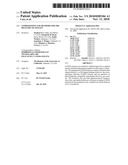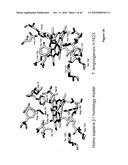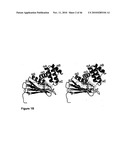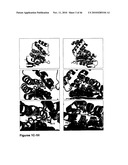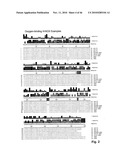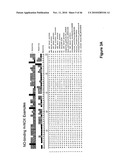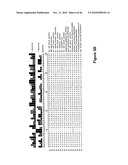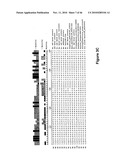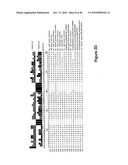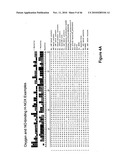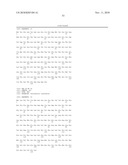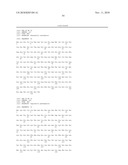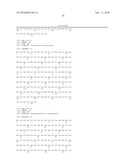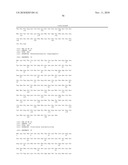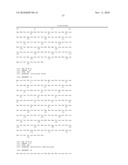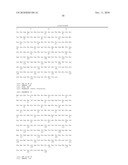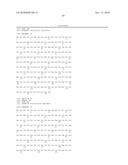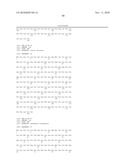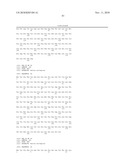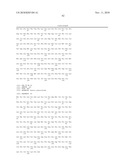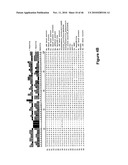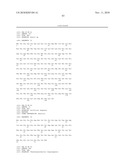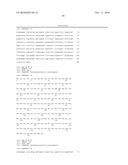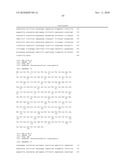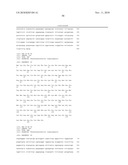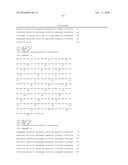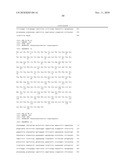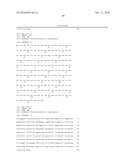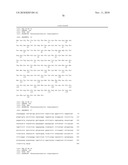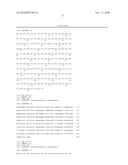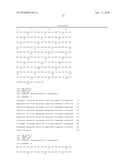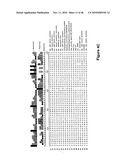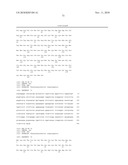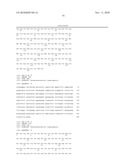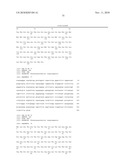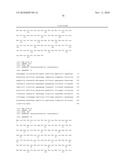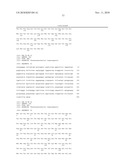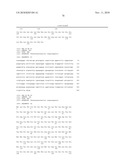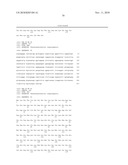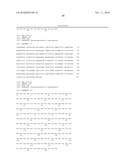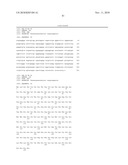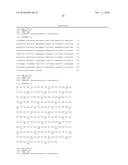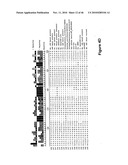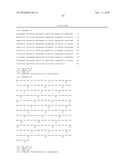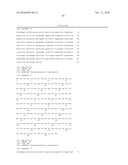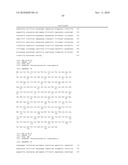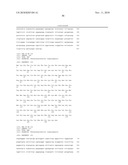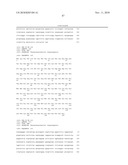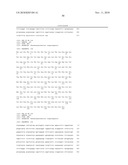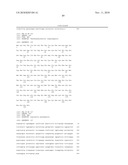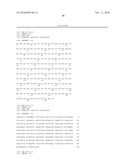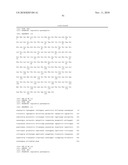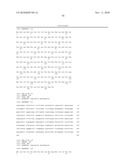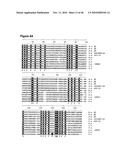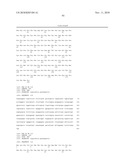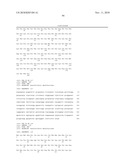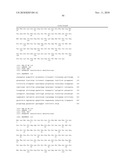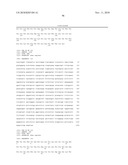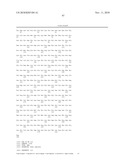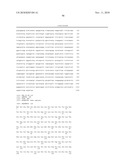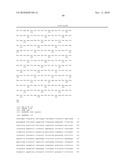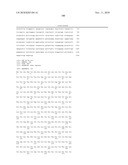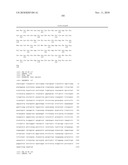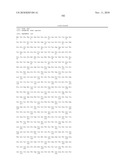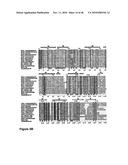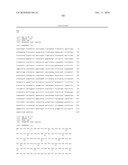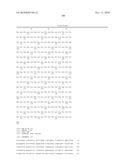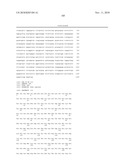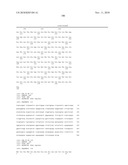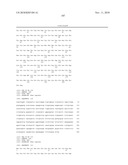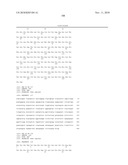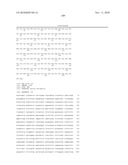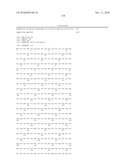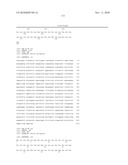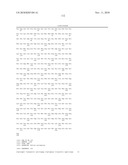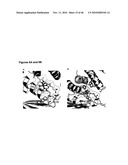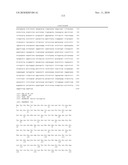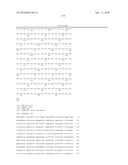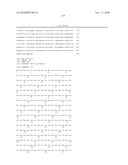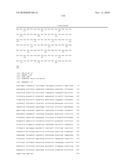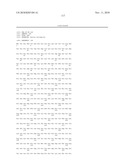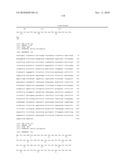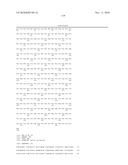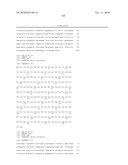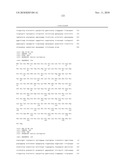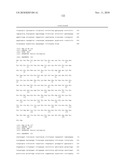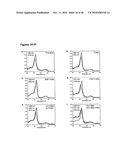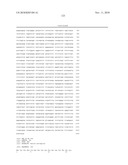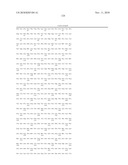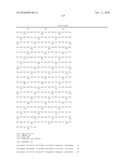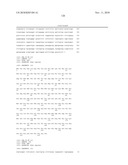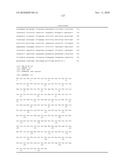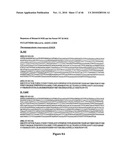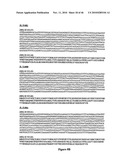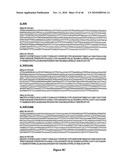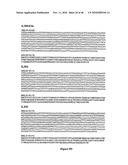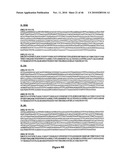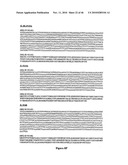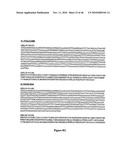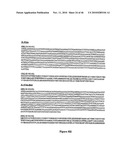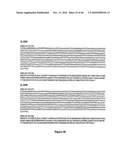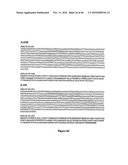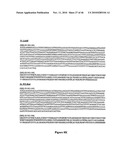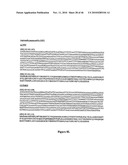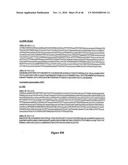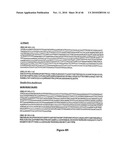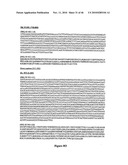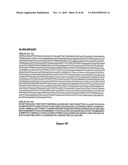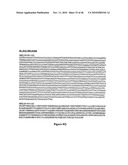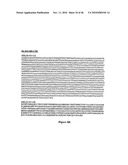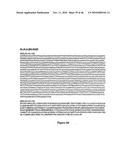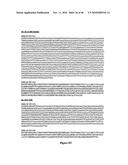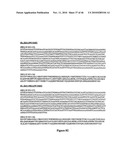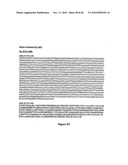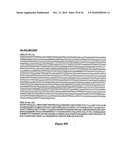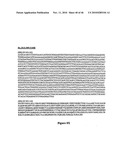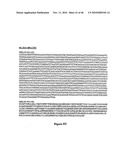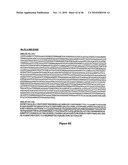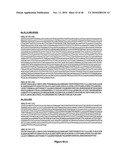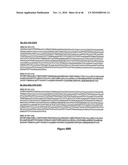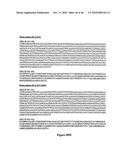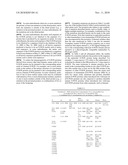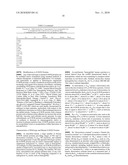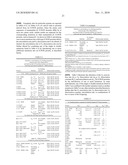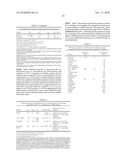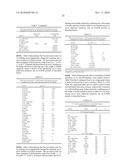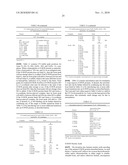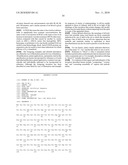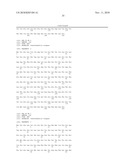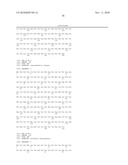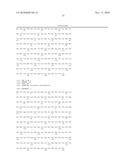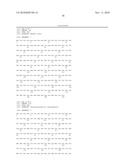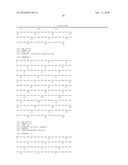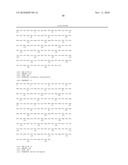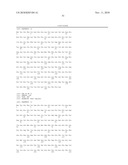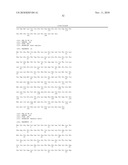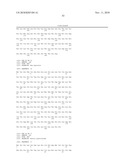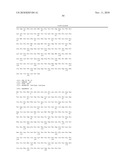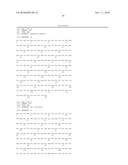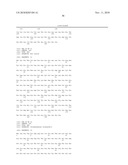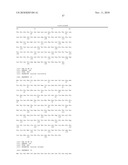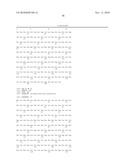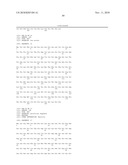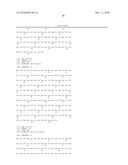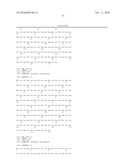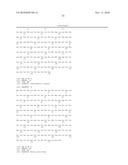Patent application title: COMPOSITIONS AND METHODS FOR THE DELIVERY OF OXYGEN
Inventors:
Stephen P. L. Cary (San Mateo, CA, US)
Elizabeth M. Boon (Stony Brook, NY, US)
Emily Weinert (Berkeley, CA, US)
Jonathan A. Winger (Oakland, CA, US)
Michael A. Marletta (Berkeley, CA, US)
Assignees:
THE REGENTS OF THE UNIVERSITY OF CALIFORNIA
IPC8 Class: AA61K9127FI
USPC Class:
424450
Class name: Drug, bio-affecting and body treating compositions preparations characterized by special physical form liposomes
Publication date: 2010-11-11
Patent application number: 20100285104
Claims:
1-403. (canceled)
404. A pharmaceutical composition comprising (i) a pharmaceutically acceptable amount of an H-NOX protein, wherein the O2 dissociation constant of the H-NOX protein is between about 1 nM and about 1 mM at 20.degree. C., and wherein the NO reactivity of the H-NOX protein is less than about 700 s-1 at 20.degree. C., and (ii) a pharmaceutically acceptable carrier.
405. The pharmaceutical composition of claim 404, wherein the O2 dissociation constant of the H-NOX protein is between about 2 nM and about 50 μM at 20.degree. C.
406. The pharmaceutical composition of claim 404, wherein the NO reactivity of the H-NOX protein is less than about 1 s-1 at 20.degree. C.
407. The pharmaceutical composition of claim 404, wherein the NO reactivity of the H-NOX protein is at least 100-fold lower than that of hemoglobin.
408. The pharmaceutical composition of claim 404, wherein the koff for oxygen of the H-NOX protein is between about 0.01 s-1 and about 200 s-1 at 20.degree. C.
409. The pharmaceutical composition of claim 408, wherein the koff for oxygen of the H-NOX protein is between about 1.0 s-1 and about 16.0 s-1 at 20.degree. C.
410. The pharmaceutical composition of claim 404, wherein the koff for oxygen of the protein is less than or equal to about 0.65 s-1 at 20.degree. C.
411. The pharmaceutical composition of claim 404, wherein the rate of heme autoxidation of the H-NOX protein is less than about 1 h-1 at 37.degree. C.
412. The pharmaceutical composition of claim 404, wherein the H-NOX protein comprises at least one distal pocket mutation.
413. The pharmaceutical composition of claim 404, wherein the H-NOX protein comprises at least one mutation that is not in the distal pocket.
414. The pharmaceutical composition of claim 404, wherein the H-NOX protein is a mammalian protein or is derived from a mammalian protein, wherein the H-NOX protein is a bacterial protein or is derived from a bacterial protein, wherein the H-NOX protein is an insect protein or is derived from an insect protein, or wherein the H-NOX protein is a worm protein or is derived from a worm protein.
415. The pharmaceutical composition of claim 407, wherein the hemoglobin is Homo sapiens hemoglobin alpha.
416. The pharmaceutical composition of claim 404, comprising one or more liposomes or nanoparticles that comprise the H-NOX protein.
417. The pharmaceutical composition of claim 404, wherein the H-NOX protein is covalently bound to another molecule or moiety.
418. The pharmaceutical composition of claim 417, wherein the H-NOX protein is covalently bound to polyethylene glycol.
419. The pharmaceutical composition of claim 404, wherein the NO reactivity of the H-NOX protein is less than about 700 s-1 at 20.degree. C., wherein the O2 dissociation constant of the H-NOX protein is between about 2 nM and about 50 μM at 20.degree. C., wherein the rate of heme autoxidation of the H-NOX protein is less than about 1 h-1 at 37.degree. C., and wherein the koff for oxygen of the H-NOX protein is between about 0.01 and about 200 s-1 at 20.degree. C.
420. A pharmaceutical composition comprising (i) a pharmaceutically acceptable amount of an H-NOX protein, wherein the O2 dissociation constant of the H-NOX protein is within 2 orders of magnitude of that of hemoglobin, and wherein the NO reactivity of the H-NOX protein is at least 10-fold lower than that of hemoglobin, and (ii) a pharmaceutically acceptable carrier.
421. A method of delivering oxygen to an individual comprising administering to an individual in need thereof an H-NOX protein in an amount sufficient to deliver an effective amount of oxygen to the individual, wherein the O2 dissociation constant of the H-NOX protein is between about 1 nM and about 1 mM at 20.degree. C., and wherein the NO reactivity of the H-NOX protein is less than about 700 s-1 at 20.degree. C.
422. The method of claim 421, wherein the individual is suffering from or at risk for hemorrhagic shock or hemodilution.
423. The method of claim 421, wherein the O2 dissociation constant of the H-NOX protein is between about 2 nM and about 50 μM at 20.degree. C.
424. The method of claim 421, wherein the NO reactivity of the H-NOX protein is less than about 1 s-1 at 20.degree. C.
425. The method of claim 421, wherein the NO reactivity of the H-NOX protein is at least 100-fold lower than that of hemoglobin.
426. The method of claim 421, wherein the koff for oxygen of the H-NOX protein is between about 0.01 s-1 and about 200 s-1 at 20.degree. C.
427. The method of claim 426, wherein the koff for oxygen of the H-NOX protein is between about 1.0 s-1 and about 16.0 s-1 at 20.degree. C.
428. The method of claim 421, wherein the koff for oxygen of the protein is less than or equal to about 0.65 s-1 at 20.degree. C.
429. The method of claim 421, wherein the rate of heme autoxidation of the H-NOX protein is less than about 1 h-1 at 37.degree. C.
430. The method of claim 421, wherein the H-NOX protein comprises at least one distal pocket mutation.
431. The method of claim 421, wherein the H-NOX protein comprises at least one mutation that is not in the distal pocket.
432. The method of claim 421, wherein the H-NOX protein is a mammalian protein or is derived from a mammalian protein, wherein the H-NOX protein is a bacterial protein or is derived from a bacterial protein, wherein the H-NOX protein is an insect protein or is derived from an insect protein, or wherein the H-NOX protein is a worm protein or is derived from a worm protein.
433. The method of claim 421, wherein the hemoglobin is Homo sapiens hemoglobin alpha.
434. A method of delivering oxygen to an individual comprising administering to an individual in need thereof an H-NOX protein in an amount sufficient to deliver an effective amount of oxygen to the individual, wherein the O2 dissociation constant of the H-NOX protein is within 2 orders of magnitude of that of hemoglobin, and wherein the NO reactivity of the H-NOX protein is at least 10-fold lower than that of hemoglobin.
435. A kit comprising (i) an H-NOX protein, wherein the O2 dissociation constant of the H-NOX protein is between about 1 nM and about 1 mM at 20.degree. C., and wherein the NO reactivity of the H-NOX protein is less than about 700 s-1 at 20.degree. C., and (ii) instructions for using the kit to deliver oxygen to an individual.
436. The kit of claim 435, wherein the koff for oxygen of the H-NOX protein is between about 1.0 s-1 and about 16.0 s-1 at 20.degree. C.
437. A kit comprising (i) a pharmaceutically acceptable amount of an H-NOX protein, wherein the O2 dissociation constant of the H-NOX protein is within 2 orders of magnitude of that of hemoglobin, and wherein the NO reactivity of the H-NOX protein is at least 10-fold lower than that of hemoglobin, and (ii) a pharmaceutically acceptable carrier.
438. An isolated H-NOX protein comprising at least one mutation that alters the koff for oxygen or NO reactivity compared to that of a corresponding wild-type H-NOX protein, wherein the koff for oxygen of the mutant H-NOX protein is between about 0.01 and about 200 s-1 at 20.degree. C., wherein the NO reactivity of the mutant H-NOX protein is at least 10-fold lower than that of hemoglobin, and wherein the mutant H-NOX protein is not T. tengcongensis H-NOX Y40L, T. tengcongensis H-NOX F78Y/Y140L, wild-type T. tengcongensis H-NOX, or L. pneumophilia 2H-NOX F142Y.
439. The isolated H-NOX protein of claim 438, wherein the O2 dissociation constant of the mutant H-NOX protein is between about 100 nM and about 1.9 μM at 20.degree. C., and wherein the rate of heme autoxidation of the mutant H-NOX protein is less than about 1 h-1 at 37.degree. C.
440. The isolated H-NOX protein of claim 438, wherein the O2 dissociation constant of the mutant H-NOX protein is less than 80 nM at 20.degree. C.
441. The isolated H-NOX protein of claim 438, comprising at least one mutation that is in the distal pocket.
442. The isolated H-NOX protein of claim 438, comprising at least one mutation that is not in the distal pocket.
443. The isolated H-NOX protein of claim 438, wherein the corresponding wild-type H-NOX protein is a mammalian protein, bacterial protein, insect protein, or worm protein.
444. The isolated H-NOX protein of claim 438, wherein the hemoglobin is Homo sapiens hemoglobin alpha.
445. An isolated H-NOX protein comprising at least one mutation that alters the O2 dissociation constant or NO reactivity compared to that of a corresponding wild-type H-NOX protein, wherein the O2 dissociation constant of the mutant H-NOX protein is within 2 orders of magnitude of that of hemoglobin, wherein the NO reactivity of the mutant H-NOX protein is at least 10-fold lower than that of hemoglobin, and wherein the mutant H-NOX protein is not T. tengcongensis H-NOX Y40L, T. tengcongensis H-NOX F78Y/Y140L, wild-type T. tengcongensis H-NOX, or L. pneumophilia 2H-NOX F142Y.
446. An isolated H-NOX protein selected from the group consisting of T. tengcongensis H-NOX I5A, T. tengcongensis H-NOX I5L, T. tengcongensis H-NOX I5L-P115A, T. tengcongensis H-NOX W9F, T. tengcongensis H-NOX W9F-Y140L, T. tengcongensis H-NOX W9F-Y140HT. tengcongensis H-NOX W9F--N74A, T. tengcongensis H-NOX W9Y, T. tengcongensis H-NOX W9N, T. tengcongensis H-NOX W9H, T. tengcongensis H-NOX N74E, T. tengcongensis H-NOX N74A, T. tengcongensis H-NOX N74H, T. tengcongensis H-NOX N74A-Y140H, T. tengcongensis H-NOX F78Y-Y140F, T. tengcongensis H-NOX P115A, T. tengcongensis H-NOX R135Q, T. tengcongensis H-NOX Y140F, T. tengcongensis H-NOX Y140H, T. tengcongensis H-NOX Y140A, T. tengcongensis 175F-His6, T. tengcongensis 175F, T. tengcongensis L144F-His6, T. tengcongensis L144F, L2 F9W-F142Y, D. desulfuricans H-NOX(728-899), D. desulfuricans H-NOX Y139L, β1(1-385), β1(1-385) I145Y, β1(1-385) I145H, β1(1-194), β1(1-194) I145Y, β1(1-194) L9W-I145Y, β2(1-217), β2(1-217) I142Y, C. botulinum H-NOX(1-175), C. botulinum H-NOX(1-186), C. acetobutylicum H-NOX(1-197), C. acetobutylicum H-NOX(1-183), and C. elegans H-NOX GCY-35(1-252).
447. A fusion protein comprising an H-NOX protein of claim 438.
448. A recombinant nucleic acid encoding an H-NOX protein of claim 438.
449. A vector comprising a nucleic acid of claim 448.
450. A cell comprising a nucleic acid of claim 448.
451. A cell comprising a vector of claim 449.
452. A method of producing an H-NOX protein comprising culturing a cell comprising a nucleic acid encoding an H-NOX protein of claim 438 under conditions suitable for production of the protein.
453. The method of claim 452, further comprising the step of purifying the H-NOX protein.
Description:
CROSS-REFERENCE TO RELATED APPLICATIONS
[0001]This application claims the benefit of U.S. provisional application Ser. No. 60/921,505, filed May 22, 2006 by Michael A. Marlette, Stephen P. L. Cary, Elizabeth M. Boon, and Jonathan A. Winger, entitled "Engineering H-NOX Proteins for Therapeutic Nitric Oxide and Oxygen Delivery" (UC Case No. B06-084). This U.S. provisional application was converted from U.S. utility application Ser. No. 11/440,588, filed May 22, 2006, to a provisional application on May 1, 2007, the disclosures of which are each hereby incorporated by reference in their entireties.
TECHNICAL FIELD
[0003]This application pertains to 11-NOX proteins and methods of using them to deliver oxygen. H-NOX proteins provide a new therapeutic tool for delivering O2 to humans and, for veterinary purposes, to animals.
BACKGROUND OF THE INVENTION
[0004]The current blood bank system has inherent risks and serious limitations. Blood typing errors, immunogenicity, transmission of bacterial agents, and vital infections such as HIV-1 and hepatitis, pose life threatening dangers to transfusion patients. In addition, the limited availability of donors, the requirement for specific blood types, the short shelf-life of red blood cells, and the need for refrigeration all limit the accessibility of transfusions to patients. Development of a stable blood substitute could eliminate the risks of the current blood bank system and increase the availability of transfusions to patients in most environments. Thus, the delivery of oxygen (O2) to organs and tissues to alleviate symptoms due to blood loss or hypoxia is a major therapeutic goal.
[0005]No hemoglobin-based therapies have been approved for use in humans in the U.S. Potential therapies include a variety of artificial O2 carriers (reviewed by Spahn, D. R. et al. (20.05). "Artificial O2 carriers: status in 2005," Curr. Pharm. Des.11(31):4099-4114), such as engineered hemoglobins (e.g., U.S. Pat. No. 6,022,849). However, some potential blood substitutes, such as hemoglobin-based blood substitutes, are limited due to their reactivity with nitric oxide (NO). In particular, NO acts as a chemical messenger in the control of many important processes in vivo, including neurotransmission, inflammation, platelet aggregation, and regulation of gastrointestinal and vascular smooth muscle tone. NO reacts directly with O2 that is bound to hemoglobin to form methemoglobin and nitrate. Both the heme iron and NO become oxidized by the bound oxygen atoms, and the reaction occurs so rapidly that no replacement of O2 by NO is observed (see, e.g., U.S. Pat. No. 6,455,676).
[0006]Since NO is produced and consumed on a continuous basis, there is a natural turnover of NO in vivo. When cell-free hemoglobin is administered, the balance between NO production and consumption is altered by reactions with cell-free hemoglobin. The oxidative reaction between NO and O2 bound to hemoglobin is irreversible, resulting in the destruction of NO, O2, and hemoglobin. NO binding to hemoglobin without O2 bound is effectively irreversible on physiologic timescales since the half-life for dissociation of nitrosylhemoglobin is 5-6 hours, thereby effectively inactivating hemoglobin as a cell-free O2 carrier.
[0007]Once an NO molecule reacts with hemoglobin, it is eliminated from the pool of signal molecules, thereby causing certain adverse conditions. For example, the binding of NO to hemoglobin (with or without O2 bound) can prevent vascular relaxation and potentially lead to hypertension, which is sometimes observed after the administration of certain extracellular hemoglobin solutions.
[0008]NO is also needed to mediate certain inflammatory responses. For example, NO produced by the endothelium inhibits platelet aggregation. Consequently, as NO is bound by cell-free hemoglobin (with or without O2 bound), platelet aggregation may increase. As platelets aggregate, they release potent vasoconstrictor compounds such as thromboxane A2 and serotonin. These compounds may act synergistically with the reduced NO levels caused by hemoglobin scavenging to produce significant vasoconstriction. In addition to inhibiting platelet aggregation, NO also inhibits neutrophil attachment to cell walls, which in turn can lead to cell wall damage. Endothelial cell wall damage has been observed with the infusion of certain hemoglobin solutions.
[0009]Another major drawback of hemoglobin-based blood substitutes is their high affinity for O2. This high affinity limits the ability of hemoglobin to release oxygen at a clinically useful rate in desired locations (such as peripheral tissues). Alternatively, the release of O2 by lower affinity hemoglobin-based blood substitutes in arteries before reaching microvascular beds may cause vasoconstriction due to a hyperoxic vasoconstrictor response (Winslow hypothesis). Additionally, hemoglobin-based blood substitutes are hindered by the rapid clearance of cell-free hemoglobin from plasma due the presence of receptors for hemoglobin that remove cell-free hemoglobin from plasma. Cell-free hemoglobin may also cause kidney toxicity, possibly due to NO depletion in glomeruli, causing constriction and subsequent dysfunction.
[0010]Due to the limitations of current blood substitutes and the chronic shortage of donated blood, there remains a significant interest in and need for additional or alternative therapies for delivering oxygen. In particular, blood substitutes with a lower NO reactivity and/or a longer plasma retention time are desired. Oxygen carriers with dissociation constants or off rates for O2 binding that are appropriate for particular clinical or industrial applications are also needed. An exemplary industry application for which O2 carriers are desirable includes the growth of cells in culture, which is often limited by the amount of O2 that reaches the cells.
BRIEF SUMMARY OF THE INVENTION
[0011]The present invention is based in part on the surprising discovery that wild-type and mutant H-NOX proteins have a much lower NO reactivity than hemoglobin and thus are desirable O2 carriers. If desired, mutations can be introduced into H-NOX proteins to alter their binding of O2 and NO ligands to further optimize the use of H-NOX proteins as O2 carriers.
[0012]In one aspect, the invention features mutant H-NOX proteins. Accordingly, in some embodiments, the invention provides an isolated H-NOX protein having at least one mutation that alters the O2 dissociation constant or NO reactivity compared to that of a corresponding wild-type H-NOX protein. In some embodiments, the O2 dissociation constant of the mutant H-NOX protein is within 2 orders of magnitude of that of hemoglobin, and the NO reactivity of the mutant H-NOX protein is at least 10-fold lower than that of hemoglobin. In some embodiments, the O2 dissociation constant of the mutant H-NOX protein is between about 2 nM to about 50 μM at 20° C., about 50 nM to about 10 μM at 20° C., about 20 nM to about 2 μM at 20° C., about 100 nM to about 1.9 μM at 20° C., about 150 nM to about 1 μM at 20° C., or about 100 nM to about 255 nM at 20° C. In some embodiments, the O2 dissociation constant of the mutant H-NOX protein is less than about 80 nM at 20° C., such as between about 20 nM to about 75 nM at 20° C. In some embodiments, the NO reactivity of the mutant H-NOX protein is at least 100-fold lower than that of hemoglobin, such as at least 1.000-fold lower than that of hemoglobin. In some embodiments, the NO reactivity of the mutant H-NOX protein is less than about 700 s-1 at 20° C., such as less than about 600 s-1, 500 s-1, 400 s-1, 300 s-1, 200 s-1, 100 s-1, 75 s-1, 50 s-1, 25 s-1, 20 s-1, 10 s-1, 50 s-1, 3 s-1, 2 s-1, 1.8 s-1, 1.5 s-1, 1.2 s-1, 1.0 s-1, 0.8 s-1, 0.7 s-1, or 0.6 s-1 at 20° C. In some embodiments, the koff for oxygen of the mutant H-NOX protein is between about 0.01 to about 200 s-1 at 20° C., such as about 1.0 s-1 to about 16.0 s-1. In some embodiments, the O2 dissociation constant of the mutant H-NOX protein is between about 100 nM to about 1.9 μM at 20° C., and the koff for oxygen of the mutant H-NOX protein is between about 1.35 s-1 to about 14.5 s-1 at 20° C. In some embodiments, the rate of heme autoxidation of the mutant H-NOX protein is less than about 1 h-1 at 37° C. In some embodiments, the koff for oxygen of the mutant H-NOX protein is between about 1.35 s-1 to about 14.5 s-1 at 20° C., and the rate of heme autoxidation of the mutant H-NOX protein is less than about 1 h-1 at 37° C. In some embodiments, the kon for oxygen of the mutant H-NOX protein is between about 1.35 s-1 to about 14.5 s-1 at 20° C., and the NO reactivity of the mutant H-NOX protein is less than about 700 s-1 at 20° C. (e.g., less than about 600 s-1, 500 s-1, 100 s-1, 20 s-1, or 1.8 s-1 at 20° C.). In some embodiments, the rate of heme autoxidation of the mutant H-NOX protein is less than about 1 h-1 at 37° C., and the NO reactivity of the mutant H-NOX protein is less than about 700 s-1 at 20° C. (e.g., less than about 600 s-1, 500 s-1, 100 s-1, 20 s-1, or 1.8 s-1 at 20° C.).
[0013]In some embodiments, the invention features an isolated H-NOX protein having at least one mutation that alters the koff for oxygen or NO reactivity compared to that of a corresponding wild-type H-NOX protein. In some embodiments, the koff for oxygen of the mutant H-NOX protein is between about 0.01 to about 200 s-1 at 20° C., and the NO reactivity of the mutant H-NOX protein is at least 10-fold lower than that of hemoglobin. In some embodiments, the mutant H-NOX protein has a koff for oxygen that is less than or equal to about 0.65 s-1 at 20° C. (such as between about 0.21 s-1 to about 0.65 s-1 at 20° C.). In some embodiments, the mutant H-NOX protein derived from a T. tengcongensis protein and has koff for oxygen between about 1.35 s-1 to about 18 s-1 at 20° C. In some embodiments, the NO reactivity of the mutant H-NOX protein is at least 100-fold lower than that of hemoglobin, such as at least 1,000-fold lower than that of hemoglobin. In some embodiments, the NO reactivity of the mutant H-NOX protein is less than about 700 s-1 at 20° C., such as less than about 600 s-1, 500 s-1, 400 s-1, 300 s-1, 200 s-1, 100 s-1, 75 s-1, 50 s-1 25 s-1, 20 s-1, 10 s-1 50 s-1, 3 s-1 2 s-1 1.8 s-1, 1.5 s-1, 1.2 s-1, 1.0 s-1, 0.8 s-1, 0.7 s-1 or 0.6 s-1 at 20° C. In some embodiments, the O2 dissociation constant of the mutant H-NOX protein is between about 1 nM to about 1 mM at 20° C., between about 2 nM to about 50 μM at 20° C., between about 50 nM to about 10 μM at 20° C., or between about 100 nM to about 1.9 μM at 20° C. In some embodiments, the rate of heme autoxidation of the mutant H-NOX protein is less than about 1 h-1 at 37° C. In some embodiments, the O2 dissociation constant of the mutant H-NOX protein is between about 100 nM to about 1.9 μM at 20° C., and the rate of heme autoxidation of the mutant H-NOX protein is less than about 1 h-1 at 37° C. In some embodiments, the O2 dissociation constant of the mutant H-NOX protein is between about 100 nM to about 1.9 μM at 20° C., and the NO reactivity of the mutant H-NOX protein is less than about 700 s-1 at 20° C. (e.g., less than about 600 s-1, 500 s-1, 100 s-1, 20 s-1, or 1.8 s-1 at 20° C.). In some embodiments, the rate of heme autoxidation of the mutant H-NOX protein is less than about 1 h-1 at 37° C., and the NO reactivity of the mutant H-NOX protein is less than about 700 s-1 at 20° C. (e.g., less than about 600 s-1, 500 s-1, 100 s-1, 20 s-1, or 1.8 s' at 20° C.).
[0014]In various embodiments, the invention features an isolated H-NOX protein having at least one mutation that alters the O2 dissociation constant or NO reactivity compared to that of a corresponding wild-type H-NOX protein. In some embodiments, the O2 dissociation constant of the mutant H-NOX protein is within 2 orders of magnitude of that of hemoglobin, and the NO reactivity of the mutant H-NOX protein is at least 10-fold lower than that of hemoglobin. In some embodiments, the O2 dissociation constant of the mutant H-NOX protein is between about 100 nM to about 255 nM at 20° C. In some embodiments, the O2 dissociation constant of the mutant H-NOX protein is less than 80 nM at 20° C., such as between about 20 nM to about 75 nM at 20° C. In some embodiments, the NO reactivity of the mutant H-NOX protein is at least 100-fold lower than that of hemoglobin, such as at least 1,000-fold lower than that of hemoglobin. In some embodiments, the mutant H-NOX protein has a koff for oxygen that is less than or equal to about 0.65 s-1 at 20° C. (such as between about 0.21 s-1 to about 0.65 s-1 at 20° C.). In some embodiments, the koff for oxygen of the mutant H-NOX protein is between about 1.35 s-1 to about 2.9 s-1 at 20° C. In some embodiments, the koff for oxygen of the mutant H-NOX protein is between about 5.8 s-1 to about 19 s-1 at 20° C. In some embodiments, the mutant H-NOX protein is stable at 4° C. in air.
[0015]In some embodiments, the invention features an isolated H-NOX protein having at least one mutation that alters the koff for oxygen or NO reactivity compared to that of a corresponding wild-type H-NOX protein. In some embodiments, the koff for oxygen of the mutant H-NOX protein is less than or equal to about 0.65 s-1 at 20° C., and the NO reactivity of the mutant H-NOX protein is at least 10-fold lower than that of hemoglobin. In some embodiments, the koff for oxygen of the mutant H-NOX protein is between about 0.21 s-1 to about 0.65 s-1 at 20° C. In some embodiments, the NO reactivity of the mutant H-NOX protein is at least 100-fold lower than that of hemoglobin, such as at least 1,000-fold lower than that of hemoglobin. In some embodiments, the NO reactivity of the mutant H-NOX protein is less than about 700 s-1 at 20. ° C., such as less than about 600 s-1, 500 S-1, 400 s-1, 300 s-1, 200 s-1, 100 s-1, 75 s-1, 50 s-1, 25 s-1, 20 s-1, 10 s-1, 50 s-1, 3 s-1, 2 s-1, 1.8 s-1, 1.5 s-1, 1.2 s-1, 1.0 s-1, 0.8 s-1, 0.7 s-1, or 0.6 s-1 at 20° C. In some embodiments, the O2 dissociation constant of the mutant H-NOX protein is between about 100 nM to about 1.9 μM at 20° C. In some embodiments, the rate of heme autoxidation of the mutant H-NOX protein is less than about 1 h-1 at 37° C. In some embodiments, the O2 dissociation constant of the mutant H-NOX protein is between about 100 nM to about 1.9 μM at 20° C., and the rate of heme autoxidation of the mutant H-NOX protein is less than about 1 h-1 at 37° C. In some embodiments, the O2 dissociation constant of the mutant H-NOX protein is between about 100 nM to about 1.9 μM at 20° C., and the NO reactivity of the mutant H-NOX protein is less than about 700 s-1 at 20° C. (e.g., less than about 600 s-1, 500 s-1, 100 s-1, 20 s-1, 1.8 s-1, or 0.7 at 20° C.). In some embodiments, the rate of heme autoxidation of the mutant H-NOX protein is less than about 1 h-1 at 37° C., and the NO reactivity of the mutant H-NOX protein is less than about 700 s-1 at 20° C. (e. g., less than about 600 s-1, 500 s-1, 100 s-1, 20 s-1, 1.8 s-1, or 0.7 at 20° C.).
[0016]In various embodiments, the invention features an isolated H-NOX protein selected from the group consisting of T. tengcongensis H-NOX 15A, T. tengcongensis H-NOX 15L, T. tengcongensis H-NOX 15L-P115A, T. tengcongensis H-NOX W9F, T. tengcongensis H-NOX W9F-Y140L, T. tengcongensis H-NOX W9F-Y140HT. tengcongensis H-NOX W9F--N74A, T. tengcongensis H-NOX W9Y, T. tengcongensis H-NOX W9N, T. tengcongensis H-NOX W9H, T. tengcongensis H-NOX N74E, T. tengcongensis H-NOX N74A, T. tengcongensis H-NOX N74H, T. tengcongensis H-NOX N74A-Y140H, T. tengcongensis H-NOX F78Y-Y140F, T. tengcongensis H-NOX P115A, T. tengcongensis H-NOX R135Q, T. tengcongensis H-NOX Y140F, T. tengcongensis H-NOX Y14011, T. tengcongensis H-NOX Y140A, T. tengcongensis 175F-His6, T. tengcongensis I75F, T. tengcongensis L144F-His6, T. tengcongensis L144F, L2 F9W-F142Y, D. desulfuricans H-NOX(728-899), D. desulfuricans H-NOX Y139L, β1(1-385), β1(1-385) I145Y, β1(1-385) I145H, β1(1-194), β1(1-194) I145Y, β1(1-194) L9W-I145Y, β2(1-217), β2(1-217) I142Y, C. botulinum H-NOX(1-175), C. botulinum H-NOX(1-186), C. acetobutylicum H-NOX(1-197), C. acetobutylicum H-NOX(1-183), and C. elegans H-NOX GCY-35(1-252). In some embodiments, the β1 or β2 protein is derived from a R. norvegicus or H. sapiens β1 or β2 protein.
[0017]In various embodiments, the invention features an isolated H-NOX protein selected from the group consisting of T. tengcongensis H-NOX 15A, T. tengcongensis H-NOX 15L, T. tengcongensis H-NOX 15L-P115A, T. tengcongensis H-NOX W9F-Y140L, T. tengcongensis H-NOX W9F-Y140H, T. tengcongensis H-NOX W9F--N74A, T. tengcongensis H-NOX W9Y, T. tengcongensis H-NOX W9N, T. tengcongensis H-NOX W9H, T. tengcongensis H-NOX N74E, T. tengcongensis H-NOX N74A, T. tengcongensis H-NOX N74H, T. tengcongensis H-NOX N74A-Y140H, T. tengcongensis H-NOX F78Y-Y140F, T. tengcongensis H-NOX P115A, T. tengcongensis H-NOX R135Q, T. tengcongensis H-NOX Y140H, T. tengcongensis H-NOX Y140A, T. tengcongensis 175F-His6, T. tengcongensis I75F, T. tengcongensis L144F-His6, T. tengcongensis L144F, L. pneumophilia 2 F9W-F142Y, D. desulfuricans H-NOX(728-899), D. desulfuricans H-NOX Y139L, β1(1-385) I145H, β1(1-194), β1(1-194) I145Y, β1(1-194) L9W-I145Y, β2(1-217), β2(1-217) I142Y, C. botulinum H-NOX(1-175), C. botulinum H-NOX(1-186), C. acetobutylicum H-NOX(1-197), C. acetobutylicum H-NOX(1-183), and C. elegans H-NOX GCY-35(1-252). In some embodiments, the β1 or β2 protein is derived from a R. norvegicus or H. sapiens β1 or β2 protein.
[0018]In some embodiments of the isolated H-NOX proteins, the O2 dissociation constant of the H-NOX protein is within 2 orders of magnitude of that of Homo sapiens hemoglobin alpha, such as an O2 dissociation constant between 0.1 to 10-fold or between 0.5 to 2-fold of that of Homo sapiens hemoglobin alpha. In some embodiments of the isolated H-NOX proteins, the NO reactivity of the H-NOX protein is at least 10-fold lower than that of Homo sapiens hemoglobin alpha, such as at least 100-fold or 1,000-fold lower than that of Homo sapiens hemoglobin alpha. In some embodiments of the isolated H-NOX proteins, the H-NOX protein contains one or more mutations (e.g., 1, 2, 3, 4, 5, 6, 7, 8, 9, or 10 mutations) compared to the H-NOX protein from which it was derived. In various embodiments of the isolated H-NOX proteins, the H-NOX protein contains less than 20, 15, 12, 10, 9, 8, 7, 6, 5, 4, 3, or 2 mutations compared to the H-NOX protein from which it was derived. In some embodiments of the isolated H-NOX proteins, the H-NOX protein has at least one distal pocket mutation. In some embodiments of the isolated H-NOX proteins, the H-NOX protein has at least one mutation that is not in the distal pocket. In some embodiments of the isolated H-NOX proteins, the H-NOX protein has at least one mutation in which a residue that corresponds to 11e5, Trp9, Asn74, Pro 115, or Arg 135 of T. tengcongensis H-NOX or 1145 of β1(1-385) is replaced by any other amino acid. In some embodiments of the isolated H-NOX proteins, the H-NOX protein has at least two mutations, wherein at least one mutation is the replacement of a residue that corresponds to 11e5, Trp9, Asn74, Prol 15, or Arg135 of T. tengcongensis H-NOX or 1145 of [3](1-385) by any other amino acid. In some embodiments of the isolated H-NOX proteins, the mutation in the H-NOX protein corresponds to a ISA mutation, a 15L mutation, a W9F mutation, a Y140F mutation, a Y140H mutation, a W9F Y140H double mutation, or a F78Y YI40F double mutation of T. tengcongensis or a I145Y mutation of β1. In some embodiments of the isolated H-NOX proteins, the mutation in the H-NOX protein corresponds to a W9Y mutation, a W9H mutation, a W9N mutation, a N74H mutation, a N74E mutation, a N74A mutation, a P115A mutation, a R135Q mutation, a 15L P115A double mutant, a N74A Y140H double mutant, or a W9F N74A double of T. tengcongensis. In some embodiments of the isolated H-NOX proteins, at least one C-terminal amino acid (such as at least about 50 contiguous C-terminal amino acids or between about 25 to about 200 contiguous C-terminal amino acids) in the H-NOX protein has been removed compared to the corresponding wild-type protein.
[0019]In some embodiments of the isolated H-NOX proteins, the H-NOX protein is derived from a mammalian protein (e.g., a human protein such as β1. In various embodiments of the isolated H-NOX proteins, the H-NOX protein derived from a bacterial protein (e.g., a T. tengcongensis protein). In some embodiments of the isolated H-NOX proteins, the H-NOX protein is covalently bound to another molecule or moiety, such as polyethylene glycol. Heme may or may not be bound to the H-NOX protein. In some embodiments of the isolated H-NOX proteins, oxygen is bound to the H-NOX protein. In some embodiments of the isolated H-NOX proteins, the H-NOX protein is a fusion protein that includes an H-NOX domain and part or all of another protein, such as albumin (e.g., human serum albumin).
[0020]In some embodiments of the isolated H-NOX proteins, the H-NOX protein is not T. tengcongensis H-NOX Y40L, T. tengcongensis H-NOX F78Y/Y140L, wild-type T. tengcongensis H-NOX, or L. pneumophilia 2H-NOX F142Y. In some embodiments of the isolated H-NOX proteins, the H-NOX protein is not R. norvegicus β2(1-217), R. norvegicus β1(1-194), R. norvegicus β1 (1-385), or R. norvegicus β1(1-385) I145Y. In some embodiments of the isolated H-NOX proteins, the H-NOX protein is not T. tengcongensis H-NOX W9F, T. tengcongensis H-NOX Y140F, or H. sapiens β1H-NOX (1-385) I145Y. In some embodiments of the isolated H-NOX proteins, the H-NOX protein is not T. tengcongensis H-NOX Y140H, H. sapiens β1 I140Y, or H. sapiens β1 I145Y. In some embodiments of the isolated H-NOX proteins, the H-NOX protein is not T. tengcongensis H-NOX Y140F, wild-type L. pneumophilia 2H-NOX, H. sapiens β1 H-NOX I140Y, wild-type H. sapiens β1 H-NOX, R. norvegicus sGC β1H-NOX (1-385), R. norvegicus sGC β1 H-NOX (1-385) I145Y, R. norvegicus sGC β1 H-NOX H105G, R. norvegicus sGC β1 H-NOX H105F, R. norvegicus sGC β1H-NOX I145Y, wild-type R. norvegicus β1 H-NOX, wild-type D. melangaster β1 H-NOX, wild-type D. melangaster CG14885-PA H-NOX, wild-type C. elegans GCY-35H-NOX, wild-type N. punctiforme H-NOX, wild-type C. crescentus H-NOX, wild-type S. oneidensis H-NOX, or wild-type C. acetobutylicum H-NOX. In some embodiments of the isolated H-NOX proteins, the H-NOX protein is not T. tengcongensis H-NOX Y40L, T. tengcongensis H-NOX F78Y/Y140L, T. tengcongensis H-NOX W9F, T. tengcongensis H-NOX Y140F, wild-type T. tengcongensis H-NOX, L. pneumophilia 2H-NOX F142Y, wild-type L. pneumophilia 2H-NOX, H. sapiens β1 H-NOX I140Y, H. sapiens β1 I145Y, wild-type H. sapiens β1 H-NOX, R. norvegicus sGC β1H-NOX (1-385), R. norvegicus sGC β1 H-NOX (1-385) I145Y, R. norvegicus sGC β1 H-NOX H105G, R. norvegicus sGC β1 H-NOX H105F, R. norvegicus sGC β1 H-NOX I145Y, wild-type R. norvegicus β1H-NOX, wild-type D. melangaster β1 H-NOX, wild-type D. melangaster CG 14885-PA H-NOX, wild-type C. elegans GCY-35H-NOX, wild-type N. punctiforme H-NOX, wild-type C. crescentus H-NOX, wild-type S. oneidensis H-NOX, or wild-type C. acetobutylicum H-NOX. In some embodiments of the isolated H-NOX proteins, the H-NOX protein is not any of the following H-NOX proteins that are listed by their gene name, followed by their species abbreviation and Genbank Identifiers (such as the following protein sequences available as of May 21, 2006; May 22, 2006; May 21, 2007; or May 22, 2007): Npun5905_Npu--23129606, alr2278_Ana 17229770, SO2144_Sone--24373702, Mdeg1343_Mde--23027521, VCA0720_Vch--15601476, CC2992_Ccr--16127222, Rsph2043_Rhsp--22958463 (gi:46192757), Mmc10739_Mcsp--22999020, Tar4_Tte--20807169, Ddes2822_Dde--23475919, CAC3243_Cac--15896488, gcy-31_Ce--17568389, CG14885_Dm--24647455, GUCY1B3_Hs--4504215, HpGCS-beta1_Hpul--14245738, Gycbeta100B_Dm--24651577, CG4154_Dm--24646993 (gi:NP--650424.2, gi:62484298), gcy-32_Ce--13539160, gcy-36_Ce--17568391 (gi:32566352, gi:86564713), gcy-35_Ce-17507861 (gi:71990146), gcy-37_Ce--17540904 (gi:71985505), GCY1α3_Hs--20535603, GCY1α2-Hs--899477, or GYCα-99B_Dm--729270 (gi:68067738) (Lakshminarayan et al. (2003). "Ancient conserved domains shared by animal soluble guanylyl cyclases and bacterial signaling proteins," BMG Genomics 4:5-13). The species abbreviations used in these names include Ana--Anabaena Sp; Ccr--Caulobacter crescentus; Cac--Clostridium acetobutylicum; Dde--Desulfovibrio desulfuricans; Mcsp--Magnetococcus sp.; Mde--Microbulbifer degradans; Npu--Nostoc punctiforme; Rhsp--Rhodobacter sphaeroides; Sone--Shewanella oneidensis; Tte--Thermoanaerobacter tengcongensis; Vch--Vibrio cholerae; Ce--Caenorhabditis elegans; Dm--Drosophila melanogaster; Hpul--Hemicentrotus pulcherrimus; Hs--Homo sapiens. In some embodiments of the isolated H-NOX proteins, the H-NOX protein is not any of the following H-NOX proteins that are listed by their organism name and Pfam database accession number (such as the following protein sequences available as of May 21, 2006; May 22, 2006; May 17, 2007; May 21, 2007; or May 22, 2007): Caenorhabditis briggsae Q622M5_CAEBR, Caenorhabditis briggsae Q61P44_CAEBR, Caenorhabditis briggsae Q61R54_CAEBR, Caenorhabditis briggsae Q61V90_CAEBR, Caenorhabditis briggsae Q61A94_CAEBR, Caenorhabditis briggsae Q60TP4_CAEBR, Caenorhabditis briggsae Q60M10_CAEBR, Caenorhabditis elegans GCY37_CAEEL, Caenorhabditis elegans GCY31_CAEEL, Caenorhabditis elegans GCY36 CAEEL, Caenorhabditis elegans GCY32_CAEEL, Caenorhabditis elegans GCY35_CAEEL, Caenorhabditis elegans GCY34_CAEEL, Caenorhabditis elegans GCY33_CAEEL, Oryzias curvinotus Q7T040_ORYCU, Oryzias curvinotus Q75WF0_ORYCU, Oryzias latipes P79998_ORYLA, Oryzias latipes Q7ZSZ5_ORYLA, Tetraodon nigroviridis Q4SW38TETNG, Tetraodon nigroviridis Q4Rz94_TETNG, Tetraodon nigroviridis Q4S6K5_TETNG, Fugu rubripes Q90VY5_FUGRU, Xenopus laevis Q61NK9_XENLA, Homo sapiens Q5T8J7_HUMAN, Homo sapiens GCYA2_HUMAN, Homo sapiens GCYB2_HUMAN, Homo sapiens GCYB1HUMAN, Gorilla gorillaQ9N193--9PRIM, Pongo pygmaeus Q5RAN8PONPY, Pan troglodytes Q9N192_PANTR, Macaca mulatta Q9N194_MACMU, Hylobates lar Q9N191_HYLLA, Mus musculus Q8BXH3_MOUSE, Mus musculus GCYB1_MOUSE, Mus musculus Q3UTI4_MOUSE, Mus musculus Q3UH83_MOUSE, Mus musculus Q6XE41_MOUSE, Mus musculus Q80YP4_MOUSE, Rattus norvegicus Q80WX7_RAT, Rattus norvegicus Q80WX8_RAT, Rattus norvegicus Q920Q1_RAT, Rattus norvegicus Q54A43 RAT, Rattus norvegicus Q80WY0_RAT, Rattus norvegicus Q80WY4_RAT, Rattus norvegicus Q8CH85_RAT, Rattus norvegicus Q80WY5_RAT, Rattus norvegicus GCYB1_RAT, Rattus norvegicus Q8CH90_RAT, Rattus norvegicus Q91XJ7_RAT, Rattus norvegicus Q80WX9_RAT, Rattus norvegicus GCYB2_RAT, Rattus norvegicus GCYA2_RAT, Canis familiaris Q4ZHR9_CANFA, Bos taurus GCYB1_BOVIN, Sus scrofa Q4ZHR7_PIG, Gryllus bimaculatus Q59HN5_GRYBI, Manduca sexta 077106 MANSE, Manduca sexta 076340_MANSE, Apis mellifera Q5UAF0_APIME, Apis mellifera Q5FAN0_APIME, Apis mellifera Q6L5L6_APIME, Anopheles gambiae str PEST Q7PYK9_ANOGA, Anopheles gambiae str PEST Q7Q9W6_ANOGA, Anopheles gambiae str PEST Q7QF31ANOGA, Anopheles gambiae str PEST Q7PS01 ANOGA, Anopheles gambiae str PEST Q7 PFY2_ANOGA, Anopheles gambiae Q7KQ93_ANOGA, Drosophila melanogaster Q24086_DROME, Drosophila melanogaster GCYH_DROME, Drosophila melanogaster GCY8E_DROME, Drosophila melanogaster GCYDA_DROME, Drosophila melanogaster GCYDB_DROME, Drosophila melanogaster Q9VA09_DROME, Drosophila pseudoobscura Q29CE1_DROPS, Drosophila pseudoobscura Q296C7_DROPS, Drosophila pseudoobscura Q296C8_DROPS, Drosophila pseudoobscura Q29BU7_DROPS, Aplysia californica Q7YWK7 APLCA, Hemicentrotus pulcherrimus Q95NK5_HEMPU, Chlamydomonas reinhardtii, Q5YLC2_CHLRE, Anabaena sp Q8YUQ7_ANASP, Flavobacteria bacterium BBFL7 Q26GR8--9BACT, Psychroflexus torquis ATCC 700755 Q1VQE5--9FLAO, marine gamma proteobacterium HTCC2207 Q1YPJ5--9GAMM, marine gamma proteobaoterium HTCC2207 QlYTK4--9GAMM, Caulobacter crescentus Q9A451_CAUCR, Acidiphilium cryptum JF-5 Q2DG60_ACICY, Rhodobacter sphaeroides Q3JOU9_RHOS4, Silicibacter pomeroyi Q5LPV1_SILPO, Paracoccus denitrificans PD 1222, Q3PC67_PARDE, Silicibacter sp TM1040 Q3QNY2--9RHOB, Jannaschia sp Q28mL8_JANSC, Magnetococcus sp MC-1 Q3XT27--9PROT, Legionella pneumophila Q5WXPO_LEGPL, Legionella pneumophila Q5WTZ5_LEGPL, Legionella pneumophila Q5X268_LEGPA, Legionella pneumophila Q5X2R2_LEGPA, Legionella pneumophila subsp pneumophila Q5ZWM9LEGPH, Legionella pneumophila subsp pneumophila Q5ZSQ8_LEGPH, Colwellia psychrerythraea Q47Y43_COLP3, Pseudoalteromonas atlantica T6c Q3CSZ5 ALTAT, Shewanella oneidensis Q8EF49_SHEON, Saccharophagus degradans Q21E20_SACD2, Saccharophagus degradans Q21ER7_SACD2, Vibrio angustum S14 Q1ZWE5--9VIBR, Vibrio vulnificus Q8DAE2_VIBVU, Vibrio alginolyticus 12G01 Q1 VCP6_VIBAL, Vibrio sp DAT722 Q2FA22--9VIBR, Vibrio parahaemolyticus Q87NJ1_VIBPA, Vibrio fischeri Q5E1F5_VIBF1, Vibrio vulnificus Q7MJS8_VIBVY, Photobacterium sp SKA34 Q2C6Z5--9GAMM, Hahella chefuensis Q2SFY7_HAHCH, Oceanospirillum sp MED92 Q2BKV0--9GAMM, Oceanobacter sp RED65 Q1N035--9GAMM, Desulfovibrio desulfuricans Q310U7_DESDG, Halothermothrix orenii H 168 Q2AIW5--9FIRM, Thermoanaerobacter tengcongensis Q8RBX6_THETN, Caldicellulosiruptor saccharolyticus DSM 8903 Q2ZH17_CALSA, Clostridium acetobutylicum Q97E73_CLOAB, Allcaliphilus metalliredigenes QYMF Q3C763--9CLOT, Clostridium tetani Q899J9_CLOTE, and Clostridium beijerincki NCIMB 8052 Q2WVN0_CLOBE. In some embodiments of the isolated H-NOX proteins, the H-NOX protein is not R. norvegicus sGC β1 H-NOX C78S or R. norvegicus sGC β1 H-NOX C78E. In some embodiments of the isolated H-NOX proteins, the H-NOX protein does not have a mutation in the Y-S-R motif, which includes Tyr135, Ser137, and Arg139 of human H-NOX.
[0021]In one aspect, the invention features a recombinant nucleic acid encoding any one or more of the mutant H-NOX proteins described herein. In particular embodiments, the nucleic acid includes a segment of or the entire nucleic acid sequence of any of the nucleic acids shown in FIGS. 2-4D or 8A-8DD. In some embodiments, the nucleic acid encodes a fusion protein that includes an H-NOX domain and part or all of another protein, such as albumin (e.g., human serum albumin). In some embodiments, the nucleic acid includes at least about 50, 100, 150, 200, 300, 400, 500, 600, 700, 800, or more contiguous nucleotides from an H-NOX nucleic acid and contains one or more mutations (e.g., 1, 2, 3, 4, 5, 6, 7, 8, 9, or 10 mutations) compared to the H-NOX nucleic acid from which it was derived. In various embodiments, a mutant H-NOX nucleic acid contains less than about any of 20, 15, 12, 10, 9, 8, 7, 6, 5, 4, 3, or 2 mutations compared to the H-NOX nucleic acid from which it was derived. The invention also features degenerate variants of any nucleic acid encoding a mutant H-NOX protein.
[0022]In yet another aspect, the invention provides a vector that includes any one or more of the mutant H-NOX nucleic acids described herein. In another aspect, the invention features a cell that includes any one or more of the mutant H-NOX nucleic acids described herein. In one aspect, the invention features a cell that includes any vector described herein.
[0023]In one aspect, the invention features a method of producing an H-NOX protein. This method involves culturing a cell having a nucleic acid encoding any one or more of the mutant H-NOX proteins described herein under conditions suitable for production of the mutant H-NOX protein. In some embodiments, the invention further includes the step of purifying the mutant H-NOX protein.
[0024]In one aspect, the invention features pharmaceutical compositions that include one or more H-NOX proteins, such as any of the wild-type or mutant H-NOX proteins described herein. In some embodiments, the pharmaceutical composition includes a pharmaceutically acceptable amount of an H-NOX protein described herein and a pharmaceutically acceptable carrier. In some embodiments, the O2 dissociation constant of the H-NOX protein is between about 1 nM and about 1 mM at 20° C., and the NO reactivity of the H-NOX protein is less than about 700 s-1 at 20° C. (e.g., less than about 600 s-1, 500 s-1, 100 s-1, 20 s-1, or 1.8 s-1 at 20° C.). In some embodiments, the O2 dissociation constant of the H-NOX protein is between about 20 nM to about 2 μM at 20° C., and the koff for oxygen of the H-NOX protein is between about 1.0 s-1 to about 16.0 s-1 at 20° C. In some embodiments, the O2 dissociation constant of the H-NOX protein is between about 20 nM to about 2 μM at 20° C., and the rate of heme autoxidation of the H-NOX protein is less than about 1 h-1 at 37° C. In some embodiments, the O2 dissociation constant of the H-NOX protein is between about 20 nM to about 2 μM at 20° C., and the NO reactivity of the H-NOX protein is less than about 700 s-1 at 20° C. (e.g., less than about 600 s-1, 500 s-1, 100 s-1, 20 s-1, or 1.8 s-1 at 20° C.). In some embodiments, the koff for oxygen of the H-NOX protein is between about 1.0 s-1 to about 16.0 s-1 at 20° C., and the rate of heme autoxidation of the X protein is less than about 1 h-1 at 37° C. In some embodiments, the koff for oxygen of the H-NOX protein is between about 1.0 s-1 to about 16.0 s-1 at 20° C., and the NO reactivity of the H-NOX protein is less than about 700 s-1 at 20° C. (e.g., less than about 600 s-1, 500s-1, 100 s-1, 20 s-1, or 1.8 s-1 at 20° C.).
[0025]In some embodiments, the invention provides a pharmaceutical composition that includes a pharmaceutically acceptable amount of an H-NOX protein and a pharmaceutically acceptable carrier. In some embodiments, the O2 dissociation constant of the H-NOX protein is within 2 orders of magnitude of that of hemoglobin, and the NO reactivity of the H-NOX protein is at least 10-fold lower than that of hemoglobin. In some embodiments, the koff for oxygen of the H-NOX protein is between about 0.01 and about 200 s-1 at 20° C., wherein the NO reactivity of the H-NOX protein is at least 10-fold lower than that of hemoglobin.
[0026]In some embodiments of the pharmaceutical compositions, the O2 dissociation constant of the H-NOX protein is within 2 orders of magnitude of that of Homo sapiens hemoglobin alpha, such as an O2 dissociation constant between 0.1 to 10-fold or between 0.5 to 2-fold of that of Homo sapiens hemoglobin alpha. In some embodiments of the pharmaceutical compositions, the NO reactivity of the H-NOX protein is at least 10-fold lower than that of Homo sapiens hemoglobin alpha, such as at least 100-fold or 1,000-fold lower than that of Homo sapiens hemoglobin alpha. In some embodiments of the pharmaceutical compositions, the H-NOX protein is a wild-type protein. In some embodiments of the pharmaceutical compositions, the H-NOX protein is a mutant protein as described herein. In various embodiments of the pharmaceutical compositions, the H-NOX protein has at least one mutation that alters the O2 dissociation constant, the koff for oxygen, the rate of heme autoxidation, the NO reactivity, the NO stability, or any two or more of the foregoing compared to that of a corresponding wild-type protein. In some embodiments of the pharmaceutical compositions, the H-NOX protein is a selected from the group consisting of wild-type T. tengcongensis H-NOX, T. tengcongensis H-NOX 15A, T. tengcongensis H-NOX 15L, T. tengcongensis H-NOX 15L-P115A, T. tengcongensis H-NOX W9F, T. tengcongensis H-NOX W9F--Y140L, T. tengcongensis H-NOX W9F-Y140H, T. tengcongensis H-NOX W9F-N74A, T. tengcongensis H-NOX W9Y, T. tengcongensis H-NOX W9N, T. tengcongensis H-NOX W9H, T. tengcongensis H-NOX N74E, T. tengcongensis H-NOX N74A, T. tengcongensis H-NOX N74H, T. tengcongensis H-NOX N74A-Y140H, T. tengcongensis H-NOX F78Y-Y140F, T. tengcongensis H-NOX F78Y/Y140L, T. tengcongensis H-NOX P115A, T. tengcongensis H-NOX R135Q, T. tengcongensis H-NOX Y140F, T. tengcongensis H-NOX Y40L, T. tengcongensis H-NOX Y140H, T. tengcongensis H-NOX Y140A, T. tengcongensis 175F-His6, T. tengcongensis 175F, T. tengcongensis L144F-His6, T. tengcongensis L144F, L. pneumophilia 2H-NOX F142Y, wild-type L. pneumophilia 1H-NOX, wild-type L. pneumophilia 2H-NOX, L. pneumophilia 2 F9W-F142Y, wild-type D. desulfuricans H-NOX, D. desulfuricans H-NOX(728-899), D. desulfuricans H-NOX Y139L, wild-type H. sapiens β1H-NOX, H. sapiens β1 I145Y, H. sapiens β1(1-385), H. sapiens β1(1-385) I145Y, H. sapiens β1(1-385) I145H, H. sapiens β1(1-194), H. sapiens β1(1-194) I145Y, H. sapiens β1(1-194) L9W-I145Y, H. sapiens β2(1-217), H. sapiens β2(1-217) I142Y, H. sapiens β1H-NOX H105G, H. sapiens β1H-NOX H105F, wild-type R. norvegicus β1H-NOX, R. norvegicus β1(1-385), R. norvegicus β1(1-385) I145Y, R. norvegicus β1(1-385) I145H, R. norvegicus β1(1-194), R. norvegicus β1(1-194) I145Y, R. norvegicus β1(1-194) L9W-I145Y, R. norvegicus β2(1-217), R. norvegicus β2(1-217) I142Y, R. norvegicus β1H-NOX H105G, R. norvegicus β1H-NOX H105F, C. botulinum H-NOX(1-175), C. botulinum H-NOX(1-186), wild-type C. acetobutylicum H-NOX, C. acetobutylicum H-NOX(1-197), C. acetobutylicum H-NOX(1-183), wild-type C. elegans GCY-35H-NOX, C. elegans H-NOX GCY-35(1-252), wild-type D. melangaster β1H-NOX, wild-type D. melangaster CG14885-PA, wild-type D. melangaster CG14886, wild-type D. melangaster CG4154; wild-type N. punctiforme H-NOX, wild-type C. crescentus H-NOX, wild-type S. oneidensis H-NOX, wild-type M. musculus H-NOX, wild-type C. familiaris H-NOX, wild-type B. Taurus H-NOX, wild-type R. norvegicus; wild-type X laevis H-NOX, wild-type O. latipes H-NOX, wild-type O. curivatus H-NOX, wild-type F. rubripes H-NOX, wild-type A. gambiae H-NOX, wild-type M. sexta H-NOX; wild-type C. elegans gcy-31, C. elegans gcy-32, wild-type C. elegans gcy-33, wild-type C. elegans gcy-34, wild-type C. elegans gcy-35, wild-type C. elegans gcy-36, wild-type C. elegans gcy-37; wild-type V. cholera H-NOX, wild-type V. fischerii H-NOX, and wild-type N. punctiforme H-NOX. In some embodiments of the pharmaceutical compositions, the pharmaceutical composition includes one or more liposomes or nanoparticles that include or encapsulate the H-NOX protein.
[0027]In some embodiments of the pharmaceutical compositions, the H-NOX protein is not T. tengcongensis H-NOX Y140H. In some embodiments of the pharmaceutical compositions, the H-NOX protein is not T. tengcongensis H-NOX Y40L, T. tengcongensis H-NOX F78Y/Y140L, wild-type T. tengcongensis H-NOX, or L. pneumophilia 2H-NOX F142Y. In some embodiments of the pharmaceutical compositions, the H-NOX protein is not R. norvegicus β2(1-217), R. norvegicus β1(1-194), R. norvegicus β1(1-385), or R. norvegicus β1(1-385) I145Y. In some embodiments of the pharmaceutical compositions, the H-NOX protein is not T. tengcongensis H-NOX W9F, T. tengcongensis H-NOX Y140F, or H. sapiens β1H-NOX (1-385) I145Y. In some embodiments, H-NOX protein is not T. tengcongensis H-NOX Y140H, H. sapiens β1 I140Y, or H. sapiens β1 I145Y. In some embodiments of the pharmaceutical compositions, the H-NOX protein is not T. tengcongensis H-NOX Y140F, wild-type L. pneumophilia 2H-NOX, H. sapiens β1H-NOX I140Y, wild-type H. sapiens β1H-NOX, R. norvegicus sGC β1H-NOX (1-385), R. norvegicus sGC β1H-NOX (1-385) I145Y, R. norvegicus sGC H-NOX H105G, R. norvegicus sGC β1H-NOX H105F, R. norvegicus sGC β1H-NOX I145Y, wild-type R. norvegicus β1H-NOX, wild-type D. melangaster β1H-NOX, wild-type D. melangaster CG14885-PA H-NOX, wild-type C. elegans GCY-35H-NOX, wild-type N. punctiforme H-NOX, wild-type C. crescentus H-NOX, wild-type S. oneidensis H-NOX, or wild-type C. acetobutylicum H-NOX. In some embodiments of the pharmaceutical compositions, the H-NOX protein is not T. tengcongensis H-NOX Y40L, T. tengcongensis H-NOX F78Y/Y140L, T. tengcongensis H-NOX˜W9F, T. tengcongensis H-NOX Y140F, wild-type T. tengcongensis H-NOX, L. pneumophilia 2H-NOX F142Y, wild-type L. pneumophilia 2H-NOX, H. sapiens β1H-NOX I140Y, H. sapiens B1 I145Y, wild-type H. sapiens β1H-NOX, R. norvegicus sGC β1H-NOX (1-385), R. norvegicus sGC β1H-NOX (1-385) I145Y, R. norvegicus sGC β1H-NOX H105G, R. norvegicus sGC β1H-NOX H105F, R. norvegicus sGC β1H-NOX I145Y, wild-type R. norvegicus β1H-NOX, wild-type D. melangaster β1H-NOX, wild-type D. melangaster CG14885-PA H-NOX, wild-type C. elegans GCY-35H-NOX, wild-type N. punctiforme H-NOX, wild-type C. crescentus H-NOX, wild-type S. oneidensis H-NOX, or wild-˜type C. acetobutylicum H-NOX. In some embodiments of the pharmaceutical compositions, the H-NOX protein is not any of the following H-NOX proteins that are listed by their gene name, followed by their species abbreviation and Genbank Identifiers (such as the following protein sequences available as of May 21, 2006; May 22, 2006; May 21, 2007; or May 22, 2007): Npun5905 Npu--23129606, a1r2278_Ana--17229770, SO2144_Sone--24373702, Mdeg1343_Mde--23027521, VCA0720_Vch--15601476, CC2992_Ccr--16127222, Rsph2043_Rhsp--22958463 (gi:46192757), Mmcl 0739 Mcsp--22999020, Tar4fTte--20807169,
[0028]Ddes2822_Dde--23475919, CAC3243_Cac--15896488, gcy-31_Ce--17568389, CG14885_Dm--24647455, GUCY1B3_Hs--4504215, HpGCS-beta1_Hpul--4245738, Gycbeta100B_Dm--24651577, CG4154_Dm--24646993 (gi:NP--650424.2, gi:62484298), gcy-32_Ce--13539160, gcy-36_Ce--17568391 (gi:32566352, gi:86564713), gcy-35_Ce-17507861 (gi:71990146), gcy-37_Ce--17540904 (gi:71985505), GCY1α3_Hs--20535603, GCY1α2-Hs--899477, or GYCα-99B_Dm--729270 (gi:68067738) (Lakshminarayan et al. (2003). "Ancient conserved domains shared by animal soluble guanylyl cyclases and bacterial signaling proteins," BMG Genomics 4:5-13). The species abbreviations used in these names include Ana--AnabaenaSp; Ccr--Caulobacter crescentus; Cac--Clostridium acetobutylicum; Dde--Desulfovibrio desulfuricans; Mcsp--Magnetococcus sp.; Mde--Microbulbifer degradans; Npu--Nostoc punctiforme; Rhsp--Rhodobacter sphaeroides; Sone--Shewanella oneidensis; Tte--Thermoanaerobacter tengcongensis; Vch--Vibrio cholerae; Ce--Caenorhabditis elegans; Dm--Drosophila melanogaster; Hpul--Hemicentrotus pulcherrimus; Hs--Homo sapiens. In some embodiments of the pharmaceutical compositions, the H-NOX protein is not R. norvegicus sGC β1 H-NOX C78S or R. norvegicus sGC β1H-NOX C78E. In some embodiments of the pharmaceutical compositions, the H-NOX protein is not any of the following H-NOX proteins that are listed by their organism name and Pfam database accession number (such as the following protein sequences available as of May 21, 2006; May 22, 2006; May 17, 2007; May 21, 2007; or May 22, 2007): Caenorhabditis briggsae Q622M5_CAEBR, Caenorhabditis briggsae Q61P44_CAEBR, Caenorhabditis briggsae Q61R54_CAEBR, Caenorhabditis briggsae Q61V90_CAEBR, Caenorhabditis briggsae Q61A94_CAEBR, Caenorhabditis briggsae Q60TP4_CAEBR, Caenorhabditis briggsae Q60M10_CAEBR, Caenorhabditis elegans GCY37 CAEEL, Caenorhabditis elegans GCY31_CAEEL, Caenorhabditis elegans GCY36_CAEEL, Caenorhabditis elegans GCY32_CAEEL, Caenorhabditis elegans GCY35 CAEEL, Caenorhabditis elegans GCY34_CAEEL, Caenorhabditis elegans GCY33_CAEEL, Oryzias curvinotus Q7T040_ORYCU, Oryzias curvinotus Q75WF0_ORYCU, Oryzias latipes P79998_ORYLA, Oryzias latipes Q7ZSZ5_ORYLA, Tetraodon nigroviridis Q4SW38_TETNG, Tetraodon nigroviridis Q4R.sup.z94_TETNG, Tetraodon nigroviridis Q4S6K5_TETNG, Fugu rubripes Q90VY5FUGRU, Xenopus laevis Q61NK9_XENLA, Homo sapiens Q5T8J7_HUMAN, Homo sapiens GCYA2_HUMAN, Homo sapiens GCYB2_HUMAN,
[0029]Homo sapiens GCYB1_HUMAN, Gorilla gorilla Q9N193--9PRIM, Pongo pygmaeus Q5RAN8_PONPY, Pan troglodytes Q9N192_PANTR, Macaca mulatta Q9N194 MACMU, Hylobates lar Q9N191_HYLLA, Mus musculus Q8BXH3_MOUSE, Mus musculus GCYB1_MOUSE, Mus musculus Q3UTI4_MOUSE, Mus musculus Q3 UH83_MOUSE, Mus musculus Q6XE41_MOUSE, Mus musculus Q80YP4_MOUSE, Rattus norvegicus Q80WX7_RAT, Rattus norvegicus Q80 WX8RAT, Rattus norvegicus Q920Q1_RAT, Rattus norvegicus Q54A43 RAT, Rattus norvegicus Q80WY0_RAT, Rattus norvegicus Q80WY4_RAT, Rattus norvegicus Q8CH85_RAT, Rattus norvegicus Q80WY5_RAT, Rattus norvegicus GCYB1_RAT, Rattus norvegicus Q8CH90_RAT, Rattus norvegicus Q91XJ7_RAT, Rattus norvegicus Q80WX9_RAT, Rattus norvegicus GCYB2_RAT, Rattus norvegicus GCYA2_RAT, Canis familiaris Q4ZHR9_CANFA, Bos taurus GCYB1_BOVIN, Sus scrofa Q4ZHR7_PIG, Gryllus bimaculatus Q59HN5_GRYBI, Manduca sexta 077106_MANSE, Manduca sexta 076340_MANSE, Apis mellifera Q5UAF0_APIME, Apis mellifera Q5FAN0_APIME, Apis mellifera Q6L5L6_AP1ME, Anopheles gambiae str PEST Q7PYK9_ANOGA, Anopheles gambiae str PEST Q7Q9W6_ANOGA, Anopheles gambiae str PEST Q7QF31 ANOGA, Anopheles gambiae str PEST Q7PS01 ANOGA, Anopheles gambiae str PEST Q7 PFY2_ANOGA, Anopheles gambiae Q7KQ93_ANOGA, Drosophila melanogaster Q24086_DROME, Drosophila melanogaster GCYH_DROME, Drosophila melanogaster GCY8E_DROME, Drosophila melanogaster GCYD_DROME, Drosophila melanogaster GCYDB_DROME, Drosophila melanogaster Q9VA09_DROME, Drosophila pseudoobscura Q29CE1_DROPS, Drosophila pseudoobscura Q296C7_DROPS, Drosophila pseudoobscura Q296C8_DROPS, Drosophila pseudoobscura Q29BU7_DROPS, Aplysia californica Q7YWK7_APLCA, Hemicentrotus pulcherrimus Q95NK5_HEMPU, Chlamydomonas reinhardtii, Q5YLC2_CHLRE, Anabaena sp Q8YUQ7 ANASP, Flavobacteria bacterium BBFL7 Q26GR8--9BACT, Psychroflexus torquis ATCC 700755 Q1VQE5--9FLAO, marine gamma proteobacterium HTCC2207 Q1YPJ5--9GAMM, marine gamma proteobacterium HTCC2207 QlYTK4--9GAMM, Caulobacter crescentus Q9A451_CAUCR, Acidiphilium cryptum JF-5 Q2DG60_ACICY, Rhodobacter sphaeroides Q3JOU9_RHOS4, Silicibacter pomeroyi Q5LPV1_SILPO, Paracoccus denitrificans PD1222, Q3PC67_PARDE, Silicibacter sp TMI 040 Q3QNY2--9RHOB, Jannaschia sp Q28mL8 JANSC, Magnetococcus sp MC-1 Q3XT27--9PROT, Legionella pneumophila Q5WXPO_LEGPL, Legionella pneumophila Q5WTZ5_LEGPL, Legionella pneumophila Q5X268_LEGPA, Legionella pneumophila Q5X2R2LEGPA, Legionella pneumophila subsp pneumophila Q5ZWM9_LEGPH, Legionella pneumophila subsp pneumophila Q5ZSQ8_LEGPH, Colwellia psychrelythraeaQ47Y43_COLP3, Pseudoalteromonas atlantica T6c Q3CSZ5_ALTAT, Shewanella oneidensis Q8EF49_SHEON, Saccharophagus degradans Q21E20_SACD2, Saccharophagus degradans Q21ER7_SACD2, Vibrio angustum S14 Q1ZWE5--9VIBR, Vibrio vulnificus Q8DAE2_VIBVU, Vibrio alginolyticus 12G01 Q1VCP6_VIBAL, Vibrio sp DAT722 Q2FA22--9VIBR, Vibrio parahaemolyticus Q87NJ1_VIBPA, Vibrio fischeri Q5E1F5_VIBF1, Vibrio vulnificus Q7MJS8_VIBVY, Photobacterium sp SKA34 Q2C6Z5--9GAMM, Hahella chef uensis Q2SFY7_HAHCH, Oceanospirillum sp MED92 Q2BKV0--9GAMM, Oceanobacter sp RED65 Q1N035--9GAMM, Desulfovibrio desulfuricans Q310U7_DESDG, Halothermothrix orenii H 168 Q2AIW5--9FIRM, Thermoanaerobacter tengcongensis Q8RBX6_THETN, Caldicellulosiruptor saccharolyticus DSM 8903 Q2ZH17_CALSA, Clostridium acetobutylicum Q97E73_CLOAB, Alkaliphilus metalliredigenes QYMF Q3C763--9CLOT, Clostridium tetani Q899J9_CLOTE, and Clostridium beijerincki NCIMB 8052 Q2WVN0_CLOBE. In some embodiments of the pharmaceutical compositions, the H-NOX protein does not have a mutation in the Y-S-R motif, which includes Tyr135, Ser137, and Arg139 of human H-NOX.
[0030]Unless otherwise explicitly noted or dictated by context, all wild-type and mutant H-NOX proteins described herein may be used in any of the pharmaceutical compositions described, herein. The H-NOX protein may or may not have heme and/or oxygen bound and may or may not be covalently bound to another molecule or moiety, such as polyethylene glycol. In some embodiments, the H-NOX protein is a fusion protein that includes an H-NOX domain and part or all of another protein, such as albumin (e.g., human serum albumin).
[0031]In one aspect, the invention provides methods of delivering oxygen to an individual (e.g., a mammal, such as a primate (e.g., a human, a monkey, a gorilla, an ape, a lemur, etc), a bovine, an equine, a porcine, a canine, or a feline) using an H-NOX protein. In some embodiments, the individual is suffering from or at risk for a cardiovascular disease, a neurological disease, tumor hypoxia, a loss of blood, or a wound. Exemplary cardiovascular indications include myocardial infarction (e.g., ST-segment elevation myocardial infarction), cardioplegia, sickle cell anemia, perioperative ischemia, peripheral vascular occlusion, and angioplasty. Exemplary neurological indications include ischemic stroke, traumatic brain injury, and spinal cord injury. For the treatment of tumor hypoxia, H-NOX proteins can be used, e.g., as a radiation therapy adjuvant in solid tumors (e.g., individuals with poor pre-metastatic prognoses) or as a PDT therapy adjuvant in surface tumors (e.g., colon, lung, or skin cancer, or cancer in another accessible surface or location). Applications of H-NOX proteins as a blood transfusion alternative include trauma (e.g., battlefield, disaster relief, or accidents), surgery (e.g., abdominal aneurysm-surgery, orthopedic surgery such as hip replacement surgery, or any other surgery that produces high blood loss), hemorrhages, hemorrhagic shock, hemodilution, and blood extension uses (e.g., supplementing auto-donation). Examples of wound repair applications include post-radiation wound repair (e.g., hyperbaric oxygen effect), post-surgical repair, diabetic ulcer repair, and burn wounds.
[0032]Accordingly, in some embodiments, the invention provides a method of delivering oxygen to an individual (e.g., a human) by administering to an individual in need thereof an H-NOX protein in an amount sufficient to deliver an effective amount of oxygen to the individual. In some embodiments, the O2 dissociation constant of the H-NOX protein is between about 1 nM to about 1 mM at 20° C., and the NO reactivity of the H-NOX protein is less than about 700 s-1 at 20° C. (e.g., less than about 600 s-1, 500 s-1, 100 s-1, 20 s-1, or 1.8 s-1 at 20° C.). In some embodiments, the O2 dissociation constant of the H-NOX protein is within 2 orders of magnitude of that of hemoglobin, and the NO reactivity of the H-NOX protein is at least 10-fold lower than that of hemoglobin.
[0033]In some embodiments of the methods, oxygen is bound to the H-NOX protein prior to the administration of the H-NOX protein to the individual. In some embodiments of the methods, oxygen is not bound to the H-NOX protein prior to the administration of the H-NOX protein to the individual, and the H-NOX protein transports oxygen from one location in the individual to another location in the individual. In some embodiments of the methods, the H-NOX protein is administered to the blood of the individual. In some embodiments of the methods, the H-NOX protein is administered to the blood, a wound, a tumor, a hypoxic tissue, or a hypoxic organ of the individual. In some embodiments of the methods, the individual is suffering from or at risk for a loss of blood. In some embodiments of the methods, the H-NOX protein is administered to the individual at least twice.
[0034]In some embodiments of the methods, the O2 dissociation constant of the H-NOX protein is within 2 orders of magnitude of that of Homo sapiens hemoglobin alpha, such as an O2 dissociation constant between 0.1 to 10-fold or between 0.5 to 2-fold of that of Homo sapiens hemoglobin alpha. In some embodiments of the methods, the NO reactivity of the H-NOX protein is at least 10-fold lower than that of Homo sapiens hemoglobin alpha, such as at least 100-fold or 1,000-fold lower than that of Homo sapiens hemoglobin alpha. In some embodiments of the methods, the H-NOX protein is a wild-type protein. In some embodiments of the methods, the H-NOX protein is a mutant protein as described herein. In various embodiments of the methods, the H-NOX protein has at least one mutation that alters the O2 dissociation constant, the koff for oxygen, the rate of heme autoxidation, the NO reactivity, or any two or more of the foregoing compared to that of a corresponding wild-type protein. In some embodiments of the methods, the H-NOX protein is a selected from the group consisting of wild-type T. tengcongensis H-NOX, T. tengcongensis H-NOX ISA, T. tengcongensis H-NOX 15L, T. tengcongensis H-NOX 15L-P115A, T. tengcongensis H-NOX W9F, T. tengcongensis H-NOX W9F-Y140L, T. tengcongensis H-NOX W9F-Y140H, T. tengcongensis H-NOX W9F-N74A, T. tengcongensis H-NOX W9Y, T. tengcongensis H-NOX W9N, T. tengcongensis H-NOX W9H, T. tengcongensis H-NOX N74E, T. tengcongensis H-NOX N74A, T. tengcongensis H-NOX N74H, T. tengcongensis H-NOX N74A-Y140H, T. tengcongensis H-NOX F78Y-Y140F, T. tengcongensis H-NOX F78Y/Y140L, T. tengcongensis H-NOX P115A, T. tengcongensis H-NOX R135Q, T. tengcongensis H-NOX Y140F, T. tengcongensis H-NOX Y40L, T. tengcongensis H-NOX Y14011, T. tengcongensis H-NOX Y140A, T. tengcongensis 175F-His6, T. tengcongensis 175F, T. tengcongensis L144F-His6, T. tengcongensis L144F, L. pneumophilia 2H-NOX F142Y, wild-type L. pneumophilia 1H-NOX, wild-type L. pneumophilia 2H-NOX, L. pneumophilia 2 F9W-F142Y, wild-type D. desulfuricans H-NOX, D. desulfuricans H-NOX(728-899), D. desulfuricans H-NOX Y139L, wild-type H. sapiens β1H-NOX, H. sapiens β1 I145Y, H. sapiens β1(1-385), H. sapiens β1(1-385) I145Y, H. sapiens β1(1-385) I145H, H. sapiens β1(1-194), H. sapiens β1(1-194) I145Y, H. sapiens β1(1-194) L9W-I145Y, H. sapiens β2(1-217), H. sapiens β2(1-217) I142Y, H. sapiens β1H-NOX H105G, H. sapiens β1H-NOX H105F, wild-type R. norvegicus H-NOX, R. norvegicus β1(1-385), R. norvegicus β1(1-385) I145Y, R. norvegicus β1(1-385) I145H, R. norvegicus β1(1-194), R. norvegicus (31(1-194) I145Y, R. norvegicus β1(1-194) L9W-I145Y, R. norvegicus β2(1-217), R. norvegicus β2(1-217) I142Y, R. norvegicus (β1H-NOX H105G, R. norvegicus (β1H-NOX H105F, C. botulinum H-NOX(1-175), C. botulinum H-NOX(1-186), wild-type C. acetobutylicum H-NOX, C. acetobutylicum H-NOX(1-197), C. acetobutylicum H-NOX(1-183), wild-type C. elegans GCY-35H-NOX, C. elegans H-NOX GCY-35(1-252), wild-type D. melangaster β1H-NOX, wild-type D. melangaster CG14885-PA, wild-type D. melangaster CG14886, wild-type D. melangaster CG4154; wild-type N. punctiforme H-NOX, wild-type C. crescentus H-NOX, wild-type S. oneidensis H-NOX, wild-type M. musculus H-NOX, wild-type C. familiaris H-NOX, wild-type B. Taurus H-NOX, wild-type R. norvegicus; wild-type X laevis H-NOX, wild-type O. latipes H-NOX, wild-type O. curivatus H-NOX, wild-type F. rubripes H-NOX, wild-type A. gambiae H-NOX, wild-type M. sexta H-NOX; wild-type C. elegans gcy-31, C. elegans gcy-32, wild-type C. elegans gcy-33, wild-type C. elegans gcy-34, wild-type C. elegans gcy-35, wild-type C. elegans gcy-36, wild-type C. elegans gcy-37; wild-type V. cholera H-NOX, wild-type V. fischerii H-NOX, and wild-type N. punctiforme H-NOX. In some embodiments of the methods, one or more liposomes or nanoparticles include or encapsulate the H-NOX protein.
[0035]In some embodiments of the methods, the H-NOX protein is not T. tengcongensis H-NOX Y140H. In some embodiments of the methods, the H-NOX protein is not T. tengcongensis H-NOX Y40L, T. tengcongensis H-NOX F78Y/Y140L, wild-type T. tengcongensis H-NOX, or L. pneumophilia 2H-NOX F142Y. In some embodiments of the methods, the H-NOX protein is not R. norvegicus β2(1-217), R. norvegicus β1(1-194), R. norvegicus β1(1-385), or R. norvegicus β1(1-385) I145Y. In some embodiments of the methods, the H-NOX protein is not T. tengcongensis H-NOX W9F, T. tengcongensis H-NOX Y140F, or H. sapiens β1H-NOX (1-385) I145Y. In some embodiments, H-NOX protein is not T. tengcongensis H-NOX Y140H, H. sapiens β1 I140Y, orH. sapiens β1 I145Y. In some embodiments of the methods, the H-NOX protein is not T. tengcongensis H-NOX Y140F, wild-type L. pneumophilia 2H-NOX, H. sapiens β1H-NOX I140Y, wild-type H. sapiens β1H-NOX, R. norvegicus sGC β1H-NOX (1-385), R. norvegicus sGC β1H-NOX (1-385) I145Y, R. norvegicus sGC β1H-NOX H105G, R. norvegicus sGC β1H-NOX H105F, R. norvegicus sGC β1H-NOX I145Y, wild-type R. norvegicus β1H-NOX, wild-type D. melangaster β1 H-NOX, wild-type D. melangaster CG14885-PA H-NOX, wild-type C. elegans GCY-35H-NOX, wild-type N. punctiforme H-NOX, wild-type C. crescentus H-NOX, wild-type S. oneidensis H-NOX, or wild-type C. acetobutylicum H-NOX. In some embodiments of the methods, the H-NOX protein is not T. tengcongensis H-NOX Y40L, T. tengcongensis H-NOX F78Y/Y140L, T. tengcongensis H-NOX W9F, T. tengcongensis H-NOX Y140F, wild-type T. tengcongensis H-NOX, L. pneumophilia 2H-NOX F142Y, wild-type L. pneumophilia 2H-NOX, H. sapiens β1H-NOX I140Y, H. sapiens B1 I145Y, wild-type H. sapiens (β1H-NOX, R. norvegicus sGC β1H-NOX (1-385), R. norvegicus sGC β1H-NOX (1-385) I145Y, R. norvegicus sGC β1H-NOX H105G, R. norvegicus sGC β1H-NOX H105F, R. norvegicus sGC β1H-NOX I145Y, wild-type R. norvegicus β1H-NOX, wild-type D. melangaster β1H-NOX, wild-type D. melangaster CG14885-PA H-NOX, wild-type C. elegans GCY-35H-NOX, wild-type N. punctiforme H-NOX, wild-type C. crescentus H-NOX, wild-type S. oneidensis H-NOX, or wild-type C. acetobutylicum H-NOX. In some embodiments of the methods, the H-NOX protein is not any of the following H-NOX proteins that are listed by their gene name, followed by their species abbreviation and Genbank Identifiers (such as the following protein sequences available as of May 21, 2006; May 22, 2006; May 21, 2007; or May 22, 2007): Npun5905_Npu--23129606, a1r2278_Ana 17229770, SO2144_Sone--24373702, Mdeg1343_Mde--23027521, VCA0720_Vch--15601476, CC2992_Ccr--16127222, Rsph2043_Rhsp--22958463 (gi:46192757), Mmc10739_Mcsp--22999020, Tar4_Tte--20807169, Ddes2822_Dde--23475919, CAC3243_Cac--15896488, gcy-31_Ce--17568389, CG14885_Dm--24647455, GUCY1B3_Hs--4504215HpGCS-beta1_Hpul--14245738, Gycbeta100B_Dm--24651577, CG4154_Dm--24646993 (gi:NP--650424.2, gi:62484298), gcy-32_Ce--13539160, gcy-36_Ce--17568391 (gi:32566352, gi:86564713), gcy-35_Ce-17507861 (gi:71990146), gcy-37_Ce--17540904 (gi:71985505), GCY1α3_Hs--20535603, GCY1α2-Hs--899477, or GYCα-99B_Dm--729270 (gi:68067738) (Lakshminarayan et al. (2003). "Ancient conserved domains shared by animal soluble guanylyl cyclases and bacterial signaling proteins," BMG Genomics 4:5-13). The species abbreviations used in these names include Ana--Anabaena Sp; Ccr--Caulobacter crescentus; Cac --Clostridium acetobutylicum; Dde --Desulfovibrio desulfuricans; Mcsp --Magnetococcus sp.; Mde--Microbulbifer degradans; Npu--Nostoc punctforme; Rhsp --Rhodobacter sphaeroides; Sone--Shewanella oneidensis; Tte--Thermoanaerobacter tengcongensis; Vch Vibrio cholerae; Ce--Caenorhabditis elegans; Dm--Drosophila melanogaster; Hpul--Hemicentrotus pulcherrimus; Hs--Homo sapiens. In some embodiments of the methods, the H-NOX protein is not any of the following H-NOX proteins that are listed by their organism name and Pfam database accession number (such as the following protein sequences available as of May 21, 2006; May 22, 2006; May 17, 2007; May 21, 2007; or May 22, 2007): Caenorhabditis briggsae Q622M5_CAEBR, Caenorhabditis briggsae Q61P44_CAEBR, Caenorhabditis briggsae Q61R54_CAEBR, Caenorhabditis briggsae Q61V90_CAEBR, Caenorhabditis briggsae Q61A94_CAEBR, Caenorhabditis briggsae Q60TP4_CAEBR, Caenorhabditis briggsae Q60M10_CAEBR, Caenorhabditis elegans GCY37_CAEEL, Caenorhabditis elegans GCY31_CAEEL, Caenorhabditis elegans GCY36_CAEEL, Caenorhabditis elegans GCY32_CAEEL, Caenorhabditis elegans GCY35_CAEEL, Caenorhabditis elegans GCY34CAEEL, Caenorhabditis elegans GCY33_CAEEL, Oryzias curvinotus Q7T040_ORYCU, Oryzias curvinotus Q75WF0_ORYCU, Oryzias latipes P79998_ORYLA, Oryzias latipes Q7ZSZ5_ORYLA, Tetraodon nigroviridis Q4SW38_TETNG, Tetraodon nigroviridis Q4Rz94_TETNG, Tetraodon nigroviridis Q4S6K5_TETNG, Fugu rubripes Q90VY5_FUGRU, Xenopus laevis Q61NK9_XENLA, Homo sapiens Q5T8J7_HUMAN, Homo sapiens GCYA2_HUMAN, Homo sapiens GCYB2_HUMAN, Homo sapiens GCYB1_HUMAN, Gorilla gorilla Q9N193--9PRIM, Pongo pygmaeus Q5RAN8_PONPY, Pan troglodytes Q9N192_PANTR, Macaca mulatta Q9N194_MACMU, Hylobates lar Q9N191_HYLLA, Mus musculus Q8BXH3_MOUSE, Mus musculus GCYB 1_MOUSE, Mus musculus Q3UTI4_MOUSE, Mus musculus Q3UH83_MOUSE, Mus musculus Q6XE41_MOUSE, Mus musculus Q80YP4_MOUSE, Rattus norvegicus Q80WX7_RAT, Rattus norvegicus Q80WX8_RAT, Rattus norvegicus Q920Q l_RAT, Rattus norvegicus Q54A43_RAT, Rattus norvegicus Q80WY0_RAT, Rattus norvegicus Q80WY4_RAT, Rattus norvegicus Q8CH85_RAT, Rattus norvegicus Q80WY5_RAT, Rattus norvegicus GCYB1_RAT, Rattus norvegicus Q8CH90_RAT, Rattus norvegicus Q91 XJ7_RAT, Rattus norvegicus Q80WX9_RAT, Rattus norvegicus GCYB2_RAT, Rattus norvegicus GCYA2_RAT, Canis familiaris Q4ZHR9_CANFA, Bos taurus GCYB1_BOVIN, Sus scrofa Q4ZHR7_PIG, Gryllus bimaculatus Q59HN5_GRYBI, Manduca sexta 077106 MANSE, Manduca sexta 076340_MANSE, Apis mellifera Q5UAF0_APIME, Apis mellifera Q5FAN0_APIME, Apis mellifera Q6L5L6_APIME, Anopheles gambiae str PEST Q7PYK9_ANOGA, Anopheles gambiae str PEST Q7Q9W6_ANOGA, Anopheles gambiae str PEST Q7 QF31_ANOGA, Anopheles gambiae str PEST Q7P S01_ANOGA, Anopheles gambiae str PEST Q7 PFY2_ANOGA, Anopheles gambiae Q7KQ93_ANOGA, Drosophila melanogaster Q24086_DROME, Drosophila melanogaster GCYH_DROME, Drosophila melanogaster GCY8E_DROME, Drosophila melanogaster GCYDA_DROME, Drosophila melanogaster GCYDB_DROME, Drosophila melanogaster Q9VA09_DROME, Drosophila pseudoobscura Q29CE1_DROPS, Drosophila pseudoobscura Q296C7_DROPS, Drosophila pseudoobscura Q296C8_DROPS, Drosophila pseudoobscura Q29BU7_DROPS, Aplysia californica Q7YWK7_APLCA, Hemicentrotus pulcherrimusQ95NK5_HEMPU, Chlamydomonas reinhardtii, Q5YLC2_CHLRE, Anabaena sp Q8YUQ7_ANASP, Flavobacteria bacterium BBFL 7 Q26GR8--9BACT, Psychroflexus torquis ATCC 700755 Q1VQE5--9FLAO, marine gamma proteobacterium HTCC2207 Q1YPJ5--9GAMM, marine gamma proteobacterium HTCC2207 Q1YTK4--9GAMM, Caulobacter crescentusQ9A451_CAUCR, Acidiphilium cryptum JF-5 Q2DG60_ACICY, Rhodobacter sphaeroides Q3JOU9_RHOS4, Silicibacter pomeroyi Q5LPV 1_SILPO, Paracoccus denitrificans PD1222, Q3PC67_PARDE, Silicibacter sp TMI040 Q3QNY2--9RHOB, Jannaschia sp Q28ML8_JANSC, Magnetococcus sp MC-1 Q3XT27--9PROT, Legionella pneumophila Q5WXPO_LEGPL, Legionella pneumophila Q5WTZ5_LEGPL, Legionella pneumophila Q5X268 LEGPA, Legionella pneumophila Q5X2R2_LEGPA, Legionella pneumophila subsp pneumophila Q5ZWM9_LEGPH, Legionella pneumophila subsp pneumophila Q5ZSQ8_LEGPH, Colwellia psychrerythraea Q47Y43_COLP3, Pseudoalteromonas atlantica T6c Q3CSZ5_ALTAT, Shewanella oneidensis Q8EF49_SHEON, Saccharophagus degradans Q21E20_SACD2, Saccharophagus degradans Q21 ER7_SACD2, Vibrio angustum S14 Q1ZWE5--9VIBR, Vibrio vulnificus Q8DAE2_VIBVU, Vibrio alginolyticus 12G01 Q1VCP6_VIBAL, Vibrio sp DAT722 Q2FA22--9VIBR, Vibrio parahaemolyticus Q87NJ1_VIBPA, Vibrio fischeri Q5E1F5_VIBF1, Vibrio vulnificus Q7MJS8_VIBVY, Photobacterium sp SKA34 Q2C6Z5--9GAMM, Hahella chejuensis Q2SFY7_HAHCH, Oceanospirillum sp MED92 Q2BKV0--9GAMM, Oceanobacter sp RED65 Q1N035--9GAMM, Desulfovibrio desulfuricans Q310U7_DESDG, Halothermothrix orenii H 168 Q2AIW5--9FIRM, Thermoanaerobacter tengcongensis Q8RBX6_THETN, Caldicellulosiruptor saccharolyticus DSM 8903 Q2ZH17_CALSA, Clostridium acetobutylicum Q97E73_CLOAB, Alkaliphilus metalliredigenes QYMF Q3C763--9CLOT, Clostridium tetani Q899J9_CLOTE, and Clostridium beyerincki NCIMB 8052 Q2WVN0_CLOBE. In some embodiments of the methods, the H-NOX protein is not R. norvegicus sGC β1H-NOX C78S or R. norvegicus sGC β1H-NOX C78E. In some embodiments of the methods, the H-NOX protein does not have a mutation in the Y-S-R motif, which includes Tyr135, Ser137, and Arg139 of human H-NOX.
[0036]Unless otherwise explicitly noted or dictated by context, all wild-type and mutant proteins and all pharmaceutical compositions described herein may be used in any of the methods of delivering oxygen described herein. The H-NOX protein may or may not have heme and/or oxygen bound and may or may not be covalently bound to another molecule or moiety, such as polyethylene glycol. In some embodiments, the H-NOX protein is a fusion protein that includes an H-NOX domain and part or all of another protein, such as albumin (e.g., human serum albumin).
[0037]In one aspect, the invention features kits that include one or more H-NOX proteins. In some embodiments, the invention provides a kit that includes an H-NOX protein and instructions for using the kit to deliver oxygen to an individual. In some embodiments, the O2 dissociation constant of the H-NOX protein is between about 1 nM to about 1 mM at 20° C., and the NO reactivity of the H-NOX protein is less than about 700 s-1 at 20° C. (e.g., less than about 600 s-1, 500 s-1, 100 s-1, 20 s-1, or 1.8 s-1 at 20° C.). In some embodiments, the O2 dissociation constant of the H-NOX protein is within 2 orders of magnitude of that of hemoglobin, and the NO reactivity of the H-NOX protein is at least 10-fold lower than that of hemoglobin. In some embodiments, the O2 dissociation constant of the H-NOX protein is between about 1 nM to about 1 mM at 20° C., and the NO reactivity of the H-NOX protein is less than about 700 s-1 at 20° C. (e.g., less than about 600 s-1, 500 s1, 100 s-1, 20 s-1, or 1.8 s-1 at 20° C.). In some embodiments, the H-NOX protein is not T. tengeongensis H-NOX Y140H. Unless otherwise explicitly noted or dictated by context, all wild-type and mutant proteins and all pharmaceutical compositions described herein may be used in any of the kits described herein. The H-NOX protein may or may not have heme and/or oxygen bound and may or may not be covalently bound to another molecule or moiety, such as polyethylene glycol. In some embodiments, the H-NOX protein is a fusion protein that includes an H-NOX domain and part or all of another protein, such as albumin (e.g., human serum albumin).
[0038]In one aspect, the invention features an H-NOX protein (such as any of the wild-type or mutant proteins described herein) for use as a medicament. In some embodiments, the invention features an H-NOX protein for use in a method of delivering oxygen to an individual. In some embodiments, the H-NOX protein is used to treat any condition for which delivery of O2 is beneficial, such as a cardiovascular disease, a neurological disease, tumor hypoxia, a loss of blood, or a wound.
[0039]In some embodiments, the invention features the use of an H-NOX protein (such as any of the wild-type or mutant proteins described herein) for the manufacture of a medicament, such as a medicament for delivering oxygen to an individual. In some embodiments, the invention features the use of an H-NOX protein for delivering oxygen to an individual. In some embodiments, the H-NOX protein is used to treat any condition for which delivery of O2 is beneficial, such as a cardiovascular disease, a neurological disease, tumor hypoxia, a loss of blood, or a wound.
BRIEF DESCRIPTION OF THE DRAWINGS
[0040]FIG. 1A is a picture of the three dimensional structure of distal pocket residues of NO-binding and O2-binding H-NOX proteins (above heme). Heme coordination residues of NO-binding and O2-binding H-NOX proteins are also shown (below heme). FIG. 1A is based on the three-dimensional structure of T. tengcongensis H-NOX reported by Pellicena, P. et al. (Aug. 31, 2004). "Crystal Structure of An Oxygen-Binding Heme Domain Related to Soluble Guanylate Cyclases," Proc Natl. Acad Sci USA101(35):12854-12859.
[0041]FIG. 1B is a stereo side view of the three dimensional structure of T. tengcongensis HNOX illustrating structural features of the H-NOX domain. The protein fold is represented by ribbon diagrams. The heme, dioxygen ligand, and proximal histidine are shown as ball-and-stick models. α-helices are labeled A-G according to the nomenclature shown in FIG. 5B. β-strands are labeled 1-4. FIG. 1B is from Pellicena, P. et al. (Aug. 31, 2004). "Crystal Structure of An Oxygen-Binding Heme Domain Related to Soluble Guanylate Cyclases," Proc Natl. Acad Sci USA 101(35):12854-12859.
[0042]FIGS. 1C-1H are pictures of the three dimensional structure of T. tengcongensis HNOX illustrating exemplary distal pocket residues in T. tengcongensis HNOX. The following residues depicted in FIGS. 1C-1H are the main residues comprising the H-NOX distal pocket: Thr4, Ile5, Thr8, Trp9, Trp67, Asn74, IIe75, Phe78, Phe82, Tyr140, and Leu 144, which are contained within helices A, D, E, and G. FIGS. 1C-1H were created using PYMOL (DeLano Scientific, LLP).
[0043]FIG. 2 is a sequence alignment of the following H-NOX proteins that bind or are predicted to bind O2 and NO: Majority (SEQ ID NO:1); Ce. gcy-31 (SEQ ID NO:2); Ce. gcy-33 (SEQ ID NO:3); Ce. gcy-35 (SEQ ID NO:4); Dm. CG14885 HNOX (SEQ ID NO:5); Dm. CG4154 HNOX (SEQ ID NO:6); Ms. Beta3 HNOX (SEQ ID NO:7); Tt HNOX (SEQ ID NO:8); and Ca HNOX (SEQ ID NO:9). These H-NOX proteins are predicted to bind O2 as well as NO because they have a tyrosine at the position corresponding to Y140 of T. tengcongensis H-NOX. The amino acid numbering used in FIG. 2 starts with the first amino acid in the H-NOX domain or full-length protein as residue number 1. The alignment was generated using the default parameters in the program MegAlign. The abbreviations used in FIG. 2 are described below with respect to FIGS. 4A-4D.
[0044]FIG. 3A-3D are a sequence alignment of the following H-NOX proteins that bind or are predicted to bind NO but not O2: Majority (SEQ ID NO:10); Dm. sGC beta1 protein (SEQ ID NO:11); sGC beta1 protein (SEQ ID NO:12); hs. sGC beta1 protein (SEQ ID NO:13); hs. beta2 protein (SEQ ID NO:14); Ms. sGC beta1 protein (SEQ ID NO:15); Mm. sGCbeta1 protein (SEQ ID NO:16); Np. beta1 HD-like (SEQ ID NO:17); Tr. sGC beta1 protein (SEQ ID NO:18); Anopheles_gambiae|XP--310919 (SEQ ID NO:19); Apis_mellifera|NP--001011632 (SEQ ID NO:20); Bt. sGC beta1 protein (SEQ ID NO:21); Chlamydomonas_reinhardtii|AAR02 (SEQ ID NO:22); Oryzias_curvinotus|BAC98396 (SEQ ID NO:23); Oryzias_latipes|BAA76691 (SEQ ID NO:24); Strongylocentrotus_purpuratus|X (SEQ ID NO:25); and Sus scrofa beta1 |NP--001018042+ (SEQ ID NO:26). The alignment was generated using the default parameters in the program MegAlign. The abbreviations used in FIGS. 3A-3D are described below with respect to FIG. 4.
[0045]FIGS. 4A-4D are a sequence alignment of H-NOX proteins from FIGS. 2 and 3A-3D: Majority (SEQ ID NO:27); Dm. sGC beta1 protein (SEQ ID NO:11); sGC betel protein (SEQ ID NO:12); hs. sGC beta1 protein (SEQ ID NO:13); hs. beta2 protein (SEQ ID NO:14); Mm. sGC beta1 protein (SEQ ID NO:16); Np. beta1 HD-like (SEQ ID NO:17); Tr. sGC beta1 protein (SEQ ID NO:18); Chlamydomonas_reinhardtii|AAR02 (SEQ ID NO:22); Oryzias_curvinotus|BAC98396 (SEQ ID NO:23); Strongylocentrotus_purpuratus|X (SEQ ID NO:25); Sus scrofa beta1|NP--001018042 (SEQ ID NO:26); gcy-31a (SEQ ID NO:2); gcy-33 (SEQ ID NO:3); Ca. HNOX (SEQ ID NO:9); T. beta1HD-like (SEQ ID NO:8); Ms. sGc beta 3 protein (SEQ ID NO:7); CG14885 (SEQ ID NO:5); and Dm. sGC short variant (SEQ ID NO:6). The alignment was generated using the default parameters in the program MegAlign. For FIGS. 2-4D, "Dm. sGC beta1 protein" denotes Drosophila melanogaster β1H-NOX; "sGC beta1 protein" denotes Rattus norvegicus β1H-NOX; "hs. sGC beta1 protein" denotes Homo sapiens β1H-NOX; "hs. beta2 protein" denotes Homo sapiens β2H-NOX; "Mm. sGC beta1 protein" denotes Mus musculus β1 H-NOX; "Np. beta1 HD-like" denotes Nostoc punctiforme H-NOX; "Tr. sGC beta1 Protein" Denotes Takifugu rubripes β1H-NOX; "Anopheles_gambiae|XP--310919" denotes Anopheles gambiae β1H-NOX; "Apis_mellifera|NP--001011632" denotes Apis mellifera β1H-NOX; "Bt. sGC beta1 protein" denotes Bos taurus β1H-NOX; "Chlamydomonas_reinhardtii|AAR02" denotes Chlamydomonas reinhardtii β1H-NOX; "Oryzias_curvinotus|BAC98396 denotes Oryzias curvinotus β1H-NOX; "Oryzias latipes|BAA76691" denotes Oryzias latipes β1H-NOX; "Strongylocentrotus_purpuratus|X" denotes Strongylocentrotus purpuratus β1H-NOX; "Sus scrofa beta1 |NP--001018042+" denotes Sus scrofa β1H-NOX; "gcy-31a" denotes Caenorhabditis elegans Gcy-31a H-NOX; "gcy-33" denotes Caenorhabditis elegans Gcy-33H-NOX; "gcy-35" denotes Caenorhabditis elegans Gcy-35H-NOX; "Ca. HNOX" denotes Clostridium acetobutiylicum H-NOX; "T. beta1HD-like" denotes Thermoanaerobacter tengcongensis H-NOX; "Ms. sGc beta 3 protein" denotes Manduca sexta β3H-NOX; "CG14885" denotes Drosophila melanogaster CG14885H-NOX; "Dm. sGC short variant" denotes Drosophila melanogaster Gcy-88-E-S H-NOX, and "Dm. CG4154 HNOX" denotes Drosophila melanogaster CG4154H-NOX.
[0046]FIG. 5A is a sequence alignment of members of the H-NOX family. The sequence numbering is that of T. tengcongensis H-NOX. Invariant residues are indicated by a "V", very highly conserved residues are indicated by "s". Y140 of T. tengcongensis H-NOX is indicated by a "H" Predicted distal pocket tyrosine residues that may stabilize an FeII--O2 complex in other H-NOX proteins are: position 70 for Caenorhabditis elegans GCY-35; position 140 in Drosophila melanogaster CG14885-PA; position 138 of Caenorhabditis elegans GCY-35; position 140 of Clostridium acetobutylicum; numbered according to Thermoanaerobacter tengcongensis. Accession numbers are: Homo sapiens β1 [ gi:2746083] (SEQ ID NO:28), Rattus norvegicus β1 [ gi:27127318] (SEQ ID NO:29), Drosophila melangaster β1 [ gi:861203] (SEQ ID NO:30), Drosophila melangaster CG 14885-PA [gi:23171476] (SEQ ID NO:31), Caenorhabditis elegans GCY-35 [ gi:52782806] (SEQ ID NO:32), Nostoc punctiforme [gi:23129606] (SEQ ID NO:33), Caulobacter crescentus [gi:16127222] (SEQ ID NO:34), Shewanella oneidensis [gi:24373702] (SEQ ID NO:35), Legionella pneumophila (ORF 2) [CUCGC--272624] (SEQ ID NO:36), Clostridium acetobutylicum [gi:15896488] (SEQ ID NO:37), and Thermoanaerobacter tengcongensis [gi:20807169] (SEQ ID NO:38). Alignments were generated using the program MegAlign, Lasergene, DNA Star, (see, the world-wide web at "dnastar.com/productsimegalign.php"). Clustal-W default parameters were used.
[0047]FIG. 5B is a sequence alignment of exemplary H-NOX domains. The secondary structure annotations and the numbering on top of the alignment correspond to the H-NOX domain from T. tengcongensis. α-helices are represented by spirals, and β-strands by arrows. The distal pocket is defined by α-helices αA, αD, αE, and αG. Pubmed/NCBI accession numbers are as follows: Ther_tengcongensis gi | 20807169 | (SEQ ID NO:39), Clos_acetobutylicum gi | 15896488 | (SEQ ID NO:40), Clos_tetani GI:75543266 (SEQ ID NO:41), Desu_desulfuricans gi | 23475919 | (SEQ ID NO:42), Vibr_vulnificus gi | 27361734 | (SEQ ID NO:43), Caul_crescentus gi | 16127222 | (SEQ ID NO:44), Micr_degradans gi | 23027521 | (SEQ ID NO:45), Vibr_cholerae gi | 15601476 | (SEQ ID NO:46), Shew_oneidensis gi | 24373702 | (SEQ ID NO:47), Rat_beta1_sGC gi | 27127318 | (SEQ ID NO:48), Rat_beta2_sGC gi | 21956635 | (SEQ ID NO:49), Nost_punctiforme gi | 23129606 | (SEQ ID NO:50), and Nost_sp. gi | 1722977 | (SEQ ID NO:51). The consensus sequence is shown a the bottom of FIG. 5 B (SEQ ID NO:52). The alignments were generated using the program MULTALIN (Corpet, F. (1988) Nucleic Acids Res. 16:10881-10890), and FIG. 5B was prepared using the program ESPRIPT (Gouet, P. et al. (1999) Bioinformatics 15: 305-308.).
[0048]FIGS. 6A and 6B are pictures of the three dimensional structure of the heme environment of the T. tengcongensis H-NOX domain. FIGS. 6A and 6B are from Pellicena, P. et al. (Aug. 31, 2004). "Crystal Structure of An Oxygen-Binding Heme Domain Related to Soluble Guanylate Cyclases," Proc Natl. Acad Sci USA 101(35):12854-12859.
[0049]FIGS. 7A-7F are graphs of the UV-visible spectroscopy of H-NOX proteins after anaerobic reduction (FeII unligated complexes; top line in each graph) before and after being exposed to air (FeII--O2 complexes; bottom line in each graph) for Tt H-NOX (FIG. 7A), Tt Y140L (FIG. 7B), Tt W9F-Y140L (FIG. 7C), Tt F78Y-Y140L (FIG. 7D), L2H-NOX and L2 F142Y (FIG. 7E), and β1(1-385) and β1(1-385) I145Y (FIG. 7F). In addition to the FeII and FeII--O2 complexes of L2 F142Y and β1(1-385) I145Y, the spectrum of wild-type L2H-NOX and f31-(1-385) H-NOX after reduction and exposure to air are shown in the middle line in FIGS. 7E and 7F, respectively, to demonstrate that these proteins do not bind O2 before the addition of a distal pocket tyrosine. The two or three numbers written in the upper left corner of each panel represent the wavelength for the peak of the lines in the graph. The numbers are written vertically in the order in which the corresponding lines appear vertically in the graph. For example, the 430 nm value in FIG. 7A denotes the peak of the wavelength for the top line in the graph (which represents a FeII unligated complex), and the 416 nm value in FIG. 7A denotes the peak of the wavelength for the bottom line in the graph (which represents a FeII--O2 complex). A shift in the wavelength in the presence of air indicates that the protein binds O2. The formation of a double peak between 500 and 600 nm in the presence of air is also indicative of O2 binding. FIGS. 7A-7F are from Boon, E. M. et al. (2005). "Molecular Basis For NO Selectivity in Soluble Guanylate Cyclase," Nature Chem. Biol. 1:53-59.
[0050]FIGS. 8A-8DD contain polynucleotide sequences of exemplary nucleic acids that encode H-NOX proteins and the amino acid sequences of the corresponding H-NOX proteins (SEQ ID NOS:53-162).
DETAILED DESCRIPTION OF THE INVENTION
[0051]The present invention is based in part on the surprising discovery that H-NOX proteins have a much lower NO reactivity than hemoglobin. This intrinsic low NO reactivity (and high NO stability) makes wild-type and mutant H-NOX proteins desirable blood substitutes because of the lower probability of inactivation of H-NOX proteins by endogenous NO and the lower probability of scavenging of endogenous NO by H-NOX proteins. Importantly, the presence of a distal pocket tyrosine in some H-NOX proteins (Pellicena, P. et al. (Aug. 31, 2004). "Crystal Structure of An Oxygen-Binding Heme Domain Related to Soluble Guanylate Cyclases," Proc Natl. Acad Sci USA 101(35):12854-12859) is suggestive of undesirable, high NO reactivity, contraindicating use as a blood substitute. For example, by analogy, a Mycobacterium tuberculosis hemoglobin protein, with a structurally analogous distal pocket tyrosine, reacts extremely rapidly with NO, and is used by the Mycobacterium to effectively scavenge and avoid defensive NO produced by an infected host (Ouellet, H. et al. (Apr. 30, 2002). "Truncated Hemoglobin HbN Protects Mycobacterium Bovis From Nitric Oxide," Proc. Natl. Acad. Sci. USA 99(9):5902-5907). However, we surprisingly discovered that H-NOX proteins actually have a much lower NO reactivity than that of hemoglobin making their use as blood substitutes possible.
[0052]Additionally, it was surprising discovered that H-NOX proteins that bind NO but not O2 can be converted to H-NOX proteins that bind both NO and O2 by the introduction of a single amino acid mutation. Thus, the affinity of H-NOX proteins for O2 and NO and the ability of H-NOX proteins to discriminate between O2 and NO ligands can be altered by the introduction of one or more amino acid mutations, allowing H-NOX proteins to be tailored to bind O2 or NO with desired affinities. Additional mutations can be introduced to further alter the affinity for O2 and/or NO. The H-NOX protein family can therefore be manipulated to exhibit improved or optimal kinetic and thermodynamic properties for O2 delivery. For example, mutant H-NOX proteins have been generated with altered dissociation constants and/or off rates for O2 binding that improve the usefulness of H-NOX proteins for a variety of clinical and industrial applications. The ability to tune H-NOX proteins to bind and deliver O2 is a therapeutic avenue that addresses and overcomes the central shortcomings of current O2 carriers. Accordingly, the present invention provides proteins, compositions, kits, and methods for the delivery of oxygen.
[0053]There are numerous benefits of using H-NOX proteins for O2 delivery. The principle role of blood transfusion following trauma and surgery is to deliver O2. An ideal blood substitute avoids the challenges of conventional blood: viral contamination, typing requirements, limited shelf-life, and limited availability. The major limitations of hemoglobin-based blood substitutes are their high affinity for O2 and their propensity to react with NO. As mentioned above, destruction of even low levels of NO can have serious effects on the tonic resting state of the vasculature and organs and leads to hypertension and gastrointestinal distress. Additionally, in the process of reacting with NO, the hemoglobin loses it ability to deliver O2 on a clinically relevant timeframe. Numerous attempts have been made to minimize the toxicity of first generation hemoglobin-based oxygen carriers (HBOCs), including intra- and inter-molecular cross-linking ("Blood Substitutes," R. Winslow ed. Academic Press, 2006). While these modifications overcame some of the severe toxicity issues related to extravasation of hemoglobin, the destruction of oxygen binding due to high NO reactivity remained. These second generation HBOCs exhibit reduced oxygen affinity, with p50 values close to the p50 value of erythrocytes, yet they have failed in clinical trials. An alternate hypothesis as been proposed by Winslow and colleagues: a low p50 HBOC with an appropriate viscosity and colloidal osmotic pressure is more appropriate for cell-free oxygen delivery than a high p50 HBOC (Tsai, A. G. et al. (2003). "Targeted O2 Delivery by low-P50 hemoglobin: A New Basis for O2 Therapeutics," Am. J. Physiol. Heart Circ. Physiol. 285:H1411-H1419; Winslow (2007). "Red Cell Substitutes," Seminars in Hematology 44:51-59). Whether the NO reactivity of such an HBOC becomes an issue in clinical trials remains to be seen. Engineering H-NOX proteins to bind and deliver O2 with minimal NO reactivity provides a new blood gas O2 carrier for use in blood substitutes where the H-NOX proteins deliver O2 without scavenging NO or being inactivated as O2 carriers by NO. These H-NOX proteins, compositions, kits, and methods are described further herein.
H-NOX Proteins
Overview of H-NOX Protein Family
[0054]Unless otherwise indicated, any wild-type or mutant H-NOX protein can be used in the compositions, kits, and methods as described herein. As used herein, an "H-NOX protein" means a protein that has an H-NOX domain (named for Heme-Nitric oxide and OXygen binding domain). An H-NOX protein may or may not contain one or more other domains in addition to the H-NOX domain. H-NOX proteins are members of a highly-conserved, well-characterized family of hemoproteins (Iyer, L. M. et al. (Feb. 3, 2003). "Ancient Conserved Domains Shared by Animal Soluble Guanylyl Cyclases And Bacterial Signaling Proteins," BMC Genomics 4(1):5; Karow, D. S. et al. (Aug. 10, 2004). "Spectroscopic Characterization of the Soluble Guanylate Cyclase-Like Heme Domains From Vibrio Cholerae And Thermoanaerobacter Tengcongensis," Biochemistry 43(31):10203-10211; Boon, E. M. et al. (2005). "Molecular Basis For NO Selectivity in Soluble Guanylate Cyclase," Nature Chem. Biol. 1:53-59; Boon, E. M. et al. (October 2005). "Ligand Discrimination in Soluble Guanylate Cyclase and the H-NOX Family of Heme Sensor Proteins," Curr. Opin. Chem. Biol. 9(5):441-446; Boon, E. M. et al. (2005). "Ligand Specificity of H-NOX Domains: From sGC to Bacterial NO Sensors," J. Inorg. Biochem. 99(4):892-902). H-NOX proteins are also referred to as Pfam 07700 proteins or HNOB proteins (Pfam--A database of protein domain family alignments and Hidden Markov Models, Copyright (C) 1996-2006 The Pfam Consortium; GNU LGPL Free Software Foundation, Inc., 59 Temple Place--Suite 330, Boston, Mass. 02111-1307, USA). In some embodiments, an H-NOX protein has, or is predicted to have, a secondary structure that includes six alpha-helices, followed by two beta-strands, followed by one alpha-helix, followed by two beta-strands. An H-NOX protein can be an apoprotein that is capable of binding heme or a holoprotein with heme bound. An H-NOX protein can covalently or non-covalently bind a heme group. Some H-NOX proteins bind NO but not O2, and others bind both NO and O2. H-NOX domains from facultative aerobes that have been isolated bind NO but not O2. H-NOX proteins from obligate aerobic prokaryotes, C. elegans, and D. melanogaster bind NO and O2. Mammals have two H-NOX proteins: β1 and β2. An alignment of mouse, rat, cow, and human H-NOX sequences shows that these species share >99% identity. In some embodiments, the H-NOX domain of an H-NOX protein or the entire H-NOX protein is at least about any of 10, 15, 20, 25, 30, 40, 50, 60, 70, 80, 90, 95, 97, 98, 99, or 99.5% identical to that of the corresponding region of a naturally-occurring Thermoanaerobacter tengcongensis H-NOX protein or a naturally-occurring sGC protein (e.g., a naturally-occurring sGC β1 protein). As discussed further herein, an H-NOX protein may optionally contain one or more mutations relative to the corresponding naturally-occurring H-NOX protein. In some embodiments, the H-NOX protein includes one or more domains in addition to the H-NOX domain. In particular embodiments, the H-NOX protein includes one or more domains or the entire sequence from another protein. For example, the H-NOX protein may be a fusion protein that includes an H-NOX domain and part or all of another protein, such as albumin (e.g., human serum albumin). In some embodiments, only the H-NOX domain is present.
[0055]A crystal structure of a prokaryotic O2-binding H-NOX from Thermoanaerobacter tengcongensis (Nioche, P. et al. (Nov. 26, 2004). "Femtomolar Sensitivity of a NO Sensor From Clostridium Botulinum," Science 306(5701):1550-1553; Pellicena, P. et al. (Aug. 31, 2004). "Crystal Structure of An Oxygen-Binding Heme Domain Related to Soluble Guanylate Cyclases," Proc Natl. Acad Sci USA101(35):12854-12859) shows that a tyrosine side chain hydroxyl group makes a critical H-bond to the FeII--O2 moiety. This distal pocket hydrogen-bonding network, involving principally Y140, stabilizes an FeII--O2 complex (FIG. 6B). This tyrosine is not present in H-NOX proteins that discriminate against O2 and only bind NO. For example, this hydrogen-bonding network is predicted to be absent in the H-NOX proteins from sGCs and aerobic prokaryotes, suggesting this as a key molecular factor in the remarkable ligand selectivity against O2 displayed by these heme proteins. FIGS. 7A-7G clearly demonstrate that the addition of a tyrosine in the distal pocket of a wild-type H-NOX protein that binds NO but not O2 can enable the mutant H-NOX protein to bind O2. Thus, a tyrosine in the distal heme pocket of the H-NOX heme fold acts like a switch to turn on or off O2 binding.
[0056]As illustrated in FIGS. 6A and 6B, the structure of the porphyrin is highly distorted. As illustrated in FIG. 6A, the conserved Y-S-R motif makes hydrogen-bonding interactions with the propionic acid side chains of the heme group. FIG. 6B, the conserved H102 is the proximal ligand to the heme (FIG. 6B).
[0057]As used herein, a "protein" includes proteins and fragments of proteins whether isolated from natural sources, produced by recombinant techniques, or chemically synthesized. A protein may have one or more modifications, such as a post-translational modification (e.g., glycosylation, etc) or any other modification (e.g., PEGylation, etc). The protein may contain one or more non-naturally-occurring amino acids (e.g., such as an amino acid with a side chain modification). In various embodiments, the H-NOX protein has at least about 50, 100, 150, 181, 200, 250, 300, 350, 400, or more amino acids. In some embodiments, the H-NOX proteins may include from about 50 to about 600 amino acids, such as about 100 to about 500 amino acids, about 150 to about 400 amino acids, about 150 to about 300 amino acids, or about 175 to about 200 amino acids.
Sources of H-NOX Proteins
[0058]H-NOX proteins from any genus or species can be used in the compositions, kits, and methods described herein. In various embodiments, the H-NOX protein is a protein from a mammal (e.g., a primate (e.g., human, monkey, gorilla, ape, lemur, etc), a bovine, an equine, a porcine, a canine, or a feline), an insect, a yeast, or a bacteria or is derived from such a protein. Exemplary mammalian H-NOX proteins include wild-type human and rat soluble guanylate cyclase (such as the β1 subunit). Examples of H-NOX proteins include wild-type mammalian H-NOX proteins, e.g. H. sapiens, M. musculus, C. familiaris, B. taurus and R. norvegicus; and wild-type non-mammalian vertebrate H-NOX proteins, e.g., X. laevis, O. latipes, O. curivatus, and F. rubripes. Examples of non-mammalian wild-type NO-binding H-NOX proteins include wild-type H-NOX proteins of D. melanogaster, A. gambiae, and M. sexta; examples of non-mammalian wild-type O2-binding H-NOX proteins include wild-type H-NOX proteins of C. elegans gcy-31, gcy-32, gcy-33, gcy-34, gcy-35, gcy-36, and gcy-37; D. melanogaster CG14885, CG14886, and CG4154; and M. sexta beta-3; examples of prokaryotic wild-type H-NOX proteins include T. tengcongensis, V. cholera, V. fischerii, N. punctiforme, D. desulfuricans, L. pneumophila 1, L. pneumophila 2, and C. acetobutylicum.
[0059]NCBI Accession numbers for exemplary H-NOX proteins include the following: Homo sapiens β1 [gi:2746083], Rattus norvegicus β1 [gi:27127318], Drosophila melangaster β1 [ gi:861203], Drosophila melangaster CG14885-PA [gi:23171476], Caenorhabditis elegans GCY-35 [ gi:52782806], Nostoc punctiforme [gi:23129606], Caulobacter crescentus [gi:16127222], Shewanella oneidensis [gi:24373702], Legionella pneumophila (ORF 2) [CUCGC 272624], Clostridium acetobutylicum [gi:15896488], and Thermoanaerobacter tengcongensis [gi:20807169].
[0060]Exemplary H-NOX protein also include the following H-NOX proteins that are listed by their gene name, followed by their species abbreviation and Genbank Identifiers (such as the following protein sequences available as of May 21, 2006; May 22, 2006; May 21, 2007; or May 22, 2007, which are each hereby incorporated by reference in their entireties): Npun5905_Npu--23129606, a1r2278_Ana--17229770, SO2144_Sone24373702, Mdeg1343_Mde--23027521, VCA0720_Vch--15601476, CC2992_Ccr--16127222, Rsph2043_Rhsp--22958463 (gi:46192757), Mmc10739_Mcsp--22999020, Tar4_Tte--20807169, Ddes2822_Dde23475919, CAC3243_Cac--15896488, gcy-31_Ce--17568389, CG14885_Dm--24647455, GUCY1B3_Hs--4504215, HpGCS-beta1_Hpul--14245738, Gycbeta100B_Dm--24651577, CG4154_Dm--24646993 (gi:NP--650424.2, gi:62484298), gcy-32_Ce--13539160, gcy-36_Ce--17568391 (gi:32566352, gi:86564713), gcy-35_Ce-17507861 (gi:71990146), gcy-37_Ce--17540904 (gi:71985505), GCY1α3Hs20535603, GCY1α2-Hs--899477, or GYCa-99B_Dm--729270 (gi:68067738) (Lakshminarayan et al. (2003). "Ancient conserved domains shared by animal soluble guanylyl cyclases and bacterial signaling proteins," BMG Genomics 4:5-13). The species abbreviations used in these names include Ana--Anabaena Sp; Ccr--Caulobacter crescentus; Cac--Clostridium acetobutylicum; Dde--Desulfovibrio desulfuricans; Mcsp--Magnetococcus sp.; Mde--Microbulbifer degradans; Npu--Nostoc punctiforme; Rhsp--Rhodobacter sphaeroides; Sone--Shewanella oneidensis; Tte--Thermoanaerobacter tengcongensis; Vch--Vibrio cholerae; Ce--Caenorhabditis elegans; Dm--Drosophila melanogaster; Hpul--Hemicentrotus pulcherrimus; Hs--Homo sapiens.
[0061]Other exemplary H-NOX proteins include the following H-NOX proteins that are listed by their organism name and Pfam database accession number (such as the following protein sequences available as of May 21, 2006; May 22, 2006; May 17, 2007; May 21, 2007; or May 22, 2007, which are each hereby incorporated by reference in their entireties): Caenorhabditis briggsae Q622M5_CAEBR, Caenorhabditis briggsae Q61P44_CAEBR, Caenorhabditis briggsae Q61R54_CAEBR, Caenorhabditis briggsae Q61V90_CAEBR, Caenorhabditis briggsae Q61A94_CAEBR, Caenorhabditis briggsae Q60TP4_CAEBR, Caenorhabditis briggsae Q60M10_CAEBR, Caenorhabditis elegans GCY37_CAEEL, Caenorhabditis elegans GCY31_CAEEL, Caenorhabditis elegans GCY36_CAEEL, Caenorhabditis elegans GCY32 CAEEL, Caenorhabditis elegans GCY35_CAEEL, Caenorhabditis elegans GCY34CAEEL, Caenorhabditis elegans GCY33_CAEEL, Oryzias curvinotus Q7T040_ORYCU, Oryzias curvinotus Q75WF0_ORYCU, Oryzias latipes P79998_ORYLA, Oryzias latipes Q7ZSZ5_ORYLA, Tetraodon nigroviridis Q4SW38_TETNG, Tetraodon nigroviridis Q4RZ94_TETNG, Tetraodon nigroviridis Q4S6K5_TETNG, Fugu rubripes Q90VY5_FUGRU, Xenopus laevis Q61NK9_XENLA, Homo sapiens Q5T8J7_HUMAN, Homo sapiens GCYA2 HUMAN, Homo sapiens GCYB2_HUMAN, Homo sapiens GCYB1_HUMAN, Gorilla gorillaQ9N193--9PRIM, Pongo pygmaeus Q5RAN8 PONPY, Pan troglodytes Q9N192PANTR, Macaca mulatta Q9N194_MACMU, Hylobates lar Q9N191_HYLLA, Mus musculus Q8BXH3_MOUSE, Mus musculus GCYB1_MOUSE, Mus musculus Q3UTI4_MOUSE, Mus musculus Q3UH83_MOUSE, Mus musculus Q6XE41_MOUSE, Mus musculus Q80YP4_MOUSE, Rattus norvegicus Q80WX7_RAT, Rattus norvegicus Q80WX8_RAT, Rattus norvegicus Q920Q1_RAT, Rattus norvegicus Q54A43_RAT, Rattus norvegicus Q80WY0_RAT, Rattus norvegicus Q80WY4_RAT, Rattus norvegicus Q8CH85_RAT, Rattus norvegicus Q80WY5_RAT, Rattus norvegicus GCYB1_RAT, Rattus norvegicus Q8CH90_RAT, Rattus norvegicus Q91XJ7_RAT, Rattus norvegicus Q80WX9 RAT, Rattus norvegicus GCYB2_RAT, Rattus norvegicus GCYA2_RAT, Canis familiaris Q4ZHR9_CANFA, Bos taurus GCYB1_BOVIN, Sus scrofa Q4ZHR7_PIG, Gryllus bimaculatus Q59HN5_GRYBI, Manduca sexta 077106 MANSE, Manduca sexta 076340_MANSE, Apis mellifera Q5UAF0_APIME, Apis mellifera Q5FAN0_APIME, Apis mellifera Q6L5L6_APIME, Anopheles gambiae str PEST Q7PYK9_ANOGA, Anopheles gambiae str PEST Q7Q9W6_ANOGA, Anopheles gambiae str PEST Q7QF31_ANOGA, Anopheles gambiae str PEST Q7PS01_ANOGA, Anopheles gambiae str PEST Q7 PFY2 ANOGA, Anopheles gambiae Q7KQ93_ANOGA, Drosophila melanogaster Q24086_DROME, Drosophila melanogaster GCYH_DROME, Drosophila melanogaster GCY8E_DROME, Drosophila melanogaster GCYDA_DROME, Drosophila melanogaster GCYDB_DROME, Drosophila melanogaster Q9VA09_DROME, Drosophila pseudoobscura Q29CE1_DROPS, Drosophila pseudoobscura Q296C7_DROPS, Drosophila pseudoobscura Q296C8_DROPS, Drosophila pseudoobscura Q29BU7 DROPS, Aplysia californica Q7YWK7_APLCA, Hemicentrotus pulcherrimus Q95NK5 HEMPU, Chlamydomonas reinhardtii, Q5YLC2_CHLRE, Anabaena sp Q8YUQ7_ANASP, Flavobacteria bacterium BBFL7 Q26GR8--9BACT, Psychroflexus torquis ATCC 700755 Q1VQE5--9FLA 0, marine gamma proteobacterium HTCC2207 Q1YPJ5--9GAMM, marine gamma proteobacterium HTCC2207 Q1 YTK4--9GAMM, Caulobacter crescentus Q9A451_CAUCR, Acidiphilium cryptum JF-5 Q2DG6O_ACICY, Rhodobacter sphaeroides Q3JOU9_RHOS4, Silicibacter pomeroyi Q5LPV1_SILPO, Paracoccus denitrificans PD1222, Q3PC67_PARDE, Silicibacter sp TM1040 Q3QNY2--9RHOB, Jannaschia sp Q28ML8 JANSC, Magnetococcus sp MC-1 Q3XT27--9PROT, Legionella pneumophila Q5WXPO_LEGPL, Legionella pneumophila Q5WTZ5_LEGPL, Legionella pneumophila Q5X268_LEGPA, Legionella pneumophila Q5X2R2_LEGPA, Legionella pneumophila subsp pneumophila Q5ZWM9_LEGPH, Legionella pneumophila subsp pneumophila Q5ZSQ8_LEGPH, Colwellia psychrerythraea Q47Y43_COLP3, Pseudoalteromonas atlantica T6c Q3CSZ5_ALTAT, Shewanella oneidensis Q8EF49_SHEON, Saccharophagus degradans Q21 E20_SACD2, Saccharophagus degradans Q21 ER7_SACD2, Vibrio angustum S14 Q1ZWE5--9VIBR, Vibrio vulnificus Q8DAE2_VIBVU, Vibrio alginolyticus 12G01 Q1VCP6_VIBAL, Vibrio sp DAT722 Q2FA22--9V1BR, Vibrio parahaemolyticus Q87NJ1_VIBPA, Vibrio fischeri Q5E1F5_VIBF1, Vibrio vulnificus Q7MJS8_VIBVY, Photobacterium sp SKA34 Q2C6Z5--9GAMM, Hahella chef uensis Q2SFY7_HAHCH, Oceanospirillum sp MED92 Q2BKV0--9GAMM, Oceanobacter sp RED65 Q1N035--9GAMM, Desulfovibrio desulfuricans Q310U7_DESDG, Halothermothrix orenii H 168 Q2AIW5--9FIRM, Thermoanaerobacter tengcongensis Q8RBX6_THETN, Caldicellulosiruptor saccharolyticus DSM 8903 Q2ZH17_CALSA, Clostridium acetobutylicum Q97E73_CLOAB, Alkaliphilus metalliredigenes QYMF Q3C763--9CLOT, Clostridium tetani Q899J9_CLOTE, and Clostridium beijerincki NCIMB 8052 Q2WVNO_CLOBE. These sequences are predicted to encode H-NOX proteins based on the identification of these proteins as belonging to the H-NOX protein family using the Pfam database as described herein.
[0062]Additional H-NOX proteins and nucleic acids, which may be suitable for use in the pharmaceutical compositions and methods described herein, can be identified using standard methods. For example, standard sequence alignment and/or structure prediction programs can be used to identify additional H-NOX proteins and nucleic acids based on the similarity of their primary and/or predicted protein secondary structure with that of known H-NOX proteins and nucleic acids. For example, the Pfam database uses defined alignment algorithms and Hidden Markov Models (such as Pfam 21.0) to categorize proteins into families, such as the H-NOX protein family (Pfam--A database of protein domain family alignments and Hidden Markov Models, Copyright (C) 1996-2006 The Pfam Consortium; GNU LGPL Free Software Foundation, Inc., 59 Temple Place--Suite 330, Boston, Mass. 02111-1307, USA). Standard databases such as the swissprot-trembl database (world-wide web at "expasy.org", Swiss Institute of Bioinformatics Swiss-Prot group CMU--1 rue Michel Servet CH-1211 Geneva 4, Switzerland) can also be used to identify members of the H-NOX protein family. The secondary and/or tertiary structure of an H-NOX protein can be predicted using the default settings of standard structure prediction programs, such as PredictProtein (630 West, 168 Street, BB217, New York, N.Y. 10032, USA). Alternatively, the actual secondary and/or tertiary structure of an H-NOX protein can be determined using standard methods.
[0063]In some embodiments, the H-NOX protein has the same amino acid in the corresponding position as any of following distal pocket residues in T. tengcongensis H-NOX: Thr4, Ile5, Thr8, Trp9, Trp67, Asn74, IIe75, Phe78, Phe82, Tyr140, Leu144, or any combination of two or more of the foregoing. In some embodiments, the H-NOX protein has a proline or an arginine in a position corresponding to that of Pro115 or Arg135 of T. tengcongensis H-NOX, respectively, based on sequence alignment of their amino acid sequences. In some embodiments, the H-NOX protein has a histidine that corresponds to His 105 of R. norvegicus β1H-NOX. In some embodiments, the H-NOX protein has or is predicted to have a secondary structure that includes six alpha-helices, followed by two beta-strands, followed by one alpha-helix, followed by two beta-strands. This secondary structure has been reported for H-NOX proteins.
[0064]If desired, a newly identified H-NOX protein can be tested to determine whether it binds heme using standard methods. The ability of an H-NOX protein to function as an O2 carrier can be tested by determining whether the H-NOX protein binds O2 using standard methods, such as those described herein. If desired, one or more of the mutations described herein can be introduced into the H-NOX protein to optimize its characteristics as an O2 carrier. For example, one or more mutations can be introduced to alter its O2 dissociation constant, koif for oxygen, rate of heme autoxidation, NO reactivity, NO stability or any combination of two or more of the foregoing. Standard techniques such as those described herein can be used to measure these parameters.
[0065]As discussed herein, mutant H-NOX proteins (e.g., class I and class II mutants discussed below) may be derived by mutagenesis from these or other natural wild-type source sequences (e.g., the sequences listed in FIG. 2-4D or 8A-8DD or any other sequence described herein). As used herein, "derived from" refers to the source of the protein into which one or more mutations is introduced. For example, a protein that is "derived from a mammalian protein" refers to protein of interest that results from introducing one or more mutations into the sequence of a wild-type (i.e., a sequence occurring in nature) mammalian protein.
[0066]Mutant H-NOX Proteins
[0067]As discussed further herein, an H-NOX protein may contain one or more mutations, such as a mutation that alters the O2 dissociation constant, the koff for oxygen, the rate of heme autoxidation, the NO reactivity, the NO stability, or any combination of two or more of the foregoing compared to that of the corresponding wild-type protein. Panels of engineered H-NOX proteins may be generated by random mutagenesis followed by empirical screening for requisite or desired dissociation constants, dissociation rates, NO-reactivity, stability, physio-compatibility, or any combination of two or more of the foregoing in view of the teaching provided herein using techniques as described herein and, additionally, as known by the skilled artisan. Alternatively, mutagenesis can be selectively targeted to particular regions or residues such as distal pocket residues apparent from the experimentally determined or predicted three-dimensional structure of an H-NOX protein (FIG. 1A herein; and see, for example, Boon, E. M. et.al. (2005). "Molecular Basis For NO Selectivity in Soluble Guanylate Cyclase," Nature Chemical Biology 1:53-59, which is hereby incorporated by reference in its entirety, particularly with respect to the sequences of wild-type and mutant H-NOX proteins) or evolutionarily conserved residues identified from sequence alignments (FIGS. 2-4 herein; and see, for example, Boon E. M. et al. (2005). "Molecular Basis For NO Selectivity in Soluble Guanylate Cyclase," Nature Chemical Biology 1:53-59, which is hereby incorporated by reference in its entirety, particularly with respect to the sequences of wild-type and mutant H-NOX proteins).
[0068]As used herein, a "mutant protein" means a protein with one or more mutations compared to a protein occurring in nature. In one embodiment, the mutant protein has a sequence that differs from that of all proteins occurring in nature. In various embodiments, the amino acid sequence of the mutant protein is at least about any of 10, 15, 20, 25, 30, 40, 50, 60, 70, 80, 90, 95, 97, 98, 99, or 99.5% identical to that of the corresponding region of a protein occurring in nature. In some embodiments, the mutant protein is a protein fragment that contains at least about any of 25, 50, 75, 100, 150, 200, 300, or 400 contiguous amino acids from a full-length protein. Sequence identity can be measured, for example, using sequence analysis software with the default parameters specified therein (e.g., Sequence Analysis Software Package of the Genetics Computer Group, University of Wisconsin Biotechnology Center, 1710 University Avenue, Madison, Wis. 53705). This software program matches similar sequences by assigning degrees of homology to various amino acids replacements, deletions, and other modifications.
[0069]As used herein, a "mutation" means an alteration in a reference nucleic acid or amino acid sequence occurring in nature. Exemplary nucleic acid mutations include an insertion, deletion, frameshift mutation, silent mutation, nonsense mutation, or missense mutation. In some embodiments, the nucleic acid mutation is not a silent mutation. Exemplary protein mutations include the insertion of one or more amino acids (e.g., the insertion of 2, 3, 4, 5, 6, 7, 8, 9, or 10 amino acids), the deletion of one or more amino acids (e.g., a deletion of N-terminal, C-terminal, and/or internal residues, such as the deletion of at least about any of 5, 10, 15, 25, 50, 75, 100, 150, 200, 300, or more amino acids or a deletion of about any of 5, 10, 15, 25, 50, 75, 100, 150, 200, 300, or 400 amino acids), the replacement of one or more amino acids (e.g., the replacement of 2, 3, 4, 5, 6, 7, 8, 9, or 10 amino acids), or combinations of two or more of the foregoing. An exemplary functional truncation of an H-NOX protein includes residues 1-385 of the β1 sequence. In some embodiments, a mutant protein has at least one amino acid alteration compared to a protein occurring in nature. In some embodiments, a mutant nucleic acid sequence encodes a protein that has at least one amino acid alteration compared to a protein occurring in nature. In some embodiments, the nucleic acid is not a degenerate version of a nucleic acid occurring in nature that encodes a protein with an amino acid sequence identical to a protein occurring in nature. The nomenclature used in referring to a particular amino acid mutation first identifies the wild-type amino acid, followed by the residue number and finally the substitute amino acid. For example, Y140L means that tyrosine has been replaced by a leucine at residue number 140.
[0070]An "evolutionary conserved mutation" is the replacement of an amino acid in one protein by an amino acid in the corresponding position of another protein in the same protein family. Exemplary evolutionary conserved mutations (also denoted class I mutations) are listed in Table 1A. In Table 1A, mutations are numbered/annotated according to the sequence of human β1H-NOX, but are analogous for all H-NOX sequences. Thus, the corresponding position in any other H-NOX protein can be mutated to the indicated residue. For example, Phe4 of human β1H-NOX can be mutated to a tyrosine since other H-NOX proteins have, a tyrosine in this position. The corresponding phenylalanine residue can be mutated to a tyrosine in any other H-NOX protein. In particular embodiments, the one or more mutations are confined to evolutionarily conserved residues. In some embodiments, the one or more mutations may include at least one evolutionarily conserved mutation and at least one non-evolutionarily conserved mutation. If desired, these mutant H-NOX proteins are subjected to empirical screening for NO/O2 dissociation constants, NO-reactivity, stability, and physio-compatibility in view of the teaching provided herein.
TABLE-US-00001 TABLE 1A Exemplary Class I H--NOX mutations targeting evolutionary conserved residues F4Y Q30G I145Y F4L E33P I145H H7G N61G K151E A8E C78H I157F L9W A109F E183F
[0071]In some embodiments, the mutation is a distal pocket mutation, such as mutation of a residue in alpha-helix A, D, E, or G (Pellicena, P. et al. (Aug. 31, 2004). "Crystal Structure of An Oxygen-Binding Heme Domain Related to Soluble Guanylate Cyclases," Proc Natl. Acad Sci USA 101(35):12854-12859). Exemplary distal pocket mutations (also denoted class II mutations) are listed in Table 1B. In Table 1B, mutations are numbered/annotated according to the sequence of human β1H-NOX, but are analogous for all H-NOX sequences. Because several substitutions provide viable mutations at each recited residue, the residue at each indicated position can be changed to any other naturally or non-naturally-occurring amino acid (denoted "X"). Such mutations can produce H-NOX proteins with a variety of desired affinity, stability, and reactivity characteristics.
TABLE-US-00002 TABLE 1B Exemplary Class II H--NOX mutations targeting distal pocket residues V8X M73X I145X L9X F77X I149X F70X C78X
[0072]In particular embodiments, the mutation is a heme distal pocket mutation. As described herein, a crucial molecular determinant that prevents O2 binding in NO-binding members of the H-NOX family is the lack of a H-bond donor in the distal pocket of the heme. Accordingly, in some embodiments, the mutation alters H-bonding between the H-NOX domain and the ligand within the distal pocket. In some embodiments, the mutation disrupts an H-bond donor of the distal pocket and/or imparts reduced O2 ligand-binding relative to the corresponding wild-type H-NOX domain. Exemplary distal pocket residues include hr4, Ile5, Thr8, Trp9, Trp67, Asn74, Ile75, Phe78, Phe82, Tyr140, and Leu144 of T. tengcongensis H-NOX and the corresponding residues in any other H-NOX protein.
[0073]Residues that are not in the distal pocket can also affect the three-dimensional structure of the heme group; this structure in turn affects the binding of O2 and NO to iron in the heme group. Accordingly, in some embodiments, the H-NOX protein has one or more mutations outside of the distal pocket. Examples of residues that can be mutated but are not in the distal pocket include Pro115 and Arg135 of T. tengcongensis H-NOX. In some embodiments, the mutation is in the proximal pocket which includes His105 as a residue that ligates to the heme iron.
[0074]In some embodiments when two or more mutations are present; at least one mutation is in the distal pocket, and at least one mutation is outside of the distal pocket (e.g., a mutation in the proximal pocket). In some embodiments, all the mutations are in the distal pocket.
[0075]In some embodiments, the amino acid sequence of the H-NOX protein is not identical to the sequence of a protein that is produced by an organism in nature. In some embodiments, the amino acid sequence of the H-NOX protein is not identical to a sequence found in any database on May 21, 2006 or May 22, 2006 (such as all known sequences predicted or known to be an H-NOX nucleic acid or amino acid sequence). In some embodiments, the amino acid sequence of the H-NOX protein is not identical to a sequence found in any database on May 21, 2007 or May 22, 2007 (such as all known sequences predicted or known to be an H-NOX nucleic acid or amino acid sequence).
[0076]To reduce the immunogenicity of H-NOX proteins derived from sources other than humans, amino acids in an H-NOX protein can be mutated to the corresponding amino acids in a human H-NOX. For example, one or more amino acids on the surface of the tertiary structure of a non-human H-NOX protein can be mutated to the corresponding amino acid in a human H-NOX proteins. In some variations, mutation of one or more surface amino acids may be combined with mutation of two or more distal pocket residues, mutation of one or more residues outside of the distal pocket (e.g., a mutation in the proximal pocket), or combinations of two or more of the foregoing.
[0077]Exemplary mutations are shown in Table 2. In addition, any of the residues listed in Table 2 can be mutated to any other amino acid. The invention also relates to any combination of mutation described herein, such as double, triple, or higher multiple mutations. For example, combinations of any of the mutations described herein can be made in the same H-NOX protein. Note that mutations in equivalent positions in other mammalian or non-mammalian H-NOX proteins are also encompassed by this invention. If desired, residues other than the ones mentioned in Table 2 can also be mutated. Exemplary mutant H-NOX proteins comprise one or more mutations that impart altered O2 or NO ligand-binding relative to the corresponding wild-type H-NOX domain and are operative as a physiologically compatible mammalian O2 blood gas carrier.
[0078]In Table 2 and all subsequent tables, the residue number for a mutation indicates the position in the sequence of the particular H-NOX protein being described. For example, T. tengcongensis 15A refers to the replacement of isoleucine by alanine at the fifth position in T. tengcongensis H-NOX. The same isoleucine to alanine mutation can be made in the corresponding residue in any other H-NOX protein (this residue may or may not be the fifth residue in the sequence of other H-NOX proteins). Since the amino acid sequences of mammalian β1H-NOX domains differ by at most two amino acids, mutations that produce desirable mutant H-NOX proteins when introduced into wild-type rat β1H-NOX proteins are also expected to produce desirable mutant H-NOX proteins when introduced into wild-type β1H-NOX proteins from other mammals, such as humans.
TABLE-US-00003 TABLE 2 Exemplary H--NOX mutants from T. tengcongensis (Tt), L. pneumophila (Lp), D. desulfuricans (Dd), V. cholera (Vc), N. punctiforme (Np), C. botulinium (Cb), C. acetobutylicum, (Ca), rat, human, C. elegans (Ce). Other Tt Lp Dd Bacteria Rat Human Worm Tt H--NOX L2 H--NOX Dd H--NOX Vc H--NOX β1(1-385) β1(1-385) Ce GCY- (728- 35(1-252) 899) Tt H--NOX L2 F142Y Dd Y139L Np H--NOX β1(1-385) β1(1-385) His6 I145Y I145Y Tt I5A L2 F9W- Cb H--NOX β1(1-385) β1(1-385) F142Y (1- I145H I145H 175) Tt I5L L1 H--NOX Cb H--NOX β1(1-385) β1(1-385) (1- C78Y C78Y 186) Tt I5L- L1 F142Y Ca H--NOX β1(1-194) β1(1-194) P115A (1- 197) Tt W9F Ca H--NOX β1 H105F β1 H105F (1- 183) Tt W9F- β1 H105G β1 H105G Y140L Tt W9F- β1(1-194) β1(1-194) Y140H I145Y I145Y Tt W9F- β1(1-194) β1(1-194) N74A L9W-I145Y L9W- I145Y Tt W9Y β2(1-217) β2(1-217) Tt W9N β2(1-217) β2(1-217) Tt W9H I142Y I142Y Tt N74E Tt N74A Tt N74H Tt N74A- Y140H Tt I75F His6 Tt F78Y- Y140L Tt F78Y- Y140F Tt P115A Tt R135Q His6 Tt Y140F Tt Y140L Tt Y140H Tt Y140A Tt L144F His6
[0079]Modifications to H-NOX Proteins
[0080]Any of the wild-type or mutant H-NOX proteins can be modified and/or formulated using standard methods to enhance therapeutic or industrial applications. For example, and particularly as applied to heterologous engineered H-NOX proteins, a variety of methods are known in the art for insulating such agents from immune surveillance, including crosslinking, PEGylation, carbohydrate decoration, etc. (e.g., Rohlfs, R. J. et al. (May 15, 1998). "Arterial Blood Pressure Responses to Cell13 Free Hemoglobin Solutions And The Reaction With Nitric Oxide," J. Biol. Chem. 273(20):12128-12134; Migita, R. et al. (June 1997). "Blood Volume And Cardiac Index in Rats After Exchange Transfusion With Hemoglobin-Based Oxygen Carriers,"J. Appl. Physiol. 82(6):1995-2002; Vandegriff, K. D. et al. (Aug. 15, 2004). "Kinetics of NO and O2 Binding to a Maleimide Poly(ethylene glycol)-Conjugated Human Haemoglobin," Biochem J. 382(Pt 1):183-189, which are each hereby incorporated by reference in their entireties, particularly with respect to the modification of proteins) as well as other techniques known to the skilled artisan. Fusing an H-NOX protein with a human protein such as human serum albumin can increase the serum half-life, viscosity, and colloidal oncotic pressure. In some embodiments, an H-NOX protein is modified during or after its synthesis to decrease its immunogenicity and/or to increase its plasma retention time. H-NOX proteins can also be encapsulated (such as encapsulation within liposomes or nanoparticles).
Characteristics of Wild-type and Mutant H-NOX Proteins
[0081]As described herein, a large number of diverse H-NOX mutant proteins providing ranges of NO and O2 dissociation constants, O2 koff, NO reactivity, and stability have been generated. To provide operative blood gas carriers, the H-NOX proteins may be used to functionally replace or supplement endogenous O2 carriers, such as hemoglobin. Accordingly, in some embodiments, an H-NOX protein has a similar or improved O2 association rate, O2 dissociation rate, dissociation constant for O2 binding, NO stability, NO reactivity, autoxidation rate, plasma retention time, or any combination of two or more of the foregoing compared to an endogenous O2 carrier, such as hemoglobin.
[0082]As used herein, "hemoglobin" means a protein or a mutant thereof from the well13 characterized family of hemoglobins, which are iron-containing O2-transport metalloproteins in red blood cells. Purified, stroma-free, human hemoglobin has a kinetic KD for O2 of about 200-500 nM. This value is subunit dependent.
[0083]As used herein, a "koff" means a dissociation rate, such as the rate of release of O2 or NO from a protein. A lower numerical lower koff indicates a slower rate of dissociation. In various embodiments, the koff for O2 for an H-NOX protein is between about 0.01 to about 200 s-1 at 20° C., such as about 0.1 to about 200 s-1, about 0.1 to 100 s-1, about 1.0 to about 16.0 s-1, about 1.35 to about 23.4 s-1, about 1.34 to about 18 s-1, about 1.35 to about 14.5 s-1, about 0.21 to about 23.4 s-1, about 1.35 to about 2.9 s-1, about 2 to about 3 s-1, about 5 to about 15 s-1, or about 0.1 to about 1 s-1. In some embodiments, the H-NOX protein has a koff for oxygen that is less than or equal to about 0.65 s-1 at 20° C. (such as between about 0.21 s-1 to about 0.65 s-1 at 20° C.).
[0084]By a "kon" is meant an association rate, such as the rate of binding of O2 or NO to a protein. A lower numerical lower kon indicates a slower rate of association. In various embodiments, the kon for O2 for an H-NOX protein is between about 0.14 to about 60 μM-1s-1 at 20° C., such as about 6 to about 60 μM-1 s-1, about 6 to 12 about 15 to about 60 μM-1 s-1, about 5 to about 18 μM-1 s-1, or about 6 to about 15 μM-1 s-1.
[0085]By "dissociation constant" is meant a "kinetic dissociation constant" or a "calculated dissociation constant." A "kinetic dissociation constant" or "KD" means a ratio of kinetic off-rate (koff) to kinetic on-rate (kon), such as a KD value determined as an absolute value using standard methods (e.g., standard spectroscopic, stopped-flow, or flash-photolysis methods) including methods known to the skilled artisan and/or described herein. "Calculated dissociation constant" or "calculated KD" refers to an approximation of the kinetic dissociation constant based on a measured leaf. A value for the kon is derived via the correlation between kinetic KD and koff as described herein.
[0086]In various embodiments, the kinetic or calculated KD for O2 binding by an H-NOX protein is between about 1 nM to 1 mM, such as about 2 nM to about 2 μM, about 2 μM to about 1 mM, about 100 nM to about 1 μM, about 9 μM to about 50 μM, about 100 μM to about 1 mM, about 50 nM to about 10 μM, about 2 nM to about 50 μM, about 100 nM to about 1.9 μM, about 150 nM to about 1 μM, or about 100 nM to about 255 nM, about 20 nM to about 2 μM, 20 nM to about 75 nM, about 1 μM to about 2 μM, about 2 μM to about 10 μM, about 2 μM to about 9 μM, or about 100 nM to 500 nM at 20° C. In some embodiments, the kinetic or calculated KD for O2 binding is less than about any of 100 nM, 80 nM, 50 nM, 30 nM, 25 nM, 20 nM, or 10 nM at 20° C.
[0087]In various embodiments, the kinetic or calculated KD for O2 binding by an H-NOX protein is within about 0.01 to about 100-fold of that of hemoglobin under the same conditions (such as at 20° C.), such as between about 0.1 to about 10-fold or between about 0.5 to about 2-fold of that of hemoglobin under the same conditions (such as at 20° C.). In various embodiments, the kinetic or calculated KD for NO binding by an H-NOX protein is within about 0.01 to about 100-fold of that of hemoglobin under the same conditions (such as at 20° C.), such as between about 0.1 to about 10-fold or between about 0.5 to about 2-fold of that of hemoglobin under the same conditions (such as at 20° C.).
[0088]As used herein, "oxygen affinity" is a qualitative term that refers to the strength of oxygen binding to the heme moiety of a protein. This affinity is affected by both the koff and kon for oxygen. A numerically lower oxygen KD value means a higher affinity. "NO affinity" is a qualitative term that refers to the strength of NO binding to a protein (such as binding to a heme group or to an oxygen bound to a heme group associated with a protein). This affinity is affected by both the koff and kon for NO. A numerically lower NO KD value means a higher affinity.
[0089]As used herein, "NO stability" refers to the stability or resistance of a protein to oxidation by NO in the presence of oxygen. For example, the ability of the protein to not be oxidized when bound to NO in the presence of oxygen is indicative of the protein's NO stability. In some embodiments, less than about any of 50, 40, 30, 10, or 5% of an H-NOX protein is oxidized after incubation for about any of 1, 2, 4, 6, 8, 10, 15, or 20 hours at 20° C.
[0090]As used herein, "NO reactivity" refers to the rate at which iron in the heme of a heme-binding protein is oxidized by NO in the presence of oxygen at a concentration of 2 protein. A lower numerical value for NO reactivity in units of s-1 indicates a lower NO reactivity. In various embodiments, the NO reactivity of an H-NOX protein is less than about 700 s-1 at 20° C., such as less than about 600 s-1, 500 s-1, 400 s-1, 300 s-1, 200 s-1, 100 s-1, 75 s-1, 50 s-1, 25 s-1, 20 s-1, 10 s-1, 50 s-1, 3 s-1, 2 s-1, 1.8 s-1, 1.5 s-1, 1.2 s-1, 1.0 s-1, 0.8 s-1, 0.7-1, or 0.6 s-1 at 20° C. In various embodiments, the NO reactivity of an H-NOX protein is between about 0.1 to about 600 s-1 at 20° C., such as between about 0.5 to about 400 s-1, about 0.5 to about 100 s-1, about 0.5 to about 50 s-1, about 0.5 to about 10 s-1, about 1 to about 5 s-1, or about 0.5 to about 2.1 s-1 at 20° C. In various embodiments, the reactivity of an H-NOX protein is at least about 10, 100, 1,000, or 10,000 fold lower than that of hemoglobin under the same conditions, such as at 20° C.
[0091]As used herein, an "autoxidation rate" refers to the rate at which iron in the heme of a heme-binding protein is autoxidized. A lower numerical autoxidation rate in units of s-1 indicates a lower autoxidation rate. In various embodiments, the rate of heme autoxidation of an H-NOX protein is less than about 1.0 at 37° C., such as less than about any of 0.9 h-1, 0.8 h-1, 0.711-1, 0.6 h-1, 0.5 h-1, 0.4 h-1, 0.3° C. % 0.2 h-1, 0.1 h-1, or 0.05 h-1 at 37° C. In various embodiments, the rate of heme autoxidation of an H-NOX protein is between about 0.006 to about 5.0 h-1 at 37° C., such as about 0.006 to about 1.0 h-1, 0.006 to about 0.9 h-1, or about 0.06 to about 0.5 h-1 at 37° C.
[0092]In various embodiments, a mutant H-NOX protein has (a) an O2 or NO dissociation constant, association rate (kon, for O2 or NO), or dissociation rate (koff for O2 or NO) within 2 orders of magnitude of that of hemoglobin, (b) has an NO affinity weaker (e.g., at least about 10-fold, 100-fold, or 1000-fold weaker) than that of sGC β1, respectively, (c) an NO reactivity with bound O2 at least 1000-fold less than hemoglobin, (d) an in vivo plasma retention time at least 2, 10, 100, or 1000-fold higher than that of hemoglobin, or (e) any combination of two or more of the foregoing.
[0093]Exemplary suitable O2 carriers provide dissociation constants within two orders of magnitude of that of hemoglobin, i.e. between about 0.01 and 100-fold, such as between about 0.1 and 10-fold, or between about 0.5 and 2-fold of that of hemoglobin. A variety of established techniques may be used to quantify dissociation constants, such as the techniques described herein (Boon, E. M. et al. (2005). "Molecular Basis For NO Selectivity in Soluble Guanylate Cyclase," Nature Chem. Biol. 1:53-59; Boon, E. M. et al. (October 2005). "Ligand Discrimination in Soluble Guanylate Cyclase and the H-NOX Family of Heme Sensor Proteins," Curr. Opin. Chem. Biol. 9(5):441-446; Boon, E. M. et al. (2005). "Ligand Specificity of H-NOX Domains: From sGC to Bacterial NO Sensors," J. Inorg. Biochem. 99(4):892-902), Vandegriff, K. D. et al. (Aug. 15, 2004). "Kinetics of NO and O2 Binding to a Maleimide Poly(ethylene glycol)-Conjugated Human Haemoglobin," Biochem J. 382(Pt 1):183-189, which are each hereby incorporated by reference in their entireties, particularly with respect to the measurement of dissociation constants), as well as those known to the skilled artisan. Exemplary O2 carriers provide low or minimized NO reactivity of the H-NOX protein with bound O2, such as an NO reactivity lower than that of hemoglobin. In some embodiments, the NO reactivity is much lower, such as at least about 10, 100, 1,000, or 10,000-fold lower than that of hemoglobin. A variety of established techniques may be used to quantify NO reactivity (Boon, E. M. et al. (2005). "Molecular Basis For NO Selectivity in Soluble Guanylate Cyclase," Nature Chem. Biol. 1:53-59; Boon, E. M. et al. (October 2005). "Ligand Discrimination in Soluble Guanylate Cyclase and the H-NOX Family of Heme Sensor Proteins," Curr. Opin. Chem. Biol. 9(5):441-446; Boon, E. M. et al. (2005). "Ligand Specificity of H-NOX Domains: From sGC to Bacterial NO Sensors," J. Inorg. Biochem. 99(4):892-902), Vandegriff, K. D. et al. (Aug. 15, 2004). "Kinetics of NO and O2 Binding to a Maleimide Poly(ethylene glycol)-Conjugated Human Haemoglobin," Biochem J. 382(Pt 1):183-189, which are each hereby incorporated by reference in their entireties, particularly with respect to the measurement of NO reactivity) as well as those known to the skilled artisan. Because wild-type T. tengcongensis H-NOX has such a low NO reactivity, other wild-type H-NOX proteins and mutant H-NOX proteins may have a similar low NO reactivity. For example, T. tengcongensis H-NOX Y140H has an NO reactivity similar to that of wild-type T. tengcongensis H-NOX.
[0094]In addition, suitable O2 carriers provide high or maximized stability, particularly in vivo stability. A variety of stability metrics may be used, such as oxidative stability (e.g., stability to autoxidation or oxidation by NO), temperature stability, and in vivo stability. A variety of established techniques may be used to quantify stability, such as the techniques described herein (Boon, E. M. et al. (2005). "Molecular Basis For NO Selectivity in Soluble Guanylate Cyclase," Nature Chem. Biol. 1:53-59; Boon, E. M. et al. (October 2005). "Ligand Discrimination in Soluble. Guanylate Cyclase and the H-NOX Family of Heme Sensor Proteins," Curr. Opin. Chem. Biol. 9(5):441-446; Boon, E. M. et al. (2005). "Ligand Specificity of H-NOX Domains: From sGC to Bacterial NO Sensors," J. Inorg. Biochem. 99(4):892-902), as well as those known to the skilled artisan. For in vivo stability in plasma, blood, or tissue, exemplary metrics of stability include retention time, rate of clearance, and half-life. H-NOX proteins from thermophilic organisms are expected to be stable at high temperatures. In various embodiments, the plasma retention times are at least about 2-, 10-, 100-, or 1000-fold greater than that of hemoglobin (e.g. Bobofchak, K. M. et al. (August 2003). "A Recombinant Polymeric Hemoglobin With Conformational, Functional, And Physiological characteristics of an in vivo O2 transporter," Am. J. Physiol. Heart Circ. Physiol. 285(2):H549-H561). As will be appreciated by the skilled artisan, hemoglobin-based blood substitutes are limited by the rapid clearance of cell-free hemoglobin from plasma due the presence of receptors for hemoglobin that remove cell-free hemoglobin from plasma. Since there are no receptors for H-NOX proteins in plasma, wild-type and mutant H-NOX proteins are expected to have a longer plasma retention time than that of hemoglobin. If desired, the plasma retention time can be increased by PEGylating or crosslinking an H-NOX protein or fusing an H-NOX protein with another protein using standard methods (such as those described herein and those known to the skilled artisan).
[0095]In various embodiments, the H-NOX protein has an O2 dissociation constant between about 1 nM to about 1 mM at 20° C. and a NO reactivity at least about 10-fold lower than that of hemoglobin under the same conditions, such as at 20° C. In some embodiments, the H-NOX protein has an O2 dissociation constant between about 1 nM to about 1 mM at 20° C. and a NO reactivity less than about 700 s-1 at 20° C. (e.g., less than about 600 s-1, 500 s-1, 100 s-1, 20 s-1, or 1.8 s-1 at 20° C.). In some embodiments, the H-NOX protein has an O2 dissociation constant within 2 orders of magnitude of that of hemoglobin and a NO reactivity at least about 10-fold lower than that of hemoglobin under the same conditions, such as at 20° C. In some embodiments, the H-NOX protein has a koff for oxygen between about 0.01 to about 200 s-1 at 20° C. and an NO reactivity at least about 10-fold lower than that of hemoglobin under the same conditions, such as at 20° C. In some embodiments, the H-NOX protein has a koff for oxygen that is less than about 0.65 s-1 at 20° C. (such as between about 0.21 s-1 to about 0.64 s-1 at 20° C.) and a NO reactivity at least about 10-fold lower than that of hemoglobin under the same conditions, such as at 20° C. In particular embodiments, the O2 dissociation constant of the H-NOX protein is between about 2 nM to about 50 μM, about 50 nM to about 10 μM, about 100 nM to about 1.9 μM, about 150 nM to about 1 μM, or about 100 nM to about 255 nM at 20° C. In various embodiments, the O2 dissociation constant of the H-NOX protein is less than about 80 nM at 20° C., such as between about 20 nM to about 75 nM at 20° C. In some embodiments, the NO reactivity of the H-NOX protein is at least about 100-fold lower or about 1,000 fold lower than that of hemoglobin, under the same conditions, such as at 20° C. In some embodiments, the NO reactivity of the H-NOX protein is less than about 700 s-1 at 20° C., such as less than about 600 s-1, 500 s-1, 400 s-1, 300 s-1, 200 s-1, 100 s-1, 75 s-1, 50 s-1, 25 s-1, 20 s-1, 10 s-1, 50 s-1, 3 s-1, 2 s-1, 1.8 s-1, 1.5 s-1, 1.2 s-1, 1.0 s-1, 0.8 s-1, 0.7 s-1, or 0.6 s-1 at 20° C. In some embodiments, the koff for oxygen of the H-NOX protein is between 0.01 to 200 s-1 at 20° C., such as about 0.1 to about 200 s-1, about 0.1 to 100 s-1, about 1.35 to about 23.4 s-1, about 1.34 to about 18 s-1, about 1.35 to about 14.5 s-1, about 0.21 to about 23.4 s-1, about 2 to about 3 s-1, about 5 to about 15 s-1, or about 0.1 to about 1 s-1. In some embodiments, the O2 dissociation constant of the H-NOX protein is between about 100 nM to about 1.9 μM at 20° C., and the koff for oxygen of the H-NOX protein is between about 1.35 s-1 to about 14.5 s-1 at 20° C. In some embodiments, the rate of heme autoxidation of the H-NOX protein is less than about 1 h-1 at 37° C., such as less than about any of 0.9 h-1, 0.8 h-1, 0.7 h-1, 0.6 h-1, 0.5 h-1, 0.4 h-1, 0.3 h-1, 0.2 h-1, or 0.1 h-1. In some embodiments, the koff for oxygen of the H-NOX protein is between about 1.35 s-1 to about 14.5 s-1 at 20° C., and the rate of heme autoxidation of the H-NOX protein is less than about 1 h-1 at 37° C. In some embodiments, the koff for oxygen of the H-NOX protein is between about 1.35 s-1 to about 14.5 s-1 at 20° C., and the NO reactivity of the H-NOX protein is less than about 700 s-1 at 20° C. (e.g., less than about 600 s-1, 500 s-1, 100 s-1, 20 s-1, or 1.8 s-1 at 20° C.). In some embodiments, the rate of heme autoxidation of the H-NOX protein is less than about 1 h-1 at 37° C., and the NO reactivity of the H-NOX protein is less than about 700 s-1 at 20° C. (e.g., less than about 600 s-1, 500 s-1, 100 s-1, 20 s-1, or 1.8 s-1 at 20° C.).
[0096]In some embodiments, the viscosity of the H-NOX protein solution is between 1 and 4 centipoise (cP). In some embodiments, the colloid oncotic pressure of the H-NOX protein solution is between 20 and 50 mm Hg.
[0097]Table 3 lists exemplary sizes, oxygen affinities, autoxidation stabilities, NO reactivity rates, and modifications for wild-type and mutant H-NOX proteins. In Table 3, the vehicle size refers to the molecular weight of a modified (e.g., PEGylated) or unmodified H-NOX protein.
TABLE-US-00004 TABLE 3 Exemplary Embodiments for H--NOX proteins Stability NO reactivity Particle Vehicle size Oxygen Affinity (autoxidation) (s-1) decoration >1 MD .sup. <1 nM 1 hour 0.01 to 0.1 Cross-liking 0.5 kD to 1 MD 1 nM to 100 nM 1 h to 12 h 0.1 to 1 PEGylation 0.1 kD to 0.5 kD 100 nM to 1 uM 12 h to 48 h 1 to 10 Encapsulation 0.01 kD to 0.1 kD 1 uM to 10 uM 48 h to 2 weeks 10 to 100
[0098]Exemplary data for particular mutants are reported in Tables 4-12. In Tables 4-12, β1 and β2 refer to proteins derived from rat H-NOX proteins. Since the amino acid sequences of mammalian β1 H-NOX domains differ by at most two amino acids, similar results are expected for the corresponding mutations in other mammalian β1 H-NOX proteins, such as human β1. As shown in Table 4, introducing one or more mutations into wild-type H-NOX proteins allows the autoxidation rate and O2 dissociation rate to be altered. If desired, the autoxidation rate or O2 dissociation rate can be further altered by combining any of the single or double mutations listed in Table 4 or by introducing one or more additional mutations into an H-NOX protein, as described herein.
TABLE-US-00005 TABLE 4 Stability to autoxidation, O2-binding properties (such as rate of O2 dissociation) and distal pocket H-bonding residues are listed for wild-type and class II mutant H--NOX proteins O2-binding Protein Stability activityb Distal pocket residues Tt H--NOX, a prokaryotic H--NOX and a strong O2 binder Tt H--NOX kox ~ 0c koff = 1.22 Trp9, Phe78, Tyr140 Tt Y140F kox = 0.05 koff = 15.7d Trp9, Phe78, Phe140 Tt Y140L kox = 0.19 koff = 20.d Trp9, Phe78, Leu140 Tt Y140H kox = 0.87 koff = 5.03 Trp9, Phe78, His140 Tt Y140A Stablea Partial Trp9, Phe78, Ala140 complexd,e Tt W9F kox ~ 0c koff = 1.84 Phe9, Phe78, Tyr140 Tt W9F-Y140L kox = 0.12 No complex Phe9, Phe78, Leu140 formed Tt W9F-Y140H kox = 0.11 koff = 23.4 Phe9, Phe78, His140 Tt F78Y-Y140L kox ~ 0c koff = 0.83 Trp9, Tyr78, Leu140 Tt F78Y-Y140F kox ~ 0c koff = 1.48 Trp9, Tyr78, Phe140 Prokaryotic H--NOX proteins for which the wild-type protein does not bind O2 L2 H--NOX Stablea No complex Phe9, Phe78, Phe142 formed L2 F142Y Stablef koff = 3.68 Phe9, Phe78, Tyr142 L2 F9W-F142Y Stablef Binds O2e Trp9, Phe78, Tyr142 L1 H--NOX kox = 0.31 No complex Leu9, Leu78, Phe142 formed L1 F142Y kox = 1.8 koff = 1.73d Leu9, Leu78, Tyr142 Eukaryotic H--NOX for which the wild-type protein does not bind O2 β2(1-217) kox = 0.18 No complex Leu9, Cys76, Ile142 formed β2(1-217) I142Y g Leu9, Cys76, Tyr142 β1(1-194) kox = 4.3 No complex Leu9, Cys78, Ile145 formed β1(1-194) I145Y kox = 2.8 g Leu9, Cys78, Tyr145 β1(1-194) L9W-I145Y kox ~ 10 g Trp9, Cys78, Tyr145 β1(1-385) Stablee No complex Leu9, Cys78, Ile145 found β1(1-385) I145Y kox = 0.72 koff = 2.69 Leu9, Cys78, Tyr145 β1(1-385) I145H Leu9, Cys78, His145 β1(1-385) C78Y Leu9, Tyr78, Ile145 Other H--NOX predicted to bind O2 as the wild-type construct Dd H--NOX(728-899) kox = 0.98 koff = 5.80 Phe9, Phe75, Tyr139 Dd Y139L Phe9, Phe75, Leu139 Cb H--NOX(1-175) Not stable g Trp9, Phe78, Tyr140 constructh Cb H--NOX(1-186) Slightly g Trp9, Phe78, Tyr140 more stablei Ca H--NOX(1-197) Not stable g Trp9, Phe78, Tyr140 constructh Ca H--NOX(1-183) Slightly g Trp9, Phe78, Tyr140 more stablei Ce GCY-35(1-252) Stable Binds O2e Phe9, Thr78, Tyr144 aThe construct is stable to oxidation (evaluated by the rate of autoxidation, kox [h-1] at 37° C.) and/or heme loss. bO2-binding activity was evaluated by the rate of O2 dissociation from the heme at 20° C. (s-1). cAfter 24 hours at 37° C., there is still no indication of autoxidation. dOnly a small portion of the protein forms a complex with O2, the rate reported represents the kinetics for this population. eThe protein binds O2 but the koff was not determined. fAlthough relatively stable, this protein precipitated as it oxidized, making it difficult to measure kox. gNot applicable due to instability or rapid oxidation. h"Not stable construct" means the protein oxidizes immediately under the conditions tested. i"Slightly more stable" means the protein oxidizes over a period of minutes to hours, but does not remain stable beyond 24 hours under the conditions tested.
[0099]Table 5 illustrates the alteration of the O2 association rate (kon), O2 dissociation rate (koff), O2 dissociation constant (KD), and autoxidation rate (kox) in H-NOX proteins by the introduction of one or more mutations. In some embodiments, any of the single or double mutations listed in Table 5 are combined with another mutation (such as another mutation in Table 5 or any other mutation described herein) to further alter the O2 association rate, O2 dissociation rate, O2 dissociation constant, autoxidation rate, or combinations of two or more of the foregoing.
TABLE-US-00006 TABLE 5 O2-binding kinetic constants for histidyl-ligated FeII heme proteins Protein KDa konb koffc koxd Ref. Tt H--NOX 89.7 ± 6.2 13.6 ± 1.0 1.22 ± 0.09 e i Tt P115A 21.2 ± 2.1 10.4 ± 1.1 0.22 ± 0.01 e j Tt I5A ~80 0.82 ± 0.03 0.7 j Tt I5L ~1000 9.50 ± 0.64 0.6 j Tt I5L- ~30 0.28 ± 0.01 0.6 j P115A Tt W9F 305 ± 31 6.02 ± 0.62 1.84 ± 0.17 e i Tt Y140F f 15.7 ± 1.4 15.7 ± 9.8 0.05 j Tt Y140L ~2000 Geminal 20.1 ± 2.0 0.19 i Tt Y140H ~500 5.03 ± 0.69 0.87 j Tt W9F- ~2500 23.4 ± 3.7 0.11 j Y140H Tt W9F- No complex with O2 observed 0.12 i Y140L Tt F78Y- ~150 1.48 ± 0.33 e j Y140F Tt F78Y- ~80 0.83 ± 0.17 e i Y140L Tt W9F- Millimolar very slow j N74A Dd H--NOX Millimolar very slow 7.13 ± 0.45 0.14 j Dd Y139L No complex with O2 observed j β1(1-385) 70,000,00 0.00004 2.69 ± 0.61 0.72 i I145Y L2 F142Y 9200 ± 3000 0.40 ± 0.14 3.68 ± 0.71 i Hs Hb beta 267 60 16 n Hs Hb alpha 560 50 28 k Sw Mb 880 17 15 0.006 k Bj FixL 140,000 0.14 20 2.7 1 HemAT-B 720 32 23 0.06 m adissociation constant at 20° C. (nM); brate of O2 association to the heme at 20° C. (μM-1s-1); crate of O2 dissociation from the heme at 20° C. (s-1); drate of heme autoxidation (h-1) at 37° C.; e after 24 hours at 37° C., still no indication of autoxidation; f only a small portion of the protein forms a complex with O2, although the kinetics for this population could be measured; i Boon, E. M. et al. (June 2005). "Molecular Basis For NO Selectivity in Soluble Guanylate Cyclase," Nature Chemical Biology 1(1): 53-59, j unpublished data; k Springer, B. A. et al. (1994) "Family Physicians Key Partners in Preventing Suicide Among Youth," Chem. Rev. 94: 699-714; l Gilles-Gonzalez et al. (1994) "Heme-Based Sensors, Exemplified by the Kinase FixL, are a New Class of Heme Protein with Distinctive Ligand Binding and Autoxidation," Biochemistry 33: 8067-8073. m Aono, S. et al. (2002) "Resonance Raman and Ligand Binding Studies of the Oxygen-Sensing Signal Transducer Protein HemAT from Bacillus Subtilis," J. Biol. Chem. 277: 13528-13538. n Antonini, E. et al. (1971). "Hemoglobin and Myoglobin in Their Reactions with Ligands," North-Holland Publ., Amsterdam.
[0100]Table 6 illustrates that the O2 association rate, O2 dissociation rate, O2, autoxidation rate, NO reactivity, and stability of FeII-O2 complexes in H-NOX proteins may be altered by the introduction of one or more mutations. In some embodiments, any of the single or double mutations listed in Table 6 are combined with another mutation (such as another mutation in Table 6 or any other mutation described herein) to further alter the O2 association rate, O2 dissociation rate, O2, autoxidation rate, NO reactivity, or stability of FeII-O2 complexes in an H-NOX protein. As will be appreciated by the skilled artisan, introduction of one or more additional mutations, such as those described herein, may be used to further alter these values.
TABLE-US-00007 TABLE 6 O2 association rate, O2 dissociation rate, O2, autoxidation rate, NO reactivity, and stability of FeII--O2 complexes in H--NOX proteins. stability of FeII--O2 Protein kona Koffb koxc NO reactivityd complex Hs Hb 23 11 0.006 <0.001 s oxidizes o/n in air at RT, (~7,000 s-1)c stable at 4° C. in air, stable anaerobic Tt H--NOX 13.6 1.22 Very 0.54 ± 0.07 s-1 Always stable slow Tt Y140H ~10 5.03 0.87 1.7 ± 0.4 s-1 oxidizes o/n in air at RT, stable at 4° C. in air, stable anaerobic β1(1-385) ~105 2.69 0.72 slow to FeIII--NO oxidizes o/n in air at RT, I145Y stable at 4° C. in air, stable anaerobic arate of O2 association to the heme at 20° C. (μM-1s-1); brate of O2 dissociation from the heme at 20° C. (s-1); crate of heme autoxidation (h-1) at 37° C.; dFor determination of NO reactivities: purified proteins (Tt WT HNOX, Tt Y140H HNOX, Homo sapiens hemoglobin (Hs Hb)) were prepared at 2 μM in buffer A and nitric oxide (NO) was prepared at 200 μM in Buffer A (Buffer A: 50 mM Hepes, pH 7.5, 50 mM NaCl) at 20° C. Using stopped flow spectroscopy, the protein was rapidly mixed with NO in a 1:1 ratio with an integration time of 0.00125 seconds. The wavelengths of maximum change were fit to a single exponential, essentially measuring the rate-limiting step of oxidation by NO. The end products of the reaction were ferric-NO for the HNOX proteins and ferric-aquo for Hs Hb. eFor Hs Hb, the reaction of the protein with NO was so fast that the reaction was completed within the dead time of the experiment (0.001 seconds). The NO reactivity for hemoglobin is approximately 7,000 s-1 at 20° C. based on Eich, R. F. et al. (1996) "Mechanism of NO-Induced Oxidation of Myoglobin and Hemoglobin," Biochemistry 35: 6976-6983.
[0101]Table 7 demonstrates that the dissociation constant for O2 binding can be significantly changed by mutating one or more residues in H-NOX proteins. The kinetic KD values for these exemplary H-NOX proteins range from 21.20 nM to 1000000.00 nM at 20° C. If desired, the dissociation constant for O2 binding can be further altered by combining any of the single or double mutations listed in Table 7 or by introducing one or more additional mutations into an H-NOX protein, as described herein.
TABLE-US-00008 TABLE 7 Wild-type and mutant H--NOX proteins and reference proteins arranged by the value of the dissociation constant for O2 binding Kinetic KD Calculated KD Protein (nM) ± (nM) Tt P115A 21.2 2.1 Tt N74H 27 Tt I5L-P115A 30 Tt N74A 32 Tt I5A 80 Tt F78Y-Y140L 80 Tt H--NOX His6 89 Tt H--NOX 89.7 6.2 Tt wt 90 Tt F78Y-Y140F 150 Tt W9Y 218 Tt R135Q His6 252 Hs Hb beta 267 Tt W9F 305 31 Tt W9H 456 Tt Y140H 500 Hs Hb alpha 560 Tt W9N 573 Tt I75F-His6 713-773 HemAT-B 720 Sw Mb 880 Tt I5L 1000 Tt L144F-His6 1092-1185 Tt Y140L 2000 Tt W9F-Y140H 2500 L2 F142Y 9200 3000 Bj FixL 140000 Tt W9F-N74A 1000000 Dd H--NOX 1000000 β1(1-385) I145Y 1000000
[0102]Table 8 demonstrates that the dissociation rates for O2 binding can be significantly changed by mutating one or more residues in H-NOX proteins. The dissociation rates for these exemplary H-NOX proteins range from 0.21 s-1 to 23.4 s-1 at 20° C. If desired, the dissociation rate for O2 binding can be further altered by combining any of the single or double mutations listed in Table 8 or by introducing one or more additional mutations into an H-NOX protein, as described herein.
TABLE-US-00009 TABLE 8 Wild-type and mutant H--NOX proteins and reference proteins arranged by the value of the dissociation rate for O2 binding Protein koff (s-1) ± Tt N74A 0.21 0.004 Tt P115A 0.22 0.01 Tt I5L-P115A 0.28 0.03 Tt N74E 0.38 0.01 Tt N74H 0.44 0.01 Tt I5A 0.82 0.03 Tt F78Y- 0.83 0.17 Y140L Tt H--NOX His6 1.2 0.02 Tt H--NOX 1.22 0.09 Tt F78Y-Y140F 1.48 0.33 L1 F142Y 1.73 Tt W9F 1.84 0.17 β1(1-385) 2.69 0.61 I145Y Tt W9Y 3.07 0.1 Tt R135Q His6 3.56 0.08 L2 F142Y 3.68 0.71 Tt Y140H 5.03 0.69 Tt W9H 6.42 0.11 Dd H--NOX 7.13 0.45 Tt W9N 8.09 0.14 Tt I5L 9.5 0.64 Tt I75F-His6 10.48 0.12 Sw Mb 15 Tt Y140F 15.7 9.8 Hs Hb beta 16 Tt L144F-His6 16.06 0.21 Bj FixL 20 Tt Y140L 20.1 2 HemAT-B 23 Tt W9F-Y140H 23.4 3.7 Hs Hb alpha 28
[0103]Table 9 demonstrates that the association rates for O2 binding can be significantly changed by mutating one or more residues in H-NOX proteins. The association rates for these exemplary H-NOX proteins range from 60 μM-1 s-1 to 0.14 μM-1 s-1 at 20° C. If desired, the association rate for O2 binding can be further altered by combining any of the single or double mutations listed in Table 9 or by introducing one or more additional mutations into an H-NOX protein, as described herein.
TABLE-US-00010 TABLE 9 Wild-type and mutant H--NOX proteins and reference proteins arranged by the value of the association rate for O2 binding Protein kon (μM-1s-1) ± Hs Hb beta 60 Hs Hb alpha 50 HemAT-B 32 Sw Mb 17 Tt Y140F 15.7 1.4 Tt H--NOX 13.6 1 Tt P115A 10.4 1.1 Tt W9F 6.02 0.62 L2 F142Y 0.4 0.14 Bj FixL 0.14 Tt W9F-N74A very slowa Dd H--NOX very slowa β1(1-385) I145Y very slowa aBy "very slow" is meant slower than hemoglobin, such as approximately one to two orders of magnitude slower than hemoglobin.
[0104]Table 10 illustrates the effect of exemplary H-NOX mutations on O2 and NO-binding. Each number listed in Table 10 for the Fe-unligated form is for a single peak (which is listed in between the β and α columns). When O2 or NO binds, this single peak splits into two peaks, β and α (which are listed below the p and a columns, respectively). If desired, O2 or NO-binding can be further altered by combining any of the single or double mutations listed in Table 10 or by introducing one or more additional mutations into an H-NOX protein, as described herein.
TABLE-US-00011 TABLE 10 UV-visible peak positionsa for some histidyl-ligated FeII heme protein complexes Protein Soret β α FeII unligated complex sGC 431 555 β1(1-385) I145Y 429 549 Tt H--NOX 431 565 Tt W9F-Y140L 430 560 Vc H--NOX 429 568 Np H--NOX 430 555 L2 H--NOX 428 557 L2 F142Y 428 557 Tt I75F-His6 431 569 Tt L144F-His6 433 564 Hb 430 555 FeII--NO complex sGC 398 537 572 β1(1-385) I145Y 399/416 542 574 Tt H--NOX 420 547 575 Tt W9F-Y140L 423 540 573 Vc H--NOX 398 540 573 Np H--NOX 416/400 543 576 L2 H--NOX 399/416 544 575 L2 F142Y 417 544 578 Tt I75F-His6 418 545 574 Tt L144F-His6 416 544 574 Hb 418 545 575 FeII--O2 complex sGC No complex observed β1(1-385) I145Y 416 541 575 Tt H--NOX 416 556 591 Tt W9F-Y140L No complex observed Vc H--NOX No complex observed Np H--NOX No complex observed L2 H--NOX No complex observed L2 F142Y 417 542 577 Tt I75F-His6 416 552 589 Tt L144F-His6 416 544 574 Hb 415 541 577 anm (at 20° C.)
[0105]Table 11 contains UV-visible peak positions for some Fe (II), Fe (III), Fe(II)--NO, and Fe(II)--O2 complexes. When a hemoglobin or H-NOX protein is anaerobic, it has a Soret peak at ˜431 nm, and it is in an unligated state. If the H-NOX protein does not bind O2, then the Soret peak will not change when O2 is added. If the H-NOX protein does bind O2, then its Soret peak will shift to between 414 nm and 418 nm when O2 is added, which is the same shift that occurs in hemoglobin, indicative of O2 bound to the heme. Soret peaks for oxidized H-NOX (Fe(III)) or H-NOX bound to NO in a 6 coordinate state may be relevant to the state of the H-NOX protein after storage or use. If the H-NOX protein does not bind NO, then the Soret peak will not change when NO is added. If the H-NOX protein binds NO and forms a 6-coordinate ferrous-nitrosyl complex, then its Soret peak will shift to between 420 nm and 424 nm when NO is added. If the H-NOX protein binds NO and forms a 5-coordinate ferrous-nitrosyl complex, the Soret peak will shift to ˜399 nm. If desired, O2 or NO-binding can be further altered by combining any of the single or double mutations listed in Table 11 or by introducing one or more additional mutations into an H-NOX protein, as described herein.
TABLE-US-00012 TABLE 11 UV-visible peak positions for some Fe(II), Fe(III), Fe(II)--NO, and Fe(II)--O2 complexes. Complex Protein Soret α β Fe(II) Tt wt 430 563 Tt W9Y 430 569 Tt N74A 433 558 Tt N74H 431 561 Tt N74A-Y140H 430 567 Tt W9H 431 563 Tt N74E 433 559 Tt W9N 431 569 Tt wt His6 430 565 βa Fe(III) Tt wt 413 550 585 Tt W9Y 409 N.A. Tt N74A 416 554 586 Tt N74H 408 N.A. Tt N74A-Y140H 407 N.A. Tt W9H 407 N.A. Tt N74E 408 N.A. Tt W9N 408 N.A. Tt wt His6 413 550 586 β Fe(II)--NO Tt wt 420 550 578 Tt W9Y 420 552 576 Tt N74A 421 572 Tt N74H 424 562 Tt N74A-Y140H 421 549 576 Tt W9H 420 548 575 Tt N74E 422 544 571 Tt W9N 421 541 576 Tt wt His6 420 547 576 Fe(II)--O2 Tt wt 416 556 591 Tt W9Y 416 555 590 Tt N74A 418 553 589 Tt N74H 418 553 589 Tt N74A-Y140H 414 555 584 Tt W9H 418 556 589 Tt N74E 417 555 587 Tt W9N 416 588 553 Tt wt His6 416 556 591 a"N.A." denotes nonassignable α and β bands due to low signal at longer wavelengths.
[0106]Table 12 contains autoxidation rates for exemplary T. tengcongensis H-NOX proteins. If desired, the autoxidation rate can be further altered by combining any the mutations listed in Table 12 or by introducing one or more additional mutations into an H-NOX protein, as described herein. The 2 nm and 3 nm values mean in Table 12 refer to a shift in the UV-Vis Soret peak by 2 to 3 nm over the time period of the observation; this extremely small change may be due to autoxidation.
TABLE-US-00013 TABLE 12 Autoxidation rates for T. tengcongensis (Tt) H--NOX proteins Autoxidation Rate Protein (25° C., hr-1)a Tt wt Stable Tt W9Y Stable Tt N74A Stable Tt N74H stable at 4° C., very slow at RT (2 nm) Tt W9H Stable Tt N74E very slow at 4° C. (2 nm), slow at RT Tt W9N stable at 4° C., very slow at RT (3 nm) Tt wt His6 Stable Tt I75F-His6 Stable Tt L144F-His6 Stable a"Stable" denotes lack of heme oxidation after at least 24 hours. "RT" denotes room temperature.
H-NOX Nucleic Acids
[0107]The invention also features nucleic acids encoding any of the mutant H-NOX proteins described herein. As used herein, a "nucleic acid" refers to two or more deoxyribonucleotides and/or ribonucleotides in either single or double-stranded form, and unless otherwise limited, encompasses known analogs of naturally-occurring nucleotides that hybridize to nucleic acids in a manner similar to nucleotides occurring in nature. In some embodiments, the nucleic acid is a recombinant nucleic acid. By "recombinant nucleic acid" means a nucleic acid of interest that is free of one or more nucleic acids (e.g., genes) which, in the genome occurring in nature of the organism from which the nucleic acid of interest is derived, flank the nucleic acid of interest. In some embodiments, an H-NOX nucleic acid is operably linked to another nucleic acid encoding all or a portion of another protein such that the recombinant nucleic acid encodes a fusion protein that includes an H-NOX protein (e.g., an H-NOX domain with or without another domain from an H-NOX protein) and all or part of another protein, such as human serum albumin. The term therefore includes, for example, a recombinant DNA which is incorporated into a vector, into an autonomously replicating plasmid or virus, or into the genomic DNA of a prokaryote or eukaryote, or which exists as a separate molecule (e.g., a cDNA, a genomic DNA fragment, or a cDNA fragment produced by PCR or restriction endonuclease digestion) independent of other sequences.
[0108]The invention also features vectors with one more nucleic acids encoding any of the mutant H-NOX proteins that are described herein. As used herein, a "vector" means a construct that is capable of delivering, and optionally expressing one or more nucleic acids of interest in a host cell. Examples of vectors include, but are not limited to, plasmids, viral vectors, DNA or RNA expression vectors, cosmids, and phage vectors. In some embodiments, the vector contains a nucleic acid under the control of an expression control sequence. An "expression control sequence" means a nucleic acid sequence that directs transcription of a nucleic acid of interest. An expression control sequence can be a promoter, such as a constitutive or an inducible promoter, or an enhancer. The expression control sequence is operably linked to the nucleic acid segment to be transcribed.
[0109]In particular embodiments, the nucleic acid includes a segment of or the entire nucleic acid sequence of any of the nucleic acids shown in FIGS. 2-4D or 8A-8DD. In some embodiments, the nucleic acid includes at least about 50, 100, 150, 200, 300, 400, 500, 600, 700, 800, or more contiguous nucleotides from a H-NOX nucleic acid and contains one or more mutations (e.g., 1, 2, 3, 4, 5, 6, 7, 8, 9, or 10 mutations) compared to the H-NOX nucleic acid from which it was derived. In various embodiments, a mutant H-NOX nucleic acid contains less than about 20, 15, 12, 10, 9, 8, 7, 6, 5, 4, 3, or 2 mutations compared to the H-NOX nucleic acid from which it was derived. The invention also features degenerate variants of any nucleic acid encoding a mutant H-NOX protein.
[0110]The invention also includes a cell or population of cells containing at least one nucleic acid encoding a mutant H-NOX protein described herein. Exemplary cells include insect, plant, yeast, bacterial, and mammalian cells. These cells are useful for the production of mutant H-NOX proteins using standard methods, such as those described herein.
Formulations of H-NOX Proteins
[0111]Any wild-type or mutant H-NOX protein described herein may be used for the formulation of pharmaceutical or non-pharmaceutical compositions. As discussed further below, these formulations are useful in a variety of therapeutic and industrial applications.
[0112]In some embodiments, the pharmaceutical composition includes one or more wild-type or mutant H-NOX proteins (such as any of the H-NOX wild-type or mutant proteins described herein) and a pharmaceutically acceptable carrier. In various embodiments, the H-NOX protein is an isolated or purified protein. By "pharmaceutically acceptable carrier" is meant any material which, when combined with an active ingredient, allows the ingredient to retain biological activity and does not provoke an unacceptable immune response (e.g., a severe allergy or anaphylactic shock) based on the knowledge of a skilled practitioner. Examples include, but are not limited to, any of the standard pharmaceutical carriers such as phosphate buffered saline solutions, water, emulsions such as oil/water emulsion, and various types of wetting agents. Exemplary diluents for aerosol or parenteral administration are phosphate buffered saline or normal (0.9%) saline. Compositions comprising such carriers are formulated by well known conventional methods (see, for example, Remington's Pharmaceutical Sciences, 18th edition, A. Gennaro, ed., Mack Publishing Co., Easton, Pa., 1990; and Remington, The Science and Practice of Pharmacy 20th Ed. Mack Publishing, 2000, which are each hereby incorporated by reference in their entireties, particularly with respect to formulations).
[0113]While any suitable carrier known to those of ordinary skill in the art may be employed in the pharmaceutical compositions of this invention, the type of carrier will vary depending on the mode of administration. Compositions can be formulated for any appropriate manner of administration, including, for example, intravenous, intra-arterial, intravesicular, inhalation, intraperitoneal, intrapulmonary, intramuscular, subcutaneous, intra-tracheal, transmucosal, intraocular, intrathecal, or transdermal administration. For parenteral administration, such as subcutaneous injection, the carrier may include, e.g., water, saline, alcohol, a fat, a wax, or a buffer. For oral administration, any of the above carriers or a solid carrier, such as mannitol, lactose, starch, magnesium stearate, sodium saccharine, talcum, cellulose, glucose, sucrose, or magnesium carbonate, may be employed. Biodegradable microspheres (e.g., polylactate polyglycolate) may also be used as carriers.
[0114]In some embodiments, the pharmaceutical or non-pharmaceutical compositions include a buffer (e.g., neutral buffered saline, phosphate buffered saline, etc), a carbohydrate (e.g., glucose, mannose, sucrose, dextran, etc), an antioxidant, a chelating agent (e.g., EDTA, glutathione, etc.), a preservative, another compound useful for binding and/or transporting oxygen, an inactive ingredient (e.g., a stabilizer, filler, etc), or combinations of two or more of the foregoing. In some embodiments, the composition is formulated as a lyophilizate. H-NOX proteins may also be encapsulated within liposomes or nanoparticles using well known technology. Other exemplary formulations that can be used for H-NOX proteins are described by, e.g., U.S. Pat. Nos. 6,974,795, and 6,432,918, which are each hereby incorporated by reference in their entireties, particularly with respect to formulations of proteins.
[0115]The compositions described herein may be administered as part of a sustained release formulation (e.g., a formulation such as a capsule or sponge that produces a slow release of compound following administration). Such formulations may generally be prepared using well known technology and administered by, for example, oral, rectal or subcutaneous implantation, or by implantation at the desired target site. Sustained-release formulations may contain an H-NOX protein dispersed in a carrier matrix and/or contained within a reservoir surrounded by a rate controlling membrane. Carriers for use within such formulations are biocompatible, and may also be biodegradable. In some embodiments, the formulation provides a relatively constant level of H-NOX protein release. The amount of H-NOX protein contained within a sustained release formulation depends upon the site of implantation, the rate and expected duration of release, and the nature of the condition to be treated or prevented.
[0116]In some embodiments, the pharmaceutical composition contains an effective amount of a wild-type or mutant H-NOX protein. The term "effective amount" intends such amount of one or more proteins described herein which in combination with its parameters of efficacy and toxicity should be effective in a given therapeutic form based on the knowledge of the practicing specialist. As is understood in the art, an effective amount can be in one or more doses. As is understood in the clinical context, an effective dosage of a pharmaceutical composition may or may not be achieved in conjunction with another drug, compound, or pharmaceutical composition. Thus, an effective amount can be considered in the context of administering one or more therapeutic agents, and a single agent can be considered to be given in an effective amount if, in conjunction with one or more other agents, a desirable or beneficial result can be or is achieved.
[0117]An exemplary dose of hemoglobin as a blood substitute is from about 10 mg to about 5 grams or more of extracellular hemoglobin per kilogram of patient body weight. Thus, in some embodiments, an effective amount of an H-NOX protein for administration to a human is between a few grams to over about 350 grams. Other exemplary doses of an H-NOX protein include about any of 4.4, 5, 10, or 13 G/DL (where G/DL is the concentration of the H-NOX protein solution prior to infusion into the circulation) at an appropriate infusion rate, such as about 0.5 ml/min (see, for example, Winslow, R. Chapter 12 In Blood Substitutes). It will be appreciated that the unit content of active ingredients contained in an individual dose of each dosage form need not in itself constitute an effective amount since the necessary effective amount could be reached by the combined effect of a plurality of administrations. The selection of the amount of an H-NOX protein to include in a pharmaceutical composition depends upon the dosage form utilized, the condition being treated, and the particular purpose to be achieved according to the determination of the ordinarily skilled artisan in the field.
[0118]Exemplary compositions include genetically engineered, recombinant H-NOX proteins, which may be isolated or purified, comprising one or more mutations that collectively impart altered O2 or NO ligand-binding relative to the corresponding wild-type H-NOX protein, and operative as a physiologically compatible mammalian blood gas carrier. For example, mutant H-NOX proteins as described herein.
[0119]The invention also provides blood substitutes comprising or consisting essentially of one or more wild-type or mutant H-NOX proteins. Suitable buffers and other ingredients for formulating blood substitutes are known in the art.
[0120]To reduce or prevent an immune response in human subjects who are administered a pharmaceutical composition, human H-NOX proteins (either wild-type human proteins or human proteins into which one or more mutations have been introduced) or other non-antigenic H-NOX proteins (e.g., mammalian H-NOX proteins) can be used. To reduce or eliminate the immunogenicity of H-NOX proteins derived from sources other than humans, amino acids in an H-NOX protein can be mutated to the corresponding amino acids in a human H-NOX. For example, one or more amino acids on the surface of the tertiary structure of a non-human H-NOX protein can be mutated to the corresponding amino acid in a human H-NOX protein.
Therapeutic Applications of H-NOX Proteins
[0121]Any of the wild-type or mutant H-NOX proteins (e.g., isolated or purified H-NOX proteins) or pharmaceutical compositions described herein may be used in therapeutic applications. Particular H-NOX proteins can be selected for such applications based on the desired O2 association rate, O2 dissociation rate, dissociation constant for O2 binding, NO stability, NO reactivity, autoxidation rate, plasma retention time, or any combination of two or more of the foregoing for the particular indication being treated. H-NOX proteins can be used to treat cardiovascular disease, neurological disease, tumor hypoxia, loss of blood, or wounds. For example, an O2-binding H-NOX protein can be used in most situations where red blood cells or plasma expanders are currently utilized. Specifically, H-NOX protein can be used as red blood cell substitutes for the treatment of trauma (e.g., battlefield, disaster relief, or accidents), hemorrhages, hemorrhagic shock, surgery (e.g., abdominal aneurysm-surgery, orthopedic surgery such as hip replacement surgery, or any other surgery that produces high blood loss), hemodilution, blood extension uses (e.g., supplementing auto-donation), and any other situation where blood volume is lost or O2 carrying capacity is reduced. Examples of wound repair applications include post-radiation wound repair (e.g., hyperbaric oxygen effect), post-surgical repair, diabetic ulcer repair, and burn wounds.
[0122]An oxygen-binging H-NOX--can also be used to temporarily augment O2 delivery during or after pre-donation of autologous blood prior to the return of the autologous blood to the individual (such as a replacement for blood that is removed during surgical procedures where the individual's blood is removed and saved for reinfusion at the end of surgery or during recovery). In some embodiments, the H-NOX proteins also function as simple volume expanders that provide oncotic pressure due to the presence of the large H-NOX protein molecule.
[0123]Because the distribution in the vasculature of extracelluar H-NOX proteins is not limited by the size of the red blood cells, H-NOX proteins of the present invention can be used to deliver O2 to areas that red blood cells cannot penetrate. These areas can include any tissue areas that are located downstream of obstructions to red blood cell flow, such as areas downstream of one or more thrombi, sickle cell occlusions, arterial occlusions, peripheral vascular occlusions, angioplasty balloons, surgical instruments, tissues that are suffering from oxygen starvation or are hypoxic, and the like. Additionally, all types of tissue ischemia can be treated using H-NOX proteins. Such tissue ischemias include, for example, perioperative ischemia, stroke, emerging stroke, transient ischemic attacks, myocardial stunning and hibernation, acute or unstable angina, emerging angina, and myocardial infarction (e.g., ST-segment elevation myocardial infarction). Other exemplary cardiovascular indications that can be treated using H-NOX proteins include cardioplegia and sickle cell anemia. Exemplary target indications include conditions of functional hemoglobin deficiency, such as where a blood substitute or O2 carrier is indicated, including blood loss, hypoxia, etc.
[0124]H-NOX proteins can also be used as an adjunct with radiation or chemotherapy for the treatment of cancer. In some embodiments, an H-NOX protein is used as a radiation therapy adjuvant in solid tumors (e.g., individuals with poor pre-metastatic prognoses) or as a PDT therapy adjuvant in surface tumors (e.g., colon, lung, or skin cancer, or cancer in another accessible surface or location). H-NOX proteins can be used to treat anemia by providing additional oxygen-carrying capacity in a patient who is suffering from anemia. Exemplary neurological indications include ischemic stroke, traumatic brain injury, and spinal cord injury. The methods and compositions are applicable to both acute (providing rapid oxygen to tissues or a specific site, e.g. acute myocardial infarction, acute local or systemic tissue oxygenation, or blood transfusion), and chronic situations (e.g. post-acute recovery from cardiac infarction).
[0125]In various embodiments, the invention features a method of delivering O2 to an individual (e.g., a mammal, such as a primate (e.g., a human, a monkey, a gorilla, an ape, a lemur, etc), a bovine, an equine, a porcine, a canine, or a feline) by administering to an individual in need thereof a wild-type or mutant H-NOX protein in an amount sufficient to deliver O2 to the individual. In some embodiments, the invention provides methods of carrying or delivering blood gas to an individual such as a mammal, comprising the step of delivering (e.g., transfusing, etc) to the blood of the individual (e.g., a mammal) one or more of H-NOX compositions. Methods for delivering O2 carriers to blood or tissues (e.g., mammalian blood or tissues) are known in the art. In various embodiments, the H-NOX protein is an apoprotein that is capable of binding heme or is a holoprotein with heme bound. The H-NOX protein may or may not have heme bound prior to the administration of the H-NOX protein to the individual. In some embodiments, O2 is bound to the H-NOX protein before it is delivered to the individual. In other embodiments, O2 is not bound to the H-NOX protein prior to the administration of the protein to the individual, and the H-NOX protein transports O2 from one location in the individual to another location in the individual.
[0126]The methods of the present invention can be used to treat any individual. For use herein, unless clearly indicated otherwise, "an individual" as used herein intends a mammal, including but not limited to, a primate (e.g., a human, monkey, gorilla, ape, lemur, etc.), a bovine, an equine, a porcine, a canine, and a feline. Thus, the invention finds use in both human medicine and in the veterinary context, including use in agricultural animals and domestic pets. The individual may have been diagnosed with, is suspected of having, or is at risk of developing an indication, such as a cardiovascular disease, a neurological disease, hypoxia (e.g., tumor hypoxia), a loss of blood, or a wound. The individual may exhibit one or more symptoms associated with the indication. The individual can be genetically or otherwise predisposed to developing such a condition.
[0127]As used herein, "in need thereof" includes individuals who have a condition or disease (such as a cardiovascular disease, a neurological disease, hypoxia such as tumor hypoxia, a loss of blood, or a wound) or are "at risk" for the condition or disease. As used herein, an "at risk" individual is an individual who is at risk of development of a condition, such as a cardiovascular disease, a neurological disease, hypoxia (e.g., tumor hypoxia), a loss of blood, or a wound. An individual "at risk" may or may not have a detectable disease or condition, and may or may not have displayed detectable disease prior to the treatment methods described herein. "At risk" denotes that an individual has one or more so-called risk factors, which are measurable parameters that correlate with development of a disease or condition and are known in the art. An individual having one or more of these risk factors has a higher probability of developing the disease or condition than an individual without these risk factor(s). These risk factors include, but are not limited to, age, sex, race, diet, history of previous disease, presence of precursor disease, genetic (i.e., hereditary) considerations, and environmental exposure. Surgery, presence in or near a military or war zone, or conditions that predispose an individual to blood loss (such as hemophilia) are exemplary risk factors for blood loss.
[0128]These methods can be used to treat or delay any condition for which delivery of O2 is beneficial. By "treatment" or "treating" is meant an approach for obtaining a beneficial or desired result, including clinical results. For purposes of this invention, beneficial or desired results include, but are not limited to, alleviation of symptoms associated with a condition (such as, but not limited to, a cardiovascular disease, a neurological disease, hypoxia such as tumor hypoxia, a loss of blood, or a wound), diminishment of the extent of the symptoms associated with a condition, or prevention of a worsening of the symptoms associated with a condition. In some embodiments, treatment with a one or more proteins disclosed herein is accompanied by no or fewer side effects than are associated with currently available therapies.
[0129]As used herein, "delaying" development of a disease or condition means to defer, hinder, slow, retard, stabilize and/or postpone development of the disease or condition, such as a cardiovascular disease, a neurological disease, hypoxia (e.g., tumor hypoxia), a loss of blood, or a wound. This delay can be of varying lengths of time, depending on the history of the disease and/or individual being treated. As is evident to one skilled in the art, a sufficient or significant delay can, in effect, encompass prevention, in that the individual does not develop the disease or condition. For example, the method may reduce the probability of disease development in a given time frame and/or reduce the extent of the disease in a given time frame, when compared to not using the method. In some embodiments, such comparisons are based on clinical studies using a statistically significant number of subjects. Disease development can be detectable using standard clinical techniques. Development may also refer to disease progression that can be initially undetectable and includes occurrence, recurrence, and onset.
[0130]Wild-type and mutant H-NOX proteins with a relatively low KD for O2 (such as less than about 80 nM or less than about 50 nM) are expected to be particularly useful to treat tissues with low oxygen tension (such as tumors, some wounds, or other areas where the oxygen tension is very low, such as a p50 below 1 mm Hg). The high affinity of such H-NOX proteins for O2 may increase the length of time the O2 remains bound to the H-NOX protein, thereby reducing the amount of O2 that is released before the H-NOX protein reaches the tissue to be treated.
[0131]While not intending to be bound by a particular theory, the utility of a cell-free red cell substitute as a resuscitation fluid is believed to be influenced by the p50 of the O2 carrier. For example, a PEGylated hemoglobin-based O2 carrier called MP4 appears to deliver O2 more effectively to the microvasculature than some lower affinity hemoglobin-based O2 carriers. MP4 is reported to have a p50 of ˜5 mmHg, (perhaps 100 to 200 nm KD), and the p50 of stroma-free hemoglobin is 14 mm Hg (˜400 nm KD). Since MP4 is capable of oxygen delivery in tissues (PO2˜5 to 10 mm Hg), it is likely that the appropriate O2 affinity for vehicles to deliver O2 to hypoxic tissues is less than about 5 mm Hg, and perhaps less than about 2 mm Hg, which roughly corresponds to a KD less than about 80 nm. These values indicate that MP4 has been engineered with a higher O2 affinity (lower p50) than native hemoglobin. From an equilibrium perspective, this suggests that high-affinity O2-binding proteins may be more successful in delivering O2 to areas of low O2 tension, such as the peripheral vasculature.
[0132]In some embodiments for the direct delivery of an H-NOX protein with bound O2 to a particular site in the body (such as a tissue, organ, wound, or tumor), the koff for O2 is more important than the KD value because O2 is already bound to the protein (making the kon less important) and oxygen needs to be released at or near a particular site in the body (at a rate influenced by the koff). In some embodiments, the koff may also be important when H-NOX proteins are in the presence of red cells in the circulation, where they facilitate diffusion of O2 from red cells, and perhaps prolonging the ability of diluted red cells to transport O2 to further points in the vasculature.
[0133]In some embodiments for the delivery of an H-NOX protein that circulates in the bloodstream of an individual, the H-NOX protein binds O2 in the lungs and releases O2 at one or more other sites in the body. For some of these applications, the KD value is more important than the koff since O2 binding is at or near equilibrium. In some embodiments for extreme hemodilution, the KD more important than the koff when the H-NOX protein is the primary O2 carrier because the H-NOX protein will bind and release O2 continually as it travels through the circulation. Since hemoglobin has a p50 of 14 mm Hg, red cells (which act like capacitors) have a p50 of ˜30 mm Hg, and HBOCs have been developed with ranges between 5 mm Hg and 90 mm Hg, the optimal KD range for H-NOX proteins may therefore be between ˜2 mm Hg to ˜100 mm Hg for some applications.
[0134]H-NOX proteins can also be used for imaging. In particular, light imaging (e.g., optical coherence tomography; see, for example, Villard, J. W. (2002). "Use of a Blood Substitute to Determine Instantaneous Murine Right Ventricular Thickening with Optical Coherence Tomography," Circulation 105:1843-1849, which is incorporated by reference in its entirety particularly with respect to optical coherence tomography) is obfuscated by erythrocytes. Perfusion with an H-NOX solution allows for clearer images of the circulation and vessel walls because the H-NOX protein is much smaller than erythrocytes.
[0135]H-NOX proteins and pharmaceutical compositions of the invention can be administered to an individual by any conventional means such as by oral, topical, intraocular, intrathecal, intrapulmonary, intra-tracheal, or aerosol administration; by transdermal or mucus membrane adsorption; or by injection (e.g., subcutaneous, intravenous, intra-arterial, intravesicular, or intramuscular injection). H-NOX proteins may also be included in large volume parenteral solutions for use as blood substitutes. In exemplary embodiments, the H-NOX protein is administered to the blood (e.g., administration to a blood vessel such as a vein, artery, or capillary), a wound, a tumor, a hypoxic tissue, or a hypoxic organ of the individual.
[0136]In some embodiments, a sustained continuous release formulation of the composition is used. Administration of an H-NOX protein can occur, e.g., for a period of seconds to hours depending on the purpose of the administration. For example, as a blood delivery vehicle, an exemplary time course of administration is as rapid as possible. Other exemplary time courses include about any of 10, 20, 30, 40, 60, 90, or 120 minutes. Exemplary infusion rates for H-NOX solutions as blood replacements are from about 30 mL/hour to about 13,260 mL/hour, such as about 100 mL/hour to about 3,000 mL/hour. An exemplary total dose of H-NOX protein is about 900 mg/kg administered over 20 minutes at 13,260 mL/hour. An exemplary total dose of H-NOX protein for a swine is about 18.9 grams.
[0137]Exemplary dosing frequencies include, but are not limited to, at least 1, 2, 3, 4, 5, 6, or 7 times (i.e., daily) a week. In some embodiments, an H-NOX protein is administered at least 2, 3, 4, or 6 times a day. The H-NOX protein can be administered, e.g., over a period of a few days or weeks. In some embodiments, the H-NOX protein is administrated for a longer period, such as a few months or years. The dosing frequency of the composition may be adjusted over the course of the treatment based on the judgment of the administering physician.
[0138]As noted above, the selection of dosage amounts for H-NOX proteins depends upon the dosage form utilized, the frequency and number of administrations, the condition being treated, and the particular purpose to be achieved according to the determination of the ordinarily skilled artisan in the field. In some embodiments, an effective amount of an H-NOX protein for administration to human is between a few grams to over 350 grams.
[0139]In some embodiments, two or more different H-NOX proteins are administered simultaneously, sequentially, or concurrently. In some embodiments, another compound or therapy useful for the delivery of O2 is administered simultaneously, sequentially, or concurrently with the administration of one or more H-NOX proteins.
[0140]Other exemplary therapeutic applications for which H-NOX proteins can be used are described by, e.g., U.S. Pat. Nos. 6,974,795, and 6,432,918, which are each hereby incorporated by reference in their entireties, particularly with respect to therapeutic applications for O2 carriers.
Industrial Applications of H-NOX Proteins
[0141]The H-NOX proteins and composition described herein can also be used for a number of in vitro or industrial applications (see, e.g., U.S. Pat. No. 6,455,676, which is hereby incorporated by reference in its entirety, particularly with respect to in vitro or industrial applications). Particular H-NOX proteins can be selected for such applications based on the desired O2 association rate, O2 dissociation rate, dissociation constant for O2 binding, NO stability, NO reactivity, autoxidation rate, half-life, or any combination of two or more of the foregoing for the particular application. In various embodiments of industrial applications, the H-NOX protein is an apoprotein that is capable of binding heme or is a holoprotein with heme bound.
[0142]H-NOX proteins can be used, for example, as reference standards for analytical instrumentation needing such reference standards. The delivery of O2 by H-NOX proteins can be used for the enhancement of cell growth in cell culture by maintaining or increasing O2 levels in vitro. For these applications, H-NOX proteins can be added to a cell culture medium to deliver O2 to the medium (and to cells in the medium). In some embodiments, O2 is bound to the H-NOX protein before it is added to the cell culture medium. In other embodiments, O2 is not bound to the H-NOX protein prior to its addition to the cell culture medium, and the H-NOX protein transports O2 from one location in the medium to another location in the medium.
[0143]Alternatively, cells can be genetically modified to encode an H-NOX protein to increase the amount of O2 obtained by the cells. For example, cells that express a compound of interest (such as a small molecule or protein useful in pharmaceutical applications) can be genetically modified to also produce a H-NOX protein that facilitates growth of the cells, especially under low O2 conditions (Sullivan et al. (2006). "Targeted Oxygen Delivery within Hepatic Hollow Fiber Bioreactors via Supplementation of Hemoglobin-Based Oxygen Carriers," Biotechnol. Prog. 22:1374-87; Frey et al. (2001). "Dissection of Central Carbon Metabolism of Hemoglobin13 Expressing Escherichia Coli by 13C Nuclear Magnetic Resonance Flux Distribtition Analysis in Microaerobic Bioprocesses," Applied and Environmental Biology 67(2):680-687). Moreover, the H-NOX proteins can be used to remove O2 from solutions requiring the removal of O2.
Kits with H-NOX Proteins
[0144]Also provided are articles of manufacture and kits that include any of the H-NOX proteins described herein and suitable packaging. In some embodiments, the invention includes a kit with (i) an H-NOX protein (such as a wild-type or mutant H-NOX protein described herein or formulations thereof as described herein) and (ii) instructions for using the kit to deliver O2 to an individual. In various embodiments, the invention features a kit with (i) an H-NOX protein (such as a wild-type or mutant H-NOX protein described herein or formulations thereof as described herein) and (ii) instructions for using the kit for any of the industrial uses described herein (e.g., use of an H-NOX protein as a reference standard for analytical instrumentation needing such a reference standard, enhancement of cell growth in cell culture by maintaining or increasing O2 levels in vitro, addition of O2 to a solution, or removal of O2 from a solution).
[0145]Suitable packaging for compositions described herein are known in the art, and include, for example, vials (e.g., sealed vials), vessels, ampules, bottles, jars, flexible packaging (e.g., sealed Mylar or plastic bags), and the like. These articles of manufacture may further be sterilized and/or sealed. Also provided are unit dosage forms comprising the compositions described herein. These unit dosage forms can be stored in a suitable packaging in single or multiple unit dosages and may also be further sterilized and sealed. Instructions supplied in the kits of the invention are typically written instructions on a label or package insert (e.g., a paper sheet included in the kit), but machine-readable instructions (e.g., instructions carried on a magnetic or optical storage disk) are also acceptable. The instructions relating to the use of H-NOX proteins generally include information as to dosage, dosing schedule, and route of administration for the intended treatment or industrial use. The kit may further comprise a description of selecting an individual suitable or treatment.
[0146]The containers may be unit doses, bulk packages (e.g., multi-dose packages) or sub-unit doses. For example, kits may also be provided that contain sufficient dosages of H-NOX proteins disclosed herein to provide effective treatment for an individual for an extended period, such as about any of a week, 2 weeks, 3 weeks, 4 weeks, 6 weeks, 8 weeks, 3 months, 4 months, 5 months, 6 months, 7 months, 8 months, 9 months, or more. Kits may also include multiple unit doses of H-NOX proteins and instructions for use and packaged in quantities sufficient for storage and use in pharmacies, for example, hospital pharmacies and compounding pharmacies. In some embodiments, the kit includes a dry (e.g., lyophilized) composition that can be reconstituted, resuspended, or rehydrated to form generally a stable aqueous suspension of H-NOX protein.
Exemplary Methods for Production of H-NOX Proteins
[0147]The present invention also provides methods for the production of any of the mutant H-NOX proteins described herein. In some embodiments, the method involves culturing a cell that has a nucleic acid encoding a mutant H-NOX protein under conditions suitable for production of the mutant H-NOX protein. In various embodiments, the mutant H-NOX is also purified (such as purification of the H-NOX protein from the cells or the culture medium).
[0148]As noted above, the sequences of several wild-type H-NOX proteins and nucleic acids are known and can be use to generate mutant H-NOX proteins and nucleic acids of the present invention. Techniques for the mutation, expression, and purification of recombinant H-NOX proteins have been described by, e.g., Boon, E. M. et al. (2005). "Molecular Basis For NO Selectivity in Soluble Guanylate Cyclase," Nature Chemical Biology 1:53-59 and Karow, D. S. et al. (Aug. 10, 2004). "Spectroscopic Characterization of The Soluble Guanylate Cyclase-Like Herne Domains From Vibrio Cholerae And Thermoanaerobacter Tengcongensis," Biochemistry 43(31):10203-10211, which is hereby incorporated by reference in its entirety, particularly with respect to the mutation, expression, and purification of recombinant H-NOX proteins. These techniques or other standard techniques can be used to generate any mutant H-NOX protein.
[0149]In particular, mutant H-NOX proteins described herein can be generated a number of methods that are known in the art. Mutation can occur at either the amino acid level by chemical modification of an amino acid or at the codon level by alteration of the nucleotide sequence that codes for a given amino acid. Substitution of an amino acid at any given position in a protein can be achieved by altering the codon that codes for that amino acid. This can be accomplished by site-directed mutagenesis using, for example: (i) the Amersham technique (Amersham mutagenesis kit, Amersham, Inc., Cleveland, Ohio) based on the methods of Taylor, J. W. et al. (Dec. 20, 1985). "The Use of Phosphorothioate-Modified DNA in Restriction Enzyme Reactions to Prepare Nicked DNA," Nucleic Acids Res. 13(24):8749-8764; Taylor, J. W. et al. (Dec. 20, 1985). "The Rapid Generation of Oligonucleotide-Directed Mutations at High Frequency Using Phosphorothioate-Modified DNA," Nucleic Acids Res. 13(24):8765-8785; Nakamaye, K. L. et al. (Dec. 22, 1986). "Inhibition of Restriction Endonuclease Nci I Cleavage by Phosphorothioate Groups and its Application to Oligonucleotide-Directed Mutagenesis," Nucleic Acids Res. 14(24):9679-9698; and Dente et al. (1985). in DNA Cloning, Glover, Ed., IRL Press, pages 791-802, (ii) the Promega kit (Promega Inc., Madison, Wis.), or (iii) the Biorad kit (Biorad Inc., Richmond, Calif.), based on the methods of Kunkel, T. A. (January 1985). "Rapid And Efficient Site-Specific Mutagenesis Without Phenotypic Selection," Proc. Natl. Acad. Sci. USA 82(2):488-492; Kunkel, T. A. (1987). "Rapid And Efficient Site-Specific Mutagenesis Without Phenotypic, Selection," Methods Enzymol. 154:367-382; Kunkel, U.S. Pat. No. 4,873,192, which are each hereby incorporated by reference in their entireties, particularly with respect to the mutagenesis of proteins. Mutagenesis can also be accomplished by other commercially available or non-commercial means, such as those that utilize site-directed mutagenesis with mutant oligonucleotides.
[0150]Site-directed mutagenesis can also be accomplished using PCR-based mutagenesis such as that described in Zhengbin et al. (1992). pages 205-207 in PCR Methods and Applications, Cold Spring Harbor Laboratory Press, New York; Jones, D. H. et al. (February 1990). "A Rapid Method For Site-Specific Mutagenesis And Directional Subcloning by Using the Polymerase Chain Reaction to Generate Recombinant Circles," Biotechniques 8(2):178-183; Jones, D. H. et al. (January 1991). "A Rapid Method For Recombination And Site-Specific Mutagenesis by Placing Homologous Ends on DNA Using Polymerase Chain Reaction," Biotechniques 10(1):62-66, which are each hereby incorporated by reference in their entireties, particularly with respect to the mutagenesis of proteins. Site-directed mutagenesis can also be accomplished using cassette mutagenesis with techniques that are known to those of skill in the art.
[0151]A mutant H-NOX nucleic acid can be incorporated into a vector, such as an expression vector, using standard techniques. For example, restriction enzymes can be used to cleave the mutant H-NOX nucleic acid and the vector. Then, the compatible ends of the cleaved mutant H-NOX nucleic acid and the cleaved vector can be ligated. The resulting vector can be inserted into a cell (e.g., an insect cell, a plant cell, a yeast cell, or a bacterial cell) using standard techniques (e.g., electroporation) for expression of the encoded H-NOX protein.
[0152]In particular, heterologous proteins have been expressed in a number of biological expression systems, such as insect cells, plant cells, yeast cells, and bacterial cells. Thus, any suitable biological protein expression system can be utilized to produce large quantities of recombinant H-NOX protein. In some embodiments, the H-NOX protein (e.g., a mutant or wild-type H-NOX protein) is an isolated protein. As used herein, an "isolated protein" means a protein separated from one or more components with which the protein is naturally associated in nature, including, for example, nucleic acids, lipids, and other proteins. An isolated protein also does not occur in a library of proteins, such as a library of 2, 5, 10, 20, 50 or more different proteins. An isolated protein can be obtained, for example, by expression of a recombinant nucleic acid encoding the protein or by chemical synthesis of the protein.
[0153]If desired, H-NOX proteins can be purified using standard techniques. As used herein, a "purified protein" means a protein (e.g., a mutant or wild-type H-NOX protein) that has been separated from one or more components that are present when the protein is produced. In some embodiments, the protein is at least about 60%, by weight, free from other components that are present when the protein is produced. In various embodiments, the protein is at least about 75%, 90%, or 99%, by weight, pure. A purified protein can be obtained, for example, by purification (e.g., extraction) from a natural source, a recombinant expression system, or a reaction mixture for chemical synthesis. Exemplary methods of purification include immunoprecipitation, column chromatography such as immunoaffinity chromatography, magnetic bead immunoaffinity purification, and panning with a plate-bound antibody, as well as other techniques known to the skilled artisan. Purity can be assayed by any appropriate method, e.g., by column chromatography, polyacrylamide gel electrophoresis, or HPLC analysis. In some embodiments, the purified protein is incorporated into a pharmaceutical composition of the invention or used in a method of the invention. The pharmaceutical composition of the invention may have additives, carriers, or other components in addition to the purified protein.
EXAMPLES
[0154]The examples, which are intended to be purely exemplary of the invention and should therefore not be considered to limit the invention in any way, also describe and detail aspects and embodiments of the invention discussed above. The examples are not intended to represent that the experiments below are all or the only experiments performed. Unless indicated otherwise, temperature is in degrees Centigrade and pressure is at or near atmospheric.
Example 1
Production of Wild-type and Mutant H-NOX proteins
[0155]Wild-type and mutant H-NOX proteins were produced, expressed, and purified using standard methods, essentially as described by Boon, E. M. et al. (2005). "Molecular Basis For NO Selectivity in Soluble Guanylate Cyclase," Nature Chemical Biology 1:53-59 and Karow, D. S. et al. (Aug. 10, 2004). "Spectroscopic Characterization of The Soluble Guanylate Cyclase-Like Heme Domains From Vibrio Cholerae And Thermoanaerobacter Tengcongensis," Biochemistry 43(31):10203-10211, which are both hereby incorporated by reference in their entireties, particularly with respect to the mutagenesis, expression, and purification of H-NOX proteins. Mutagenesis was performed using the QuickChange® protocol from Strategene (La Jolla, Calif.). Expression of the proteins in cell culture and subsequent purification of the proteins was performed as described by Karow, D. S. et al. (Aug. 10, 2004). "Spectroscopic Characterization of The Soluble Guanylate Cyclase-Like Heme Domains From Vibrio Cholerae And Thermoanaerobacter Tengcongensis," Biochemistry 43(31):10203-10211.
Example 2
Characterization of Mutant H-NOX Proteins as Oxygen Delivery Vehicles
[0156]Kinetic KD: Ratio of koff to kon
[0157]The kinetic KD value was determined for wild-type and mutant H-NOX proteins essentially as described by Boon, E. M. et al. (2005). "Molecular Basis For NO Selectivity in Soluble Guanylate Cyclase," Nature Chemical Biology 1:53-59, which is hereby incorporated by reference in its entirety, particularly with respect to the measurement of O2 association rates, O2 dissociation rates, dissociation constants for O2 binding, autoxidation rates, and NO dissociation rates.
kon (O2 Association Rate)
[0158]O2 association to the heme was measured using flash photolysis at 20° C. It was not possible to flash off the FeII--O2 complex as a result of the very fast geminate recombination kinetics; thus, the FeII--CO complex was subjected to flash photolysis with laser light at 560 nm (Hewlett-Packard, Palo Alto, Calif.), producing the 5-coordinate FeII intermediate, to which the binding of molecular O2 was followed at various wavelengths. Protein samples were made by anaerobic reduction with 10 mM dithionite, followed by desalting on a PD-10 column (Millipore, Inc., Billerica, Mass.). The samples were then diluted to 20 μM heme in 50 mM TEA, 50 mM NaCl, pH 7.5 buffer in a controlled-atmosphere quartz cuvette, with a size of 100 μL to 1 mL and a path-length of 1-cm. CO gas was flowed over the headspace of this cuvette for 10 minutes to form the FeII--CO complex, the formation of which was verified by UV-visible spectroscopy (Soret maximum 423 nm). This sample was then either used to measure CO-rebinding kinetics after flash photolysis while still under 1 atmosphere of CO gas, or it was opened and stirred in air for 30 minutes to fully oxygenate the buffer before flash photolysis to watch O2-rebinding events. O2 association to the heme was monitored at multiple wavelengths versus time. These traces were fit with a single exponential using Igor Pro software (Wavemetrics, Inc., Oswego, Oreg.; latest 2005 version). This rate was independent of observation wavelength but dependent on O2 concentration. UV-visible spectroscopy was used throughout to confirm all the complexes and intermediates (Cary 3K, Varian, Inc. Palo Alto, Calif.). Transient absorption data were collected using instruments described in Dmochowski, I. J. et al. (Aug. 31, 2000). "Enantiomeric Discrimination of Ru-Substrates by Cytochrome P450cam," J Inorg Biochem. 81(3):221-228, which is hereby incorporated by reference in its entirety, particularly with respect to instrumentation. The instrument has a response time of 20 ns, and the data are digitized at 200 megasamples
koff O2 dissociation rate)
[0159]To measure the koff FeII--O2 complexes of protein (5 μM heme), diluted in anaerobic 50 mM TEA, 50 mM NaCl, pH 7.5 buffer, were rapidly mixed with an equal volume of the same buffer (anaerobic) containing various concentrations of dithionite and/or saturating CO gas. Data were acquired on a HI-TECH Scientific SF-61 stopped-flow spectrophotometer equipped with a Neslab RTE-100 constant-temperature bath set to 20° C. (TGK Scientific LTD., Bradford On Avon, United Kingdom). The dissociation of O2 from the heme was monitored as an increase in the absorbance at 437 nm, a maximum in the FeII--FeII--O2 difference spectrum, or 425 nm, a maximum in the FeII--FeII--CO difference spectrum. The final traces were fit to a single exponential using the software that is part of the instrument. Each experiment was done a minimum of six times, and the resulting rates were averaged. The dissociation rates measured are independent of dithionite concentration (100, 50, 25, 10, 5 and 2.5 mM dithionite were tested) and independent of saturating CO as a trap for the reduced species, both with and without 10 mM dithionite present.
Kinetic KD
[0160]The kinetic KD is determined by calculating the ratio of koff to kon using the measurements of koff and kon described above.
Calculated KD
[0161]To measure the calculated KD, the values for the koff and kinetic KD that were obtained as described above were graphed. A linear relationship between koff and kinetic KD was defined by the equation (y=mx+b). koff values were then interpolated along the line to derive the calculated KD using Excel: MAC 2004 (Microsoft, Redmond, Wash.). In the absence of a measured kon, this interpolation provides a way to relate koff to KD.
Rate of Autoxidation
[0162]To measure the rate of autoxidation, the protein samples were anaerobically reduced, then diluted to 5 μM heme in aerobic 50 mM TEA, 50 mM NaCl, pH 7.5 buffer. These samples were then incubated in a Cary 3E spectrophotometer equipped with a Neslab RTE-100 constant-temperature bath set to 37° C. and scanned periodically (Cary 3E, Varian, Inc., Palo Alto, Calif.). The rate of autoxidation was determined from the difference between the maximum and minimum in the FeIII--FeII difference spectrum plotted versus time and fit with a single exponential using Excel: MAC 2004 (Microsoft, Redmond, Wash.).
Rate of Reaction with NO
[0163]NO reactivity was measured using purified proteins (Tt WT HNOX, Tt Y140H HNOX, and Homo sapiens hemoglobin (Hs Hb)) prepared at 2 μM in buffer A and NO prepared at 200 μM in Buffer A (Buffer A: 50 mM Hepes, pH 7.5, 50 mM NaCl). Data were acquired on a HI-TECH Scientific SF13 61 stopped-flow spectrophotometer equipped with a Neslab RTE-100 constant-temperature bath set to 20° C. (TGK Scientific LTD., Bradford On Avon, United Kingdom). The protein was rapidly mixed with NO in a 1:1 ratio with an integration time of 0.00125 sec. The wavelengths of maximum change were fit to a single exponential using the software that is part of the spectrometer, essentially measuring the rate-limiting step of oxidation by NO. The end products of the reaction were ferric-NO for the HNOX proteins and ferric-aquo for Hs Hb.
p50 Measurements
[0164]If desired, the p50 value for mutant or wild-type H-NOX proteins can be measured as described by Guamone, R. et al. (September/October 1995). "Performance Characteristics of Hemox-Analyzer For Assessment of The Hemoglobin Dissociation Curve," Haematologica S0(5):426-430, which is hereby incorporated by reference in its entirety, particularly with respect to the measurement of p50 values. The p50 value is determined using a HemOx analyzer. The measurement chamber starts at 0% oxygen and slowly is raised, incrementally, towards 100% oxygen. An oxygen probe in the chamber measures the oxygen saturation %. A second probe (UV-Vis light) measures two wavelengths of absorption, tuned to the alpha and beta peaks of the hemoprotein's (e.g., a protein such as H-NOX complexed with heme) UV-Vis spectra. These absorption peaks increase linearly as hemoprotein binds oxygen. The percent change from unbound to 100% bound is then plotted against the % oxygen values to generate a curve. The p50 is the point on the curve where 50% of the hemoprotein is bound to oxygen.
[0165]Specifically, the Hemox-Analyzer (TCS Scientific Corporation, New Hope, Pa.) determines the oxyhemoprotein dissociation curve (ODC) by exposing 50 μL of blood or hemoprotein to an increasing partial pressure of oxygen and deoxygenating it with nitrogen gas. A Clark oxygen electrode detects the change in oxygen tension, which is recorded on the x-axis of an x-y recorder. The resulting increase in oxyhemoprotein fraction is simultaneously monitored by dual-wavelength spectrophotometry at 560 nm and 576 nm and displayed on the y-axis. Blood samples are taken from the antemedial vein, anticoagulated with heparin, and kept at 4° C. on wet ice until the assay. Fifty μL of whole blood are diluted in 5 μL of Hemox-solution, a manufacturer-provided buffer that keeps the pH of the solution at a value of 7.4±0.01. The sample-buffer is drawn into a cuvette that is part of the Hemox-Analyzer and the temperature of the mixture is equilibrated and brought to 37° C.; the sample is then oxygenated to 100% with air. After adjustment of the pO2 value the sample is deoxygenated with nitrogen; during the deoxygenation process the curve is recorded on graph paper. The P50 value is extrapolated on the x-axis as the point at which O2 saturation is 50% using the software that is part of the Hemox-Analyzer. The time required for a complete recording is approximately 30 minutes.
[0166]The p50 values for any of the H-NOX proteins can be compared to that of hemoglobin as an indication of the relative affinity of the H-NOX protein for O2 compared to that of hemoglobin. Table 13 lists previously reported p50 values for hemoglobin.
TABLE-US-00014 TABLE 13 Hemoglobin variants and their reported oxygen affinities KD Reference/ Name Modification (nM) p50 (mmHg) Manufacturer Hemoglobin ~400 14 (stroma-free) Hemoglobin 27 (RBC's) Hemopure (HBOC- Bovine 36 Biopure 201) polymerized Oxyglobin (HBOC- Bovine 54 Biopure 301 polymerized Hemospan (MP4) Maleimide- 5 Sangart PEG Polyheme Pyridoxal 28-30 Northfield Labs Hemolink 0-raffinose 40 Hemosol Hemassist Diaspirin 32 Baxter
Viscosity Measurements
[0167]If desired, the viscosity of the H-NOX solutions can be measured using a cone/plate rheometer (model DV-III, Brookfield; Middleboro, Mass.) with the CPE-40 cone spindle at a shear rate of 200/s. Solutions with viscosities between 1 and 4 centipoise (cP) administered in hemodilution oxygen delivery experiments are reported as safe (Winslow, R. M. et al. (October 2004). "Comparison of PEG-Modified Albumin And Hemoglobin in Extreme Hemodilution in the Rat," J Appl Physiol. 97(4):1527-1534, U.S. Pat. Nos. 6,974,795, and 6,432,918, which are each hereby incorporated by reference in their entireties, particularly with respect to the measurement of viscosity). Accordingly, in some embodiments, the viscosity of the H-NOX protein solution is between 1 and 4 cP.
Colloid Oncotic Pressure Measurements
[0168]If desired, the colloid oncotic pressure can be measured using a colloid osmometer according to the manufacturer's instructions (model 4420, Wescor; Logan, Utah). Exemplary methods to measure colloid oncotic pressure are described in Vandegriff, K. D. et al. (November 1997). "Colloid Osmotic Properties of Modified Hemoglobins: Chemically Cross-Linked Versus Polyethylene Glycol Surface-Conjugated," Biophys. Chem. 69(1):23-30, in the world-wide web at "anaesthesiamcq.com/FluidBook/f12--4.php;" U.S. Pat. Nos. 6,974,795, and 6,432,918, which are each hereby incorporated by reference in their entireties, particularly with respect to measuring colloid oncotic pressure. Solutions with colloid oncotic pressure between 20 and 50 mm Hg administered in hemodilution oxygen delivery experiments are reported as safe (Winslow, R. M. et al. (October 2004). "Comparison of PEG-Modified Albumin And Hemoglobin in Extreme Hemodilution in the Rat," J. Appl. Physiol. 97(4):1527-1534). Accordingly, in some embodiments, the colloid oncotic pressure of the H-NOX protein solution is between 20 and 50 mm Hg.
Example 3
Surgery Model for O2 Carrier H-NOX Mutants: Comparison of a Panel of O2 Carrier H-NOX Mutants and H-NOX in Extreme Hemodilution in the Rat
[0169]To evaluate the ability of H-NOX mutants to transport O2 in a surgery model, an adaptation of an established protocol (Winslow, R. M. et cd. (October 2004). "Comparison of PEG-Modified Albumin And Hemoglobin in Extreme Hemodilution in the Rat," J. Appl. Physiol. 97(4):1527-1534, which is hereby incorporated by reference in its entirety, particularly with respect to surgery models) can be performed using continuous exchange transfusion in the rat.
[0170]Acclimated male Sprague-Dawley rats are anesthetized by intramuscular injection of a rodent cocktail containing a mixture of ketamine (40 mg/kg), acepromazine (0.75 mg/kg), and xylazine (3 mg/kg). Catheters made of polyetheylene tubing (Clay Adams PE-50 and PE-10) are implanted into both femoral arteries and one femoral vein. The catheters are externalized at the base of the tail and covered by a tail sheath for protection and future access. After closure of the surgical wounds, animals are returned to their cages and allowed to wake up and recover for 24 h before initiation of the experiment. Animals are given free access to food and water during recovery. For the hemodynamic measurements, the femoral artery catheter is connected through a stopcock and a 23-gauge needle to a pressure transducer, and the arterial pressure is sampled continuously at 100 Hz.
[0171]Arterial pH, PCO2, and PO2 are measured in a Bayer model 248 blood-gas analyzer using 100 μl heparinized samples of blood. Lactic acid is measured in femoral artery blood using a YSI lactate analyzer (Yellow Springs Institute, Yellow Springs, Ohio). Total CO2, standard bicarbonate (HCO), and base excess (BE) are calculated from PCO2, pH, and Hb concentration.
[0172]Fully conscious animals (n=5 for each treatment group) are placed in Plexiglas restrainers. The arterial and venous cannulae are flushed with 200 and 100 μl, respectively, of heparinized saline (100 U/ml). The arterial and venous catheters are connected to an infusion pump (Labconco model 4262000, Kansas City, Mo.), and exchange-transfusion carried out at a rate of 0.5 ml/min for 100 minutes. Thus the total volume of solution exchanged is 50 ml or 2.5 blood volumes. The peristaltic pump is operated so that blood is removed at exactly the same rate as test material is infused. Test solutions are warmed to 37° C. in a water bath before infusion and kept warm during infusion by a heating pad. At the end of the 100-minute exchange period, animals that survive are monitored for an additional 70 minutes before euthanasia. Blood samples (0.3 ml) are taken every 10 minutes for hematologic and blood-gas analysis.
[0173]The treatment groups include animals that are administered one or more H-NOX proteins that have been previously tested for NO or O2 dissociation. constants, NO-reactivity, stability, physio-compatibility, or combinations of two or more of the foregoing. Red blood cell H-NOX and pentastarch treated groups provide positive and negative controls, respectively.
[0174]Objective end points include survival and the onset of anaerobic metabolism, signaled by acid-base derangement and accumulation of lactic acid. H-NOX proteins that increase the survival rate (such as producing a statistically significant increase in survival rate) compared to that of the control group are useful for oxygenating tissues in extreme hemodilution. Such H-NOX proteins are expected to also be useful to treat other indications for which delivery of O2 is beneficial.
Example 4
Trauma Model for O2 Carrier H-NOX Mutants: Comparing the Effects of O2 Carrier H-NOX Mutants and Recombinant-Hemoglobin Solutions on Blood Pressure, Intestinal Blood Flow, and Gut Oxygenation in a Rat Model of Hemorrhagic Shock
[0175]To evaluate the ability of H-NOX proteins to transport O2 in a trauma model, an adaptation of an established protocol (Raat, N. J. et al. (January 2005). "Effects of Recombinant-Hemoglobin Solutions rHb2.0 and rHb1.1 on Blood Pressure, Intestinal Blood Flow, And Gut Oxygenation in a Rat Model of Hemorrhagic Shock," J Lab Clin Med. 145(1):21-32, which is hereby incorporated by reference in its entirety, particularly with respect to animal models of trauma) can be performed in a fixed-pressure (40 mm Hg) rat model of hemorrhagic shock and resuscitation.
[0176]Wistar rats are anesthetized with an intraperitoneal injection of a mixture of 90 mg/kg ketamine, 0.5 mg/kg medetomidine, and 0.005 mg/kg atropine sulfate. The body temperature of each rat is kept between 36.5° C. and 37.5° C. with the use of a heating pad thermocontrolled by a temperature probe placed in the rat's rectum. In addition, heat loss is compensated for with the use of a ceramic heating lamp positioned 40 to 50 cm above the rat. For mechanical ventilation, a tracheotomy is performed and a 3.5-cm length of 6F polyvinyl chloride tubing placed 0.5 cm into the trachea and secured with a suture. A modified infant ventilator is used to ventilate the animal.
[0177]To minimize ventilatory fluid loss, a humidity filter is placed before the ventilation tube. A side port of this filter is used to monitor end-tidal CO2 with the use of a capnograph. Ventilation parameters such as inspiratory phase (0.25-0.35) and respiration rate (50-75 breaths/min) are adjusted to keep arterial PCO2 values between 35 and 45 mm Hg during surgery as checked by taking a baseline blood sample. No further adjustments are made till the end of the experiment.
[0178]Vessels are cannulated using 0.5×0.9-mm polyethylene vein catheter. The catheters are filled with 0.9% NaCl solution with 25 IU of heparin. The right carotid artery catheter is shortened to 20 cm and fitted to a pressure transducer for continuous monitoring of mean arterial pressure (MAP) and heart rate. MAP is calculated with the use of this formula: (Systolic blood pressure--Diastolic blood pressure)/3+Diastolic blood pressure. In addition, the jugular vein is cannulated for fluid support with 15 mL/kg/hr Ringer's lactate and 5 mL/kg/hr maintenance anesthesia (ketamine 50 mg/kg/hr in Ringer's lactate). The femoral artery is cannulated for blood withdrawal and arterial blood-gas sampling. The femoral vein is cannulated for infusion of the resuscitation fluids and venous blood-gas sampling.
[0179]A midline laparotomy is performed on each rat: the abdomen is covered with Saran wrap to prevent evaporation of body fluids. A small hole is pierced in the Saran wrap to permit access of the optical fiber for microcirculatory PO2 measurements. An ileocecal vein is also cannulated with a 0.8-mm polyethylene catheter for mesenteric venous blood sampling.
[0180]Intestinal microvascular PO2 is measured using the previously described technique of oxygen-dependent quenching of palladium-porphyrin phosphorence. After 2.5 to 3 hours of surgery, palladium (II) meso-tetra(4-carboxy-phenyl) porphine coupled to HSA solution (50 mg in 10 mL of 4% albumin solution, 4 mmol/L palladium-porphyrin solution, pH adjusted to 7.4 with HCl) is infused at a dose of 12 mg/kg body wt at a rate of 9.6 mL/kg/hr for 15 minutes.
[0181]Excitation of palladium-porphyrin with a pulse of light causes emission of phosphorescence with a decay in time, which is quantitatively related to the oxygen concentration (Vanderkooi, J. M. et al. (Apr. 25, 1987). "An Optical Method for Measurement of Dioxygen Concentration Based Upon Quenching of Phosphorescence," J. Biol. Chem. 262(12):5476-5482). Microvascular PO2 measurements are made with an optical fiber positioned above the proximal part of the ileum. The flash lamp is recorded before infusing the palladium-porphyrin and a deconvolution algorithm is used to calculate oxygen concentrations. After the infusion of palladium-porphyrin solution and 45 minutes' stabilization, baseline blood samples (0.2 mL/sample) are taken from the femoral artery, femoral vein, and mesenteric vein for blood-gas determination. Blood samples are analyzed in a blood-gas analyzer and a hemoximeter.
[0182]Hemorrhagic shock is induced by withdrawing blood from the femoral artery in 3-mL syringes with heparin (25 IU/mL blood) at a rate of approximately 1 mL/min for several minutes until the MAP is approximately 40 mm Hg. MAP is maintained at this level with the use of further blood withdrawals or blood infusions for 45 minutes. Just before resuscitation, blood samples (0.2 mL/sample) are withdrawn from the femoral artery, femoral vein, and mesenteric vein for blood-gas determination, and a similar amount of rat blood (collected during hemorrhagic shock) is reinfused. After this shock period, animals are randomly assigned to 1 of 8 different resuscitation groups. Resuscitation is carried out with wild-type or mutant H-NOX proteins or with another O2 carrier, such as recombinant hemoglobin solution rHb1.1 (Baxter), rHb2.0 (Baxter), serum free hemoglobin (standard solution), MP4 (Sangart), hemopure (Biopure), or polyheme (Northfield Labs) (Raat, N. J. et al. (January 2005). J Lab Clin Med. 145(1):21-32; stock concentration 100 mg/mL), all at a dose of 20 mL/kg (2 g/kg) infused at a rate of 60 mL/kg/hr. HSA (13.4% albumin solution) infused at the same dosage (20 mL/kg) and rate is used as a control for the volume effect on pressure and flow during resuscitation. When resuscitation is complete, 0.2-mL blood samples are taken from the femoral artery, femoral vein, and mesenteric vein after 30, 60, 90, and 120 minutes, and a similar amount of rat blood is given back each time.
[0183]H-NOX that cause the same or less (such as substantially or significantly less) systemic vasoconstriction, the same or less of an increase in MAP, or the same or less of an increase in mesenteric vascular resistance (MVR) after resuscitation compared with that caused by another O2 carrier (such as rHb1.1, rHb2.0, serum free hemoglobin, MP4, hemospan, or polyheme) or by oncotically matched HAS are useful to treat hemorrhagic shock. Such H-NOX proteins are expected to also be useful to treat other indications for which delivery of O2 is beneficial.
[0184]The foregoing examples and detailed description are offered by way of illustration and not by way of limitation. All publications, patent applications, and patents cited in this specification are herein incorporated by reference as if each individual publication, patent application, or patent were specifically and individually indicated to be incorporated by reference. Although the foregoing invention has been described in some detail by way of illustration and example for purposes of clarity of understanding, it will be readily apparent to those of ordinary skill in the art in light of the teachings of this invention that certain changes and modifications may be made thereto without departing from the spirit or scope of the appended claims.
[0185]Unless defined otherwise, the meanings of all technical and scientific terms used herein are those commonly understood by one of skill in the art to which this invention belongs. One of skill in the art will also appreciate that any methods and materials similar or equivalent to those described herein can also be used to practice or test the invention.
[0186]For use herein, unless clearly indicated otherwise, use of the terms "a", "an," and the like refers to one or more.
[0187]Reference to "about" a value or parameter herein includes (and describes) embodiments that are directed to that value or parameter per se. For example, description referring to "about X" includes description of "X."
[0188]It is understood that aspect and embodiments of the invention described herein include "comprising," "consisting," and "consisting essentially of" aspects and embodiments.
Sequence CWU
1
1621190PRTArtificial SequenceMajority 1Met Tyr Gly Leu Leu Val Glu Ser Val
Ala Glu Tyr Ile Lys Glu Leu1 5 10
15Tyr Gly Glu Asp Val Trp Glu Asp Val Leu Lys Gln Ala Gly Val
Glu 20 25 30Xaa Lys Ser Phe
Ser Val His Gln Val Tyr Pro Asp Asp Leu Val Pro 35
40 45Arg Leu Ala Lys Ala Ala Ser Glu Val Thr Gly Ile
Pro Val Asp Glu 50 55 60Ile Met Asp
Gln Ile Gly Arg Phe Phe Val Gly Phe Phe Ser Glu Phe65 70
75 80Gly Tyr Asp Lys Val Leu Arg Val
Leu Gly Arg His Leu Arg Asp Phe 85 90
95Leu Asn Gly Leu Asp Asn Leu His Glu Tyr Leu Arg Phe Ser
Tyr Pro 100 105 110Lys Met Lys
Ala Pro Ser Phe Ile Cys Glu Asn Glu Ser Lys Asp Gly 115
120 125Leu Thr Leu His Tyr Arg Ser Lys Arg Arg Gly
Phe Val Asp Tyr Val 130 135 140Ile Gly
Gln Ile Arg Glu Val Ala Arg Glu Phe Tyr Glu Lys Glu Val145
150 155 160Val Ile Glu Val Leu Pro Glu
Glu Glu Asp Gly Asp Leu Val His Val 165
170 175Thr Phe Ile Leu Thr Phe Asp Asn Val Ala Phe Thr
Leu Ala 180 185
1902190PRTCaenorhabditis elegans 2Met Tyr Gly Leu Ile Ile Asp His Ile Ala
Thr Tyr Ile Lys Glu Lys1 5 10
15Tyr Gly Glu Ser Thr Trp Ser Glu Val Lys Phe Val Ser Gly Val Thr
20 25 30Asp Asp Thr Phe Gln Met
Asp Lys Lys Phe Ser Glu Gly Leu Ser His 35 40
45Lys Leu Ile Trp Ala Cys His Asp Val Thr Gly Asp Pro Val
Asp Glu 50 55 60Leu Met Thr Asn Ile
Gly Thr Ser Phe Tyr Lys Phe Leu Thr Lys Phe65 70
75 80Glu Phe Asn Lys Val Leu Arg Val Leu Gly
Arg Thr Phe Pro Gln Phe 85 90
95Leu Asn Gly Leu Asp Asn Leu His Glu Tyr Leu Arg Phe Thr Phe Pro
100 105 110Lys Leu Lys Pro Pro
Ser Phe Tyr Cys Glu His Glu Ser Arg Thr Gly 115
120 125Leu Thr Leu His Tyr Arg Ser Lys Arg Arg Gly Phe
Leu His Tyr Val 130 135 140Gln Gly Gln
Ile Arg Asn Ile Ser Gln Glu Leu Phe Gln Thr Glu Val145
150 155 160Val Ile Glu Leu Leu Asp Ile
Glu His Asp Leu Asn Leu Glu His Val 165
170 175Ile Met Arg Leu His Phe Asn Asn Leu Asp Phe Asn
Arg Gln 180 185
1903190PRTCaenorhabditis elegans 3Met Tyr Gly Leu Val Ile Glu Gly Val Arg
Phe Met Ile Gln Glu Asn1 5 10
15Trp Gly Pro Gln Val Leu Leu Gln Val Gln Lys Leu Thr Ser Leu Ser
20 25 30Glu Lys Ser Val Ser Thr
His Asp Gln Tyr Ser Glu His Val Val Pro 35 40
45Gln Met Phe Lys Ala Ile His Glu Ile Thr Gly Thr Pro Tyr
Glu Gln 50 55 60Ile Gly Val Leu Ala
Gly Arg Phe Phe Val Gln Phe Leu Ile Arg Asn65 70
75 80Gly Tyr Gly Asp Leu Met Asn Val Met Gly
Arg Arg Phe Ser Asp Phe 85 90
95Ile Lys Gly Leu Asp Asn Ile His Glu Tyr Phe Arg Phe Ser Tyr Pro
100 105 110Lys Leu Arg Ala Pro
Ser Phe Tyr Cys Lys Ser Glu Ser Glu Asp Gly 115
120 125Leu Ile Leu His Tyr Arg Ser Arg Arg Thr Gly Tyr
Leu Ser Tyr Val 130 135 140Ile Gly Gln
Leu Val Glu Leu Ala Arg Val Phe Tyr Gln Leu Asp Ile145
150 155 160Gly Ile Gln Val Leu Lys Lys
Lys Glu Lys Gly Arg Phe Thr Phe Val 165
170 175Val Leu Lys Ile Ser Phe Asp Asn Val Gly Leu Gly
Gln Asp 180 185
1904190PRTCaenorhabditis elegans 4Met Phe Gly Trp Ile His Glu Ser Phe Arg
Gln Leu Val Thr Arg Lys1 5 10
15Tyr Gly Lys Asp Ile Trp Glu Lys Ile Val His Met Ser Lys Phe Glu
20 25 30Leu Gly Thr Glu Ser Glu
Ile Ala His Tyr Tyr Asn Asp Asp Glu Thr 35 40
45Leu Arg Leu Val Asn Ser Met Ala Asn Val Ile Gly Ile Pro
Ile Glu 50 55 60Glu Ile Trp Glu Ala
Tyr Gly Gly Phe Leu Ile Gln Phe Thr Met Glu65 70
75 80Thr Gly Trp Asp Glu Leu Leu Arg Ala Met
Ala Pro Asp Leu Glu Gly 85 90
95Phe Leu Asp Ser Leu Asp Ser Leu His Tyr Phe Ile Asp His Val Val
100 105 110Tyr Lys Thr Lys Leu
Arg Gly Pro Ser Phe Arg Cys Asp Val Gln Ala 115
120 125Asp Gly Thr Leu Leu Leu His Tyr Tyr Ser Lys Arg
Ser Gly Leu Tyr 130 135 140Pro Ile Val
Lys Gly Val Val Arg Glu Val Ala Arg Arg Ile Tyr Asp145
150 155 160Thr Glu Val Val Met Lys Val
Gln Glu Arg Lys Gln Glu His Leu Asp 165
170 175Ala Phe Val Thr Glu His Val Val Phe Val Ile Thr
Gln Ile 180 185
1905190PRTDrosophila melanogaster 5Met Tyr Gly Met Leu Tyr Glu Ser Val
Gln His Tyr Val Gln Glu Glu1 5 10
15Tyr Gly Val Asp Ile Trp Arg Lys Val Cys His Ile Ile Asp Cys
Lys 20 25 30His Asn Ser Phe
Lys Thr His Gln Ile Tyr Pro Asp Lys Leu Met Pro 35
40 45Asp Ile Ala Glu Ala Leu Ser Ala Cys Thr Gly Glu
Ser Phe Asp Phe 50 55 60Cys Met Asn
Phe Phe Gly Arg Cys Phe Val Arg Phe Phe Ser Asn Phe65 70
75 80Gly Tyr Asp Lys Met Ile Arg Ser
Thr Gly Arg Tyr Phe Cys Asp Phe 85 90
95Leu Gln Ser Ile Asp Asn Ile His Leu Ile Met Arg Phe Thr
Tyr Pro 100 105 110Lys Met Lys
Ser Pro Ser Met Gln Leu Thr Asn Met Asp Asp Asn Gly 115
120 125Ala Val Ile Leu Tyr Arg Ser Ser Arg Thr Gly
Met Ser Lys Tyr Leu 130 135 140Ile Gly
Gln Met Thr Glu Val Ala Arg Glu Phe Tyr Gly Leu Glu Ile145
150 155 160Lys Ala Tyr Val Ile Glu Ser
Gln Asn Asp Ile Ser Gly Gly Thr Ala 165
170 175Gly Pro Ile Lys Leu Thr Asp Gly Pro Leu Thr Val
Ile Val 180 185
1906190PRTDrosophila melanogaster 6Met Tyr Gly Leu Leu Leu Glu Asn Leu
Ser Glu Tyr Ile Lys Ser Val1 5 10
15Tyr Gly Glu Glu Lys Trp Glu Asp Ile Arg Arg Gln Ala Gly Ile
Asp 20 25 30Ser Pro Ser Phe
Ser Val His Gln Val Tyr Pro Glu Asn Leu Leu Gln 35
40 45Lys Leu Ala Lys Lys Ala Gln Gln Val Leu Gly Val
Ser Glu Arg Asp 50 55 60Phe Met Asp
Gln Met Gly Val Tyr Phe Val Gly Phe Val Gly Gln Tyr65 70
75 80Gly Tyr Asp Arg Val Leu Ser Val
Leu Gly Arg His Met Arg Asp Phe 85 90
95Leu Asn Gly Leu Asp Asn Leu His Glu Tyr Leu Lys Phe Ser
Tyr Pro 100 105 110Arg Met Arg
Ala Pro Ser Phe Ile Cys Glu Asn Glu Thr Lys Gln Gly 115
120 125Leu Thr Leu His Tyr Arg Ser Lys Arg Arg Gly
Phe Val Tyr Tyr Thr 130 135 140Met Gly
Gln Ile Arg Glu Val Ala Arg Tyr Phe Tyr His Lys Glu Met145
150 155 160His Ile Glu Leu Val Arg Glu
Glu Ile Leu Phe Asp Thr Val His Val 165
170 175Thr Phe Gln Leu Thr Phe Asp Asn Arg Ala Phe Thr
Leu Ala 180 185
1907190PRTManduca sexta 7Met Tyr Gly Leu Leu Leu Glu Asn Met Ala Glu Tyr
Ile Arg Gln Thr1 5 10
15Tyr Gly Glu Glu Arg Trp Glu Asp Ile Arg Arg Gln Ala Gly Val Glu
20 25 30Gln Pro Ser Phe Ser Val His
Gln Val Tyr Pro Glu Asn Leu Ile Thr 35 40
45Arg Leu Ala Lys Lys Ala Gln Glu Val Leu Gly Ile Thr Glu Arg
Glu 50 55 60Phe Met Asp Gln Met Gly
Val Tyr Phe Val Gly Phe Val Ser Gln Tyr65 70
75 80Gly Tyr Asp Arg Val Leu Ser Val Leu Gly Arg
His Met Arg Asp Phe 85 90
95Leu Asn Gly Leu Asp Asn Leu His Glu Tyr Leu Lys Phe Ser Tyr Pro
100 105 110Arg Met Arg Ala Pro Ser
Phe Ile Cys Glu Asn Glu Thr Arg Gln Gly 115 120
125Leu Thr Leu His Tyr Arg Ser Lys Arg Arg Gly Phe Val Tyr
Tyr Ala 130 135 140Met Gly Gln Ile Arg
Glu Val Ala Arg His Phe Tyr His Lys Glu Met145 150
155 160Arg Ile Glu Leu Leu Arg Glu Glu Leu Leu
Phe Asp Thr Val His Val 165 170
175Thr Phe Gln Leu Thr Phe Asp Asn Arg Ala Phe Thr Leu Ala
180 185 1908190PRTThermoanaerobacter
tengcongensis 8Met Lys Gly Thr Ile Val Gly Thr Trp Ile Lys Thr Leu Arg
Asp Leu1 5 10 15Tyr Gly
Asn Asp Val Val Asp Glu Ser Leu Lys Ser Val Gly Trp Glu 20
25 30Pro Asp Arg Val Ile Thr Pro Leu Glu
Asp Ile Asp Asp Asp Glu Val 35 40
45Arg Arg Ile Phe Ala Lys Val Ser Glu Lys Thr Gly Lys Asn Val Asn 50
55 60Glu Ile Trp Arg Glu Val Gly Arg Gln
Asn Ile Lys Thr Phe Ser Glu65 70 75
80Trp Phe Pro Ser Tyr Phe Ala Gly Arg Arg Leu Val Asn Phe
Leu Met 85 90 95Met Met
Asp Glu Val His Leu Gln Leu Thr Lys Met Ile Lys Gly Ala 100
105 110Thr Pro Pro Arg Leu Ile Ala Lys Pro
Val Ala Lys Asp Ala Ile Glu 115 120
125Met Glu Tyr Val Ser Lys Arg Lys Met Tyr Asp Tyr Phe Leu Gly Leu
130 135 140Ile Glu Gly Ser Ser Lys Phe
Phe Lys Glu Glu Ile Ser Val Glu Glu145 150
155 160Val Glu Arg Gly Glu Lys Asp Gly Phe Ser Arg Leu
Lys Val Arg Ile 165 170
175Lys Phe Lys Asn Pro Val Phe Glu Tyr Lys Lys Asn Val Trp 180
185 1909190PRTClostridium acetobutiylicum
9Met Lys Gly Thr Val Val Gly Thr Trp Val Lys Thr Cys Lys Arg Leu1
5 10 15Tyr Gly Glu Thr Val Val
Glu Asn Ala Leu Glu Lys Val Gly Phe Glu 20 25
30Arg Lys Lys Ile Phe Ser Pro Phe Glu Asp Val Glu Asp
Ser Lys Val 35 40 45Asn Asn Phe
Ile Glu Asp Ile Ser Lys Lys Val Asn Glu Glu Lys Ser 50
55 60Ile Ile Trp Glu Lys Ile Gly Glu Asp Asn Val Ile
Ala Phe His Lys65 70 75
80Asp Phe Pro Ala Phe Phe Glu His Glu Asn Leu Tyr Ser Phe Phe Lys
85 90 95Ser Met Phe Asp Val His
Val Val Met Thr Lys Lys Phe Pro Gly Ala 100
105 110Lys Pro Pro Leu Ile Leu Ile Lys Pro Ile Ser Lys
Arg Glu Ala Ile 115 120 125Phe Thr
Tyr Arg Ser Lys Arg Gly Met Phe Asp Tyr Leu Lys Gly Leu 130
135 140Ile Lys Gly Ser Ala Asn His Phe Asn Glu Lys
Ile Glu Ile Glu Glu145 150 155
160Val Glu Lys Thr Lys Glu Ser Val Val Leu Lys Phe Thr Phe Asp Lys
165 170 175Asp Ile Tyr Tyr
Lys Lys Ser Phe Lys Ile Asn Lys Leu Leu 180
185 19010189PRTArtificial SequenceMajority 10Met Tyr Gly
Phe Val Asn His Ala Leu Glu Leu Leu Val Leu Arg Asn1 5
10 15Tyr Gly Pro Glu Val Trp Glu Asp Ile
Lys Lys Glu Ala Gln Val Asp 20 25
30Ile Glu Gly Gln Phe Leu Val Arg Ile Ile Tyr Asp Asp Ser Lys Thr
35 40 45Tyr Asp Leu Val Ala Ala Ala
Ser Lys Val Leu Asn Ile Asn Ala Gly 50 55
60Asp Ile Leu Gln Leu Phe Gly Lys Met Phe Phe Glu Phe Cys Gln Glu65
70 75 80Ser Gly Tyr Asp
Thr Ile Leu Arg Val Leu Gly Ser Asn Val Arg Glu 85
90 95Phe Leu Gln Asn Leu Asp Ala Leu His Asp
His Leu Gly Thr Ile Tyr 100 105
110Pro Gly Met Arg Ala Pro Ser Phe Arg Cys Thr Asp Ala Glu Lys Gly
115 120 125Gly Ala Leu Ile Leu His Tyr
Tyr Ser Glu Arg Glu Gly Leu Gln Asp 130 135
140Ile Val Ile Gly Ile Ile Lys Thr Val Ala Gln Gln Ile His Gly
Thr145 150 155 160Glu Ile
Glu Met Lys Ile Ile Gln Gln Lys Asn Glu Glu Cys Asp His
165 170 175Val Gln Phe Leu Ile Glu Glu
Lys Glu Ser Glu Glu Glu 180
18511186PRTDrosophila melanogaster 11Met Tyr Gly Phe Val Asn Tyr Ala Leu
Glu Leu Leu Val Leu Lys His1 5 10
15Phe Gly Glu Glu Ile Trp Glu Lys Ile Lys Lys Lys Ala Met Val
Ser 20 25 30Met Glu Gly Gln
Phe Leu Val Arg Gln Ile Tyr Asp Asp Glu Ile Thr 35
40 45Tyr Asn Leu Ile Gly Ala Ala Val Glu Ile Leu Asn
Ile Pro Ala Asp 50 55 60Asp Ile Leu
Glu Leu Phe Gly Lys Thr Phe Phe Glu Phe Cys Gln Asp65 70
75 80Ser Gly Tyr Asp Lys Ile Leu Gln
Val Leu Gly Ala Thr Pro Arg Asp 85 90
95Phe Leu Gln Asn Leu Asp Ala Leu His Asp His Leu Gly Thr
Leu Tyr 100 105 110Pro Gly Met
Arg Ala Pro Ser Phe Arg Cys Thr Glu Lys Asp Gly Glu 115
120 125Leu Leu Leu His Tyr Tyr Ser Glu Arg Pro Gly
Leu Glu His Ile Val 130 135 140Ile Gly
Ile Val Lys Ala Val Ala Ser Lys Leu His Gly Val Glu Val145
150 155 160Glu Ile Asp Ile Val Lys Arg
Lys Gly Glu Pro Ile Asp Glu Ala Glu 165
170 175Lys Glu Arg Ala Ile Ala Arg Glu Asn Gln
180 18512189PRTRattus norvegicus 12Met Tyr Gly Phe Val
Asn His Ala Leu Glu Leu Leu Val Leu Arg Glu1 5
10 15His Gly Lys Asp Lys Trp Glu Glu Ile Lys Arg
Glu Ala Ala Val Glu 20 25
30Ile Glu Gly Ser Phe Leu Val Arg Ile Val Tyr Asp Asp Val Leu Ser
35 40 45Tyr Asp Leu Val Gly Ala Ala Val
Lys Val Leu Glu Ile Ser Ala Asn 50 55
60Asp Leu Leu Glu Ala Phe Gly Arg Met Phe Phe Glu Phe Cys Val Glu65
70 75 80Ser Gly Tyr Asp Asn
Ile Leu Asn Val Leu Gly Ser Thr Thr Arg His 85
90 95Phe Leu Gln Asn Leu Asp Ala Leu His Asp His
Leu Ala Ser Ile Tyr 100 105
110Pro Gly Met Arg Ala Pro Ser Phe Arg Cys Ser Thr Arg Glu Ser Asp
115 120 125Gly Ala Leu Val Leu His Tyr
Tyr Ser Glu Arg Pro Gly Leu Glu His 130 135
140Ile Val Ile Gly Leu Val Arg Ser Val Ala Lys Thr Leu His Gly
Ser145 150 155 160Glu Val
His Val Glu Ile Ile Lys Asn Lys Gly Glu Asp Cys Asp His
165 170 175Val Gln Phe Ala Ile Ile Glu
Lys Val Glu Thr Ala Lys 180 18513188PRTHomo
sapiens 13Met Tyr Gly Phe Val Asn His Ala Leu Glu Leu Leu Val Ile Arg
Asn1 5 10 15Tyr Gly Pro
Glu Val Trp Glu Asp Ile Lys Lys Glu Ala Gln Leu Asp 20
25 30Glu Glu Gly Phe Leu Val Arg Ile Ile Tyr
Asp Asp Ser Lys Thr Tyr 35 40
45Asp Leu Val Ala Ala Ala Ser Lys Val Leu Asn Leu Asn Ala Gly Glu 50
55 60Ile Leu Gln Met Phe Gly Lys Met Phe
Phe Val Phe Cys Gln Glu Ser65 70 75
80Gly Tyr Asp Thr Ile Leu Arg Val Leu Gly Ser Asn Val Arg
Glu Phe 85 90 95Leu Gln
Asn Leu Asp Ala Leu His Asp His Leu Ala Thr Ile Tyr Pro 100
105 110Gly Met Arg Ala Pro Ser Phe Arg Cys
Thr Asp Ala Glu Lys Gly Lys 115 120
125Gly Leu Ile Leu His Tyr Tyr Ser Glu Arg Glu Gly Leu Gln Asp Ile
130 135 140Val Ile Gly Ile Ile Lys Thr
Val Ala Gln Gln Ile His Gly Thr Glu145 150
155 160Ile Asp Met Lys Val Ile Gln Gln Arg Asn Glu Glu
Cys Asp His Thr 165 170
175Gln Phe Leu Ile Glu Glu Lys Glu Ser Lys Glu Glu 180
18514190PRTHomo sapiens 14Met Tyr Gly Phe Ile Asn Thr Cys Leu Gln
Ser Leu Val Thr Glu Lys1 5 10
15Phe Gly Glu Glu Thr Trp Glu Lys Leu Lys Ala Pro Ala Glu Val Gln
20 25 30Asp Val Phe Met Thr Tyr
Thr Val Tyr Asp Asp Ile Ile Thr Ile Lys 35 40
45Leu Ile Gln Glu Ala Cys Lys Val Leu Asp Val Ser Met Glu
Ala Ile 50 55 60Leu Lys Leu Phe Gly
Glu Tyr Phe Phe Lys Phe Cys Lys Met Ser Gly65 70
75 80Tyr Asp Arg Met Leu Arg Thr Leu Gly Gly
Asn Leu Thr Glu Phe Ile 85 90
95Glu Asn Leu Asp Ala Leu Asn Ser Tyr Leu Ala Leu Ser Tyr Gln Glu
100 105 110Met Asn Ala Pro Ser
Phe Arg Val Glu Glu Gly Ala Asp Gly Ala Met 115
120 125Leu Leu His Tyr Tyr Ser Asp Arg His Gly Leu Cys
His Ile Val Pro 130 135 140Gly Ile Ile
Glu Ala Val Ala Lys Asp Phe Phe Asp Thr Asp Val Ala145
150 155 160Met Ser Ile Leu Asp Met Asn
Glu Glu Val Glu Arg Thr Gly Lys Lys 165
170 175Glu His Val Val Phe Leu Val Val Gln Lys Ala His
Arg Gln 180 185
19015188PRTManduca sexta 15Met Tyr Gly Phe Val Asn Tyr Ala Leu Glu Leu
Leu Val Met Lys Thr1 5 10
15Phe Asp Glu Glu Thr Trp Glu Thr Ile Lys Lys Lys Ala Asp Val Ala
20 25 30Met Glu Gly Ser Phe Leu Val
Arg Gln Ile Tyr Glu Asp Glu Ile Thr 35 40
45Tyr Asn Leu Ile Thr Ala Ala Val Glu Val Leu Gln Ile Pro Ala
Asp 50 55 60Ala Ile Leu Glu Leu Phe
Gly Lys Thr Phe Phe Glu Phe Cys Gln Asp65 70
75 80Ser Gly Tyr Asp Lys Ile Leu Gln Val Leu Gly
Ala Thr Pro Arg Asp 85 90
95Phe Leu Gln Asn Leu Pro Gly Leu His Asp His Leu Gly Thr Leu Tyr
100 105 110Pro Gly Met Arg Ser Pro
Ser Phe Arg Cys Thr Glu Arg Pro Glu Asp 115 120
125Gly Ala Leu Val Leu His Tyr Tyr Ser Asp Arg Pro Gly Leu
Glu His 130 135 140Ile Val Ile Gly Ile
Val Lys Thr Val Ala Ser Lys Leu His Asn Thr145 150
155 160Glu Val Lys Val Glu Ile Leu Lys Thr Lys
Glu Glu Cys Asp His Val 165 170
175Gln Phe Leu Ile Thr Glu Thr Ser Thr Thr Gly Arg 180
18516189PRTMus musculus 16Met Tyr Gly Phe Val Asn His Ala
Leu Glu Leu Leu Val Ile Arg Asn1 5 10
15Tyr Gly Pro Glu Val Trp Glu Asp Ile Lys Lys Glu Ala Gln
Leu Asp 20 25 30Glu Glu Gly
Gln Phe Leu Val Arg Ile Ile Thr Asp Asp Ser Lys Thr 35
40 45Tyr Asp Leu Val Ala Ala Ala Ser Lys Val Leu
Asn Leu Asn Ala Gly 50 55 60Glu Ile
Leu Gln Met Phe Gly Lys Met Phe Phe Val Phe Cys Gln Glu65
70 75 80Ser Gly Tyr Asp Thr Ile Leu
Arg Val Leu Gly Ser Asn Val Arg Glu 85 90
95Phe Leu Gln Asn Leu Asp Ala Leu His Asp His Leu Ala
Thr Ile Tyr 100 105 110Pro Gly
Met Arg Ala Pro Ser Phe Arg Cys Thr Asp Ala Glu Lys Gly 115
120 125Lys Gly Leu Ile Leu His Tyr Tyr Ser Glu
Arg Glu Gly Leu Gln Asp 130 135 140Ile
Val Ile Gly Ile Ile Lys Thr Val Ala Gln Gln Ile His Gly Thr145
150 155 160Glu Ile Asp Met Lys Val
Ile Gln Gln Arg Asn Glu Glu Cys Asp His 165
170 175Thr Gln Phe Leu Ile Glu Glu Lys Glu Ser Lys Glu
Glu 180 18517183PRTNostoc punctiforme 17Met
Tyr Gly Leu Val Asn Lys Ala Ile Gln Asp Met Val Cys Ser Arg1
5 10 15Phe Gly Glu Glu Thr Trp Lys
Gln Ile Lys His Lys Ala Glu Val Asp 20 25
30Val Asp Val Phe Leu Ser Met Glu Gly Tyr Pro Asp Asp Ile
Thr His 35 40 45Lys Leu Val Lys
Ala Ala Ser Val Ile Leu Ser Leu Ser Pro Lys Gln 50 55
60Ile Met Gln Ala Phe Gly Glu Phe Trp Val Gln Tyr Thr
Ala Gln Glu65 70 75
80Gly Tyr Gly Glu Met Leu Asp Met Ser Gly Asp Thr Leu Pro Glu Phe
85 90 95Leu Glu Asn Leu Asp Asn
Leu His Ala Arg Val Gly Val Ser Phe Pro 100
105 110Lys Leu Gln Pro Pro Ser Phe Glu Cys Thr Asp Met
Glu Glu Asn Ser 115 120 125Leu Ser
Leu His Tyr Arg Ser Asp Arg Glu Gly Leu Thr Pro Met Val 130
135 140Ile Gly Leu Ile Lys Gly Leu Gly Thr Arg Phe
Asp Thr Glu Val His145 150 155
160Ile Thr Gln Thr Gln Asn Arg Asp Glu Gly Ala Glu His Asp Glu Phe
165 170 175Leu Val Ile Tyr
Lys Pro Asn 18018189PRTTakifugu rubripes 18Met Tyr Gly Phe Val
Asn His Ala Leu Glu Leu Leu Val Leu Arg Asn1 5
10 15Tyr Gly Pro Glu Val Trp Glu Asp Ile Lys Arg
Glu Ala Gln Leu Asp 20 25
30Ile Glu Gly Gln Phe Leu Val Arg Ile Ile Tyr Glu Asp Ala Lys Thr
35 40 45Tyr Asp Leu Val Ala Ala Ala Ser
Lys Val Leu Lys Ile Asp Ala Gly 50 55
60Asp Ile Leu Gln Leu Phe Gly Lys Met Phe Phe Glu Phe Cys Gln Glu65
70 75 80Ser Gly Tyr Asp Thr
Ile Leu Arg Val Leu Gly Ser Asn Val Arg Glu 85
90 95Phe Leu Gln Asn Leu Asp Ala Leu His Asp His
Leu Gly Thr Ile Tyr 100 105
110Pro Gly Met Arg Ala Pro Ser Phe Arg Cys Thr Asp Ala Glu Lys Gly
115 120 125Asn Ser Leu Ile Leu His Tyr
Tyr Ser Glu Arg Glu Gly Leu Gln Asp 130 135
140Ile Val Ile Gly Ile Ile Lys Thr Val Ala Gln Gln Ile His Gly
Thr145 150 155 160Glu Ile
Glu Met Lys Met Ile Gln Pro Lys Ser Lys Glu Cys Asp His
165 170 175Ile Lys Phe Leu Ile Glu Glu
Lys Asp Ser Glu Glu Glu 180
18519185PRTAnopheles gambiae 19Tyr Gly Phe Val Asn Tyr Ala Leu Glu Leu
Leu Val Leu Lys Asn Phe1 5 10
15Gly Leu Asn Ile Trp Glu Gln Ile Lys Lys Lys Ala Gln Val Asn Met
20 25 30Glu Gly Gln Phe Leu Val
Arg Gln Ile Tyr Glu Asp Asp Ile Thr Tyr 35 40
45Asn Leu Ile Glu Ala Ala Val Asp Ile Leu Asn Ile Pro Ala
Gly Asp 50 55 60Ile Leu Glu Leu Phe
Gly Lys Thr Phe Phe Glu Phe Cys Gln Asp Ser65 70
75 80Gly Tyr Asp Lys Ile Leu Gln Val Leu Gly
Ala Thr Pro Arg Asp Phe 85 90
95Leu Gln Asn Leu Asp Ala Leu His Asp His Leu Gly Thr Leu Tyr Pro
100 105 110Gly Met Arg Ala Pro
Ser Phe Arg Cys Thr Glu Thr Asn Gly Gln Leu 115
120 125Val Leu His Tyr Tyr Ser Glu Arg Pro Gly Leu Glu
His Ile Val Ile 130 135 140Gly Ile Val
Lys Ala Val Ala Ser Lys Leu His Gly Val Asp Val Glu145
150 155 160Ile Lys Ile Ile Arg Arg Lys
Gly Asp Pro Val Glu Pro Glu Ala Lys 165
170 175Lys Arg Arg Thr Ala Val Pro Ile Thr 180
18520188PRTApis mellifera 20Met Tyr Gly Phe Val Asn Tyr
Ala Leu Glu Leu Leu Val Val Lys Thr1 5 10
15Phe Asp Ser Glu Thr Trp Glu Ala Ile Lys Lys Asp Ala
Ala Val Asn 20 25 30Met Glu
Gly Gln Phe Leu Val Arg Gln Ile Tyr Asp Asp Glu Ile Thr 35
40 45Tyr Asn Ile Ile Ser Ala Ala Val Asn Arg
Leu Asn Ile Pro Ala Asn 50 55 60Glu
Ile Leu Glu Leu Phe Gly Arg Met Phe Phe Glu Phe Cys Gln Asp65
70 75 80Ser Gly Tyr Asp Lys Ile
Leu Gln Val Leu Gly Ala Thr Pro Arg Asp 85
90 95Phe Leu Gln Asn Leu Asp Ala Leu His Asp His Leu
Gly Thr Leu Tyr 100 105 110Pro
Gly Met Arg Ala Pro Ser Phe Arg Cys Thr Glu Arg Pro Glu Asp 115
120 125Gly Ala Leu Ile Leu His Tyr Tyr Ser
Asp Arg Pro Gly Leu Glu His 130 135
140Ile Val Ile Gly Ile Val Lys Thr Val Ala Lys Lys Leu His Gly Thr145
150 155 160Asp Ile Glu Met
Arg Ile Leu Lys Thr Lys Asn Glu Cys Asp His Val 165
170 175Gln Phe Leu Ile Thr Asn Thr Ser Gly Pro
Gly Val 180 18521189PRTBos taurus 21Met Tyr
Gly Phe Val Asn His Ala Leu Glu Leu Leu Val Ile Arg Asn1 5
10 15Tyr Gly Pro Glu Val Trp Glu Asp
Ile Lys Lys Glu Ala Gln Leu Asp 20 25
30Glu Glu Gly Gln Phe Leu Val Arg Ile Ile Tyr Asp Asp Ser Lys
Thr 35 40 45Tyr Asp Leu Val Ala
Ala Ala Ser Lys Val Leu Asn Leu Asn Ala Gly 50 55
60Glu Ile Leu Gln Met Phe Gly Lys Met Phe Phe Val Phe Cys
Gln Glu65 70 75 80Ser
Gly Tyr Asp Thr Ile Leu Arg Val Leu Gly Ser Asn Val Arg Glu
85 90 95Phe Leu Gln Asn Leu Asp Ala
Leu His Asp His Leu Ala Thr Ile Tyr 100 105
110Pro Gly Met Arg Ala Pro Ser Phe Arg Cys Thr Asp Ala Asp
Lys Gly 115 120 125Lys Gly Leu Ile
Leu His Tyr Tyr Ser Glu Arg Glu Gly Leu Gln Asp 130
135 140Ile Val Ile Gly Ile Ile Lys Thr Val Ala Gln Gln
Ile His Gly Thr145 150 155
160Glu Ile Asp Met Lys Val Ile Gln Gln Arg Asn Glu Glu Cys Asp His
165 170 175Thr Gln Phe Leu Ile
Glu Glu Lys Glu Ser Lys Glu Glu 180
18522190PRTChlamydomonas reinhardtii 22Met Leu Gly Trp Tyr Asp Arg Ala
Ile Glu Ser Phe Leu Lys Gln Leu1 5 10
15Gly Ala Asp Ala Trp Arg Gly Thr Leu His Ser Ala Val Gly
Gln Asp 20 25 30Pro Val Leu
Trp Cys Thr Pro Ser Cys Pro Ala Gly Asp Thr Ala Thr 35
40 45Leu Ala Leu Phe Cys Ser Ala Ala Gln Ser Asn
Thr Leu Glu Ala Thr 50 55 60Pro His
Gln Leu Leu Glu Glu Phe Gly Glu Tyr Phe Val Ser Tyr Leu65
70 75 80Thr Glu Gln Gly Tyr Ser Asn
Leu Leu Arg Thr Leu Gly Thr Ser Leu 85 90
95Leu Glu Phe Leu Gln Asn Leu Asp Asp Val His Leu His
Leu Gly Leu 100 105 110Met Phe
Pro Ala Met Ala Val Pro Ala Phe Glu Cys Thr Asp Val Gly 115
120 125Pro Thr Cys Leu Lys Leu His Tyr His Ser
His Arg Pro Ala Leu Gly 130 135 140Pro
Ile Val Val Gly Val Leu Lys Gly Leu Ala Glu Gln Tyr Trp Gly145
150 155 160Leu Gly Gly Glu Gln Leu
Gln Val Glu Leu Leu Arg Gly Arg Asp Asp 165
170 175Cys Gly Ser Glu Asp Asp Asp His Asp Val Phe Arg
Val Ser 180 185
19023189PRTOryzias curvinotus 23Met Tyr Gly Phe Val Asn His Ala Leu Glu
Leu Leu Val Leu Arg Asn1 5 10
15Tyr Gly Pro Glu Val Trp Glu Asp Ile Lys Arg Glu Ala Gln Leu Asp
20 25 30Ile Glu Gly Gln Phe Leu
Val Arg Ile Ile Tyr Glu Asp Ala Lys Thr 35 40
45Tyr Asp Leu Val Ala Ala Ala Ser Lys Val Leu Lys Ile Asn
Ala Gly 50 55 60Asp Ile Leu Gln Met
Phe Gly Lys Met Phe Phe Glu Phe Cys Gln Glu65 70
75 80Ser Gly Tyr Asp Thr Ile Leu Arg Val Leu
Gly Ser Asn Val Arg Glu 85 90
95Phe Leu Gln Asn Leu Asp Ala Leu His Asp His Leu Gly Thr Ile Tyr
100 105 110Pro Gly Met Arg Ala
Pro Ser Phe Arg Cys Thr Asp Ala Glu Lys Gly 115
120 125Asn Asn Leu Ile Leu His Tyr Tyr Ser Glu Arg Glu
Gly Leu Gln Asp 130 135 140Ile Val Ile
Gly Ile Ile Lys Thr Val Ala Gln Gln Ile His Gly Thr145
150 155 160Glu Ile Glu Met Lys Val Ile
Gln Gln Lys Ser Glu Glu Cys Asp His 165
170 175Ile Lys Phe Leu Ile Glu Glu Lys Asp Ser Glu Glu
Glu 180 18524189PRTOryzias latipes 24Met Tyr
Gly Phe Val Asn His Ala Leu Glu Leu Leu Val Leu Arg Asn1 5
10 15Tyr Gly Pro Glu Val Trp Glu Asp
Ile Lys Arg Glu Ala Gln Leu Asp 20 25
30Ile Glu Gly Gln Phe Leu Val Arg Ile Ile Tyr Glu Asp Ala Lys
Thr 35 40 45Tyr Asp Leu Val Ala
Ala Ala Ser Lys Val Leu Lys Ile Asn Ala Gly 50 55
60Asp Ile Leu Gln Met Phe Gly Lys Met Phe Phe Glu Phe Cys
Gln Glu65 70 75 80Ser
Gly Tyr Asp Thr Ile Leu Arg Val Leu Gly Ser Asn Val Arg Glu
85 90 95Phe Leu Gln Asn Leu Asp Ala
Leu His Asp His Leu Gly Thr Ile Tyr 100 105
110Pro Gly Met Arg Ala Pro Ser Phe Arg Cys Thr Asp Ala Glu
Lys Gly 115 120 125Asn Asn Leu Ile
Leu His Tyr Tyr Ser Glu Arg Glu Gly Leu Gln Asp 130
135 140Ile Val Ile Gly Ile Ile Lys Thr Val Ala Gln Gln
Ile His Gly Thr145 150 155
160Glu Ile Glu Met Lys Val Ile Gln Gln Lys Ser Glu Glu Cys Asp His
165 170 175Ile Lys Phe Leu Ile
Glu Glu Lys Asp Ser Glu Glu Glu 180
18525189PRTStrongylocentrotus purpuratus 25Met Tyr Gly Phe Val Asn His
Ala Leu Glu Leu Leu Val Leu Arg Glu1 5 10
15His Gly Gln Asp Lys Trp Glu Glu Ile Lys Arg Glu Ala
Ala Val Glu 20 25 30Ile Glu
Gly Ser Phe Leu Val Arg Ile Val Tyr Asp Asp Val Leu Ser 35
40 45Tyr Asp Leu Val Gly Ala Ala Val Lys Val
Leu Glu Ile Ser Ala Asn 50 55 60Asp
Leu Leu Glu Ala Phe Gly Arg Met Phe Phe Glu Phe Cys Val Glu65
70 75 80Ser Gly Tyr Asp Asn Ile
Leu Asn Val Leu Gly Ser Thr Thr Arg His 85
90 95Phe Leu Gln Asn Leu Asp Ala Leu His Asp His Leu
Ala Ser Ile Tyr 100 105 110Pro
Gly Met Arg Ala Pro Ser Phe Arg Cys Ser Thr Arg Asp Ser Asp 115
120 125Gly Ala Leu Val Leu His Tyr Tyr Ser
Glu Arg Pro Gly Leu Glu His 130 135
140Ile Val Ile Gly Leu Val Arg Ser Val Ala Lys Thr Leu His Gly Ser145
150 155 160Glu Val His Val
Glu Ile Ile Lys Asn Lys Gly Glu Asp Cys Asp His 165
170 175Val Gln Phe Ala Ile Ile Glu Lys Val Glu
Thr Ala Lys 180 18526189PRTSus scrofa 26Met
Tyr Gly Phe Val Asn His Ala Leu Glu Leu Leu Val Ile Arg Asn1
5 10 15Tyr Gly Pro Glu Val Trp Glu
Asp Ile Lys Lys Glu Ala Gln Leu Asp 20 25
30Glu Glu Gly Gln Phe Leu Val Arg Ile Ile Tyr Asp Asp Ser
Lys Thr 35 40 45Tyr Asp Leu Val
Ala Ala Ala Ser Lys Val Leu Asn Leu Asn Ala Gly 50 55
60Glu Ile Leu Gln Met Phe Gly Lys Met Phe Phe Val Phe
Cys Gln Glu65 70 75
80Ser Gly Tyr Asp Thr Ile Leu Arg Val Leu Gly Ser Asn Val Arg Glu
85 90 95Phe Leu Gln Asn Leu Asp
Ala Leu His Asp His Leu Ala Ala Ile Tyr 100
105 110Pro Gly Met Arg Ala Pro Ser Phe Arg Cys Thr Asp
Ala Glu Lys Gly 115 120 125Lys Gly
Leu Ile Leu His Tyr Tyr Ser Glu Arg Glu Gly Leu Gln Asp 130
135 140Ile Val Ile Gly Ile Ile Lys Thr Val Ala Gln
Gln Ile His Gly Thr145 150 155
160Glu Ile Asp Met Lys Val Ile Gln Gln Arg Asn Glu Glu Cys Asp His
165 170 175Thr Gln Phe Leu
Ile Glu Glu Lys Glu Ser Lys Glu Glu 180
18527184PRTArtificial SequenceMajority 27Met Tyr Gly Phe Val Asn His Ala
Leu Glu Leu Leu Val Leu Arg Asn1 5 10
15Tyr Gly Glu Glu Val Trp Glu Asp Ile Lys Lys Glu Ala Gly
Val Asp 20 25 30Glu Gly Ser
Phe Leu Val Arg Ile Ile Tyr Asp Asp Ser Leu Thr Tyr 35
40 45Asp Leu Val Ala Ala Ala Ser Lys Val Leu Gly
Ile Ser Ala Gly Asp 50 55 60Ile Leu
Gln Leu Phe Gly Lys Met Phe Phe Glu Phe Cys Gln Glu Ser65
70 75 80Gly Tyr Asp Thr Ile Leu Arg
Val Leu Gly Ser Asn Val Arg Glu Phe 85 90
95Leu Gln Asn Leu Asp Ala Leu His Asp His Leu Ala Thr
Ile Tyr Pro 100 105 110Gly Met
Arg Ala Pro Ser Phe Arg Cys Thr Asp Ala Glu Gly Gly Gly 115
120 125Leu Ile Leu His Tyr Tyr Ser Glu Arg Glu
Gly Leu Gln Asp Ile Tyr 130 135 140Ile
Gly Ile Ile Lys Thr Val Ala Gln Gln Phe His Gly Thr Glu Ile145
150 155 160Glu Ile Glu Val Ile Gln
Gln Lys Gly Glu Glu Cys Asp His Val Gln 165
170 175Phe Leu Ile Glu Glu Lys Asn Ser
18028172PRTHomo sapiens 28Met Tyr Gly Phe Val Asn His Ala Leu Glu Leu Leu
Val Ile Arg Asn1 5 10
15Tyr Gly Pro Glu Val Trp Glu Asp Ile Lys Lys Glu Ala Gln Leu Asp
20 25 30Glu Glu Gly Gln Phe Leu Val
Arg Ile Ile Tyr Asp Asp Ser Lys Thr 35 40
45Tyr Asp Leu Val Ala Ala Ala Ser Lys Val Leu Asn Leu Asn Ala
Gly 50 55 60Glu Ile Leu Gln Met Phe
Gly Lys Met Phe Phe Val Phe Cys Gln Glu65 70
75 80Ser Gly Tyr Asp Thr Ile Leu Arg Val Leu Gly
Ser Asn Val Arg Glu 85 90
95Phe Leu Gln Asn Leu Asp Ala Leu His Asp His Leu Ala Thr Ile Tyr
100 105 110Pro Gly Met Arg Ala Pro
Ser Phe Arg Cys Thr Asp Ala Glu Lys Gly 115 120
125Lys Gly Leu Ile Leu His Tyr Tyr Ser Glu Arg Glu Gly Leu
Gln Asp 130 135 140Ile Val Ile Gly Ile
Ile Lys Thr Val Ala Gln Gln Ile His Gly Thr145 150
155 160Glu Ile Asp Met Lys Val Ile Gln Gln Arg
Asn Glu 165 17029172PRTRattus norvegicus
29Met Tyr Gly Phe Val Asn His Ala Leu Glu Leu Leu Val Ile Arg Asn1
5 10 15Tyr Gly Pro Glu Val Trp
Glu Asp Ile Lys Lys Glu Ala Gln Leu Asp 20 25
30Gln Glu Gly Gln Phe Leu Val Arg Ile Ile Tyr Asp His
Ser Lys Thr 35 40 45Tyr Asp Leu
Val Ala Ala Ala Ser Lys Val Leu Asn Leu Asn Ala Gly 50
55 60Glu Ile Leu Gln Met Phe Gly Lys Met Phe Phe Val
Phe Cys Gln Glu65 70 75
80Ser Gly Tyr Asp Thr Ile Leu Arg Val Leu Gly Ser Asn Val Arg Glu
85 90 95Phe Leu Gln Asn Leu Asp
Ala Leu His Asp His Leu Ala Thr Ile Tyr 100
105 110Pro Gly Met Arg Ala Pro Ser Phe Arg Cys Thr Asp
Ala Glu Lys Gly 115 120 125Lys Gly
Leu Ile Leu His Tyr Tyr Ser Glu Arg Glu Gly Leu Gln Asp 130
135 140Ile Val Ile Gly Ile Ile Lys Thr Val Ala Gln
Gln Ile His Gly Thr145 150 155
160Glu Ile Asp Met Lys Val Ile Gln Gln Arg Ser Glu
165 17030170PRTDrosophila melangaster 30Met Tyr Gly Phe
Val Asn Tyr Ala Leu Glu Leu Leu Val Leu Lys His1 5
10 15Phe Gly Glu Glu Ile Trp Glu Lys Ile Lys
Lys Lys Ala Met Val Ser 20 25
30Met Glu Gly Gln Phe Leu Val Arg Gln Ile Tyr Asp Asp Glu Ile Thr
35 40 45Tyr Asn Leu Ile Gly Ala Ala Val
Glu Ile Leu Asn Ile Pro Ala Asp 50 55
60Asp Ile Leu Glu Leu Phe Gly Lys Thr Phe Phe Glu Phe Cys Gln Asp65
70 75 80Ser Gly Tyr Asp Lys
Ile Leu Gln Val Leu Gly Ala Thr Pro Arg Asp 85
90 95Phe Leu Gln Asn Leu Asp Ala Leu His Asp His
Leu Gly Thr Leu Tyr 100 105
110Pro Gly Met Arg Ala Pro Ser Phe Arg Cys Thr Glu Lys Asp Gly Glu
115 120 125Leu Leu Leu His Tyr Tyr Ser
Glu Arg Pro Gly Leu Glu His Ile Val 130 135
140Ile Gly Ile Val Lys Ala Val Ala Ser Lys Leu His Gly Val Glu
Val145 150 155 160Glu Ile
Asp Ile Val Lys Arg Lys Gly Glu 165
17031170PRTDrosophila melangaster 31Met Tyr Gly Met Leu Tyr Glu Ser Val
Gln His Tyr Val Gln Glu Glu1 5 10
15Tyr Gly Val Asp Ile Trp Arg Lys Val Cys His Ile Ile Asp Cys
Lys 20 25 30His Asn Ser Phe
Lys Thr His Gln Ile Tyr Pro Asp Lys Leu Met Pro 35
40 45Asp Ile Ala Glu Ala Leu Ser Ala Cys Thr Gly Glu
Ser Phe Asp Phe 50 55 60Cys Met Asn
Phe Phe Gly Arg Cys Phe Val Arg Phe Phe Ser Asn Phe65 70
75 80Gly Tyr Asp Lys Met Ile Arg Ser
Thr Gly Arg Tyr Phe Cys Asp Phe 85 90
95Leu Gln Ser Ile Asp Asn Ile His Leu Ile Met Arg Phe Thr
Tyr Pro 100 105 110Lys Met Lys
Ser Pro Ser Met Gln Leu Thr Asn Met Asp Asp Asn Gly 115
120 125Ala Val Ile Leu Tyr Arg Ser Ser Arg Thr Gly
Met Ser Lys Tyr Leu 130 135 140Ile Gly
Gln Met Thr Glu Val Ala Arg Glu Phe Tyr Gly Leu Glu Ile145
150 155 160Lys Ala Tyr Val Ile Glu Ser
Gln Asn Asp 165 17032173PRTCaenorhabditis
elegans 32Met Phe Gly Trp Ile His Glu Ser Phe Arg Gln Leu Val Thr Arg
Lys1 5 10 15Tyr Gly Lys
Asp Ile Trp Glu Lys Ile Val His Met Ser Lys Phe Glu 20
25 30Leu Gly Thr Glu Ser Glu Ile Ala His Tyr
Tyr Asn Asp Asp Glu Thr 35 40
45Leu Arg Leu Val Asn Ser Met Ala Asn Val Ile Gly Ile Pro Ile Glu 50
55 60Glu Ile Trp Glu Ala Tyr Gly Gly Phe
Leu Ile Gln Phe Thr Met Glu65 70 75
80Thr Gly Trp Asp Glu Leu Leu Arg Ala Met Ala Pro Asp Leu
Glu Gly 85 90 95Phe Leu
Asp Ser Leu Asp Ser Leu His Tyr Phe Ile Asp His Val Val 100
105 110Tyr Lys Thr Lys Leu Arg Gly Pro Ser
Phe Arg Cys Asp Val Gln Ala 115 120
125Asp Gly Thr Leu Leu Leu His Tyr Tyr Ser Lys Arg Ser Gly Leu Tyr
130 135 140Pro Ile Val Lys Gly Val Val
Arg Glu Val Ala Arg Arg Ile Tyr Asp145 150
155 160Thr Glu Val Val Met Lys Val Gln Glu Arg Lys Gln
Glu 165 17033169PRTNostoc punctiforme
33Met Tyr Gly Leu Val Asn Lys Ala Ile Gln Asp Met Val Cys Ser Arg1
5 10 15Phe Gly Glu Glu Thr Trp
Lys Gln Ile Lys His Lys Ala Glu Val Asp 20 25
30Val Asp Val Phe Leu Ser Met Glu Gly Tyr Pro Asp Asp
Ile Thr His 35 40 45Lys Leu Val
Lys Ala Ala Ser Val Ile Leu Ser Leu Ser Pro Lys Gln 50
55 60Ile Met Gln Ala Phe Gly Glu Phe Trp Val Gln Tyr
Thr Ala Gln Glu65 70 75
80Gly Tyr Gly Glu Met Leu Asp Met Ser Gly Asp Thr Leu Pro Glu Phe
85 90 95Leu Glu Asn Leu Asp Asn
Leu His Ala Arg Val Gly Val Ser Phe Pro 100
105 110Lys Leu Gln Pro Pro Ser Phe Glu Cys Thr Asp Met
Glu Glu Asn Ser 115 120 125Leu Ser
Leu His Tyr Arg Ser Asp Arg Glu Gly Leu Thr Pro Met Val 130
135 140Ile Gly Leu Ile Lys Gly Leu Gly Thr Arg Phe
Asp Thr Glu Val His145 150 155
160Ile Thr Gln Thr Gln Asn Arg Asp Glu
16534166PRTCaulobacter crescentus 34Met Lys Gly Val Ile Phe Asn Leu Leu
Gln Glu Val Val Ser Ala Ala1 5 10
15His Gly Ala Asp Ala Trp Asp Asp Ile Leu Asp Glu Ala Gly Val
Ser 20 25 30Gly Ala Tyr Thr
Ser Leu Gly Ser Tyr Asp Asp Glu Glu Trp Glu Thr 35
40 45Leu Val Glu Thr Ala Ser Ala Arg Leu Ser Leu Ser
Arg Gly Glu Leu 50 55 60Leu Arg Trp
Phe Gly Gln Glu Ala Met Pro His Leu Ala Arg Ala Tyr65 70
75 80Pro Val Phe Phe Glu Gly His Val
Ser Ser Arg Ser Phe Leu Ala Gly 85 90
95Val Asn Asp Ile Ile His Ala Glu Val His Lys Leu Tyr Ala
Gly Ala 100 105 110Ala Cys Pro
His Leu Lys Leu Arg Ala Ile Asp Ala Gly Gly Val Ala 115
120 125Met Ala Tyr Thr Ser Gln Arg Arg Met Cys Ala
Leu Ala Gln Gly Phe 130 135 140Thr Glu
Gly Ala Ala Arg Gln Phe His Glu Val Ile Thr Phe Glu His145
150 155 160Ala Ala Cys Val Glu Lys
16535167PRTShewanella oneidensis 35Met Lys Gly Ile Ile Phe Asn
Val Leu Glu Asp Met Val Val Ala Gln1 5 10
15Cys Gly Met Ser Val Trp Asn Glu Leu Leu Glu Lys His
Ala Pro Lys 20 25 30Asp Arg
Val Tyr Val Ser Ala Lys Ser Tyr Ala Glu Ser Glu Leu Phe 35
40 45Ser Ile Val Gln Asp Val Ala Gln Arg Leu
Asn Met Pro Ile Gln Asp 50 55 60Val
Val Lys Ala Phe Gly Gln Phe Leu Phe Asn Gly Leu Ala Ser Arg65
70 75 80His Thr Asp Val Val Asp
Lys Phe Asp Asp Phe Thr Ser Leu Val Met 85
90 95Gly Ile His Asp Val Ile His Leu Glu Val Asn Lys
Leu Tyr His Glu 100 105 110Pro
Ser Leu Pro His Ile Asn Gly Gln Leu Leu Pro Asn Asn Gln Ile 115
120 125Ala Leu Arg Tyr Ser Ser Pro Arg Arg
Leu Cys Phe Cys Ala Glu Gly 130 135
140Leu Leu Phe Gly Ala Ala Gln His Phe Gln Gln Lys Ile Gln Ile Ser145
150 155 160His Asp Thr Cys
Met His Thr 16536169PRTLegionella pneumophila 36Met Lys
Gly Ile Ile Phe Asn Glu Phe Leu Asn Phe Val Glu Lys Ser1 5
10 15Glu Ser Tyr Thr Leu Val Asp Gln
Ile Ile Met Asp Ser His Leu Lys 20 25
30Ser His Gly Ala Tyr Thr Ser Ile Gly Thr Tyr Ser Pro Lys Glu
Leu 35 40 45Phe Gln Leu Val Lys
Ala Leu Ala Met Lys Asn Gly Lys Pro Thr Ser 50 55
60Val Ile Leu Gln Glu Tyr Gly Glu Tyr Leu Phe Glu Val Phe
Ala Lys65 70 75 80Lys
Tyr Pro Gln Phe Phe Arg Glu Lys Lys Ser Val Phe Gln Phe Leu
85 90 95Glu Ala Leu Glu Thr His Ile
His Phe Glu Val Lys Lys Leu Tyr Asp 100 105
110Tyr Thr Glu Leu Pro His Phe Glu Cys Gln Tyr His Ser Gln
Asn Gln 115 120 125Met Glu Met Ile
Tyr Thr Ser Ser Arg Pro Leu Ala Asp Phe Ala Glu 130
135 140Gly Leu Ile Lys Gly Cys Ile Lys Tyr His Lys Glu
Asn Met Thr Ile145 150 155
160Val Arg Glu Asn Leu Pro Ala Lys Thr
16537166PRTClostridium acetobutylicum 37Met Lys Gly Thr Val Val Gly Thr
Trp Val Lys Thr Cys Lys Arg Leu1 5 10
15Tyr Gly Glu Thr Val Val Glu Asn Ala Leu Glu Lys Val Gly
Phe Glu 20 25 30Arg Lys Lys
Ile Phe Ser Pro Phe Glu Asp Val Glu Asp Ser Lys Val 35
40 45Asn Asn Phe Ile Glu Asp Ile Ser Lys Lys Val
Asn Glu Glu Lys Ser 50 55 60Ile Ile
Trp Glu Lys Ile Gly Glu Asp Asn Val Ile Ala Phe His Lys65
70 75 80Asp Phe Pro Ala Phe Phe Glu
His Glu Asn Leu Tyr Ser Phe Phe Lys 85 90
95Ser Met Phe Asp Val His Val Val Met Thr Lys Lys Phe
Pro Gly Ala 100 105 110Lys Pro
Pro Leu Ile Leu Ile Lys Pro Ile Ser Lys Arg Glu Ala Ile 115
120 125Phe Thr Tyr Arg Ser Lys Arg Gly Met Phe
Asp Tyr Leu Lys Gly Leu 130 135 140Ile
Lys Gly Ser Ala Asn His Phe Asn Glu Lys Ile Glu Ile Glu Glu145
150 155 160Val Glu Lys Thr Lys Glu
16538163PRTThermoanaerobacter tengcongensis 38Met Lys Gly
Thr Ile Val Gly Thr Trp Ile Lys Thr Leu Arg Asp Leu1 5
10 15Tyr Gly Asn Asp Val Val Asp Glu Ser
Leu Lys Ser Val Gly Trp Glu 20 25
30Pro Asp Arg Val Ile Thr Pro Leu Glu Asp Ile Asp Asp Asp Glu Val
35 40 45Arg Arg Ile Phe Ala Lys Val
Ser Glu Lys Thr Gly Lys Asn Val Asn 50 55
60Glu Ile Trp Arg Glu Val Gly Arg Gln Asn Ile Lys Thr Phe Ser Glu65
70 75 80Trp Phe Pro Ser
Tyr Phe Ala Gly Arg Arg Leu Val Asn Phe Leu Met 85
90 95Met Met Asp Glu Val His Leu Gln Leu Thr
Lys Met Ile Lys Gly Ala 100 105
110Thr Pro Pro Arg Leu Ile Ala Lys Pro Val Ala Lys Asp Ala Ile Glu
115 120 125Met Glu Tyr Val Ser Lys Arg
Lys Met Tyr Asp Tyr Phe Leu Gly Leu 130 135
140Ile Glu Gly Ser Ser Lys Phe Phe Lys Glu Glu Ile Ser Val Glu
Glu145 150 155 160Val Glu
Arg39188PRTThermoanaerobacter tengcongensis 39Met Lys Gly Thr Ile Val Gly
Thr Trp Ile Lys Thr Leu Arg Asp Leu1 5 10
15Tyr Gly Asn Asp Val Val Asp Glu Ser Leu Lys Ser Val
Gly Trp Glu 20 25 30Pro Asp
Arg Val Ile Thr Pro Leu Glu Asp Ile Asp Asp Asp Glu Val 35
40 45Arg Arg Ile Pro Ala Lys Val Ser Glu Lys
Thr Gly Lys Asn Val Asn 50 55 60Glu
Ile Trp Arg Glu Val Gly Arg Gln Asn Ile Lys Thr Phe Ser Glu65
70 75 80Trp Phe Pro Ser Tyr Phe
Ala Gly Arg Arg Leu Val Asn Phe Leu Met 85
90 95Met Met Asp Glu Val His Leu Gln Leu Thr Lys Met
Ile Lys Gly Ala 100 105 110Thr
Pro Pro Arg Leu Ile Ala Lys Pro Val Ala Lys Asp Ala Ile Glu 115
120 125Met Glu Tyr Val Ser Lys Arg Lys Met
Tyr Asp Tyr Phe Leu Gly Leu 130 135
140Ile Glu Gly Ser Ser Lys Phe Phe Lys Glu Glu Ile Ser Val Glu Glu145
150 155 160Val Glu Arg Gly
Glu Lys Asp Gly Phe Ser Arg Leu Lys Val Arg Ile 165
170 175Lys Phe Lys Asn Pro Val Phe Glu Tyr Lys
Lys Asn 180 18540184PRTClostridium
acetobutiylicum 40Met Lys Gly Thr Val Val Gly Thr Trp Val Lys Thr Cys Lys
Arg Leu1 5 10 15Tyr Gly
Glu Thr Val Val Glu Asn Ala Leu Glu Lys Val Gly Phe Glu 20
25 30Arg Lys Lys Ile Phe Ser Pro Phe Glu
Asp Val Glu Asp Ser Lys Val 35 40
45Asn Asn Phe Ile Glu Asp Ile Ser Lys Lys Val Asn Glu Glu Lys Ser 50
55 60Ile Ile Trp Glu Lys Ile Gly Glu Asp
Asn Val Ile Ala Phe His Lys65 70 75
80Asp Phe Pro Ala Phe Phe Glu His Glu Asn Leu Tyr Ser Phe
Phe Lys 85 90 95Ser Met
Phe Asp Val His Val Val Met Thr Lys Lys Phe Pro Gly Ala 100
105 110Lys Pro Pro Leu Ile Leu Ile Lys Pro
Ile Ser Lys Arg Glu Ala Ile 115 120
125Phe Thr Tyr Arg Ser Lys Arg Gly Met Phe Asp Tyr Leu Lys Gly Leu
130 135 140Ile Lys Gly Ser Ala Asn His
Phe Asn Glu Lys Ile Glu Ile Glu Glu145 150
155 160Val Glu Lys Thr Lys Glu Ser Val Val Leu Lys Phe
Thr Phe Asp Lys 165 170
175Asp Ile Tyr Tyr Lys Lys Ser Phe 18041184PRTClostridium
tetani 41Met Lys Gly Thr Ile Val Ala Thr Trp Met Arg Thr Cys Arg Lys Leu1
5 10 15Tyr Asn Asp Asp
Val Val Asn Lys Ala Met Ser Ser Val Gly Trp Asp 20
25 30Ser Asn Lys Ile Phe Lys Pro Thr Glu Asn Val
Glu Asp Ser Asp Leu 35 40 45Lys
Lys Val Ile Glu Tyr Ile Ala Lys Ser Glu Lys Leu Glu Leu Gly 50
55 60His Leu Trp Arg Gln Ile Gly Lys Asp Asn
Leu Val Ser Phe Tyr Asn65 70 75
80Asp Phe Pro Ala Phe Phe Gln His Glu Asn Leu Tyr Ser Phe Phe
Asn 85 90 95Ser Leu Phe
Asp Ile His Val Val Met Thr Lys Lys Phe Pro Gly Ala 100
105 110Lys Pro Pro Leu Val Thr Ile Glu Pro Ile
Ser Ser Lys Glu Ala Ile 115 120
125Phe Tyr Tyr Glu Ser Lys Arg Gly Met Phe Asp Tyr Leu Leu Gly Leu 130
135 140Ile Glu Gly Ser Ile Lys Tyr Phe
Lys Glu Asp Ile Glu Ile Glu Glu145 150
155 160Leu Glu Arg Thr Asn Glu Ser Leu Lys Leu Lys Leu
Lys Phe Gln Lys 165 170
175Asn Ile Tyr Leu Lys Lys Glu Phe 18042172PRTDesulfovibrio
desulfuricans 42Met Arg Gly Ile Leu Pro Lys Ile Phe Met Asn Phe Ile Lys
Glu Ile1 5 10 15Tyr Gly
Asp Asp Val Phe Ala His Val Ser Lys Thr Met Gly Glu Pro 20
25 30Val Phe Met Pro Gly Asn Ser Tyr Pro
Asp Gln Val Leu Arg Gln Met 35 40
45Ala Glu Ile Val Cys Gln Arg Thr Gly Glu Gln Pro Lys Leu Phe Phe 50
55 60Glu Lys Ala Gly Arg Ala Ser Leu Gln
Ala Phe Asn Arg Met Tyr Arg65 70 75
80Gln Tyr Phe Lys Gly Glu Thr Leu Lys Glu Phe Leu Leu Ala
Met Asn 85 90 95Asp Ile
His Arg His Leu Thr Lys Asp Asn Pro Gly Val Arg Pro Pro 100
105 110Lys Phe Glu Tyr Asp Asp Gln Gly Asp
Thr Leu Val Met Thr Tyr Lys 115 120
125Ser Gln Arg Asp Tyr Gly Glu Tyr Phe Val Gly Ile Ile Lys Ala Ala
130 135 140Ala Glu Phe Lys Lys Glu Lys
Val Arg Ile Ser Ser Glu His Ala Gly145 150
155 160Lys Gly Arg Thr Thr Ala Arg Val Thr Phe Ile Lys
165 17043185PRTVibrio vulnificus 43Met Lys
Gly Ile Ile Phe Thr Glu Phe Leu Glu Leu Val Glu Glu Lys1 5
10 15Phe Gly Leu Thr Val Leu Asp Asp
Ile Leu Asp Arg Ala Gly Asp Glu 20 25
30Gly Val Tyr Thr Ala Val Gly Ser Tyr Asp His Arg Lys Leu Val
Ser 35 40 45Leu Ile Val His Leu
Ser Gln Val Thr Gly Leu Ser Val Glu Gln Leu 50 55
60Gln Glu Val Phe Gly Glu Ala Val Phe Asp Asn Leu Leu Ala
Ser Ile65 70 75 80Ser
Asn Arg Ser Ser Leu His Gln Cys His Ser Thr Phe Gln Phe Ile
85 90 95Arg His Val Glu Glu Tyr Ile
His Val Glu Val Lys Lys Leu Tyr Pro 100 105
110Asp Ala Lys Pro Pro Glu Phe Ile Phe Ile Glu Gln Asp Arg
Met Lys 115 120 125Met Val Phe Asp
Tyr Lys Ser Ala Arg Cys Met Gly His Val Cys Leu 130
135 140Gly Leu Met Arg Gly Cys Ala Lys His Phe Gly Glu
Glu Leu Ala Ile145 150 155
160Gln Met Glu Thr Leu Asn Pro Thr Gly Ser His Val Arg Phe Asn Val
165 170 175Ala Leu Val Lys Gly
Lys Gln Asp Gly 180 18544186PRTCaulobacter
crescentus 44Met Lys Gly Val Ile Phe Asn Leu Leu Gln Glu Val Val Ser Ala
Ala1 5 10 15His Gly Ala
Asp Ala Trp Asp Asp Ile Leu Asp Glu Ala Gly Val Ser 20
25 30Gly Ala Tyr Thr Ser Leu Gly Ser Tyr Asp
Asp Glu Glu Trp Glu Thr 35 40
45Leu Val Glu Thr Ala Ser Ala Arg Leu Ser Leu Ser Arg Gly Glu Leu 50
55 60Leu Arg Trp Phe Gly Gln Glu Ala Met
Pro His Leu Ala Arg Ala Tyr65 70 75
80Pro Val Phe Phe Glu Gly His Val Ser Ser Arg Ser Phe Leu
Ala Gly 85 90 95Val Asn
Asp Ile Ile His Ala Glu Val His Lys Leu Tyr Ala Gly Ala 100
105 110Ala Cys Pro His Leu Lys Leu Arg Ala
Ile Asp Ala Gly Gly Val Ala 115 120
125Met Ala Tyr Thr Ser Gln Arg Arg Met Cys Ala Leu Ala Gln Gly Phe
130 135 140Thr Glu Gly Ala Ala Arg Gln
Phe His Glu Val Ile Thr Phe Glu His145 150
155 160Ala Ala Cys Val Glu Lys Gly Asp Ser Ala Cys Val
Phe His Ile Gly 165 170
175Trp Pro Ser Leu Glu Ala Ala Ala Asn Asp 180
18545180PRTMicrobulbifer degradans 45Met Lys Gly Ala Val Leu Ile Ala Leu
Asn Asp Met Val Glu Glu Val1 5 10
15Phe Ser Met Ala Val Trp Asp Gln Val Leu Ala Lys Val Lys Pro
Asp 20 25 30Ser Glu Gly Ile
Tyr Ile Ser Ala Glu Ser Tyr Asp Asp Ala Glu Val 35
40 45Val Gly Leu Val Val Ala Leu Ser Glu Leu Thr Gly
Val Pro Val Asn 50 55 60Glu Leu Val
Arg Ser Phe Gly Thr Tyr Leu Phe His Gln Leu Asn Ser65 70
75 80Lys Phe Pro Ile Phe Cys Asp Leu
His Thr Asn Ile Phe Asp Leu Leu 85 90
95Ser Ser Ile His Gly Val Ile His Lys Glu Val Asp Lys Leu
Tyr Ser 100 105 110Asn Ala Ser
Leu Pro Thr Ile Asn Cys Thr Lys Leu Ser Asp Ser His 115
120 125Leu Gln Met Arg Tyr Tyr Ser Pro Arg Lys Leu
Cys Val Leu Ala Glu 130 135 140Gly Leu
Ile Ile Gly Ala Ala Glu His Tyr Lys Ala Asp Val Ser Val145
150 155 160Ser Gln Cys Gln Cys Val His
Gln Gly Ala Asp Glu Cys Leu Ile Asp 165
170 175Val Lys Ile Ile 18046181PRTVibrio
cholerae 46Met Gln Gly Ile Ile Tyr Thr Val Leu Ser Asp Met Val Ile Glu
Lys1 5 10 15Phe Gly Val
Leu Phe Trp Asp Gln Met Leu Glu Asp Leu Lys Pro Ser 20
25 30Ser Glu Gly Val Tyr Thr Ser Gly Gln Gln
Tyr Asn Asp Asp Glu Leu 35 40
45Leu Ala Met Val Gly Tyr Leu Ser Glu Lys Ala Gln Ile Pro Ala Pro 50
55 60Asp Leu Val Arg Ala Tyr Gly Glu Tyr
Leu Phe Thr His Leu Phe Asn65 70 75
80Ser Leu Pro Glu Asn Tyr Pro His Lys Ser Asp Leu Lys Thr
Phe Leu 85 90 95Leu Ser
Val Asp Lys Val Ile His Lys Glu Val Gln Arg Leu Tyr Pro 100
105 110Asp Ala Tyr Leu Pro Gln Phe Glu Asn
Arg Val Glu Glu Lys Thr Leu 115 120
125Thr Met Ser Tyr Tyr Ser Lys Arg Gln Leu Cys Ala Ala Ala Glu Gly
130 135 140Leu Ile Leu Gly Ala Ala Lys
Gln Phe Asn Gln Pro Val Lys Ile Thr145 150
155 160Gln Pro Val Cys Met His Cys Gly Ala Asp His Cys
Glu Ile Val Val 165 170
175Glu Phe Leu Pro Ser 18047181PRTShewanella oneidensis 47Met
Lys Gly Ile Ile Phe Asn Val Leu Glu Asp Met Val Val Ala Gln1
5 10 15Cys Gly Met Ser Val Trp Asn
Glu Leu Leu Glu Lys His Ala Pro Lys 20 25
30Asp Arg Val Tyr Val Ser Ala Lys Ser Tyr Ala Glu Ser Glu
Leu Phe 35 40 45Ser Ile Val Gln
Asp Val Ala Gln Arg Leu Asn Met Pro Ile Gln Asp 50 55
60Val Val Lys Ala Phe Gly Gln Phe Leu Phe Asn Gly Leu
Ala Ser Arg65 70 75
80His Thr Asp Val Val Asp Lys Phe Asp Asp Phe Thr Ser Leu Val Met
85 90 95Gly Ile His Asp Val Ile
His Leu Glu Val Asn Lys Leu Tyr His Glu 100
105 110Pro Ser Leu Pro His Ile Asn Gly Gln Leu Leu Pro
Asn Asn Gln Ile 115 120 125Ala Leu
Arg Tyr Ser Ser Pro Arg Arg Leu Cys Phe Cys Ala Glu Gly 130
135 140Leu Leu Phe Gly Ala Ala Gln His Phe Gln Gln
Lys Ile Gln Ile Ser145 150 155
160His Asp Thr Cys Met His Thr Gly Ala Asp His Cys Met Leu Ile Ile
165 170 175Glu Leu Gln Asn
Asp 18048189PRTRattus norvegicus 48Met Tyr Gly Phe Val Asn His
Ala Leu Glu Leu Leu Val Ile Arg Asn1 5 10
15Tyr Gly Pro Glu Val Trp Glu Asp Ile Lys Lys Glu Ala
Gln Leu Asp 20 25 30Glu Glu
Gly Gln Phe Leu Val Arg Ile Ile Tyr Asp Asp Ser Lys Thr 35
40 45Tyr Asp Leu Val Ala Ala Ala Ser Lys Val
Leu Asn Leu Asn Ala Gly 50 55 60Glu
Ile Leu Gln Met Phe Gly Lys Met Phe Phe Val Phe Cys Gln Glu65
70 75 80Ser Gly Tyr Asp Thr Ile
Leu Arg Val Leu Gly Ser Asn Val Arg Glu 85
90 95Phe Leu Gln Asn Leu Asp Ala Leu His Asp His Leu
Ala Thr Ile Tyr 100 105 110Pro
Gly Met Arg Ala Pro Ser Phe Arg Cys Thr Asp Ala Glu Lys Gly 115
120 125Lys Gly Leu Ile Leu His Tyr Tyr Ser
Glu Arg Glu Gly Leu Gln Asp 130 135
140Ile Val Ile Gly Ile Ile Lys Thr Val Ala Gln Gln Ile His Gly Thr145
150 155 160Glu Ile Asp Met
Lys Val Ile Gln Gln Arg Ser Glu Glu Cys Asp His 165
170 175Thr Gln Phe Leu Ile Glu Glu Lys Glu Ser
Lys Glu Glu 180 18549191PRTRattus norvegicus
49Met Tyr Gly Phe Ile Asn Thr Cys Leu Gln Ser Leu Val Thr Glu Lys1
5 10 15Phe Gly Glu Glu Thr Trp
Glu Lys Leu Lys Ala Pro Ala Glu Val Gln 20 25
30Asp Val Phe Met Thr Tyr Thr Val Tyr Asp Asp Ile Ile
Thr Ile Lys 35 40 45Leu Ile Gln
Glu Ala Cys Lys Val Leu Asp Val Ser Met Glu Ala Ile 50
55 60Leu Lys Leu Phe Gly Glu Tyr Phe Phe Lys Phe Cys
Lys Met Ser Gly65 70 75
80Tyr Asp Arg Met Leu Arg Thr Leu Gly Gly Asn Leu Thr Glu Phe Ile
85 90 95Glu Asn Leu Asp Ala Leu
His Ser Tyr Leu Ala Leu Ser Tyr Gln Glu 100
105 110Met Asn Ala Pro Ser Phe Arg Val Glu Glu Gly Ala
Asp Gly Ala Met 115 120 125Leu Leu
His Tyr Tyr Ser Asp Arg His Gly Leu Cys His Ile Val Pro 130
135 140Gly Ile Ile Glu Ala Val Ala Lys Asp Phe Phe
Asp Thr Asp Val Ala145 150 155
160Met Ser Ile Leu Asp Met Asn Glu Glu Val Glu Arg Thr Gly Lys Lys
165 170 175Glu His Val Val
Phe Leu Val Val Gln Lys Ala His Arg Gln Ile 180
185 19050183PRTNostoc punctiforme 50Met Tyr Gly Leu Val
Asn Lys Ala Ile Gln Asp Met Val Cys Ser Arg1 5
10 15Phe Gly Glu Glu Thr Trp Lys Gln Ile Lys His
Lys Ala Glu Val Asp 20 25
30Val Asp Val Phe Leu Ser Met Glu Gly Tyr Pro Asp Asp Ile Thr His
35 40 45Lys Leu Val Lys Ala Ala Ser Val
Ile Leu Ser Leu Ser Pro Lys Gln 50 55
60Ile Met Gln Ala Phe Gly Glu Phe Trp Val Gln Tyr Thr Ala Gln Glu65
70 75 80Gly Tyr Gly Glu Met
Leu Asp Met Ser Gly Asp Thr Leu Pro Glu Phe 85
90 95Leu Glu Asn Leu Asp Asn Leu His Ala Arg Val
Gly Val Ser Phe Pro 100 105
110Lys Leu Gln Pro Pro Ser Phe Glu Cys Thr Asp Met Glu Glu Asn Ser
115 120 125Leu Ser Leu His Tyr Arg Ser
Asp Arg Glu Gly Leu Thr Pro Met Val 130 135
140Ile Gly Leu Ile Lys Gly Leu Gly Thr Arg Phe Asp Thr Glu Val
His145 150 155 160Ile Thr
Gln Thr Gln Asn Arg Asp Glu Gly Ala Glu His Asp Glu Phe
165 170 175Leu Val Ile Tyr Lys Pro Asn
18051187PRTNostoc sp. 51Met Tyr Gly Leu Val Asn Lys Ala Ile Gln
Asp Met Ile Ser Lys His1 5 10
15His Gly Glu Asp Thr Trp Glu Ala Ile Lys Gln Lys Ala Gly Leu Glu
20 25 30Asp Ile Asp Phe Phe Val
Gly Met Glu Ala Tyr Ser Asp Asp Val Thr 35 40
45Tyr His Leu Val Gly Ala Ala Ser Glu Val Leu Gly Lys Pro
Ala Glu 50 55 60Glu Leu Leu Ile Ala
Phe Gly Glu Tyr Trp Val Thr Tyr Thr Ser Glu65 70
75 80Glu Gly Tyr Gly Glu Leu Leu Ala Ser Ala
Gly Asp Ser Leu Pro Glu 85 90
95Phe Met Glu Asn Leu Asp Asn Leu His Ala Arg Val Gly Leu Ser Phe
100 105 110Pro Gln Leu Arg Pro
Pro Ala Phe Glu Cys Gln His Thr Ser Ser Lys 115
120 125Ser Met Glu Leu His Tyr Gln Ser Thr Arg Cys Gly
Leu Ala Pro Met 130 135 140Val Leu Gly
Leu Leu His Gly Leu Gly Lys Arg Phe Gln Thr Lys Val145
150 155 160Glu Val Thr Gln Thr Ala Phe
Arg Glu Thr Gly Glu Asp His Asp Ile 165
170 175Phe Ser Ile Lys Tyr Glu Asp Ser Asn Leu Tyr
180 1855273PRTArtificial SequenceMajority 52Met Lys
Gly Ile Gln Asp Met Val Tyr Gly Glu Asp Val Trp Asp Asp1 5
10 15Ile Leu Gly Glu Glu Val Phe Glu
Tyr Asp Asp Leu Val Ser Glu Glu 20 25
30Phe Gly Glu Asn Leu Glu Phe Leu Leu Asp Asp Ile His Val Lys
Tyr 35 40 45Pro Ala Pro Pro Phe
Leu Met Tyr Ser Arg Leu Gly Leu Ile Gly Ala 50 55
60Phe Glu Glu Ile Ile Gln Glu Val Phe65
7053555DNAThermoanaerobacter tengcongensis 53atgaagggga caatcgtcgg
gacatggata aagaccctga gggaccttta cgggaatgat 60gtggttgatg aatctttaaa
aagtgtgggt tgggaaccag atagggtaat tacacctctg 120gaggatattg atgacgatga
ggttaggaga atttttgcta aggtgagtga aaaaactggt 180aaaaatgtca acgaaatatg
gagagaggta ggaaggcaga acataaaaac tttcagcgaa 240tggtttccct cctattttgc
agggagaagg ctagtgaatt ttttaatgat gatggatgag 300gtacacctac agcttaccaa
gatgataaaa ggagccactc ctccaaggct tattgcaaag 360cctgttgcaa aagatgccat
tgaaatggag tacgtttcta aaagaaagat gtacgattac 420tttttagggc ttatagaggg
tagttctaaa tttttcaagg aagaaatttc agtggaagag 480gtcgaaagag gcgaaaaaga
tggcttttca aggctaaaag tcaggataaa atttaaaaac 540cccgtttttg agtga
55554184PRTThermoanaerobacter tengcongensis 54Met Lys Gly Thr Ile Val Gly
Thr Trp Ile Lys Thr Leu Arg Asp Leu1 5 10
15Tyr Gly Asn Asp Val Val Asp Glu Ser Leu Lys Ser Val
Gly Trp Glu 20 25 30Pro Asp
Arg Val Ile Thr Pro Leu Glu Asp Ile Asp Asp Asp Glu Val 35
40 45Arg Arg Ile Phe Ala Lys Val Ser Glu Lys
Thr Gly Lys Asn Val Asn 50 55 60Glu
Ile Trp Arg Glu Val Gly Arg Gln Asn Ile Lys Thr Phe Ser Glu65
70 75 80Trp Phe Pro Ser Tyr Phe
Ala Gly Arg Arg Leu Val Asn Phe Leu Met 85
90 95Met Met Asp Glu Val His Leu Gln Leu Thr Lys Met
Ile Lys Gly Ala 100 105 110Thr
Pro Pro Arg Leu Ile Ala Lys Pro Val Ala Lys Asp Ala Ile Glu 115
120 125Met Glu Tyr Val Ser Lys Arg Lys Met
Tyr Asp Tyr Phe Leu Gly Leu 130 135
140Ile Glu Gly Ser Ser Lys Phe Phe Lys Glu Glu Ile Ser Val Glu Glu145
150 155 160Val Glu Arg Gly
Glu Lys Asp Gly Phe Ser Arg Leu Lys Val Arg Ile 165
170 175Lys Phe Lys Asn Pro Val Phe Glu
18055555DNAThermoanaerobacter tengcongensis 55atgaagggga caatcgtcgg
gacatggata aagaccctga gggaccttta cgggaatgat 60gtggttgatg aatctttaaa
aagtgtgggt tgggaaccag atagggtaat tacacctctg 120gaggatattg atgacgatga
ggttaggaga atttttgcta aggtgagtga aaaaactggt 180aaaaatgtca acgaaatatg
gagagaggta ggaaggcaga acataaaaac tttcagcgaa 240tggtttccct cctattttgc
agggagaagg ctagtgaatt ttttaatgat gatggatgag 300gtacacctac agcttaccaa
gatgataaaa ggagccactc ctccaaggct tattgcaaag 360cctgttgcaa aagatgccat
tgaaatggag tacgtttcta aaagaaagat gtacgatttc 420tttttagggc ttatagaggg
tagttctaaa tttttcaagg aagaaatttc agtggaagag 480gtcgaaagag gcgaaaaaga
tggcttttca aggctaaaag tcaggataaa atttaaaaac 540cccgtttttg agtga
55556184PRTThermoanaerobacter tengcongensis 56Met Lys Gly Thr Ile Val Gly
Thr Trp Ile Lys Thr Leu Arg Asp Leu1 5 10
15Tyr Gly Asn Asp Val Val Asp Glu Ser Leu Lys Ser Val
Gly Trp Glu 20 25 30Pro Asp
Arg Val Ile Thr Pro Leu Glu Asp Ile Asp Asp Asp Glu Val 35
40 45Arg Arg Ile Phe Ala Lys Val Ser Glu Lys
Thr Gly Lys Asn Val Asn 50 55 60Glu
Ile Trp Arg Glu Val Gly Arg Gln Asn Ile Lys Thr Phe Ser Glu65
70 75 80Trp Phe Pro Ser Tyr Phe
Ala Gly Arg Arg Leu Val Asn Phe Leu Met 85
90 95Met Met Asp Glu Val His Leu Gln Leu Thr Lys Met
Ile Lys Gly Ala 100 105 110Thr
Pro Pro Arg Leu Ile Ala Lys Pro Val Ala Lys Asp Ala Ile Glu 115
120 125Met Glu Tyr Val Ser Lys Arg Lys Met
Tyr Asp Phe Phe Leu Gly Leu 130 135
140Ile Glu Gly Ser Ser Lys Phe Phe Lys Glu Glu Ile Ser Val Glu Glu145
150 155 160Val Glu Arg Gly
Glu Lys Asp Gly Phe Ser Arg Leu Lys Val Arg Ile 165
170 175Lys Phe Lys Asn Pro Val Phe Glu
18057555DNAThermoanaerobacter tengcongensis 57atgaagggga caatcgtcgg
gacatggata aagaccctga gggaccttta cgggaatgat 60gtggttgatg aatctttaaa
aagtgtgggt tgggaaccag atagggtaat tacacctctg 120gaggatattg atgacgatga
ggttaggaga atttttgcta aggtgagtga aaaaactggt 180aaaaatgtca acgaaatatg
gagagaggta ggaaggcaga acataaaaac tttcagcgaa 240tggtttccct cctattttgc
agggagaagg ctagtgaatt ttttaatgat gatggatgag 300gtacacctac agcttaccaa
gatgataaaa ggagccactc ctccaaggct tattgcaaag 360cctgttgcaa aagatgccat
tgaaatggag tacgtttcta aaagaaagat gtacgatctt 420tttttagggc ttatagaggg
tagttctaaa tttttcaagg aagaaatttc agtggaagag 480gtcgaaagag gcgaaaaaga
tggcttttca aggctaaaag tcaggataaa atttaaaaac 540cccgtttttg agtga
55558184PRTThermoanaerobacter tengcongensis 58Met Lys Gly Thr Ile Val Gly
Thr Trp Ile Lys Thr Leu Arg Asp Leu1 5 10
15Tyr Gly Asn Asp Val Val Asp Glu Ser Leu Lys Ser Val
Gly Trp Glu 20 25 30Pro Asp
Arg Val Ile Thr Pro Leu Glu Asp Ile Asp Asp Asp Glu Val 35
40 45Arg Arg Ile Phe Ala Lys Val Ser Glu Lys
Thr Gly Lys Asn Val Asn 50 55 60Glu
Ile Trp Arg Glu Val Gly Arg Gln Asn Ile Lys Thr Phe Ser Glu65
70 75 80Trp Phe Pro Ser Tyr Phe
Ala Gly Arg Arg Leu Val Asn Phe Leu Met 85
90 95Met Met Asp Glu Val His Leu Gln Leu Thr Lys Met
Ile Lys Gly Ala 100 105 110Thr
Pro Pro Arg Leu Ile Ala Lys Pro Val Ala Lys Asp Ala Ile Glu 115
120 125Met Glu Tyr Val Ser Lys Arg Lys Met
Tyr Asp Leu Phe Leu Gly Leu 130 135
140Ile Glu Gly Ser Ser Lys Phe Phe Lys Glu Glu Ile Ser Val Glu Glu145
150 155 160Val Glu Arg Gly
Glu Lys Asp Gly Phe Ser Arg Leu Lys Val Arg Ile 165
170 175Lys Phe Lys Asn Pro Val Phe Glu
18059555DNAThermoanaerobacter tengcongensis 59atgaagggga caatcgtcgg
gacatggata aagaccctga gggaccttta cgggaatgat 60gtggttgatg aatctttaaa
aagtgtgggt tgggaaccag atagggtaat tacacctctg 120gaggatattg atgacgatga
ggttaggaga atttttgcta aggtgagtga aaaaactggt 180aaaaatgtca acgaaatatg
gagagaggta ggaaggcaga acataaaaac tttcagcgaa 240tggtttccct cctattttgc
agggagaagg ctagtgaatt ttttaatgat gatggatgag 300gtacacctac agcttaccaa
gatgataaaa ggagccactc ctccaaggct tattgcaaag 360cctgttgcaa aagatgccat
tgaaatggag tacgtttcta aaagaaagat gtacgatcac 420tttttagggc ttatagaggg
tagttctaaa tttttcaagg aagaaatttc agtggaagag 480gtcgaaagag gcgaaaaaga
tggcttttca aggctaaaag tcaggataaa atttaaaaac 540cccgtttttg agtga
55560184PRTThermoanaerobacter tengcongensis 60Met Lys Gly Thr Ile Val Gly
Thr Trp Ile Lys Thr Leu Arg Asp Leu1 5 10
15Tyr Gly Asn Asp Val Val Asp Glu Ser Leu Lys Ser Val
Gly Trp Glu 20 25 30Pro Asp
Arg Val Ile Thr Pro Leu Glu Asp Ile Asp Asp Asp Glu Val 35
40 45Arg Arg Ile Phe Ala Lys Val Ser Glu Lys
Thr Gly Lys Asn Val Asn 50 55 60Glu
Ile Trp Arg Glu Val Gly Arg Gln Asn Ile Lys Thr Phe Ser Glu65
70 75 80Trp Phe Pro Ser Tyr Phe
Ala Gly Arg Arg Leu Val Asn Phe Leu Met 85
90 95Met Met Asp Glu Val His Leu Gln Leu Thr Lys Met
Ile Lys Gly Ala 100 105 110Thr
Pro Pro Arg Leu Ile Ala Lys Pro Val Ala Lys Asp Ala Ile Glu 115
120 125Met Glu Tyr Val Ser Lys Arg Lys Met
Tyr Asp His Phe Leu Gly Leu 130 135
140Ile Glu Gly Ser Ser Lys Phe Phe Lys Glu Glu Ile Ser Val Glu Glu145
150 155 160Val Glu Arg Gly
Glu Lys Asp Gly Phe Ser Arg Leu Lys Val Arg Ile 165
170 175Lys Phe Lys Asn Pro Val Phe Glu
18061555DNAThermoanaerobacter tengcongensis 61atgaagggga caatcgtcgg
gacatggata aagaccctga gggaccttta cgggaatgat 60gtggttgatg aatctttaaa
aagtgtgggt tgggaaccag atagggtaat tacacctctg 120gaggatattg atgacgatga
ggttaggaga atttttgcta aggtgagtga aaaaactggt 180aaaaatgtca acgaaatatg
gagagaggta ggaaggcaga acataaaaac tttcagcgaa 240tggtttccct cctattttgc
agggagaagg ctagtgaatt ttttaatgat gatggatgag 300gtacacctac agcttaccaa
gatgataaaa ggagccactc ctccaaggct tattgcaaag 360cctgttgcaa aagatgccat
tgaaatggag tacgtttcta aaagaaagat gtacgatgcc 420tttttagggc ttatagaggg
tagttctaaa tttttcaagg aagaaatttc agtggaagag 480gtcgaaagag gcgaaaaaga
tggcttttca aggctaaaag tcaggataaa atttaaaaac 540cccgtttttg agtga
55562184PRTThermoanaerobacter tengcongensis 62Met Lys Gly Thr Ile Val Gly
Thr Trp Ile Lys Thr Leu Arg Asp Leu1 5 10
15Tyr Gly Asn Asp Val Val Asp Glu Ser Leu Lys Ser Val
Gly Trp Glu 20 25 30Pro Asp
Arg Val Ile Thr Pro Leu Glu Asp Ile Asp Asp Asp Glu Val 35
40 45Arg Arg Ile Phe Ala Lys Val Ser Glu Lys
Thr Gly Lys Asn Val Asn 50 55 60Glu
Ile Trp Arg Glu Val Gly Arg Gln Asn Ile Lys Thr Phe Ser Glu65
70 75 80Trp Phe Pro Ser Tyr Phe
Ala Gly Arg Arg Leu Val Asn Phe Leu Met 85
90 95Met Met Asp Glu Val His Leu Gln Leu Thr Lys Met
Ile Lys Gly Ala 100 105 110Thr
Pro Pro Arg Leu Ile Ala Lys Pro Val Ala Lys Asp Ala Ile Glu 115
120 125Met Glu Tyr Val Ser Lys Arg Lys Met
Tyr Asp Ala Phe Leu Gly Leu 130 135
140Ile Glu Gly Ser Ser Lys Phe Phe Lys Glu Glu Ile Ser Val Glu Glu145
150 155 160Val Glu Arg Gly
Glu Lys Asp Gly Phe Ser Arg Leu Lys Val Arg Ile 165
170 175Lys Phe Lys Asn Pro Val Phe Glu
18063555DNAThermoanaerobacter tengcongensis 63atgaagggga caatcgtcgg
gacatttata aagaccctga gggaccttta cgggaatgat 60gtggttgatg aatctttaaa
aagtgtgggt tgggaaccag atagggtaat tacacctctg 120gaggatattg atgacgatga
ggttaggaga atttttgcta aggtgagtga aaaaactggt 180aaaaatgtca acgaaatatg
gagagaggta ggaaggcaga acataaaaac tttcagcgaa 240tggtttccct cctattttgc
agggagaagg ctagtgaatt ttttaatgat gatggatgag 300gtacacctac agcttaccaa
gatgataaaa ggagccactc ctccaaggct tattgcaaag 360cctgttgcaa aagatgccat
tgaaatggag tacgtttcta aaagaaagat gtacgattac 420tttttagggc ttatagaggg
tagttctaaa tttttcaagg aagaaatttc agtggaagag 480gtcgaaagag gcgaaaaaga
tggcttttca aggctaaaag tcaggataaa atttaaaaac 540cccgtttttg agtga
55564184PRTThermoanaerobacter tengcongensis 64Met Lys Gly Thr Ile Val Gly
Thr Phe Ile Lys Thr Leu Arg Asp Leu1 5 10
15Tyr Gly Asn Asp Val Val Asp Glu Ser Leu Lys Ser Val
Gly Trp Glu 20 25 30Pro Asp
Arg Val Ile Thr Pro Leu Glu Asp Ile Asp Asp Asp Glu Val 35
40 45Arg Arg Ile Phe Ala Lys Val Ser Glu Lys
Thr Gly Lys Asn Val Asn 50 55 60Glu
Ile Trp Arg Glu Val Gly Arg Gln Asn Ile Lys Thr Phe Ser Glu65
70 75 80Trp Phe Pro Ser Tyr Phe
Ala Gly Arg Arg Leu Val Asn Phe Leu Met 85
90 95Met Met Asp Glu Val His Leu Gln Leu Thr Lys Met
Ile Lys Gly Ala 100 105 110Thr
Pro Pro Arg Leu Ile Ala Lys Pro Val Ala Lys Asp Ala Ile Glu 115
120 125Met Glu Tyr Val Ser Lys Arg Lys Met
Tyr Asp Tyr Phe Leu Gly Leu 130 135
140Ile Glu Gly Ser Ser Lys Phe Phe Lys Glu Glu Ile Ser Val Glu Glu145
150 155 160Val Glu Arg Gly
Glu Lys Asp Gly Phe Ser Arg Leu Lys Val Arg Ile 165
170 175Lys Phe Lys Asn Pro Val Phe Glu
18065555DNAThermoanaerobacter tengcongensis 65atgaagggga caatcgtcgg
gacatttata aagaccctga gggaccttta cgggaatgat 60gtggttgatg aatctttaaa
aagtgtgggt tgggaaccag atagggtaat tacacctctg 120gaggatattg atgacgatga
ggttaggaga atttttgcta aggtgagtga aaaaactggt 180aaaaatgtca acgaaatatg
gagagaggta ggaaggcaga acataaaaac tttcagcgaa 240tggtttccct cctattttgc
agggagaagg ctagtgaatt ttttaatgat gatggatgag 300gtacacctac agcttaccaa
gatgataaaa ggagccactc ctccaaggct tattgcaaag 360cctgttgcaa aagatgccat
tgaaatggag tacgtttcta aaagaaagat gtacgatttt 420tttttagggc ttatagaggg
tagttctaaa tttttcaagg aagaaatttc agtggaagag 480gtcgaaagag gcgaaaaaga
tggcttttca aggctaaaag tcaggataaa atttaaaaac 540cccgtttttg agtga
55566184PRTThermoanaerobacter tengcongensis 66Met Lys Gly Thr Ile Val Gly
Thr Phe Ile Lys Thr Leu Arg Asp Leu1 5 10
15Tyr Gly Asn Asp Val Val Asp Glu Ser Leu Lys Ser Val
Gly Trp Glu 20 25 30Pro Asp
Arg Val Ile Thr Pro Leu Glu Asp Ile Asp Asp Asp Glu Val 35
40 45Arg Arg Ile Phe Ala Lys Val Ser Glu Lys
Thr Gly Lys Asn Val Asn 50 55 60Glu
Ile Trp Arg Glu Val Gly Arg Gln Asn Ile Lys Thr Phe Ser Glu65
70 75 80Trp Phe Pro Ser Tyr Phe
Ala Gly Arg Arg Leu Val Asn Phe Leu Met 85
90 95Met Met Asp Glu Val His Leu Gln Leu Thr Lys Met
Ile Lys Gly Ala 100 105 110Thr
Pro Pro Arg Leu Ile Ala Lys Pro Val Ala Lys Asp Ala Ile Glu 115
120 125Met Glu Tyr Val Ser Lys Arg Lys Met
Tyr Asp Phe Phe Leu Gly Leu 130 135
140Ile Glu Gly Ser Ser Lys Phe Phe Lys Glu Glu Ile Ser Val Glu Glu145
150 155 160Val Glu Arg Gly
Glu Lys Asp Gly Phe Ser Arg Leu Lys Val Arg Ile 165
170 175Lys Phe Lys Asn Pro Val Phe Glu
18067555DNAThermoanaerobacter tengcongensis 67atgaagggga caatcgtcgg
gacatttata aagaccctga gggaccttta cgggaatgat 60gtggttgatg aatctttaaa
aagtgtgggt tgggaaccag atagggtaat tacacctctg 120gaggatattg atgacgatga
ggttaggaga atttttgcta aggtgagtga aaaaactggt 180aaaaatgtca acgaaatatg
gagagaggta ggaaggcaga acataaaaac tttcagcgaa 240tggtttccct cctattttgc
agggagaagg ctagtgaatt ttttaatgat gatggatgag 300gtacacctac agcttaccaa
gatgataaaa ggagccactc ctccaaggct tattgcaaag 360cctgttgcaa aagatgccat
tgaaatggag tacgtttcta aaagaaagat gtacgatcac 420tttttagggc ttatagaggg
tagttctaaa tttttcaagg aagaaatttc agtggaagag 480gtcgaaagag gcgaaaaaga
tggcttttca aggctaaaag tcaggataaa atttaaaaac 540cccgtttttg agtga
55568184PRTThermoanaerobacter tengcongensis 68Met Lys Gly Thr Ile Val Gly
Thr Phe Ile Lys Thr Leu Arg Asp Leu1 5 10
15Tyr Gly Asn Asp Val Val Asp Glu Ser Leu Lys Ser Val
Gly Trp Glu 20 25 30Pro Asp
Arg Val Ile Thr Pro Leu Glu Asp Ile Asp Asp Asp Glu Val 35
40 45Arg Arg Ile Phe Ala Lys Val Ser Glu Lys
Thr Gly Lys Asn Val Asn 50 55 60Glu
Ile Trp Arg Glu Val Gly Arg Gln Asn Ile Lys Thr Phe Ser Glu65
70 75 80Trp Phe Pro Ser Tyr Phe
Ala Gly Arg Arg Leu Val Asn Phe Leu Met 85
90 95Met Met Asp Glu Val His Leu Gln Leu Thr Lys Met
Ile Lys Gly Ala 100 105 110Thr
Pro Pro Arg Leu Ile Ala Lys Pro Val Ala Lys Asp Ala Ile Glu 115
120 125Met Glu Tyr Val Ser Lys Arg Lys Met
Tyr Asp His Phe Leu Gly Leu 130 135
140Ile Glu Gly Ser Ser Lys Phe Phe Lys Glu Glu Ile Ser Val Glu Glu145
150 155 160Val Glu Arg Gly
Glu Lys Asp Gly Phe Ser Arg Leu Lys Val Arg Ile 165
170 175Lys Phe Lys Asn Pro Val Phe Glu
18069555DNAThermoanaerobacter tengcongensis 69atgaagggga caatcgtcgg
gacatttata aagaccctga gggaccttta cgggaatgat 60gtggttgatg aatctttaaa
aagtgtgggt tgggaaccag atagggtaat tacacctctg 120gaggatattg atgacgatga
ggttaggaga atttttgcta aggtgagtga aaaaactggt 180aaaaatgtca acgaaatatg
gagagaggta ggaaggcagg caataaaaac tttcagcgaa 240tggtttccct cctattttgc
agggagaagg ctagtgaatt ttttaatgat gatggatgag 300gtacacctac agcttaccaa
gatgataaaa ggagccactc ctccaaggct tattgcaaag 360cctgttgcaa aagatgccat
tgaaatggag tacgtttcta aaagaaagat gtacgattac 420tttttagggc ttatagaggg
tagttctaaa tttttcaagg aagaaatttc agtggaagag 480gtcgaaagag gcgaaaaaga
tggcttttca aggctaaaag tcaggataaa atttaaaaac 540cccgtttttg agtga
55570184PRTThermoanaerobacter tengcongensis 70Met Lys Gly Thr Ile Val Gly
Thr Phe Ile Lys Thr Leu Arg Asp Leu1 5 10
15Tyr Gly Asn Asp Val Val Asp Glu Ser Leu Lys Ser Val
Gly Trp Glu 20 25 30Pro Asp
Arg Val Ile Thr Pro Leu Glu Asp Ile Asp Asp Asp Glu Val 35
40 45Arg Arg Ile Phe Ala Lys Val Ser Glu Lys
Thr Gly Lys Asn Val Asn 50 55 60Glu
Ile Trp Arg Glu Val Gly Arg Gln Ala Ile Lys Thr Phe Ser Glu65
70 75 80Trp Phe Pro Ser Tyr Phe
Ala Gly Arg Arg Leu Val Asn Phe Leu Met 85
90 95Met Met Asp Glu Val His Leu Gln Leu Thr Lys Met
Ile Lys Gly Ala 100 105 110Thr
Pro Pro Arg Leu Ile Ala Lys Pro Val Ala Lys Asp Ala Ile Glu 115
120 125Met Glu Tyr Val Ser Lys Arg Lys Met
Tyr Asp Tyr Phe Leu Gly Leu 130 135
140Ile Glu Gly Ser Ser Lys Phe Phe Lys Glu Glu Ile Ser Val Glu Glu145
150 155 160Val Glu Arg Gly
Glu Lys Asp Gly Phe Ser Arg Leu Lys Val Arg Ile 165
170 175Lys Phe Lys Asn Pro Val Phe Glu
18071555DNAThermoanaerobacter tengcongensis 71atgaagggga caatcgtcgg
gacatacata aagaccctga gggaccttta cgggaatgat 60gtggttgatg aatctttaaa
aagtgtgggt tgggaaccag atagggtaat tacacctctg 120gaggatattg atgacgatga
ggttaggaga atttttgcta aggtgagtga aaaaactggt 180aaaaatgtca acgaaatatg
gagagaggta ggaaggcaga acataaaaac tttcagcgaa 240tggtttccct cctattttgc
agggagaagg ctagtgaatt ttttaatgat gatggatgag 300gtacacctac agcttaccaa
gatgataaaa ggagccactc ctccaaggct tattgcaaag 360cctgttgcaa aagatgccat
tgaaatggag tacgtttcta aaagaaagat gtacgattac 420tttttagggc ttatagaggg
tagttctaaa tttttcaagg aagaaatttc agtggaagag 480gtcgaaagag gcgaaaaaga
tggcttttca aggctaaaag tcaggataaa atttaaaaac 540cccgtttttg agtga
55572184PRTThermoanaerobacter tengcongensis 72Met Lys Gly Thr Ile Val Gly
Thr Tyr Ile Lys Thr Leu Arg Asp Leu1 5 10
15Tyr Gly Asn Asp Val Val Asp Glu Ser Leu Lys Ser Val
Gly Trp Glu 20 25 30Pro Asp
Arg Val Ile Thr Pro Leu Glu Asp Ile Asp Asp Asp Glu Val 35
40 45Arg Arg Ile Phe Ala Lys Val Ser Glu Lys
Thr Gly Lys Asn Val Asn 50 55 60Glu
Ile Trp Arg Glu Val Gly Arg Gln Asn Ile Lys Thr Phe Ser Glu65
70 75 80Trp Phe Pro Ser Tyr Phe
Ala Gly Arg Arg Leu Val Asn Phe Leu Met 85
90 95Met Met Asp Glu Val His Leu Gln Leu Thr Lys Met
Ile Lys Gly Ala 100 105 110Thr
Pro Pro Arg Leu Ile Ala Lys Pro Val Ala Lys Asp Ala Ile Glu 115
120 125Met Glu Tyr Val Ser Lys Arg Lys Met
Tyr Asp Tyr Phe Leu Gly Leu 130 135
140Ile Glu Gly Ser Ser Lys Phe Phe Lys Glu Glu Ile Ser Val Glu Glu145
150 155 160Val Glu Arg Gly
Glu Lys Asp Gly Phe Ser Arg Leu Lys Val Arg Ile 165
170 175Lys Phe Lys Asn Pro Val Phe Glu
18073555DNAThermoanaerobacter tengcongensis 73atgaagggga caatcgtcgg
gacaaatata aagaccctga gggaccttta cgggaatgat 60gtggttgatg aatctttaaa
aagtgtgggt tgggaaccag atagggtaat tacacctctg 120gaggatattg atgacgatga
ggttaggaga atttttgcta aggtgagtga aaaaactggt 180aaaaatgtca acgaaatatg
gagagaggta ggaaggcaga acataaaaac tttcagcgaa 240tggtttccct cctattttgc
agggagaagg ctagtgaatt ttttaatgat gatggatgag 300gtacacctac agcttaccaa
gatgataaaa ggagccactc ctccaaggct tattgcaaag 360cctgttgcaa aagatgccat
tgaaatggag tacgtttcta aaagaaagat gtacgattac 420tttttagggc ttatagaggg
tagttctaaa tttttcaagg aagaaatttc agtggaagag 480gtcgaaagag gcgaaaaaga
tggcttttca aggctaaaag tcaggataaa atttaaaaac 540cccgtttttg agtga
55574184PRTThermoanaerobacter tengcongensis 74Met Lys Gly Thr Ile Val Gly
Thr Asn Ile Lys Thr Leu Arg Asp Leu1 5 10
15Tyr Gly Asn Asp Val Val Asp Glu Ser Leu Lys Ser Val
Gly Trp Glu 20 25 30Pro Asp
Arg Val Ile Thr Pro Leu Glu Asp Ile Asp Asp Asp Glu Val 35
40 45Arg Arg Ile Phe Ala Lys Val Ser Glu Lys
Thr Gly Lys Asn Val Asn 50 55 60Glu
Ile Trp Arg Glu Val Gly Arg Gln Asn Ile Lys Thr Phe Ser Glu65
70 75 80Trp Phe Pro Ser Tyr Phe
Ala Gly Arg Arg Leu Val Asn Phe Leu Met 85
90 95Met Met Asp Glu Val His Leu Gln Leu Thr Lys Met
Ile Lys Gly Ala 100 105 110Thr
Pro Pro Arg Leu Ile Ala Lys Pro Val Ala Lys Asp Ala Ile Glu 115
120 125Met Glu Tyr Val Ser Lys Arg Lys Met
Tyr Asp Tyr Phe Leu Gly Leu 130 135
140Ile Glu Gly Ser Ser Lys Phe Phe Lys Glu Glu Ile Ser Val Glu Glu145
150 155 160Val Glu Arg Gly
Glu Lys Asp Gly Phe Ser Arg Leu Lys Val Arg Ile 165
170 175Lys Phe Lys Asn Pro Val Phe Glu
18075555DNAThermoanaerobacter tengcongensis 75atgaagggga caatcgtcgg
gacacacata aagaccctga gggaccttta cgggaatgat 60gtggttgatg aatctttaaa
aagtgtgggt tgggaaccag atagggtaat tacacctctg 120gaggatattg atgacgatga
ggttaggaga atttttgcta aggtgagtga aaaaactggt 180aaaaatgtca acgaaatatg
gagagaggta ggaaggcaga acataaaaac tttcagcgaa 240tggtttccct cctattttgc
agggagaagg ctagtgaatt ttttaatgat gatggatgag 300gtacacctac agcttaccaa
gatgataaaa ggagccactc ctccaaggct tattgcaaag 360cctgttgcaa aagatgccat
tgaaatggag tacgtttcta aaagaaagat gtacgattac 420tttttagggc ttatagaggg
tagttctaaa tttttcaagg aagaaatttc agtggaagag 480gtcgaaagag gcgaaaaaga
tggcttttca aggctaaaag tcaggataaa atttaaaaac 540cccgtttttg agtga
55576184PRTThermoanaerobacter tengcongensis 76Met Lys Gly Thr Ile Val Gly
Thr His Ile Lys Thr Leu Arg Asp Leu1 5 10
15Tyr Gly Asn Asp Val Val Asp Glu Ser Leu Lys Ser Val
Gly Trp Glu 20 25 30Pro Asp
Arg Val Ile Thr Pro Leu Glu Asp Ile Asp Asp Asp Glu Val 35
40 45Arg Arg Ile Phe Ala Lys Val Ser Glu Lys
Thr Gly Lys Asn Val Asn 50 55 60Glu
Ile Trp Arg Glu Val Gly Arg Gln Asn Ile Lys Thr Phe Ser Glu65
70 75 80Trp Phe Pro Ser Tyr Phe
Ala Gly Arg Arg Leu Val Asn Phe Leu Met 85
90 95Met Met Asp Glu Val His Leu Gln Leu Thr Lys Met
Ile Lys Gly Ala 100 105 110Thr
Pro Pro Arg Leu Ile Ala Lys Pro Val Ala Lys Asp Ala Ile Glu 115
120 125Met Glu Tyr Val Ser Lys Arg Lys Met
Tyr Asp Tyr Phe Leu Gly Leu 130 135
140Ile Glu Gly Ser Ser Lys Phe Phe Lys Glu Glu Ile Ser Val Glu Glu145
150 155 160Val Glu Arg Gly
Glu Lys Asp Gly Phe Ser Arg Leu Lys Val Arg Ile 165
170 175Lys Phe Lys Asn Pro Val Phe Glu
18077555DNAThermoanaerobacter tengcongensis 77atgaagggga cagcagtcgg
gacatggata aagaccctga gggaccttta cgggaatgat 60gtggttgatg aatctttaaa
aagtgtgggt tgggaaccag atagggtaat tacacctctg 120gaggatattg atgacgatga
ggttaggaga atttttgcta aggtgagtga aaaaactggt 180aaaaatgtca acgaaatatg
gagagaggta ggaaggcaga acataaaaac tttcagcgaa 240tggtttccct cctattttgc
agggagaagg ctagtgaatt ttttaatgat gatggatgag 300gtacacctac agcttaccaa
gatgataaaa ggagccactc ctccaaggct tattgcaaag 360cctgttgcaa aagatgccat
tgaaatggag tacgtttcta aaagaaagat gtacgattac 420tttttagggc ttatagaggg
tagttctaaa tttttcaagg aagaaatttc agtggaagag 480gtcgaaagag gcgaaaaaga
tggcttttca aggctaaaag tcaggataaa atttaaaaac 540cccgtttttg agtga
55578184PRTThermoanaerobacter tengcongensis 78Met Lys Gly Thr Ala Val Gly
Thr Trp Ile Lys Thr Leu Arg Asp Leu1 5 10
15Tyr Gly Asn Asp Val Val Asp Glu Ser Leu Lys Ser Val
Gly Trp Glu 20 25 30Pro Asp
Arg Val Ile Thr Pro Leu Glu Asp Ile Asp Asp Asp Glu Val 35
40 45Arg Arg Ile Phe Ala Lys Val Ser Glu Lys
Thr Gly Lys Asn Val Asn 50 55 60Glu
Ile Trp Arg Glu Val Gly Arg Gln Asn Ile Lys Thr Phe Ser Glu65
70 75 80Trp Phe Pro Ser Tyr Phe
Ala Gly Arg Arg Leu Val Asn Phe Leu Met 85
90 95Met Met Asp Glu Val His Leu Gln Leu Thr Lys Met
Ile Lys Gly Ala 100 105 110Thr
Pro Pro Arg Leu Ile Ala Lys Pro Val Ala Lys Asp Ala Ile Glu 115
120 125Met Glu Tyr Val Ser Lys Arg Lys Met
Tyr Asp Tyr Phe Leu Gly Leu 130 135
140Ile Glu Gly Ser Ser Lys Phe Phe Lys Glu Glu Ile Ser Val Glu Glu145
150 155 160Val Glu Arg Gly
Glu Lys Asp Gly Phe Ser Arg Leu Lys Val Arg Ile 165
170 175Lys Phe Lys Asn Pro Val Phe Glu
18079555DNAThermoanaerobacter tengcongensis 79atgaagggga cacttgtcgg
gacatggata aagaccctga gggaccttta cgggaatgat 60gtggttgatg aatctttaaa
aagtgtgggt tgggaaccag atagggtaat tacacctctg 120gaggatattg atgacgatga
ggttaggaga atttttgcta aggtgagtga aaaaactggt 180aaaaatgtca acgaaatatg
gagagaggta ggaaggcaga acataaaaac tttcagcgaa 240tggtttccct cctattttgc
agggagaagg ctagtgaatt ttttaatgat gatggatgag 300gtacacctac agcttaccaa
gatgataaaa ggagccactc ctccaaggct tattgcaaag 360cctgttgcaa aagatgccat
tgaaatggag tacgtttcta aaagaaagat gtacgattac 420tttttagggc ttatagaggg
tagttctaaa tttttcaagg aagaaatttc agtggaagag 480gtcgaaagag gcgaaaaaga
tggcttttca aggctaaaag tcaggataaa atttaaaaac 540cccgtttttg agtga
55580184PRTThermoanaerobacter tengcongensis 80Met Lys Gly Thr Leu Val Gly
Thr Trp Ile Lys Thr Leu Arg Asp Leu1 5 10
15Tyr Gly Asn Asp Val Val Asp Glu Ser Leu Lys Ser Val
Gly Trp Glu 20 25 30Pro Asp
Arg Val Ile Thr Pro Leu Glu Asp Ile Asp Asp Asp Glu Val 35
40 45Arg Arg Ile Phe Ala Lys Val Ser Glu Lys
Thr Gly Lys Asn Val Asn 50 55 60Glu
Ile Trp Arg Glu Val Gly Arg Gln Asn Ile Lys Thr Phe Ser Glu65
70 75 80Trp Phe Pro Ser Tyr Phe
Ala Gly Arg Arg Leu Val Asn Phe Leu Met 85
90 95Met Met Asp Glu Val His Leu Gln Leu Thr Lys Met
Ile Lys Gly Ala 100 105 110Thr
Pro Pro Arg Leu Ile Ala Lys Pro Val Ala Lys Asp Ala Ile Glu 115
120 125Met Glu Tyr Val Ser Lys Arg Lys Met
Tyr Asp Tyr Phe Leu Gly Leu 130 135
140Ile Glu Gly Ser Ser Lys Phe Phe Lys Glu Glu Ile Ser Val Glu Glu145
150 155 160Val Glu Arg Gly
Glu Lys Asp Gly Phe Ser Arg Leu Lys Val Arg Ile 165
170 175Lys Phe Lys Asn Pro Val Phe Glu
18081555DNAThermoanaerobacter tengcongensis 81atgaagggga cacttgtcgg
gacatggata aagaccctga gggaccttta cgggaatgat 60gtggttgatg aatctttaaa
aagtgtgggt tgggaaccag atagggtaat tacacctctg 120gaggatattg atgacgatga
ggttaggaga atttttgcta aggtgagtga aaaaactggt 180aaaaatgtca acgaaatatg
gagagaggta ggaaggcaga acataaaaac tttcagcgaa 240tggtttccct cctattttgc
agggagaagg ctagtgaatt ttttaatgat gatggatgag 300gtacacctac agcttaccaa
gatgataaaa ggagccactc ctgcaaggct tattgcaaag 360cctgttgcaa aagatgccat
tgaaatggag tacgtttcta aaagaaagat gtacgattac 420tttttagggc ttatagaggg
tagttctaaa tttttcaagg aagaaatttc agtggaagag 480gtcgaaagag gcgaaaaaga
tggcttttca aggctaaaag tcaggataaa atttaaaaac 540cccgtttttg agtga
55582184PRTThermoanaerobacter tengcongensis 82Met Lys Gly Thr Leu Val Gly
Thr Trp Ile Lys Thr Leu Arg Asp Leu1 5 10
15Tyr Gly Asn Asp Val Val Asp Glu Ser Leu Lys Ser Val
Gly Trp Glu 20 25 30Pro Asp
Arg Val Ile Thr Pro Leu Glu Asp Ile Asp Asp Asp Glu Val 35
40 45Arg Arg Ile Phe Ala Lys Val Ser Glu Lys
Thr Gly Lys Asn Val Asn 50 55 60Glu
Ile Trp Arg Glu Val Gly Arg Gln Asn Ile Lys Thr Phe Ser Glu65
70 75 80Trp Phe Pro Ser Tyr Phe
Ala Gly Arg Arg Leu Val Asn Phe Leu Met 85
90 95Met Met Asp Glu Val His Leu Gln Leu Thr Lys Met
Ile Lys Gly Ala 100 105 110Thr
Pro Ala Arg Leu Ile Ala Lys Pro Val Ala Lys Asp Ala Ile Glu 115
120 125Met Glu Tyr Val Ser Lys Arg Lys Met
Tyr Asp Tyr Phe Leu Gly Leu 130 135
140Ile Glu Gly Ser Ser Lys Phe Phe Lys Glu Glu Ile Ser Val Glu Glu145
150 155 160Val Glu Arg Gly
Glu Lys Asp Gly Phe Ser Arg Leu Lys Val Arg Ile 165
170 175Lys Phe Lys Asn Pro Val Phe Glu
18083555DNAThermoanaerobacter tengcongensis 83atgaagggga caatcgtcgg
gacatggata aagaccctga gggaccttta cgggaatgat 60gtggttgatg aatctttaaa
aagtgtgggt tgggaaccag atagggtaat tacacctctg 120gaggatattg atgacgatga
ggttaggaga atttttgcta aggtgagtga aaaaactggt 180aaaaatgtca acgaaatatg
gagagaggta ggaaggcaga acataaaaac tttcagcgaa 240tggtttccct cctattttgc
agggagaagg ctagtgaatt ttttaatgat gatggatgag 300gtacacctac agcttaccaa
gatgataaaa ggagccactc ctgccaggct tattgcaaag 360cctgttgcaa aagatgccat
tgaaatggag tacgtttcta aaagaaagat gtacgattac 420tttttagggc ttatagaggg
tagttctaaa tttttcaagg aagaaatttc agtggaagag 480gtcgaaagag gcgaaaaaga
tggcttttca aggctaaaag tcaggataaa atttaaaaac 540cccgtttttg agtga
55584184PRTThermoanaerobacter tengcongensis 84Met Lys Gly Thr Ile Val Gly
Thr Trp Ile Lys Thr Leu Arg Asp Leu1 5 10
15Tyr Gly Asn Asp Val Val Asp Glu Ser Leu Lys Ser Val
Gly Trp Glu 20 25 30Pro Asp
Arg Val Ile Thr Pro Leu Glu Asp Ile Asp Asp Asp Glu Val 35
40 45Arg Arg Ile Phe Ala Lys Val Ser Glu Lys
Thr Gly Lys Asn Val Asn 50 55 60Glu
Ile Trp Arg Glu Val Gly Arg Gln Asn Ile Lys Thr Phe Ser Glu65
70 75 80Trp Phe Pro Ser Tyr Phe
Ala Gly Arg Arg Leu Val Asn Phe Leu Met 85
90 95Met Met Asp Glu Val His Leu Gln Leu Thr Lys Met
Ile Lys Gly Ala 100 105 110Thr
Pro Ala Arg Leu Ile Ala Lys Pro Val Ala Lys Asp Ala Ile Glu 115
120 125Met Glu Tyr Val Ser Lys Arg Lys Met
Tyr Asp Tyr Phe Leu Gly Leu 130 135
140Ile Glu Gly Ser Ser Lys Phe Phe Lys Glu Glu Ile Ser Val Glu Glu145
150 155 160Val Glu Arg Gly
Glu Lys Asp Gly Phe Ser Arg Leu Lys Val Arg Ile 165
170 175Lys Phe Lys Asn Pro Val Phe Glu
18085567DNAThermoanaerobacter tengcongensis 85atgaagggga caatcgtcgg
gacatggata aagaccctga gggaccttta cgggaatgat 60gtggttgatg aatctttaaa
aagtgtgggt tgggaaccag atagggtaat tacacctctg 120gaggatattg atgacgatga
ggttaggaga atttttgcta aggtgagtga aaaaactggt 180aaaaatgtca acgaaatatg
gagagaggta ggaaggcagg aaataaaaac tttcagcgaa 240tggtttccct cctattttgc
agggagaagg ctagtgaatt ttttaatgat gatggatgag 300gtacacctac agcttaccaa
gatgataaaa ggagccactc ctccaaggct tattgcaaag 360cctgttgcaa aagatgccat
tgaaatggag tacgtttcta aaagaaagat gtacgattac 420tttttagggc ttatagaggg
tagttctaaa tttttcaagg aagaaatttc agtggaagag 480gtcgaaagag gcgaaaaaga
tggcttttca aggctaaaag tcaggataaa atttaaaaac 540cccgtttttg agtataagaa
aaattga
56786188PRTThermoanaerobacter tengcongensis 86Met Lys Gly Thr Ile Val Gly
Thr Trp Ile Lys Thr Leu Arg Asp Leu1 5 10
15Tyr Gly Asn Asp Val Val Asp Glu Ser Leu Lys Ser Val
Gly Trp Glu 20 25 30Pro Asp
Arg Val Ile Thr Pro Leu Glu Asp Ile Asp Asp Asp Glu Val 35
40 45Arg Arg Ile Phe Ala Lys Val Ser Glu Lys
Thr Gly Lys Asn Val Asn 50 55 60Glu
Ile Trp Arg Glu Val Gly Arg Gln Glu Ile Lys Thr Phe Ser Glu65
70 75 80Trp Phe Pro Ser Tyr Phe
Ala Gly Arg Arg Leu Val Asn Phe Leu Met 85
90 95Met Met Asp Glu Val His Leu Gln Leu Thr Lys Met
Ile Lys Gly Ala 100 105 110Thr
Pro Pro Arg Leu Ile Ala Lys Pro Val Ala Lys Asp Ala Ile Glu 115
120 125Met Glu Tyr Val Ser Lys Arg Lys Met
Tyr Asp Tyr Phe Leu Gly Leu 130 135
140Ile Glu Gly Ser Ser Lys Phe Phe Lys Glu Glu Ile Ser Val Glu Glu145
150 155 160Val Glu Arg Gly
Glu Lys Asp Gly Phe Ser Arg Leu Lys Val Arg Ile 165
170 175Lys Phe Lys Asn Pro Val Phe Glu Tyr Lys
Lys Asn 180 18587567DNAThermoanaerobacter
tengcongensis 87atgaagggga caatcgtcgg gacatggata aagaccctga gggaccttta
cgggaatgat 60gtggttgatg aatctttaaa aagtgtgggt tgggaaccag atagggtaat
tacacctctg 120gaggatattg atgacgatga ggttaggaga atttttgcta aggtgagtga
aaaaactggt 180aaaaatgtca acgaaatatg gagagaggta ggaaggcagg ccataaaaac
tttcagcgaa 240tggtttccct cctattttgc agggagaagg ctagtgaatt ttttaatgat
gatggatgag 300gtacacctac agcttaccaa gatgataaaa ggagccactc ctccaaggct
tattgcaaag 360cctgttgcaa aagatgccat tgaaatggag tacgtttcta aaagaaagat
gtacgatcac 420tttttagggc ttatagaggg tagttctaaa tttttcaagg aagaaatttc
agtggaagag 480gtcgaaagag gcgaaaaaga tggcttttca aggctaaaag tcaggataaa
atttaaaaac 540cccgtttttg agtataagaa aaattga
56788188PRTThermoanaerobacter tengcongensis 88Met Lys Gly Thr
Ile Val Gly Thr Trp Ile Lys Thr Leu Arg Asp Leu1 5
10 15Tyr Gly Asn Asp Val Val Asp Glu Ser Leu
Lys Ser Val Gly Trp Glu 20 25
30Pro Asp Arg Val Ile Thr Pro Leu Glu Asp Ile Asp Asp Asp Glu Val
35 40 45Arg Arg Ile Phe Ala Lys Val Ser
Glu Lys Thr Gly Lys Asn Val Asn 50 55
60Glu Ile Trp Arg Glu Val Gly Arg Gln Ala Ile Lys Thr Phe Ser Glu65
70 75 80Trp Phe Pro Ser Tyr
Phe Ala Gly Arg Arg Leu Val Asn Phe Leu Met 85
90 95Met Met Asp Glu Val His Leu Gln Leu Thr Lys
Met Ile Lys Gly Ala 100 105
110Thr Pro Pro Arg Leu Ile Ala Lys Pro Val Ala Lys Asp Ala Ile Glu
115 120 125Met Glu Tyr Val Ser Lys Arg
Lys Met Tyr Asp His Phe Leu Gly Leu 130 135
140Ile Glu Gly Ser Ser Lys Phe Phe Lys Glu Glu Ile Ser Val Glu
Glu145 150 155 160Val Glu
Arg Gly Glu Lys Asp Gly Phe Ser Arg Leu Lys Val Arg Ile
165 170 175Lys Phe Lys Asn Pro Val Phe
Glu Tyr Lys Lys Asn 180
18589591DNAThermoanaerobacter tengcongensis 89atgaagggga caatcgtcgg
gacatggata aagaccctga gggaccttta cgggaatgat 60gtggttgatg aatctttaaa
aagtgtgggt tgggaaccag atagggtaat tacacctctg 120gaggatattg atgacgatga
ggttaggaga atttttgcta aggtgagtga aaaaactggt 180aaaaatgtca acgaaatatg
gagagaggta ggaaggcaga acataaaaac tttcagcgaa 240tggtttccct cctattttgc
agggagaagg ctagtgaatt ttttaatgat gatggatgag 300gtacacctac agcttaccaa
gatgataaaa ggagccactc ctccaaggct tattgcaaag 360cctgttgcaa aagatgccat
tgaaatggag tacgtttcta aacagaagat gtacgattac 420tttttagggc ttatagaggg
tagttctaaa tttttcaagg aagaaatttc agtggaagag 480gtcgaaagag gcgaaaaaga
tggcttttca aggctaaaag tcaggataaa atttaaaaac 540cccgtttttg agtataagaa
aaatctcgag caccaccacc accaccactg a
59190196PRTThermoanaerobacter tengcongensis 90Met Lys Gly Thr Ile Val Gly
Thr Trp Ile Lys Thr Leu Arg Asp Leu1 5 10
15Tyr Gly Asn Asp Val Val Asp Glu Ser Leu Lys Ser Val
Gly Trp Glu 20 25 30Pro Asp
Arg Val Ile Thr Pro Leu Glu Asp Ile Asp Asp Asp Glu Val 35
40 45Arg Arg Ile Phe Ala Lys Val Ser Glu Lys
Thr Gly Lys Asn Val Asn 50 55 60Glu
Ile Trp Arg Glu Val Gly Arg Gln Asn Ile Lys Thr Phe Ser Glu65
70 75 80Trp Phe Pro Ser Tyr Phe
Ala Gly Arg Arg Leu Val Asn Phe Leu Met 85
90 95Met Met Asp Glu Val His Leu Gln Leu Thr Lys Met
Ile Lys Gly Ala 100 105 110Thr
Pro Pro Arg Leu Ile Ala Lys Pro Val Ala Lys Asp Ala Ile Glu 115
120 125Met Glu Tyr Val Ser Lys Gln Lys Met
Tyr Asp Tyr Phe Leu Gly Leu 130 135
140Ile Glu Gly Ser Ser Lys Phe Phe Lys Glu Glu Ile Ser Val Glu Glu145
150 155 160Val Glu Arg Gly
Glu Lys Asp Gly Phe Ser Arg Leu Lys Val Arg Ile 165
170 175Lys Phe Lys Asn Pro Val Phe Glu Tyr Lys
Lys Asn Leu Glu His His 180 185
190His His His His 19591567DNAThermoanaerobacter tengcongensis
91atgaagggga caatcgtcgg gacatggata aagaccctga gggaccttta cgggaatgat
60gtggttgatg aatctttaaa aagtgtgggt tgggaaccag atagggtaat tacacctctg
120gaggatattg atgacgatga ggttaggaga atttttgcta aggtgagtga aaaaactggt
180aaaaatgtca acgaaatatg gagagaggta ggaaggcagg ccataaaaac tttcagcgaa
240tggtttccct cctattttgc agggagaagg ctagtgaatt ttttaatgat gatggatgag
300gtacacctac agcttaccaa gatgataaaa ggagccactc ctccaaggct tattgcaaag
360cctgttgcaa aagatgccat tgaaatggag tacgtttcta aaagaaagat gtacgattac
420tttttagggc ttatagaggg tagttctaaa tttttcaagg aagaaatttc agtggaagag
480gtcgaaagag gcgaaaaaga tggcttttca aggctaaaag tcaggataaa atttaaaaac
540cccgtttttg agtataagaa aaattga
56792188PRTThermoanaerobacter tengcongensis 92Met Lys Gly Thr Ile Val Gly
Thr Trp Ile Lys Thr Leu Arg Asp Leu1 5 10
15Tyr Gly Asn Asp Val Val Asp Glu Ser Leu Lys Ser Val
Gly Trp Glu 20 25 30Pro Asp
Arg Val Ile Thr Pro Leu Glu Asp Ile Asp Asp Asp Glu Val 35
40 45Arg Arg Ile Phe Ala Lys Val Ser Glu Lys
Thr Gly Lys Asn Val Asn 50 55 60Glu
Ile Trp Arg Glu Val Gly Arg Gln Ala Ile Lys Thr Phe Ser Glu65
70 75 80Trp Phe Pro Ser Tyr Phe
Ala Gly Arg Arg Leu Val Asn Phe Leu Met 85
90 95Met Met Asp Glu Val His Leu Gln Leu Thr Lys Met
Ile Lys Gly Ala 100 105 110Thr
Pro Pro Arg Leu Ile Ala Lys Pro Val Ala Lys Asp Ala Ile Glu 115
120 125Met Glu Tyr Val Ser Lys Arg Lys Met
Tyr Asp Tyr Phe Leu Gly Leu 130 135
140Ile Glu Gly Ser Ser Lys Phe Phe Lys Glu Glu Ile Ser Val Glu Glu145
150 155 160Val Glu Arg Gly
Glu Lys Asp Gly Phe Ser Arg Leu Lys Val Arg Ile 165
170 175Lys Phe Lys Asn Pro Val Phe Glu Tyr Lys
Lys Asn 180 18593591DNAThermoanaerobacter
tengcongensis 93atgaagggga caatcgtcgg gacatggata aagaccctga gggaccttta
cgggaatgat 60gtggttgatg aatctttaaa aagtgtgggt tgggaaccag atagggtaat
tacacctctg 120gaggatattg atgacgatga ggttaggaga atttttgcta aggtgagtga
aaaaactggt 180aaaaatgtca acgaaatatg gagagaggta ggaaggcagg ccataaaaac
tttcagcgaa 240tggtttccct cctattttgc agggagaagg ctagtgaatt ttttaatgat
gatggatgag 300gtacacctac agcttaccaa gatgataaaa ggagccactc ctccaaggct
tattgcaaag 360cctgttgcaa aagatgccat tgaaatggag tacgtttcta aaagaaagat
gtacgattac 420tttttagggc ttatagaggg tagttctaaa tttttcaagg aagaaatttc
agtggaagag 480gtcgaaagag gcgaaaaaga tggcttttca aggctaaaag tcaggataaa
atttaaaaac 540cccgtttttg agtataagaa aaatctcgag caccaccacc accaccactg a
59194196PRTThermoanaerobacter tengcongensis 94Met Lys Gly Thr
Ile Val Gly Thr Trp Ile Lys Thr Leu Arg Asp Leu1 5
10 15Tyr Gly Asn Asp Val Val Asp Glu Ser Leu
Lys Ser Val Gly Trp Glu 20 25
30Pro Asp Arg Val Ile Thr Pro Leu Glu Asp Ile Asp Asp Asp Glu Val
35 40 45Arg Arg Ile Phe Ala Lys Val Ser
Glu Lys Thr Gly Lys Asn Val Asn 50 55
60Glu Ile Trp Arg Glu Val Gly Arg Gln Ala Ile Lys Thr Phe Ser Glu65
70 75 80Trp Phe Pro Ser Tyr
Phe Ala Gly Arg Arg Leu Val Asn Phe Leu Met 85
90 95Met Met Asp Glu Val His Leu Gln Leu Thr Lys
Met Ile Lys Gly Ala 100 105
110Thr Pro Pro Arg Leu Ile Ala Lys Pro Val Ala Lys Asp Ala Ile Glu
115 120 125Met Glu Tyr Val Ser Lys Arg
Lys Met Tyr Asp Tyr Phe Leu Gly Leu 130 135
140Ile Glu Gly Ser Ser Lys Phe Phe Lys Glu Glu Ile Ser Val Glu
Glu145 150 155 160Val Glu
Arg Gly Glu Lys Asp Gly Phe Ser Arg Leu Lys Val Arg Ile
165 170 175Lys Phe Lys Asn Pro Val Phe
Glu Tyr Lys Lys Asn Leu Glu His His 180 185
190His His His His 19595567DNAThermoanaerobacter
tengcongensis 95atgaagggga caatcgtcgg gacaaatata aagaccctga gggaccttta
cgggaatgat 60gtggttgatg aatctttaaa aagtgtgggt tgggaaccag atagggtaat
tacacctctg 120gaggatattg atgacgatga ggttaggaga atttttgcta aggtgagtga
aaaaactggt 180aaaaatgtca acgaaatatg gagagaggta ggaaggcaga acataaaaac
tttcagcgaa 240tggtttccct cctattttgc agggagaagg ctagtgaatt ttttaatgat
gatggatgag 300gtacacctac agcttaccaa gatgataaaa ggagccactc ctccaaggct
tattgcaaag 360cctgttgcaa aagatgccat tgaaatggag tacgtttcta aaagaaagat
gtacgattac 420tttttagggc ttatagaggg tagttctaaa tttttcaagg aagaaatttc
agtggaagag 480gtcgaaagag gcgaaaaaga tggcttttca aggctaaaag tcaggataaa
atttaaaaac 540cccgtttttg agtataagaa aaattga
56796188PRTThermoanaerobacter tengcongensis 96Met Lys Gly Thr
Ile Val Gly Thr Asn Ile Lys Thr Leu Arg Asp Leu1 5
10 15Tyr Gly Asn Asp Val Val Asp Glu Ser Leu
Lys Ser Val Gly Trp Glu 20 25
30Pro Asp Arg Val Ile Thr Pro Leu Glu Asp Ile Asp Asp Asp Glu Val
35 40 45Arg Arg Ile Phe Ala Lys Val Ser
Glu Lys Thr Gly Lys Asn Val Asn 50 55
60Glu Ile Trp Arg Glu Val Gly Arg Gln Asn Ile Lys Thr Phe Ser Glu65
70 75 80Trp Phe Pro Ser Tyr
Phe Ala Gly Arg Arg Leu Val Asn Phe Leu Met 85
90 95Met Met Asp Glu Val His Leu Gln Leu Thr Lys
Met Ile Lys Gly Ala 100 105
110Thr Pro Pro Arg Leu Ile Ala Lys Pro Val Ala Lys Asp Ala Ile Glu
115 120 125Met Glu Tyr Val Ser Lys Arg
Lys Met Tyr Asp Tyr Phe Leu Gly Leu 130 135
140Ile Glu Gly Ser Ser Lys Phe Phe Lys Glu Glu Ile Ser Val Glu
Glu145 150 155 160Val Glu
Arg Gly Glu Lys Asp Gly Phe Ser Arg Leu Lys Val Arg Ile
165 170 175Lys Phe Lys Asn Pro Val Phe
Glu Tyr Lys Lys Asn 180
18597567DNAThermoanaerobacter tengcongensis 97atgaagggga caatcgtcgg
gacacatata aagaccctga gggaccttta cgggaatgat 60gtggttgatg aatctttaaa
aagtgtgggt tgggaaccag atagggtaat tacacctctg 120gaggatattg atgacgatga
ggttaggaga atttttgcta aggtgagtga aaaaactggt 180aaaaatgtca acgaaatatg
gagagaggta ggaaggcaga acataaaaac tttcagcgaa 240tggtttccct cctattttgc
agggagaagg ctagtgaatt ttttaatgat gatggatgag 300gtacacctac agcttaccaa
gatgataaaa ggagccactc ctccaaggct tattgcaaag 360cctgttgcaa aagatgccat
tgaaatggag tacgtttcta aaagaaagat gtacgattac 420tttttagggc ttatagaggg
tagttctaaa tttttcaagg aagaaatttc agtggaagag 480gtcgaaagag gcgaaaaaga
tggcttttca aggctaaaag tcaggataaa atttaaaaac 540cccgtttttg agtataagaa
aaattga
56798188PRTThermoanaerobacter tengcongensis 98Met Lys Gly Thr Ile Val Gly
Thr His Ile Lys Thr Leu Arg Asp Leu1 5 10
15Tyr Gly Asn Asp Val Val Asp Glu Ser Leu Lys Ser Val
Gly Trp Glu 20 25 30Pro Asp
Arg Val Ile Thr Pro Leu Glu Asp Ile Asp Asp Asp Glu Val 35
40 45Arg Arg Ile Phe Ala Lys Val Ser Glu Lys
Thr Gly Lys Asn Val Asn 50 55 60Glu
Ile Trp Arg Glu Val Gly Arg Gln Asn Ile Lys Thr Phe Ser Glu65
70 75 80Trp Phe Pro Ser Tyr Phe
Ala Gly Arg Arg Leu Val Asn Phe Leu Met 85
90 95Met Met Asp Glu Val His Leu Gln Leu Thr Lys Met
Ile Lys Gly Ala 100 105 110Thr
Pro Pro Arg Leu Ile Ala Lys Pro Val Ala Lys Asp Ala Ile Glu 115
120 125Met Glu Tyr Val Ser Lys Arg Lys Met
Tyr Asp Tyr Phe Leu Gly Leu 130 135
140Ile Glu Gly Ser Ser Lys Phe Phe Lys Glu Glu Ile Ser Val Glu Glu145
150 155 160Val Glu Arg Gly
Glu Lys Asp Gly Phe Ser Arg Leu Lys Val Arg Ile 165
170 175Lys Phe Lys Asn Pro Val Phe Glu Tyr Lys
Lys Asn 180 18599567DNAThermoanaerobacter
tengcongensis 99atgaagggga caatcgtcgg gacatggata aagaccctga gggaccttta
cgggaatgat 60gtggttgatg aatctttaaa aagtgtgggt tgggaaccag atagggtaat
tacacctctg 120gaggatattg atgacgatga ggttaggaga atttttgcta aggtgagtga
aaaaactggt 180aaaaatgtca acgaaatatg gagagaggta ggaaggcagc atataaaaac
tttcagcgaa 240tggtttccct cctattttgc agggagaagg ctagtgaatt ttttaatgat
gatggatgag 300gtacacctac agcttaccaa gatgataaaa ggagccactc ctccaaggct
tattgcaaag 360cctgttgcaa aagatgccat tgaaatggag tacgtttcta aaagaaagat
gtacgattac 420tttttagggc ttatagaggg tagttctaaa tttttcaagg aagaaatttc
agtggaagag 480gtcgaaagag gcgaaaaaga tggcttttca aggctaaaag tcaggataaa
atttaaaaac 540cccgtttttg agtataagaa aaattga
567100188PRTThermoanaerobacter tengcongensis 100Met Lys Gly
Thr Ile Val Gly Thr Trp Ile Lys Thr Leu Arg Asp Leu1 5
10 15Tyr Gly Asn Asp Val Val Asp Glu Ser
Leu Lys Ser Val Gly Trp Glu 20 25
30Pro Asp Arg Val Ile Thr Pro Leu Glu Asp Ile Asp Asp Asp Glu Val
35 40 45Arg Arg Ile Phe Ala Lys Val
Ser Glu Lys Thr Gly Lys Asn Val Asn 50 55
60Glu Ile Trp Arg Glu Val Gly Arg Gln His Ile Lys Thr Phe Ser Glu65
70 75 80Trp Phe Pro Ser
Tyr Phe Ala Gly Arg Arg Leu Val Asn Phe Leu Met 85
90 95Met Met Asp Glu Val His Leu Gln Leu Thr
Lys Met Ile Lys Gly Ala 100 105
110Thr Pro Pro Arg Leu Ile Ala Lys Pro Val Ala Lys Asp Ala Ile Glu
115 120 125Met Glu Tyr Val Ser Lys Arg
Lys Met Tyr Asp Tyr Phe Leu Gly Leu 130 135
140Ile Glu Gly Ser Ser Lys Phe Phe Lys Glu Glu Ile Ser Val Glu
Glu145 150 155 160Val Glu
Arg Gly Glu Lys Asp Gly Phe Ser Arg Leu Lys Val Arg Ile
165 170 175Lys Phe Lys Asn Pro Val Phe
Glu Tyr Lys Lys Asn 180
185101573DNAThermoanaerobacter tengcongensis 101atgaagggga caatcgtcgg
gacatggata aagaccctga gggaccttta cgggaatgat 60gtggttgatg aatctttaaa
aagtgtgggt tgggaaccag atagggtaat tacacctctg 120gaggatattg atgacgatga
ggttaggaga atttttgcta aggtgagtga aaaaactggt 180aaaaatgtca acgaaatatg
gagagaggta ggaaggcaga acttcaaaac tttcagcgaa 240tggtttccct cctattttgc
agggagaagg ctagtgaatt ttttaatgat gatggatgag 300gtacacctac agcttaccaa
gatgataaaa ggagccactc ctccaaggct tattgcaaag 360cctgttgcaa aagatgccat
tgaaatggag tacgtttcta aaagaaagat gtacgattac 420tttttagggc ttatagaggg
tagttctaaa tttttcaagg aagaaatttc agtggaagag 480gtcgaaagag gcgaaaaaga
tggcttttca aggctaaaag tcaggataaa atttaaaaac 540cccgtttttg agcaccacca
ccaccaccac tga
573102190PRTThermoanaerobacter tengcongensis 102Met Lys Gly Thr Ile Val
Gly Thr Trp Ile Lys Thr Leu Arg Asp Leu1 5
10 15Tyr Gly Asn Asp Val Val Asp Glu Ser Leu Lys Ser
Val Gly Trp Glu 20 25 30Pro
Asp Arg Val Ile Thr Pro Leu Glu Asp Ile Asp Asp Asp Glu Val 35
40 45Arg Arg Ile Phe Ala Lys Val Ser Glu
Lys Thr Gly Lys Asn Val Asn 50 55
60Glu Ile Trp Arg Glu Val Gly Arg Gln Asn Phe Lys Thr Phe Ser Glu65
70 75 80Trp Phe Pro Ser Tyr
Phe Ala Gly Arg Arg Leu Val Asn Phe Leu Met 85
90 95Met Met Asp Glu Val His Leu Gln Leu Thr Lys
Met Ile Lys Gly Ala 100 105
110Thr Pro Pro Arg Leu Ile Ala Lys Pro Val Ala Lys Asp Ala Ile Glu
115 120 125Met Glu Tyr Val Ser Lys Arg
Lys Met Tyr Asp Tyr Phe Leu Gly Leu 130 135
140Ile Glu Gly Ser Ser Lys Phe Phe Lys Glu Glu Ile Ser Val Glu
Glu145 150 155 160Val Glu
Arg Gly Glu Lys Asp Gly Phe Ser Arg Leu Lys Val Arg Ile
165 170 175Lys Phe Lys Asn Pro Val Phe
Glu His His His His His His 180 185
190103573DNAThermoanaerobacter tengcongensis 103atgaagggga
caatcgtcgg gacatggata aagaccctga gggaccttta cgggaatgat 60gtggttgatg
aatctttaaa aagtgtgggt tgggaaccag atagggtaat tacacctctg 120gaggatattg
atgacgatga ggttaggaga atttttgcta aggtgagtga aaaaactggt 180aaaaatgtca
acgaaatatg gagagaggta ggaaggcaga acataaaaac tttcagcgaa 240tggtttccct
cctattttgc agggagaagg ctagtgaatt ttttaatgat gatggatgag 300gtacacctac
agcttaccaa gatgataaaa ggagccactc ctccaaggct tattgcaaag 360cctgttgcaa
aagatgccat tgaaatggag tacgtttcta aaagaaagat gtacgattac 420tttttagggt
ttatagaggg tagttctaaa tttttcaagg aagaaatttc agtggaagag 480gtcgaaagag
gcgaaaaaga tggcttttca aggctaaaag tcaggataaa atttaaaaac 540cccgtttttg
agcaccacca ccaccaccac tga
573104190PRTThermoanaerobacter tengcongensis 104Met Lys Gly Thr Ile Val
Gly Thr Trp Ile Lys Thr Leu Arg Asp Leu1 5
10 15Tyr Gly Asn Asp Val Val Asp Glu Ser Leu Lys Ser
Val Gly Trp Glu 20 25 30Pro
Asp Arg Val Ile Thr Pro Leu Glu Asp Ile Asp Asp Asp Glu Val 35
40 45Arg Arg Ile Phe Ala Lys Val Ser Glu
Lys Thr Gly Lys Asn Val Asn 50 55
60Glu Ile Trp Arg Glu Val Gly Arg Gln Asn Ile Lys Thr Phe Ser Glu65
70 75 80Trp Phe Pro Ser Tyr
Phe Ala Gly Arg Arg Leu Val Asn Phe Leu Met 85
90 95Met Met Asp Glu Val His Leu Gln Leu Thr Lys
Met Ile Lys Gly Ala 100 105
110Thr Pro Pro Arg Leu Ile Ala Lys Pro Val Ala Lys Asp Ala Ile Glu
115 120 125Met Glu Tyr Val Ser Lys Arg
Lys Met Tyr Asp Tyr Phe Leu Gly Phe 130 135
140Ile Glu Gly Ser Ser Lys Phe Phe Lys Glu Glu Ile Ser Val Glu
Glu145 150 155 160Val Glu
Arg Gly Glu Lys Asp Gly Phe Ser Arg Leu Lys Val Arg Ile
165 170 175Lys Phe Lys Asn Pro Val Phe
Glu His His His His His His 180 185
190105591DNAThermoanaerobacter tengcongensis 105atgaagggga
caatcgtcgg gacatggata aagaccctga gggaccttta cgggaatgat 60gtggttgatg
aatctttaaa aagtgtgggt tgggaaccag atagggtaat tacacctctg 120gaggatattg
atgacgatga ggttaggaga atttttgcta aggtgagtga aaaaactggt 180aaaaatgtca
acgaaatatg gagagaggta ggaaggcaga acataaaaac tttcagcgaa 240tggtttccct
cctattttgc agggagaagg ctagtgaatt ttttaatgat gatggatgag 300gtacacctac
agcttaccaa gatgataaaa ggagccactc ctccaaggct tattgcaaag 360cctgttgcaa
aagatgccat tgaaatggag tacgtttcta aaagaaagat gtacgattac 420tttttagggc
ttatagaggg tagttctaaa tttttcaagg aagaaatttc agtggaagag 480gtcgaaagag
gcgaaaaaga tggcttttca aggctaaaag tcaggataaa atttaaaaac 540cccgtttttg
agtataagaa aaatctcgag caccaccacc accaccactg a
591106196PRTThermoanaerobacter tengcongensis 106Met Lys Gly Thr Ile Val
Gly Thr Trp Ile Lys Thr Leu Arg Asp Leu1 5
10 15Tyr Gly Asn Asp Val Val Asp Glu Ser Leu Lys Ser
Val Gly Trp Glu 20 25 30Pro
Asp Arg Val Ile Thr Pro Leu Glu Asp Ile Asp Asp Asp Glu Val 35
40 45Arg Arg Ile Phe Ala Lys Val Ser Glu
Lys Thr Gly Lys Asn Val Asn 50 55
60Glu Ile Trp Arg Glu Val Gly Arg Gln Asn Ile Lys Thr Phe Ser Glu65
70 75 80Trp Phe Pro Ser Tyr
Phe Ala Gly Arg Arg Leu Val Asn Phe Leu Met 85
90 95Met Met Asp Glu Val His Leu Gln Leu Thr Lys
Met Ile Lys Gly Ala 100 105
110Thr Pro Pro Arg Leu Ile Ala Lys Pro Val Ala Lys Asp Ala Ile Glu
115 120 125Met Glu Tyr Val Ser Lys Arg
Lys Met Tyr Asp Tyr Phe Leu Gly Leu 130 135
140Ile Glu Gly Ser Ser Lys Phe Phe Lys Glu Glu Ile Ser Val Glu
Glu145 150 155 160Val Glu
Arg Gly Glu Lys Asp Gly Phe Ser Arg Leu Lys Val Arg Ile
165 170 175Lys Phe Lys Asn Pro Val Phe
Glu Tyr Lys Lys Asn Leu Glu His His 180 185
190His His His His 195107564DNALegionella pneumophila
107atgatgtcta tgaaaggaat catattcaac gaatttctca attttgtaga aaaaagtgaa
60tcctacaccc tggtagatca aattattatg gatagtcatt tgaagtccca tggtgcctac
120acgtctatcg gtacatactc tcccaaagaa ttatttcaat tggttaaagc gcttgctatg
180aaaaatggca aaccaacatc agtgatttta caagaatatg gtgagtattt gtttgaggtt
240tttgcaaaaa aatatcctca atttttcagg gaaaaaaagt cggtgtttca atttttggaa
300gcgcttgaaa cacatattca tttcgaagtg aaaaaattgt atgactatac tgaactaccc
360cattttgaat gccaatatca cagtcaaaat caaatggaaa tgatttacac ttcttcgcgt
420cctttggccg attttgcgga aggtttaata aaaggttgta ttaaatatca taaagaaaac
480atgactattg ttcgtgaaaa tctgcctgca aaaacaggct ttaaggtaag atttgtatta
540acaaaaggcg atcctgatga gtga
564108187PRTLegionella pneumophila 108Met Met Ser Met Lys Gly Ile Ile Phe
Asn Glu Phe Leu Asn Phe Val1 5 10
15Glu Lys Ser Glu Ser Tyr Thr Leu Val Asp Gln Ile Ile Met Asp
Ser 20 25 30His Leu Lys Ser
His Gly Ala Tyr Thr Ser Ile Gly Thr Tyr Ser Pro 35
40 45Lys Glu Leu Phe Gln Leu Val Lys Ala Leu Ala Met
Lys Asn Gly Lys 50 55 60Pro Thr Ser
Val Ile Leu Gln Glu Tyr Gly Glu Tyr Leu Phe Glu Val65 70
75 80Phe Ala Lys Lys Tyr Pro Gln Phe
Phe Arg Glu Lys Lys Ser Val Phe 85 90
95Gln Phe Leu Glu Ala Leu Glu Thr His Ile His Phe Glu Val
Lys Lys 100 105 110Leu Tyr Asp
Tyr Thr Glu Leu Pro His Phe Glu Cys Gln Tyr His Ser 115
120 125Gln Asn Gln Met Glu Met Ile Tyr Thr Ser Ser
Arg Pro Leu Ala Asp 130 135 140Phe Ala
Glu Gly Leu Ile Lys Gly Cys Ile Lys Tyr His Lys Glu Asn145
150 155 160Met Thr Ile Val Arg Glu Asn
Leu Pro Ala Lys Thr Gly Phe Lys Val 165
170 175Arg Phe Val Leu Thr Lys Gly Asp Pro Asp Glu
180 185109564DNALegionella pneumophila 109atgatgtcta
tgaaaggaat catattcaac gaatttctca attttgtaga aaaaagtgaa 60tcctacaccc
tggtagatca aattattatg gatagtcatt tgaagtccca tggtgcctac 120acgtctatcg
gtacatactc tcccaaagaa ttatttcaat tggttaaagc gcttgctatg 180aaaaatggca
aaccaacatc agtgatttta caagaatatg gtgagtattt gtttgaggtt 240tttgcaaaaa
aatatcctca atttttcagg gaaaaaaagt cggtgtttca atttttggaa 300gcgcttgaaa
cacatattca tttcgaagtg aaaaaattgt atgactatac tgaactaccc 360cattttgaat
gccaatatca cagtcaaaat caaatggaaa tgatttacac ttcttcgcgt 420cctttggccg
attatgcgga aggtttaata aaaggttgta ttaaatatca taaagaaaac 480atgactattg
ttcgtgaaaa tctgcctgca aaaacaggct ttaaggtaag atttgtatta 540acaaaaggcg
atcctgatga gtga
564110187PRTLegionella pneumophila 110Met Met Ser Met Lys Gly Ile Ile Phe
Asn Glu Phe Leu Asn Phe Val1 5 10
15Glu Lys Ser Glu Ser Tyr Thr Leu Val Asp Gln Ile Ile Met Asp
Ser 20 25 30His Leu Lys Ser
His Gly Ala Tyr Thr Ser Ile Gly Thr Tyr Ser Pro 35
40 45Lys Glu Leu Phe Gln Leu Val Lys Ala Leu Ala Met
Lys Asn Gly Lys 50 55 60Pro Thr Ser
Val Ile Leu Gln Glu Tyr Gly Glu Tyr Leu Phe Glu Val65 70
75 80Phe Ala Lys Lys Tyr Pro Gln Phe
Phe Arg Glu Lys Lys Ser Val Phe 85 90
95Gln Phe Leu Glu Ala Leu Glu Thr His Ile His Phe Glu Val
Lys Lys 100 105 110Leu Tyr Asp
Tyr Thr Glu Leu Pro His Phe Glu Cys Gln Tyr His Ser 115
120 125Gln Asn Gln Met Glu Met Ile Tyr Thr Ser Ser
Arg Pro Leu Ala Asp 130 135 140Tyr Ala
Glu Gly Leu Ile Lys Gly Cys Ile Lys Tyr His Lys Glu Asn145
150 155 160Met Thr Ile Val Arg Glu Asn
Leu Pro Ala Lys Thr Gly Phe Lys Val 165
170 175Arg Phe Val Leu Thr Lys Gly Asp Pro Asp Glu
180 185111564DNALegionella pneumophila 111atgatgtcta
tgaaaggaat catatggaac gaatttctca attttgtaga aaaaagtgaa 60tcctacaccc
tggtagatca aattattatg gatagtcatt tgaagtccca tggtgcctac 120acgtctatcg
gtacatactc tcccaaagaa ttatttcaat tggttaaagc gcttgctatg 180aaaaatggca
aaccaacatc agtgatttta caagaatatg gtgagtattt gtttgaggtt 240tttgcaaaaa
aatatcctca atttttcagg gaaaaaaagt cggtgtttca atttttggaa 300gcgcttgaaa
cacatattca tttcgaagtg aaaaaattgt atgactatac tgaactaccc 360cattttgaat
gccaatatca cagtcaaaat caaatggaaa tgatttacac ttcttcgcgt 420cctttggccg
attatgcgga aggtttaata aaaggttgta ttaaatatca taaagaaaac 480atgactattg
ttcgtgaaaa tctgcctgca aaaacaggct ttaaggtaag atttgtatta 540acaaaaggcg
atcctgatga gtga
564112187PRTLegionella pneumophila 112Met Met Ser Met Lys Gly Ile Ile Trp
Asn Glu Phe Leu Asn Phe Val1 5 10
15Glu Lys Ser Glu Ser Tyr Thr Leu Val Asp Gln Ile Ile Met Asp
Ser 20 25 30His Leu Lys Ser
His Gly Ala Tyr Thr Ser Ile Gly Thr Tyr Ser Pro 35
40 45Lys Glu Leu Phe Gln Leu Val Lys Ala Leu Ala Met
Lys Asn Gly Lys 50 55 60Pro Thr Ser
Val Ile Leu Gln Glu Tyr Gly Glu Tyr Leu Phe Glu Val65 70
75 80Phe Ala Lys Lys Tyr Pro Gln Phe
Phe Arg Glu Lys Lys Ser Val Phe 85 90
95Gln Phe Leu Glu Ala Leu Glu Thr His Ile His Phe Glu Val
Lys Lys 100 105 110Leu Tyr Asp
Tyr Thr Glu Leu Pro His Phe Glu Cys Gln Tyr His Ser 115
120 125Gln Asn Gln Met Glu Met Ile Tyr Thr Ser Ser
Arg Pro Leu Ala Asp 130 135 140Tyr Ala
Glu Gly Leu Ile Lys Gly Cys Ile Lys Tyr His Lys Glu Asn145
150 155 160Met Thr Ile Val Arg Glu Asn
Leu Pro Ala Lys Thr Gly Phe Lys Val 165
170 175Arg Phe Val Leu Thr Lys Gly Asp Pro Asp Glu
180 185113543DNALegionella pneumophila 113atgaaaggta
tcgtttttac ctccttaaat gacatgatta tagaacaatt tggcatagaa 60acctgggacc
aactcgtatc ctcactagac cttccaagtg gtggaagtta tacagcaggc 120ggcacttact
cggatacaga atttcagcaa ttgattaagg ccattgcgaa gaggaccaat 180cagcacgctt
ctgttttttt agaggccttt ggtgaataca tgtttcctat cttatcgagt 240aagtgcgcaa
tttttttaaa aaaggacatg acattaaaag aatttttaaa aagcattgat 300ggaacaattc
atgtggaagt agaaaagtta tacccagatg aaacattacc taccattagc 360tatgaagagc
ctgctgcaaa ccaattggtt atggtgtatc gatcgcatag aagactctgt 420cattttgcaa
tggggctcat ccagggagca gcgcaacatt ttaaaaagaa aattaccatt 480aagcagactc
actgcatgtt aaaaaaagat gatcattgtc gtttggagat tacctttgag 540tga
543114180PRTLegionella pneumophila 114Met Lys Gly Ile Val Phe Thr Ser Leu
Asn Asp Met Ile Ile Glu Gln1 5 10
15Phe Gly Ile Glu Thr Trp Asp Gln Leu Val Ser Ser Leu Asp Leu
Pro 20 25 30Ser Gly Gly Ser
Tyr Thr Ala Gly Gly Thr Tyr Ser Asp Thr Glu Phe 35
40 45Gln Gln Leu Ile Lys Ala Ile Ala Lys Arg Thr Asn
Gln His Ala Ser 50 55 60Val Phe Leu
Glu Ala Phe Gly Glu Tyr Met Phe Pro Ile Leu Ser Ser65 70
75 80Lys Cys Ala Ile Phe Leu Lys Lys
Asp Met Thr Leu Lys Glu Phe Leu 85 90
95Lys Ser Ile Asp Gly Thr Ile His Val Glu Val Glu Lys Leu
Tyr Pro 100 105 110Asp Glu Thr
Leu Pro Thr Ile Ser Tyr Glu Glu Pro Ala Ala Asn Gln 115
120 125Leu Val Met Val Tyr Arg Ser His Arg Arg Leu
Cys His Phe Ala Met 130 135 140Gly Leu
Ile Gln Gly Ala Ala Gln His Phe Lys Lys Lys Ile Thr Ile145
150 155 160Lys Gln Thr His Cys Met Leu
Lys Lys Asp Asp His Cys Arg Leu Glu 165
170 175Ile Thr Phe Glu 180115543DNALegionella
pneumophila 115atgaaaggta tcgtttttac ctccttaaat gacatgatta tagaacaatt
tggcatagaa 60acctgggacc aactcgtatc ctcactagac cttccaagtg gtggaagtta
tacagcaggc 120ggcacttact cggatacaga atttcagcaa ttgattaagg ccattgcgaa
gaggaccaat 180cagcacgctt ctgttttttt agaggccttt ggtgaataca tgtttcctat
cttatcgagt 240aagtgcgcaa tttttttaaa aaaggacatg acattaaaag aatttttaaa
aagcattgat 300ggaacaattc atgtggaagt agaaaagtta tacccagatg aaacattacc
taccattagc 360tatgaagagc ctgctgcaaa ccaattggtt atggtgtatc gatcgcatag
aagactctgt 420cattacgcaa tggggctcat ccagggagca gcgcaacatt ttaaaaagaa
aattaccatt 480aagcagactc actgcatgtt aaaaaaagat gatcattgtc gtttggagat
tacctttgag 540tga
543116180PRTLegionella pneumophila 116Met Lys Gly Ile Val Phe
Thr Ser Leu Asn Asp Met Ile Ile Glu Gln1 5
10 15Phe Gly Ile Glu Thr Trp Asp Gln Leu Val Ser Ser
Leu Asp Leu Pro 20 25 30Ser
Gly Gly Ser Tyr Thr Ala Gly Gly Thr Tyr Ser Asp Thr Glu Phe 35
40 45Gln Gln Leu Ile Lys Ala Ile Ala Lys
Arg Thr Asn Gln His Ala Ser 50 55
60Val Phe Leu Glu Ala Phe Gly Glu Tyr Met Phe Pro Ile Leu Ser Ser65
70 75 80Lys Cys Ala Ile Phe
Leu Lys Lys Asp Met Thr Leu Lys Glu Phe Leu 85
90 95Lys Ser Ile Asp Gly Thr Ile His Val Glu Val
Glu Lys Leu Tyr Pro 100 105
110Asp Glu Thr Leu Pro Thr Ile Ser Tyr Glu Glu Pro Ala Ala Asn Gln
115 120 125Leu Val Met Val Tyr Arg Ser
His Arg Arg Leu Cys His Tyr Ala Met 130 135
140Gly Leu Ile Gln Gly Ala Ala Gln His Phe Lys Lys Lys Ile Thr
Ile145 150 155 160Lys Gln
Thr His Cys Met Leu Lys Lys Asp Asp His Cys Arg Leu Glu
165 170 175Ile Thr Phe Glu
180117525DNADesulfovibrio desulfuricans 117atgaagatgc gcggtatttt
gccgaaaata tttatgaatt ttataaaaga gatctatggg 60gatgacgtgt ttgctcatgt
ttctaaaacc atgggcgagc ctgtcttcat gccgggaaat 120tcctaccctg atcaggtgtt
gcgccagatg gctgaaatag tatgccagcg cacgggcgaa 180cagcccaagt tgttttttga
aaaagcaggg cgtgcaagcc tgcaggcttt taacagaatg 240tacaggcagt actttaaagg
ggaaaccctt aaagagtttc tgctggccat gaatgatatc 300cacaggcacc tgacaaagga
caatcccggc gtacgcccgc ctaaatttga gtatgacgat 360cagggcgata cgcttgttat
gacatataag tcgcagaggg attacggaga atactttgtg 420ggcatcatca aggcagctgc
ggagtttaaa aaggaaaaag tgcgtatcag ctcggagcat 480gccggtaagg ggcgaacaac
ggcaagggtt acatttatta aatga 525118174PRTDesulfovibrio
desulfuricans 118Met Lys Met Arg Gly Ile Leu Pro Lys Ile Phe Met Asn Phe
Ile Lys1 5 10 15Glu Ile
Tyr Gly Asp Asp Val Phe Ala His Val Ser Lys Thr Met Gly 20
25 30Glu Pro Val Phe Met Pro Gly Asn Ser
Tyr Pro Asp Gln Val Leu Arg 35 40
45Gln Met Ala Glu Ile Val Cys Gln Arg Thr Gly Glu Gln Pro Lys Leu 50
55 60Phe Phe Glu Lys Ala Gly Arg Ala Ser
Leu Gln Ala Phe Asn Arg Met65 70 75
80Tyr Arg Gln Tyr Phe Lys Gly Glu Thr Leu Lys Glu Phe Leu
Leu Ala 85 90 95Met Asn
Asp Ile His Arg His Leu Thr Lys Asp Asn Pro Gly Val Arg 100
105 110Pro Pro Lys Phe Glu Tyr Asp Asp Gln
Gly Asp Thr Leu Val Met Thr 115 120
125Tyr Lys Ser Gln Arg Asp Tyr Gly Glu Tyr Phe Val Gly Ile Ile Lys
130 135 140Ala Ala Ala Glu Phe Lys Lys
Glu Lys Val Arg Ile Ser Ser Glu His145 150
155 160Ala Gly Lys Gly Arg Thr Thr Ala Arg Val Thr Phe
Ile Lys 165 170119525DNADesulfovibrio
desulfuricans 119atgaagatgc gcggtatttt gccgaaaata tttatgaatt ttataaaaga
gatctatggg 60gatgacgtgt ttgctcatgt ttctaaaacc atgggcgagc ctgtcttcat
gccgggaaat 120tcctaccctg atcaggtgtt gcgccagatg gctgaaatag tatgccagcg
cacgggcgaa 180cagcccaagt tgttttttga aaaagcaggg cgtgcaagcc tgcaggcttt
taacagaatg 240tacaggcagt actttaaagg ggaaaccctt aaagagtttc tgctggccat
gaatgatatc 300cacaggcacc tgacaaagga caatcccggc gtacgcccgc ctaaatttga
gtatgacgat 360cagggcgata cgcttgttat gacatataag tcgcagaggg attacggaga
actttttgtg 420ggcatcatca aggcagctgc ggagtttaaa aaggaaaaag tgcgtatcag
ctcggagcat 480gccggtaagg ggcgaacaac ggcaagggtt acatttatta aatga
525120174PRTDesulfovibrio desulfuricans 120Met Lys Met Arg
Gly Ile Leu Pro Lys Ile Phe Met Asn Phe Ile Lys1 5
10 15Glu Ile Tyr Gly Asp Asp Val Phe Ala His
Val Ser Lys Thr Met Gly 20 25
30Glu Pro Val Phe Met Pro Gly Asn Ser Tyr Pro Asp Gln Val Leu Arg
35 40 45Gln Met Ala Glu Ile Val Cys Gln
Arg Thr Gly Glu Gln Pro Lys Leu 50 55
60Phe Phe Glu Lys Ala Gly Arg Ala Ser Leu Gln Ala Phe Asn Arg Met65
70 75 80Tyr Arg Gln Tyr Phe
Lys Gly Glu Thr Leu Lys Glu Phe Leu Leu Ala 85
90 95Met Asn Asp Ile His Arg His Leu Thr Lys Asp
Asn Pro Gly Val Arg 100 105
110Pro Pro Lys Phe Glu Tyr Asp Asp Gln Gly Asp Thr Leu Val Met Thr
115 120 125Tyr Lys Ser Gln Arg Asp Tyr
Gly Glu Leu Phe Val Gly Ile Ile Lys 130 135
140Ala Ala Ala Glu Phe Lys Lys Glu Lys Val Arg Ile Ser Ser Glu
His145 150 155 160Ala Gly
Lys Gly Arg Thr Thr Ala Arg Val Thr Phe Ile Lys 165
1701211158DNAHomo sapiens 121atgtacggat ttgtgaatca cgccctggag
ttgctggtga tccgcaatta cggccccgag 60gtgtgggaag acatcaaaaa agaggcacag
ttagatgaag aaggacagtt tcttgtcaga 120ataatatatg atgactccaa aacttatgat
ttggttgctg ctgcaagcaa agtcctcaat 180ctcaatgctg gagaaatcct ccaaatgttt
gggaagatgt ttttcgtctt ttgccaagaa 240tctggttatg atacaatctt gcgtgtcctg
ggctctaatg tcagagaatt tctacagaac 300cttgatgctc tgcacgacca ccttgctacc
atctacccag gaatgcgtgc accttccttt 360aggtgcactg atgcagaaaa gggcaaagga
ctcattttgc actactactc agagagagaa 420ggacttcagg atattgtcat tggaatcatc
aaaacagtgg cacaacaaat ccatggcact 480gaaatagaca tgaaggttat tcagcaaaga
aatgaagaat gtgatcatac tcaattttta 540attgaagaaa aagagtcaaa agaagaggat
ttttatgaag atcttgacag atttgaagaa 600aatggtaccc aggaatcacg catcagccca
tatacattct gcaaagcttt tccttttcat 660ataatatttg accgggacct agtggtcact
cagtgtggca atgctatata cagagttctc 720ccccagctcc agcctgggaa ttgcagcctt
ctgtctgtct tctcgctggt tcgtcctcat 780attgatatta gtttccatgg gatcctttct
cacatcaata ctgtttttgt attgagaagc 840aaggaaggat tgttggatgt ggagaaatta
gaatgtgagg atgaactgac tgggactgag 900atcagctgct tacgtctcaa gggtcaaatg
atctacttac ctgaagcaga tagcatactt 960tttctatgtt caccaagtgt catgaacctg
gacgatttga caaggagagg gctgtatcta 1020agtgacatcc ctctgcatga tgccacgcgc
gatcttgttc ttttgggaga acaatttaga 1080gaggaataca aactcaccca agaactggaa
atcctcactg acaggctaca gctcacgtta 1140agagccctgg aagattga
1158122385PRTHomo sapiens 122Met Tyr Gly
Phe Val Asn His Ala Leu Glu Leu Leu Val Ile Arg Asn1 5
10 15Tyr Gly Pro Glu Val Trp Glu Asp Ile
Lys Lys Glu Ala Gln Leu Asp 20 25
30Glu Glu Gly Gln Phe Leu Val Arg Ile Ile Tyr Asp Asp Ser Lys Thr
35 40 45Tyr Asp Leu Val Ala Ala Ala
Ser Lys Val Leu Asn Leu Asn Ala Gly 50 55
60Glu Ile Leu Gln Met Phe Gly Lys Met Phe Phe Val Phe Cys Gln Glu65
70 75 80Ser Gly Tyr Asp
Thr Ile Leu Arg Val Leu Gly Ser Asn Val Arg Glu 85
90 95Phe Leu Gln Asn Leu Asp Ala Leu His Asp
His Leu Ala Thr Ile Tyr 100 105
110Pro Gly Met Arg Ala Pro Ser Phe Arg Cys Thr Asp Ala Glu Lys Gly
115 120 125Lys Gly Leu Ile Leu His Tyr
Tyr Ser Glu Arg Glu Gly Leu Gln Asp 130 135
140Ile Val Ile Gly Ile Ile Lys Thr Val Ala Gln Gln Ile His Gly
Thr145 150 155 160Glu Ile
Asp Met Lys Val Ile Gln Gln Arg Asn Glu Glu Cys Asp His
165 170 175Thr Gln Phe Leu Ile Glu Glu
Lys Glu Ser Lys Glu Glu Asp Phe Tyr 180 185
190Glu Asp Leu Asp Arg Phe Glu Glu Asn Gly Thr Gln Glu Ser
Arg Ile 195 200 205Ser Pro Tyr Thr
Phe Cys Lys Ala Phe Pro Phe His Ile Ile Phe Asp 210
215 220Arg Asp Leu Val Val Thr Gln Cys Gly Asn Ala Ile
Tyr Arg Val Leu225 230 235
240Pro Gln Leu Gln Pro Gly Asn Cys Ser Leu Leu Ser Val Phe Ser Leu
245 250 255Val Arg Pro His Ile
Asp Ile Ser Phe His Gly Ile Leu Ser His Ile 260
265 270Asn Thr Val Phe Val Leu Arg Ser Lys Glu Gly Leu
Leu Asp Val Glu 275 280 285Lys Leu
Glu Cys Glu Asp Glu Leu Thr Gly Thr Glu Ile Ser Cys Leu 290
295 300Arg Leu Lys Gly Gln Met Ile Tyr Leu Pro Glu
Ala Asp Ser Ile Leu305 310 315
320Phe Leu Cys Ser Pro Ser Val Met Asn Leu Asp Asp Leu Thr Arg Arg
325 330 335Gly Leu Tyr Leu
Ser Asp Ile Pro Leu His Asp Ala Thr Arg Asp Leu 340
345 350Val Leu Leu Gly Glu Gln Phe Arg Glu Glu Tyr
Lys Leu Thr Gln Glu 355 360 365Leu
Glu Ile Leu Thr Asp Arg Leu Gln Leu Thr Leu Arg Ala Leu Glu 370
375 380Asp3851231158DNAHomo sapiens
123atgtacggat ttgtgaatca cgccctggag ttgctggtga tccgcaatta cggccccgag
60gtgtgggaag acatcaaaaa agaggcacag ttagatgaag aaggacagtt tcttgtcaga
120ataatatatg atgactccaa aacttatgat ttggttgctg ctgcaagcaa agtcctcaat
180ctcaatgctg gagaaatcct ccaaatgttt gggaagatgt ttttcgtctt ttgccaagaa
240tctggttatg atacaatctt gcgtgtcctg ggctctaatg tcagagaatt tctacagaac
300cttgatgctc tgcacgacca ccttgctacc atctacccag gaatgcgtgc accttccttt
360aggtgcactg atgcagaaaa gggcaaagga ctcattttgc actactactc agagagagaa
420ggacttcagg attatgtcat tggaatcatc aaaacagtgg cacaacaaat ccatggcact
480gaaatagaca tgaaggttat tcagcaaaga aatgaagaat gtgatcatac tcaattttta
540attgaagaaa aagagtcaaa agaagaggat ttttatgaag atcttgacag atttgaagaa
600aatggtaccc aggaatcacg catcagccca tatacattct gcaaagcttt tccttttcat
660ataatatttg accgggacct agtggtcact cagtgtggca atgctatata cagagttctc
720ccccagctcc agcctgggaa ttgcagcctt ctgtctgtct tctcgctggt tcgtcctcat
780attgatatta gtttccatgg gatcctttct cacatcaata ctgtttttgt attgagaagc
840aaggaaggat tgttggatgt ggagaaatta gaatgtgagg atgaactgac tgggactgag
900atcagctgct tacgtctcaa gggtcaaatg atctacttac ctgaagcaga tagcatactt
960tttctatgtt caccaagtgt catgaacctg gacgatttga caaggagagg gctgtatcta
1020agtgacatcc ctctgcatga tgccacgcgc gatcttgttc ttttgggaga acaatttaga
1080gaggaataca aactcaccca agaactggaa atcctcactg acaggctaca gctcacgtta
1140agagccctgg aagattga
1158124385PRTHomo sapiens 124Met Tyr Gly Phe Val Asn His Ala Leu Glu Leu
Leu Val Ile Arg Asn1 5 10
15Tyr Gly Pro Glu Val Trp Glu Asp Ile Lys Lys Glu Ala Gln Leu Asp
20 25 30Glu Glu Gly Gln Phe Leu Val
Arg Ile Ile Tyr Asp Asp Ser Lys Thr 35 40
45Tyr Asp Leu Val Ala Ala Ala Ser Lys Val Leu Asn Leu Asn Ala
Gly 50 55 60Glu Ile Leu Gln Met Phe
Gly Lys Met Phe Phe Val Phe Cys Gln Glu65 70
75 80Ser Gly Tyr Asp Thr Ile Leu Arg Val Leu Gly
Ser Asn Val Arg Glu 85 90
95Phe Leu Gln Asn Leu Asp Ala Leu His Asp His Leu Ala Thr Ile Tyr
100 105 110Pro Gly Met Arg Ala Pro
Ser Phe Arg Cys Thr Asp Ala Glu Lys Gly 115 120
125Lys Gly Leu Ile Leu His Tyr Tyr Ser Glu Arg Glu Gly Leu
Gln Asp 130 135 140Tyr Val Ile Gly Ile
Ile Lys Thr Val Ala Gln Gln Ile His Gly Thr145 150
155 160Glu Ile Asp Met Lys Val Ile Gln Gln Arg
Asn Glu Glu Cys Asp His 165 170
175Thr Gln Phe Leu Ile Glu Glu Lys Glu Ser Lys Glu Glu Asp Phe Tyr
180 185 190Glu Asp Leu Asp Arg
Phe Glu Glu Asn Gly Thr Gln Glu Ser Arg Ile 195
200 205Ser Pro Tyr Thr Phe Cys Lys Ala Phe Pro Phe His
Ile Ile Phe Asp 210 215 220Arg Asp Leu
Val Val Thr Gln Cys Gly Asn Ala Ile Tyr Arg Val Leu225
230 235 240Pro Gln Leu Gln Pro Gly Asn
Cys Ser Leu Leu Ser Val Phe Ser Leu 245
250 255Val Arg Pro His Ile Asp Ile Ser Phe His Gly Ile
Leu Ser His Ile 260 265 270Asn
Thr Val Phe Val Leu Arg Ser Lys Glu Gly Leu Leu Asp Val Glu 275
280 285Lys Leu Glu Cys Glu Asp Glu Leu Thr
Gly Thr Glu Ile Ser Cys Leu 290 295
300Arg Leu Lys Gly Gln Met Ile Tyr Leu Pro Glu Ala Asp Ser Ile Leu305
310 315 320Phe Leu Cys Ser
Pro Ser Val Met Asn Leu Asp Asp Leu Thr Arg Arg 325
330 335Gly Leu Tyr Leu Ser Asp Ile Pro Leu His
Asp Ala Thr Arg Asp Leu 340 345
350Val Leu Leu Gly Glu Gln Phe Arg Glu Glu Tyr Lys Leu Thr Gln Glu
355 360 365Leu Glu Ile Leu Thr Asp Arg
Leu Gln Leu Thr Leu Arg Ala Leu Glu 370 375
380Asp3851251158DNAHomo sapiens 125atgtacggat ttgtgaatca cgccctggag
ttgctggtga tccgcaatta cggccccgag 60gtgtgggaag acatcaaaaa agaggcacag
ttagatgaag aaggacagtt tcttgtcaga 120ataatatatg atgactccaa aacttatgat
ttggttgctg ctgcaagcaa agtcctcaat 180ctcaatgctg gagaaatcct ccaaatgttt
gggaagatgt ttttcgtctt ttgccaagaa 240tctggttatg atacaatctt gcgtgtcctg
ggctctaatg tcagagaatt tctacagaac 300cttgatgctc tgcacgacca ccttgctacc
atctacccag gaatgcgtgc accttccttt 360aggtgcactg atgcagaaaa gggcaaagga
ctcattttgc actactactc agagagagaa 420ggacttcagg atcatgtcat tggaatcatc
aaaacagtgg cacaacaaat ccatggcact 480gaaatagaca tgaaggttat tcagcaaaga
aatgaagaat gtgatcatac tcaattttta 540attgaagaaa aagagtcaaa agaagaggat
ttttatgaag atcttgacag atttgaagaa 600aatggtaccc aggaatcacg catcagccca
tatacattct gcaaagcttt tccttttcat 660ataatatttg accgggacct agtggtcact
cagtgtggca atgctatata cagagttctc 720ccccagctcc agcctgggaa ttgcagcctt
ctgtctgtct tctcgctggt tcgtcctcat 780attgatatta gtttccatgg gatcctttct
cacatcaata ctgtttttgt attgagaagc 840aaggaaggat tgttggatgt ggagaaatta
gaatgtgagg atgaactgac tgggactgag 900atcagctgct tacgtctcaa gggtcaaatg
atctacttac ctgaagcaga tagcatactt 960tttctatgtt caccaagtgt catgaacctg
gacgatttga caaggagagg gctgtatcta 1020agtgacatcc ctctgcatga tgccacgcgc
gatcttgttc ttttgggaga acaatttaga 1080gaggaataca aactcaccca agaactggaa
atcctcactg acaggctaca gctcacgtta 1140agagccctgg aagattga
1158126385PRTHomo sapiens 126Met Tyr Gly
Phe Val Asn His Ala Leu Glu Leu Leu Val Ile Arg Asn1 5
10 15Tyr Gly Pro Glu Val Trp Glu Asp Ile
Lys Lys Glu Ala Gln Leu Asp 20 25
30Glu Glu Gly Gln Phe Leu Val Arg Ile Ile Tyr Asp Asp Ser Lys Thr
35 40 45Tyr Asp Leu Val Ala Ala Ala
Ser Lys Val Leu Asn Leu Asn Ala Gly 50 55
60Glu Ile Leu Gln Met Phe Gly Lys Met Phe Phe Val Phe Cys Gln Glu65
70 75 80Ser Gly Tyr Asp
Thr Ile Leu Arg Val Leu Gly Ser Asn Val Arg Glu 85
90 95Phe Leu Gln Asn Leu Asp Ala Leu His Asp
His Leu Ala Thr Ile Tyr 100 105
110Pro Gly Met Arg Ala Pro Ser Phe Arg Cys Thr Asp Ala Glu Lys Gly
115 120 125Lys Gly Leu Ile Leu His Tyr
Tyr Ser Glu Arg Glu Gly Leu Gln Asp 130 135
140His Val Ile Gly Ile Ile Lys Thr Val Ala Gln Gln Ile His Gly
Thr145 150 155 160Glu Ile
Asp Met Lys Val Ile Gln Gln Arg Asn Glu Glu Cys Asp His
165 170 175Thr Gln Phe Leu Ile Glu Glu
Lys Glu Ser Lys Glu Glu Asp Phe Tyr 180 185
190Glu Asp Leu Asp Arg Phe Glu Glu Asn Gly Thr Gln Glu Ser
Arg Ile 195 200 205Ser Pro Tyr Thr
Phe Cys Lys Ala Phe Pro Phe His Ile Ile Phe Asp 210
215 220Arg Asp Leu Val Val Thr Gln Cys Gly Asn Ala Ile
Tyr Arg Val Leu225 230 235
240Pro Gln Leu Gln Pro Gly Asn Cys Ser Leu Leu Ser Val Phe Ser Leu
245 250 255Val Arg Pro His Ile
Asp Ile Ser Phe His Gly Ile Leu Ser His Ile 260
265 270Asn Thr Val Phe Val Leu Arg Ser Lys Glu Gly Leu
Leu Asp Val Glu 275 280 285Lys Leu
Glu Cys Glu Asp Glu Leu Thr Gly Thr Glu Ile Ser Cys Leu 290
295 300Arg Leu Lys Gly Gln Met Ile Tyr Leu Pro Glu
Ala Asp Ser Ile Leu305 310 315
320Phe Leu Cys Ser Pro Ser Val Met Asn Leu Asp Asp Leu Thr Arg Arg
325 330 335Gly Leu Tyr Leu
Ser Asp Ile Pro Leu His Asp Ala Thr Arg Asp Leu 340
345 350Val Leu Leu Gly Glu Gln Phe Arg Glu Glu Tyr
Lys Leu Thr Gln Glu 355 360 365Leu
Glu Ile Leu Thr Asp Arg Leu Gln Leu Thr Leu Arg Ala Leu Glu 370
375 380Asp3851271158DNAHomo sapiens
127atgtacggat ttgtgaatca cgccctggag ttgctggtga tccgcaatta cggccccgag
60gtgtgggaag acatcaaaaa agaggcacag ttagatgaag aaggacagtt tcttgtcaga
120ataatatatg atgactccaa aacttatgat ttggttgctg ctgcaagcaa agtcctcaat
180ctcaatgctg gagaaatcct ccaaatgttt gggaagatgt ttttcgtctt ttaccaagaa
240tctggttatg atacaatctt gcgtgtcctg ggctctaatg tcagagaatt tctacagaac
300cttgatgctc tgcacgacca ccttgctacc atctacccag gaatgcgtgc accttccttt
360aggtgcactg atgcagaaaa gggcaaagga ctcattttgc actactactc agagagagaa
420ggacttcagg atattgtcat tggaatcatc aaaacagtgg cacaacaaat ccatggcact
480gaaatagaca tgaaggttat tcagcaaaga aatgaagaat gtgatcatac tcaattttta
540attgaagaaa aagagtcaaa agaagaggat ttttatgaag atcttgacag atttgaagaa
600aatggtaccc aggaatcacg catcagccca tatacattct gcaaagcttt tccttttcat
660ataatatttg accgggacct agtggtcact cagtgtggca atgctatata cagagttctc
720ccccagctcc agcctgggaa ttgcagcctt ctgtctgtct tctcgctggt tcgtcctcat
780attgatatta gtttccatgg gatcctttct cacatcaata ctgtttttgt attgagaagc
840aaggaaggat tgttggatgt ggagaaatta gaatgtgagg atgaactgac tgggactgag
900atcagctgct tacgtctcaa gggtcaaatg atctacttac ctgaagcaga tagcatactt
960tttctatgtt caccaagtgt catgaacctg gacgatttga caaggagagg gctgtatcta
1020agtgacatcc ctctgcatga tgccacgcgc gatcttgttc ttttgggaga acaatttaga
1080gaggaataca aactcaccca agaactggaa atcctcactg acaggctaca gctcacgtta
1140agagccctgg aagattga
1158128385PRTHomo sapiens 128Met Tyr Gly Phe Val Asn His Ala Leu Glu Leu
Leu Val Ile Arg Asn1 5 10
15Tyr Gly Pro Glu Val Trp Glu Asp Ile Lys Lys Glu Ala Gln Leu Asp
20 25 30Glu Glu Gly Gln Phe Leu Val
Arg Ile Ile Tyr Asp Asp Ser Lys Thr 35 40
45Tyr Asp Leu Val Ala Ala Ala Ser Lys Val Leu Asn Leu Asn Ala
Gly 50 55 60Glu Ile Leu Gln Met Phe
Gly Lys Met Phe Phe Val Phe Tyr Gln Glu65 70
75 80Ser Gly Tyr Asp Thr Ile Leu Arg Val Leu Gly
Ser Asn Val Arg Glu 85 90
95Phe Leu Gln Asn Leu Asp Ala Leu His Asp His Leu Ala Thr Ile Tyr
100 105 110Pro Gly Met Arg Ala Pro
Ser Phe Arg Cys Thr Asp Ala Glu Lys Gly 115 120
125Lys Gly Leu Ile Leu His Tyr Tyr Ser Glu Arg Glu Gly Leu
Gln Asp 130 135 140Ile Val Ile Gly Ile
Ile Lys Thr Val Ala Gln Gln Ile His Gly Thr145 150
155 160Glu Ile Asp Met Lys Val Ile Gln Gln Arg
Asn Glu Glu Cys Asp His 165 170
175Thr Gln Phe Leu Ile Glu Glu Lys Glu Ser Lys Glu Glu Asp Phe Tyr
180 185 190Glu Asp Leu Asp Arg
Phe Glu Glu Asn Gly Thr Gln Glu Ser Arg Ile 195
200 205Ser Pro Tyr Thr Phe Cys Lys Ala Phe Pro Phe His
Ile Ile Phe Asp 210 215 220Arg Asp Leu
Val Val Thr Gln Cys Gly Asn Ala Ile Tyr Arg Val Leu225
230 235 240Pro Gln Leu Gln Pro Gly Asn
Cys Ser Leu Leu Ser Val Phe Ser Leu 245
250 255Val Arg Pro His Ile Asp Ile Ser Phe His Gly Ile
Leu Ser His Ile 260 265 270Asn
Thr Val Phe Val Leu Arg Ser Lys Glu Gly Leu Leu Asp Val Glu 275
280 285Lys Leu Glu Cys Glu Asp Glu Leu Thr
Gly Thr Glu Ile Ser Cys Leu 290 295
300Arg Leu Lys Gly Gln Met Ile Tyr Leu Pro Glu Ala Asp Ser Ile Leu305
310 315 320Phe Leu Cys Ser
Pro Ser Val Met Asn Leu Asp Asp Leu Thr Arg Arg 325
330 335Gly Leu Tyr Leu Ser Asp Ile Pro Leu His
Asp Ala Thr Arg Asp Leu 340 345
350Val Leu Leu Gly Glu Gln Phe Arg Glu Glu Tyr Lys Leu Thr Gln Glu
355 360 365Leu Glu Ile Leu Thr Asp Arg
Leu Gln Leu Thr Leu Arg Ala Leu Glu 370 375
380Asp3851291158DNAHomo sapiens 129atgtacggat ttgtgaatca cgccctggag
ttgctggtga tccgcaatta cggccccgag 60gtgtgggaag acatcaaaaa agaggcacag
ttagatgaag aaggacagtt tcttgtcaga 120ataatatatg atgactccaa aacttatgat
ttggttgctg ctgcaagcaa agtcctcaat 180ctcaatgctg gagaaatcct ccaaatgttt
gggaagatgt ttttcgtctt ttgccaagaa 240tctggttatg atacaatctt gcgtgtcctg
ggctctaatg tcagagaatt tctacagaac 300cttgatgctc tgttcgacca ccttgctacc
atctacccag gaatgcgtgc accttccttt 360aggtgcactg atgcagaaaa gggcaaagga
ctcattttgc actactactc agagagagaa 420ggacttcagg atattgtcat tggaatcatc
aaaacagtgg cacaacaaat ccatggcact 480gaaatagaca tgaaggttat tcagcaaaga
aatgaagaat gtgatcatac tcaattttta 540attgaagaaa aagagtcaaa agaagaggat
ttttatgaag atcttgacag atttgaagaa 600aatggtaccc aggaatcacg catcagccca
tatacattct gcaaagcttt tccttttcat 660ataatatttg accgggacct agtggtcact
cagtgtggca atgctatata cagagttctc 720ccccagctcc agcctgggaa ttgcagcctt
ctgtctgtct tctcgctggt tcgtcctcat 780attgatatta gtttccatgg gatcctttct
cacatcaata ctgtttttgt attgagaagc 840aaggaaggat tgttggatgt ggagaaatta
gaatgtgagg atgaactgac tgggactgag 900atcagctgct tacgtctcaa gggtcaaatg
atctacttac ctgaagcaga tagcatactt 960tttctatgtt caccaagtgt catgaacctg
gacgatttga caaggagagg gctgtatcta 1020agtgacatcc ctctgcatga tgccacgcgc
gatcttgttc ttttgggaga acaatttaga 1080gaggaataca aactcaccca agaactggaa
atcctcactg acaggctaca gctcacgtta 1140agagccctgg aagattga
1158130385PRTHomo sapiens 130Met Tyr Gly
Phe Val Asn His Ala Leu Glu Leu Leu Val Ile Arg Asn1 5
10 15Tyr Gly Pro Glu Val Trp Glu Asp Ile
Lys Lys Glu Ala Gln Leu Asp 20 25
30Glu Glu Gly Gln Phe Leu Val Arg Ile Ile Tyr Asp Asp Ser Lys Thr
35 40 45Tyr Asp Leu Val Ala Ala Ala
Ser Lys Val Leu Asn Leu Asn Ala Gly 50 55
60Glu Ile Leu Gln Met Phe Gly Lys Met Phe Phe Val Phe Cys Gln Glu65
70 75 80Ser Gly Tyr Asp
Thr Ile Leu Arg Val Leu Gly Ser Asn Val Arg Glu 85
90 95Phe Leu Gln Asn Leu Asp Ala Leu Phe Asp
His Leu Ala Thr Ile Tyr 100 105
110Pro Gly Met Arg Ala Pro Ser Phe Arg Cys Thr Asp Ala Glu Lys Gly
115 120 125Lys Gly Leu Ile Leu His Tyr
Tyr Ser Glu Arg Glu Gly Leu Gln Asp 130 135
140Ile Val Ile Gly Ile Ile Lys Thr Val Ala Gln Gln Ile His Gly
Thr145 150 155 160Glu Ile
Asp Met Lys Val Ile Gln Gln Arg Asn Glu Glu Cys Asp His
165 170 175Thr Gln Phe Leu Ile Glu Glu
Lys Glu Ser Lys Glu Glu Asp Phe Tyr 180 185
190Glu Asp Leu Asp Arg Phe Glu Glu Asn Gly Thr Gln Glu Ser
Arg Ile 195 200 205Ser Pro Tyr Thr
Phe Cys Lys Ala Phe Pro Phe His Ile Ile Phe Asp 210
215 220Arg Asp Leu Val Val Thr Gln Cys Gly Asn Ala Ile
Tyr Arg Val Leu225 230 235
240Pro Gln Leu Gln Pro Gly Asn Cys Ser Leu Leu Ser Val Phe Ser Leu
245 250 255Val Arg Pro His Ile
Asp Ile Ser Phe His Gly Ile Leu Ser His Ile 260
265 270Asn Thr Val Phe Val Leu Arg Ser Lys Glu Gly Leu
Leu Asp Val Glu 275 280 285Lys Leu
Glu Cys Glu Asp Glu Leu Thr Gly Thr Glu Ile Ser Cys Leu 290
295 300Arg Leu Lys Gly Gln Met Ile Tyr Leu Pro Glu
Ala Asp Ser Ile Leu305 310 315
320Phe Leu Cys Ser Pro Ser Val Met Asn Leu Asp Asp Leu Thr Arg Arg
325 330 335Gly Leu Tyr Leu
Ser Asp Ile Pro Leu His Asp Ala Thr Arg Asp Leu 340
345 350Val Leu Leu Gly Glu Gln Phe Arg Glu Glu Tyr
Lys Leu Thr Gln Glu 355 360 365Leu
Glu Ile Leu Thr Asp Arg Leu Gln Leu Thr Leu Arg Ala Leu Glu 370
375 380Asp3851311158DNAHomo sapiens
131atgtacggat ttgtgaatca cgccctggag ttgctggtga tccgcaatta cggccccgag
60gtgtgggaag acatcaaaaa agaggcacag ttagatgaag aaggacagtt tcttgtcaga
120ataatatatg atgactccaa aacttatgat ttggttgctg ctgcaagcaa agtcctcaat
180ctcaatgctg gagaaatcct ccaaatgttt gggaagatgt ttttcgtctt ttgccaagaa
240tctggttatg atacaatctt gcgtgtcctg ggctctaatg tcagagaatt tctacagaac
300cttgatgctc tgggtgacca ccttgctacc atctacccag gaatgcgtgc accttccttt
360aggtgcactg atgcagaaaa gggcaaagga ctcattttgc actactactc agagagagaa
420ggacttcagg atattgtcat tggaatcatc aaaacagtgg cacaacaaat ccatggcact
480gaaatagaca tgaaggttat tcagcaaaga aatgaagaat gtgatcatac tcaattttta
540attgaagaaa aagagtcaaa agaagaggat ttttatgaag atcttgacag atttgaagaa
600aatggtaccc aggaatcacg catcagccca tatacattct gcaaagcttt tccttttcat
660ataatatttg accgggacct agtggtcact cagtgtggca atgctatata cagagttctc
720ccccagctcc agcctgggaa ttgcagcctt ctgtctgtct tctcgctggt tcgtcctcat
780attgatatta gtttccatgg gatcctttct cacatcaata ctgtttttgt attgagaagc
840aaggaaggat tgttggatgt ggagaaatta gaatgtgagg atgaactgac tgggactgag
900atcagctgct tacgtctcaa gggtcaaatg atctacttac ctgaagcaga tagcatactt
960tttctatgtt caccaagtgt catgaacctg gacgatttga caaggagagg gctgtatcta
1020agtgacatcc ctctgcatga tgccacgcgc gatcttgttc ttttgggaga acaatttaga
1080gaggaataca aactcaccca agaactggaa atcctcactg acaggctaca gctcacgtta
1140agagccctgg aagattga
1158132385PRTHomo sapiens 132Met Tyr Gly Phe Val Asn His Ala Leu Glu Leu
Leu Val Ile Arg Asn1 5 10
15Tyr Gly Pro Glu Val Trp Glu Asp Ile Lys Lys Glu Ala Gln Leu Asp
20 25 30Glu Glu Gly Gln Phe Leu Val
Arg Ile Ile Tyr Asp Asp Ser Lys Thr 35 40
45Tyr Asp Leu Val Ala Ala Ala Ser Lys Val Leu Asn Leu Asn Ala
Gly 50 55 60Glu Ile Leu Gln Met Phe
Gly Lys Met Phe Phe Val Phe Cys Gln Glu65 70
75 80Ser Gly Tyr Asp Thr Ile Leu Arg Val Leu Gly
Ser Asn Val Arg Glu 85 90
95Phe Leu Gln Asn Leu Asp Ala Leu Gly Asp His Leu Ala Thr Ile Tyr
100 105 110Pro Gly Met Arg Ala Pro
Ser Phe Arg Cys Thr Asp Ala Glu Lys Gly 115 120
125Lys Gly Leu Ile Leu His Tyr Tyr Ser Glu Arg Glu Gly Leu
Gln Asp 130 135 140Ile Val Ile Gly Ile
Ile Lys Thr Val Ala Gln Gln Ile His Gly Thr145 150
155 160Glu Ile Asp Met Lys Val Ile Gln Gln Arg
Asn Glu Glu Cys Asp His 165 170
175Thr Gln Phe Leu Ile Glu Glu Lys Glu Ser Lys Glu Glu Asp Phe Tyr
180 185 190Glu Asp Leu Asp Arg
Phe Glu Glu Asn Gly Thr Gln Glu Ser Arg Ile 195
200 205Ser Pro Tyr Thr Phe Cys Lys Ala Phe Pro Phe His
Ile Ile Phe Asp 210 215 220Arg Asp Leu
Val Val Thr Gln Cys Gly Asn Ala Ile Tyr Arg Val Leu225
230 235 240Pro Gln Leu Gln Pro Gly Asn
Cys Ser Leu Leu Ser Val Phe Ser Leu 245
250 255Val Arg Pro His Ile Asp Ile Ser Phe His Gly Ile
Leu Ser His Ile 260 265 270Asn
Thr Val Phe Val Leu Arg Ser Lys Glu Gly Leu Leu Asp Val Glu 275
280 285Lys Leu Glu Cys Glu Asp Glu Leu Thr
Gly Thr Glu Ile Ser Cys Leu 290 295
300Arg Leu Lys Gly Gln Met Ile Tyr Leu Pro Glu Ala Asp Ser Ile Leu305
310 315 320Phe Leu Cys Ser
Pro Ser Val Met Asn Leu Asp Asp Leu Thr Arg Arg 325
330 335Gly Leu Tyr Leu Ser Asp Ile Pro Leu His
Asp Ala Thr Arg Asp Leu 340 345
350Val Leu Leu Gly Glu Gln Phe Arg Glu Glu Tyr Lys Leu Thr Gln Glu
355 360 365Leu Glu Ile Leu Thr Asp Arg
Leu Gln Leu Thr Leu Arg Ala Leu Glu 370 375
380Asp385133585DNAHomo sapiens 133atgtacggat ttgtgaatca cgccctggag
ttgctggtga tccgcaatta cggccccgag 60gtgtgggaag acatcaaaaa agaggcacag
ttagatgaag aaggacagtt tcttgtcaga 120ataatatatg atgactccaa aacttatgat
ttggttgctg ctgcaagcaa agtcctcaat 180ctcaatgctg gagaaatcct ccaaatgttt
gggaagatgt ttttcgtctt ttgccaagaa 240tctggttatg atacaatctt gcgtgtcctg
ggctctaatg tcagagaatt tctacagaac 300cttgatgctc tgcacgacca ccttgctacc
atctacccag gaatgcgtgc accttccttt 360aggtgcactg atgcagaaaa gggcaaagga
ctcattttgc actactactc agagagagaa 420ggacttcagg atattgtcat tggaatcatc
aaaacagtgg cacaacaaat ccatggcact 480gaaatagaca tgaaggttat tcagcaaaga
aatgaagaat gtgatcatac tcaattttta 540attgaagaaa aagagtcaaa agaagaggat
ttttatgaag attga 585134194PRTHomo sapiens 134Met Tyr
Gly Phe Val Asn His Ala Leu Glu Leu Leu Val Ile Arg Asn1 5
10 15Tyr Gly Pro Glu Val Trp Glu Asp
Ile Lys Lys Glu Ala Gln Leu Asp 20 25
30Glu Glu Gly Gln Phe Leu Val Arg Ile Ile Tyr Asp Asp Ser Lys
Thr 35 40 45Tyr Asp Leu Val Ala
Ala Ala Ser Lys Val Leu Asn Leu Asn Ala Gly 50 55
60Glu Ile Leu Gln Met Phe Gly Lys Met Phe Phe Val Phe Cys
Gln Glu65 70 75 80Ser
Gly Tyr Asp Thr Ile Leu Arg Val Leu Gly Ser Asn Val Arg Glu
85 90 95Phe Leu Gln Asn Leu Asp Ala
Leu His Asp His Leu Ala Thr Ile Tyr 100 105
110Pro Gly Met Arg Ala Pro Ser Phe Arg Cys Thr Asp Ala Glu
Lys Gly 115 120 125Lys Gly Leu Ile
Leu His Tyr Tyr Ser Glu Arg Glu Gly Leu Gln Asp 130
135 140Ile Val Ile Gly Ile Ile Lys Thr Val Ala Gln Gln
Ile His Gly Thr145 150 155
160Glu Ile Asp Met Lys Val Ile Gln Gln Arg Asn Glu Glu Cys Asp His
165 170 175Thr Gln Phe Leu Ile
Glu Glu Lys Glu Ser Lys Glu Glu Asp Phe Tyr 180
185 190Glu Asp135585DNAHomo sapiens 135atgtacggat
ttgtgaatca cgccctggag ttgctggtga tccgcaatta cggccccgag 60gtgtgggaag
acatcaaaaa agaggcacag ttagatgaag aaggacagtt tcttgtcaga 120ataatatatg
atgactccaa aacttatgat ttggttgctg ctgcaagcaa agtcctcaat 180ctcaatgctg
gagaaatcct ccaaatgttt gggaagatgt ttttcgtctt ttgccaagaa 240tctggttatg
atacaatctt gcgtgtcctg ggctctaatg tcagagaatt tctacagaac 300cttgatgctc
tgcacgacca ccttgctacc atctacccag gaatgcgtgc accttccttt 360aggtgcactg
atgcagaaaa gggcaaagga ctcattttgc actactactc agagagagaa 420ggacttcagg
attatgtcat tggaatcatc aaaacagtgg cacaacaaat ccatggcact 480gaaatagaca
tgaaggttat tcagcaaaga aatgaagaat gtgatcatac tcaattttta 540attgaagaaa
aagagtcaaa agaagaggat ttttatgaag attga
585136194PRTHomo sapiens 136Met Tyr Gly Phe Val Asn His Ala Leu Glu Leu
Leu Val Ile Arg Asn1 5 10
15Tyr Gly Pro Glu Val Trp Glu Asp Ile Lys Lys Glu Ala Gln Leu Asp
20 25 30Glu Glu Gly Gln Phe Leu Val
Arg Ile Ile Tyr Asp Asp Ser Lys Thr 35 40
45Tyr Asp Leu Val Ala Ala Ala Ser Lys Val Leu Asn Leu Asn Ala
Gly 50 55 60Glu Ile Leu Gln Met Phe
Gly Lys Met Phe Phe Val Phe Cys Gln Glu65 70
75 80Ser Gly Tyr Asp Thr Ile Leu Arg Val Leu Gly
Ser Asn Val Arg Glu 85 90
95Phe Leu Gln Asn Leu Asp Ala Leu His Asp His Leu Ala Thr Ile Tyr
100 105 110Pro Gly Met Arg Ala Pro
Ser Phe Arg Cys Thr Asp Ala Glu Lys Gly 115 120
125Lys Gly Leu Ile Leu His Tyr Tyr Ser Glu Arg Glu Gly Leu
Gln Asp 130 135 140Tyr Val Ile Gly Ile
Ile Lys Thr Val Ala Gln Gln Ile His Gly Thr145 150
155 160Glu Ile Asp Met Lys Val Ile Gln Gln Arg
Asn Glu Glu Cys Asp His 165 170
175Thr Gln Phe Leu Ile Glu Glu Lys Glu Ser Lys Glu Glu Asp Phe Tyr
180 185 190Glu Asp 137585DNAHomo
sapiens 137atgtacggat ttgtgaatca cgcctgggag ttgctggtga tccgcaatta
cggccccgag 60gtgtgggaag acatcaaaaa agaggcacag ttagatgaag aaggacagtt
tcttgtcaga 120ataatatatg atgactccaa aacttatgat ttggttgctg ctgcaagcaa
agtcctcaat 180ctcaatgctg gagaaatcct ccaaatgttt gggaagatgt ttttcgtctt
ttgccaagaa 240tctggttatg atacaatctt gcgtgtcctg ggctctaatg tcagagaatt
tctacagaac 300cttgatgctc tgcacgacca ccttgctacc atctacccag gaatgcgtgc
accttccttt 360aggtgcactg atgcagaaaa gggcaaagga ctcattttgc actactactc
agagagagaa 420ggacttcagg attatgtcat tggaatcatc aaaacagtgg cacaacaaat
ccatggcact 480gaaatagaca tgaaggttat tcagcaaaga aatgaagaat gtgatcatac
tcaattttta 540attgaagaaa aagagtcaaa agaagaggat ttttatgaag attga
585138194PRTHomo sapiens 138Met Tyr Gly Phe Val Asn His Ala
Trp Glu Leu Leu Val Ile Arg Asn1 5 10
15Tyr Gly Pro Glu Val Trp Glu Asp Ile Lys Lys Glu Ala Gln
Leu Asp 20 25 30Glu Glu Gly
Gln Phe Leu Val Arg Ile Ile Tyr Asp Asp Ser Lys Thr 35
40 45Tyr Asp Leu Val Ala Ala Ala Ser Lys Val Leu
Asn Leu Asn Ala Gly 50 55 60Glu Ile
Leu Gln Met Phe Gly Lys Met Phe Phe Val Phe Cys Gln Glu65
70 75 80Ser Gly Tyr Asp Thr Ile Leu
Arg Val Leu Gly Ser Asn Val Arg Glu 85 90
95Phe Leu Gln Asn Leu Asp Ala Leu His Asp His Leu Ala
Thr Ile Tyr 100 105 110Pro Gly
Met Arg Ala Pro Ser Phe Arg Cys Thr Asp Ala Glu Lys Gly 115
120 125Lys Gly Leu Ile Leu His Tyr Tyr Ser Glu
Arg Glu Gly Leu Gln Asp 130 135 140Tyr
Val Ile Gly Ile Ile Lys Thr Val Ala Gln Gln Ile His Gly Thr145
150 155 160Glu Ile Asp Met Lys Val
Ile Gln Gln Arg Asn Glu Glu Cys Asp His 165
170 175Thr Gln Phe Leu Ile Glu Glu Lys Glu Ser Lys Glu
Glu Asp Phe Tyr 180 185 190Glu
Asp1391158DNARattus norvegicus 139atgtacggtt ttgtgaacca tgccctggag
ctgctggtga tccgcaatta cggtcccgag 60gtgtgggaag acatcaaaaa agaggcgcag
ctggatgaag aaggccagtt tcttgtgaga 120ataatctacg atgattccaa aacctatgac
ttggtggctg ctgcgagcaa agtcctcaac 180ctcaatgctg gtgaaatcct gcagatgttt
gggaagatgt ttttcgtctt ctgtcaagag 240tctggctatg ataccatctt gcgtgtcctg
ggatctaatg tcagggagtt tttgcagaac 300ctcgacgccc tgcacgacca cctcgccacc
atctacccag ggatgcgcgc accttccttc 360cggtgcaccg atgcagaaaa aggcaaaggg
ctcattctgc actactactc ggaaagagag 420gggcttcagg acattgtgat cgggattatc
aagactgtag ctcaacagat ccatggcact 480gagatagaca tgaaggttat tcagcaaaga
agtgaagaat gtgatcatac ccaattttta 540attgaagaaa aagaatcaaa agaagaggat
ttttatgaag atctggacag gtttgaagag 600aacggtaccc aggactcccg tatcagcccg
tacaccttct gcaaagcgtt tccttttcac 660atcatatttg accgggacct agtagtcacg
cagtgtggaa atgctatcta cagagtgctc 720ccccagctcc agcctgggaa gtgcagcctt
ctgtctgtct tctctctggt ccgccctcat 780attgacatca gtttccacgg gattctttca
cacatcaata ccgtctttgt actgagaagc 840aaggaagggt tgctggatgt tgagaaactt
gaatgtgagg atgaactgac tggggcagag 900attagctgcc tccgtctcaa aggccaaatg
atctatttac cggaagcaga tagcatcctc 960ttcctctgtt caccaagtgt gatgaacttg
gatgacctaa caagaagagg cctgtacctg 1020agtgacatcc ctctccatga tgctacacga
gacctggtcc ttttgggaga acagttccgg 1080gaggagtaca aactgacaca agagctggaa
atcctcacag acaggctgca gctcacactg 1140agggctttgg aggattga
1158140385PRTRattus norvegicus 140Met
Tyr Gly Phe Val Asn His Ala Leu Glu Leu Leu Val Ile Arg Asn1
5 10 15Tyr Gly Pro Glu Val Trp Glu
Asp Ile Lys Lys Glu Ala Gln Leu Asp 20 25
30Glu Glu Gly Gln Phe Leu Val Arg Ile Ile Tyr Asp Asp Ser
Lys Thr 35 40 45Tyr Asp Leu Val
Ala Ala Ala Ser Lys Val Leu Asn Leu Asn Ala Gly 50 55
60Glu Ile Leu Gln Met Phe Gly Lys Met Phe Phe Val Phe
Cys Gln Glu65 70 75
80Ser Gly Tyr Asp Thr Ile Leu Arg Val Leu Gly Ser Asn Val Arg Glu
85 90 95Phe Leu Gln Asn Leu Asp
Ala Leu His Asp His Leu Ala Thr Ile Tyr 100
105 110Pro Gly Met Arg Ala Pro Ser Phe Arg Cys Thr Asp
Ala Glu Lys Gly 115 120 125Lys Gly
Leu Ile Leu His Tyr Tyr Ser Glu Arg Glu Gly Leu Gln Asp 130
135 140Ile Val Ile Gly Ile Ile Lys Thr Val Ala Gln
Gln Ile His Gly Thr145 150 155
160Glu Ile Asp Met Lys Val Ile Gln Gln Arg Ser Glu Glu Cys Asp His
165 170 175Thr Gln Phe Leu
Ile Glu Glu Lys Glu Ser Lys Glu Glu Asp Phe Tyr 180
185 190Glu Asp Leu Asp Arg Phe Glu Glu Asn Gly Thr
Gln Asp Ser Arg Ile 195 200 205Ser
Pro Tyr Thr Phe Cys Lys Ala Phe Pro Phe His Ile Ile Phe Asp 210
215 220Arg Asp Leu Val Val Thr Gln Cys Gly Asn
Ala Ile Tyr Arg Val Leu225 230 235
240Pro Gln Leu Gln Pro Gly Lys Cys Ser Leu Leu Ser Val Phe Ser
Leu 245 250 255Val Arg Pro
His Ile Asp Ile Ser Phe His Gly Ile Leu Ser His Ile 260
265 270Asn Thr Val Phe Val Leu Arg Ser Lys Glu
Gly Leu Leu Asp Val Glu 275 280
285Lys Leu Glu Cys Glu Asp Glu Leu Thr Gly Ala Glu Ile Ser Cys Leu 290
295 300Arg Leu Lys Gly Gln Met Ile Tyr
Leu Pro Glu Ala Asp Ser Ile Leu305 310
315 320Phe Leu Cys Ser Pro Ser Val Met Asn Leu Asp Asp
Leu Thr Arg Arg 325 330
335Gly Leu Tyr Leu Ser Asp Ile Pro Leu His Asp Ala Thr Arg Asp Leu
340 345 350Val Leu Leu Gly Glu Gln
Phe Arg Glu Glu Tyr Lys Leu Thr Gln Glu 355 360
365Leu Glu Ile Leu Thr Asp Arg Leu Gln Leu Thr Leu Arg Ala
Leu Glu 370 375
380Asp3851411158DNARattus norvegicus 141atgtacggtt ttgtgaacca tgccctggag
ctgctggtga tccgcaatta cggtcccgag 60gtgtgggaag acatcaaaaa agaggcgcag
ctggatgaag aaggccagtt tcttgtgaga 120ataatctacg atgattccaa aacctatgac
ttggtggctg ctgcgagcaa agtcctcaac 180ctcaatgctg gtgaaatcct gcagatgttt
gggaagatgt ttttcgtctt ctgtcaagag 240tctggctatg ataccatctt gcgtgtcctg
ggatctaatg tcagggagtt tttgcagaac 300ctcgacgccc tgcacgacca cctcgccacc
atctacccag ggatgcgcgc accttccttc 360cggtgcaccg atgcagaaaa aggcaaaggg
ctcattctgc actactactc ggaaagagag 420gggcttcagg actacgtgat cgggattatc
aagactgtag ctcaacagat ccatggcact 480gagatagaca tgaaggttat tcagcaaaga
agtgaagaat gtgatcatac ccaattttta 540attgaagaaa aagaatcaaa agaagaggat
ttttatgaag atctggacag gtttgaagag 600aacggtaccc aggactcccg tatcagcccg
tacaccttct gcaaagcgtt tccttttcac 660atcatatttg accgggacct agtagtcacg
cagtgtggaa atgctatcta cagagtgctc 720ccccagctcc agcctgggaa gtgcagcctt
ctgtctgtct tctctctggt ccgccctcat 780attgacatca gtttccacgg gattctttca
cacatcaata ccgtctttgt actgagaagc 840aaggaagggt tgctggatgt tgagaaactt
gaatgtgagg atgaactgac tggggcagag 900attagctgcc tccgtctcaa aggccaaatg
atctatttac cggaagcaga tagcatcctc 960ttcctctgtt caccaagtgt gatgaacttg
gatgacctaa caagaagagg cctgtacctg 1020agtgacatcc ctctccatga tgctacacga
gacctggtcc ttttgggaga acagttccgg 1080gaggagtaca aactgacaca agagctggaa
atcctcacag acaggctgca gctcacactg 1140agggctttgg aggattga
1158142385PRTRattus norvegicus 142Met
Tyr Gly Phe Val Asn His Ala Leu Glu Leu Leu Val Ile Arg Asn1
5 10 15Tyr Gly Pro Glu Val Trp Glu
Asp Ile Lys Lys Glu Ala Gln Leu Asp 20 25
30Glu Glu Gly Gln Phe Leu Val Arg Ile Ile Tyr Asp Asp Ser
Lys Thr 35 40 45Tyr Asp Leu Val
Ala Ala Ala Ser Lys Val Leu Asn Leu Asn Ala Gly 50 55
60Glu Ile Leu Gln Met Phe Gly Lys Met Phe Phe Val Phe
Cys Gln Glu65 70 75
80Ser Gly Tyr Asp Thr Ile Leu Arg Val Leu Gly Ser Asn Val Arg Glu
85 90 95Phe Leu Gln Asn Leu Asp
Ala Leu His Asp His Leu Ala Thr Ile Tyr 100
105 110Pro Gly Met Arg Ala Pro Ser Phe Arg Cys Thr Asp
Ala Glu Lys Gly 115 120 125Lys Gly
Leu Ile Leu His Tyr Tyr Ser Glu Arg Glu Gly Leu Gln Asp 130
135 140Tyr Val Ile Gly Ile Ile Lys Thr Val Ala Gln
Gln Ile His Gly Thr145 150 155
160Glu Ile Asp Met Lys Val Ile Gln Gln Arg Ser Glu Glu Cys Asp His
165 170 175Thr Gln Phe Leu
Ile Glu Glu Lys Glu Ser Lys Glu Glu Asp Phe Tyr 180
185 190Glu Asp Leu Asp Arg Phe Glu Glu Asn Gly Thr
Gln Asp Ser Arg Ile 195 200 205Ser
Pro Tyr Thr Phe Cys Lys Ala Phe Pro Phe His Ile Ile Phe Asp 210
215 220Arg Asp Leu Val Val Thr Gln Cys Gly Asn
Ala Ile Tyr Arg Val Leu225 230 235
240Pro Gln Leu Gln Pro Gly Lys Cys Ser Leu Leu Ser Val Phe Ser
Leu 245 250 255Val Arg Pro
His Ile Asp Ile Ser Phe His Gly Ile Leu Ser His Ile 260
265 270Asn Thr Val Phe Val Leu Arg Ser Lys Glu
Gly Leu Leu Asp Val Glu 275 280
285Lys Leu Glu Cys Glu Asp Glu Leu Thr Gly Ala Glu Ile Ser Cys Leu 290
295 300Arg Leu Lys Gly Gln Met Ile Tyr
Leu Pro Glu Ala Asp Ser Ile Leu305 310
315 320Phe Leu Cys Ser Pro Ser Val Met Asn Leu Asp Asp
Leu Thr Arg Arg 325 330
335Gly Leu Tyr Leu Ser Asp Ile Pro Leu His Asp Ala Thr Arg Asp Leu
340 345 350Val Leu Leu Gly Glu Gln
Phe Arg Glu Glu Tyr Lys Leu Thr Gln Glu 355 360
365Leu Glu Ile Leu Thr Asp Arg Leu Gln Leu Thr Leu Arg Ala
Leu Glu 370 375
380Asp3851431158DNARattus norvegicus 143atgtacggtt ttgtgaacca tgccctggag
ctgctggtga tccgcaatta cggtcccgag 60gtgtgggaag acatcaaaaa agaggcgcag
ctggatgaag aaggccagtt tcttgtgaga 120ataatctacg atgattccaa aacctatgac
ttggtggctg ctgcgagcaa agtcctcaac 180ctcaatgctg gtgaaatcct gcagatgttt
gggaagatgt ttttcgtctt ctgtcaagag 240tctggctatg ataccatctt gcgtgtcctg
ggatctaatg tcagggagtt tttgcagaac 300ctcgacgccc tgcacgacca cctcgccacc
atctacccag ggatgcgcgc accttccttc 360cggtgcaccg atgcagaaaa aggcaaaggg
ctcattctgc actactactc ggaaagagag 420gggcttcagg accatgtgat cgggattatc
aagactgtag ctcaacagat ccatggcact 480gagatagaca tgaaggttat tcagcaaaga
agtgaagaat gtgatcatac ccaattttta 540attgaagaaa aagaatcaaa agaagaggat
ttttatgaag atctggacag gtttgaagag 600aacggtaccc aggactcccg tatcagcccg
tacaccttct gcaaagcgtt tccttttcac 660atcatatttg accgggacct agtagtcacg
cagtgtggaa atgctatcta cagagtgctc 720ccccagctcc agcctgggaa gtgcagcctt
ctgtctgtct tctctctggt ccgccctcat 780attgacatca gtttccacgg gattctttca
cacatcaata ccgtctttgt actgagaagc 840aaggaagggt tgctggatgt tgagaaactt
gaatgtgagg atgaactgac tggggcagag 900attagctgcc tccgtctcaa aggccaaatg
atctatttac cggaagcaga tagcatcctc 960ttcctctgtt caccaagtgt gatgaacttg
gatgacctaa caagaagagg cctgtacctg 1020agtgacatcc ctctccatga tgctacacga
gacctggtcc ttttgggaga acagttccgg 1080gaggagtaca aactgacaca agagctggaa
atcctcacag acaggctgca gctcacactg 1140agggctttgg aggattga
1158144385PRTRattus norvegicus 144Met
Tyr Gly Phe Val Asn His Ala Leu Glu Leu Leu Val Ile Arg Asn1
5 10 15Tyr Gly Pro Glu Val Trp Glu
Asp Ile Lys Lys Glu Ala Gln Leu Asp 20 25
30Glu Glu Gly Gln Phe Leu Val Arg Ile Ile Tyr Asp Asp Ser
Lys Thr 35 40 45Tyr Asp Leu Val
Ala Ala Ala Ser Lys Val Leu Asn Leu Asn Ala Gly 50 55
60Glu Ile Leu Gln Met Phe Gly Lys Met Phe Phe Val Phe
Cys Gln Glu65 70 75
80Ser Gly Tyr Asp Thr Ile Leu Arg Val Leu Gly Ser Asn Val Arg Glu
85 90 95Phe Leu Gln Asn Leu Asp
Ala Leu His Asp His Leu Ala Thr Ile Tyr 100
105 110Pro Gly Met Arg Ala Pro Ser Phe Arg Cys Thr Asp
Ala Glu Lys Gly 115 120 125Lys Gly
Leu Ile Leu His Tyr Tyr Ser Glu Arg Glu Gly Leu Gln Asp 130
135 140His Val Ile Gly Ile Ile Lys Thr Val Ala Gln
Gln Ile His Gly Thr145 150 155
160Glu Ile Asp Met Lys Val Ile Gln Gln Arg Ser Glu Glu Cys Asp His
165 170 175Thr Gln Phe Leu
Ile Glu Glu Lys Glu Ser Lys Glu Glu Asp Phe Tyr 180
185 190Glu Asp Leu Asp Arg Phe Glu Glu Asn Gly Thr
Gln Asp Ser Arg Ile 195 200 205Ser
Pro Tyr Thr Phe Cys Lys Ala Phe Pro Phe His Ile Ile Phe Asp 210
215 220Arg Asp Leu Val Val Thr Gln Cys Gly Asn
Ala Ile Tyr Arg Val Leu225 230 235
240Pro Gln Leu Gln Pro Gly Lys Cys Ser Leu Leu Ser Val Phe Ser
Leu 245 250 255Val Arg Pro
His Ile Asp Ile Ser Phe His Gly Ile Leu Ser His Ile 260
265 270Asn Thr Val Phe Val Leu Arg Ser Lys Glu
Gly Leu Leu Asp Val Glu 275 280
285Lys Leu Glu Cys Glu Asp Glu Leu Thr Gly Ala Glu Ile Ser Cys Leu 290
295 300Arg Leu Lys Gly Gln Met Ile Tyr
Leu Pro Glu Ala Asp Ser Ile Leu305 310
315 320Phe Leu Cys Ser Pro Ser Val Met Asn Leu Asp Asp
Leu Thr Arg Arg 325 330
335Gly Leu Tyr Leu Ser Asp Ile Pro Leu His Asp Ala Thr Arg Asp Leu
340 345 350Val Leu Leu Gly Glu Gln
Phe Arg Glu Glu Tyr Lys Leu Thr Gln Glu 355 360
365Leu Glu Ile Leu Thr Asp Arg Leu Gln Leu Thr Leu Arg Ala
Leu Glu 370 375
380Asp3851451158DNARattus norvegicus 145atgtacggtt ttgtgaacca tgccctggag
ctgctggtga tccgcaatta cggtcccgag 60gtgtgggaag acatcaaaaa agaggcgcag
ctggatgaag aaggccagtt tcttgtgaga 120ataatctacg atgattccaa aacctatgac
ttggtggctg ctgcgagcaa agtcctcaac 180ctcaatgctg gtgaaatcct gcagatgttt
gggaagatgt ttttcgtctt ctatcaagag 240tctggctatg ataccatctt gcgtgtcctg
ggatctaatg tcagggagtt tttgcagaac 300ctcgacgccc tgcacgacca cctcgccacc
atctacccag ggatgcgcgc accttccttc 360cggtgcaccg atgcagaaaa aggcaaaggg
ctcattctgc actactactc ggaaagagag 420gggcttcagg acattgtgat cgggattatc
aagactgtag ctcaacagat ccatggcact 480gagatagaca tgaaggttat tcagcaaaga
agtgaagaat gtgatcatac ccaattttta 540attgaagaaa aagaatcaaa agaagaggat
ttttatgaag atctggacag gtttgaagag 600aacggtaccc aggactcccg tatcagcccg
tacaccttct gcaaagcgtt tccttttcac 660atcatatttg accgggacct agtagtcacg
cagtgtggaa atgctatcta cagagtgctc 720ccccagctcc agcctgggaa gtgcagcctt
ctgtctgtct tctctctggt ccgccctcat 780attgacatca gtttccacgg gattctttca
cacatcaata ccgtctttgt actgagaagc 840aaggaagggt tgctggatgt tgagaaactt
gaatgtgagg atgaactgac tggggcagag 900attagctgcc tccgtctcaa aggccaaatg
atctatttac cggaagcaga tagcatcctc 960ttcctctgtt caccaagtgt gatgaacttg
gatgacctaa caagaagagg cctgtacctg 1020agtgacatcc ctctccatga tgctacacga
gacctggtcc ttttgggaga acagttccgg 1080gaggagtaca aactgacaca agagctggaa
atcctcacag acaggctgca gctcacactg 1140agggctttgg aggattga
1158146385PRTRattus norvegicus 146Met
Tyr Gly Phe Val Asn His Ala Leu Glu Leu Leu Val Ile Arg Asn1
5 10 15Tyr Gly Pro Glu Val Trp Glu
Asp Ile Lys Lys Glu Ala Gln Leu Asp 20 25
30Glu Glu Gly Gln Phe Leu Val Arg Ile Ile Tyr Asp Asp Ser
Lys Thr 35 40 45Tyr Asp Leu Val
Ala Ala Ala Ser Lys Val Leu Asn Leu Asn Ala Gly 50 55
60Glu Ile Leu Gln Met Phe Gly Lys Met Phe Phe Val Phe
Tyr Gln Glu65 70 75
80Ser Gly Tyr Asp Thr Ile Leu Arg Val Leu Gly Ser Asn Val Arg Glu
85 90 95Phe Leu Gln Asn Leu Asp
Ala Leu His Asp His Leu Ala Thr Ile Tyr 100
105 110Pro Gly Met Arg Ala Pro Ser Phe Arg Cys Thr Asp
Ala Glu Lys Gly 115 120 125Lys Gly
Leu Ile Leu His Tyr Tyr Ser Glu Arg Glu Gly Leu Gln Asp 130
135 140Ile Val Ile Gly Ile Ile Lys Thr Val Ala Gln
Gln Ile His Gly Thr145 150 155
160Glu Ile Asp Met Lys Val Ile Gln Gln Arg Ser Glu Glu Cys Asp His
165 170 175Thr Gln Phe Leu
Ile Glu Glu Lys Glu Ser Lys Glu Glu Asp Phe Tyr 180
185 190Glu Asp Leu Asp Arg Phe Glu Glu Asn Gly Thr
Gln Asp Ser Arg Ile 195 200 205Ser
Pro Tyr Thr Phe Cys Lys Ala Phe Pro Phe His Ile Ile Phe Asp 210
215 220Arg Asp Leu Val Val Thr Gln Cys Gly Asn
Ala Ile Tyr Arg Val Leu225 230 235
240Pro Gln Leu Gln Pro Gly Lys Cys Ser Leu Leu Ser Val Phe Ser
Leu 245 250 255Val Arg Pro
His Ile Asp Ile Ser Phe His Gly Ile Leu Ser His Ile 260
265 270Asn Thr Val Phe Val Leu Arg Ser Lys Glu
Gly Leu Leu Asp Val Glu 275 280
285Lys Leu Glu Cys Glu Asp Glu Leu Thr Gly Ala Glu Ile Ser Cys Leu 290
295 300Arg Leu Lys Gly Gln Met Ile Tyr
Leu Pro Glu Ala Asp Ser Ile Leu305 310
315 320Phe Leu Cys Ser Pro Ser Val Met Asn Leu Asp Asp
Leu Thr Arg Arg 325 330
335Gly Leu Tyr Leu Ser Asp Ile Pro Leu His Asp Ala Thr Arg Asp Leu
340 345 350Val Leu Leu Gly Glu Gln
Phe Arg Glu Glu Tyr Lys Leu Thr Gln Glu 355 360
365Leu Glu Ile Leu Thr Asp Arg Leu Gln Leu Thr Leu Arg Ala
Leu Glu 370 375
380Asp3851471158DNARattus norvegicus 147atgtacggtt ttgtgaacca tgccctggag
ctgctggtga tccgcaatta cggtcccgag 60gtgtgggaag acatcaaaaa agaggcgcag
ctggatgaag aaggccagtt tcttgtgaga 120ataatctacg atgattccaa aacctatgac
ttggtggctg ctgcgagcaa agtcctcaac 180ctcaatgctg gtgaaatcct gcagatgttt
gggaagatgt ttttcgtctt ctgtcaagag 240tctggctatg ataccatctt gcgtgtcctg
ggatctaatg tcagggagtt tttgcagaac 300ctcgacgccc tgttcgacca cctcgccacc
atctacccag ggatgcgcgc accttccttc 360cggtgcaccg atgcagaaaa aggcaaaggg
ctcattctgc actactactc ggaaagagag 420gggcttcagg acattgtgat cgggattatc
aagactgtag ctcaacagat ccatggcact 480gagatagaca tgaaggttat tcagcaaaga
agtgaagaat gtgatcatac ccaattttta 540attgaagaaa aagaatcaaa agaagaggat
ttttatgaag atctggacag gtttgaagag 600aacggtaccc aggactcccg tatcagcccg
tacaccttct gcaaagcgtt tccttttcac 660atcatatttg accgggacct agtagtcacg
cagtgtggaa atgctatcta cagagtgctc 720ccccagctcc agcctgggaa gtgcagcctt
ctgtctgtct tctctctggt ccgccctcat 780attgacatca gtttccacgg gattctttca
cacatcaata ccgtctttgt actgagaagc 840aaggaagggt tgctggatgt tgagaaactt
gaatgtgagg atgaactgac tggggcagag 900attagctgcc tccgtctcaa aggccaaatg
atctatttac cggaagcaga tagcatcctc 960ttcctctgtt caccaagtgt gatgaacttg
gatgacctaa caagaagagg cctgtacctg 1020agtgacatcc ctctccatga tgctacacga
gacctggtcc ttttgggaga acagttccgg 1080gaggagtaca aactgacaca agagctggaa
atcctcacag acaggctgca gctcacactg 1140agggctttgg aggattga
1158148385PRTRattus norvegicus 148Met
Tyr Gly Phe Val Asn His Ala Leu Glu Leu Leu Val Ile Arg Asn1
5 10 15Tyr Gly Pro Glu Val Trp Glu
Asp Ile Lys Lys Glu Ala Gln Leu Asp 20 25
30Glu Glu Gly Gln Phe Leu Val Arg Ile Ile Tyr Asp Asp Ser
Lys Thr 35 40 45Tyr Asp Leu Val
Ala Ala Ala Ser Lys Val Leu Asn Leu Asn Ala Gly 50 55
60Glu Ile Leu Gln Met Phe Gly Lys Met Phe Phe Val Phe
Cys Gln Glu65 70 75
80Ser Gly Tyr Asp Thr Ile Leu Arg Val Leu Gly Ser Asn Val Arg Glu
85 90 95Phe Leu Gln Asn Leu Asp
Ala Leu Phe Asp His Leu Ala Thr Ile Tyr 100
105 110Pro Gly Met Arg Ala Pro Ser Phe Arg Cys Thr Asp
Ala Glu Lys Gly 115 120 125Lys Gly
Leu Ile Leu His Tyr Tyr Ser Glu Arg Glu Gly Leu Gln Asp 130
135 140Ile Val Ile Gly Ile Ile Lys Thr Val Ala Gln
Gln Ile His Gly Thr145 150 155
160Glu Ile Asp Met Lys Val Ile Gln Gln Arg Ser Glu Glu Cys Asp His
165 170 175Thr Gln Phe Leu
Ile Glu Glu Lys Glu Ser Lys Glu Glu Asp Phe Tyr 180
185 190Glu Asp Leu Asp Arg Phe Glu Glu Asn Gly Thr
Gln Asp Ser Arg Ile 195 200 205Ser
Pro Tyr Thr Phe Cys Lys Ala Phe Pro Phe His Ile Ile Phe Asp 210
215 220Arg Asp Leu Val Val Thr Gln Cys Gly Asn
Ala Ile Tyr Arg Val Leu225 230 235
240Pro Gln Leu Gln Pro Gly Lys Cys Ser Leu Leu Ser Val Phe Ser
Leu 245 250 255Val Arg Pro
His Ile Asp Ile Ser Phe His Gly Ile Leu Ser His Ile 260
265 270Asn Thr Val Phe Val Leu Arg Ser Lys Glu
Gly Leu Leu Asp Val Glu 275 280
285Lys Leu Glu Cys Glu Asp Glu Leu Thr Gly Ala Glu Ile Ser Cys Leu 290
295 300Arg Leu Lys Gly Gln Met Ile Tyr
Leu Pro Glu Ala Asp Ser Ile Leu305 310
315 320Phe Leu Cys Ser Pro Ser Val Met Asn Leu Asp Asp
Leu Thr Arg Arg 325 330
335Gly Leu Tyr Leu Ser Asp Ile Pro Leu His Asp Ala Thr Arg Asp Leu
340 345 350Val Leu Leu Gly Glu Gln
Phe Arg Glu Glu Tyr Lys Leu Thr Gln Glu 355 360
365Leu Glu Ile Leu Thr Asp Arg Leu Gln Leu Thr Leu Arg Ala
Leu Glu 370 375
380Asp3851491158DNARattus norvegicus 149atgtacggtt ttgtgaacca tgccctggag
ctgctggtga tccgcaatta cggtcccgag 60gtgtgggaag acatcaaaaa agaggcgcag
ctggatgaag aaggccagtt tcttgtgaga 120ataatctacg atgattccaa aacctatgac
ttggtggctg ctgcgagcaa agtcctcaac 180ctcaatgctg gtgaaatcct gcagatgttt
gggaagatgt ttttcgtctt ctgtcaagag 240tctggctatg ataccatctt gcgtgtcctg
ggatctaatg tcagggagtt tttgcagaac 300ctcgacgccc tgggggacca cctcgccacc
atctacccag ggatgcgcgc accttccttc 360cggtgcaccg atgcagaaaa aggcaaaggg
ctcattctgc actactactc ggaaagagag 420gggcttcagg acattgtgat cgggattatc
aagactgtag ctcaacagat ccatggcact 480gagatagaca tgaaggttat tcagcaaaga
agtgaagaat gtgatcatac ccaattttta 540attgaagaaa aagaatcaaa agaagaggat
ttttatgaag atctggacag gtttgaagag 600aacggtaccc aggactcccg tatcagcccg
tacaccttct gcaaagcgtt tccttttcac 660atcatatttg accgggacct agtagtcacg
cagtgtggaa atgctatcta cagagtgctc 720ccccagctcc agcctgggaa gtgcagcctt
ctgtctgtct tctctctggt ccgccctcat 780attgacatca gtttccacgg gattctttca
cacatcaata ccgtctttgt actgagaagc 840aaggaagggt tgctggatgt tgagaaactt
gaatgtgagg atgaactgac tggggcagag 900attagctgcc tccgtctcaa aggccaaatg
atctatttac cggaagcaga tagcatcctc 960ttcctctgtt caccaagtgt gatgaacttg
gatgacctaa caagaagagg cctgtacctg 1020agtgacatcc ctctccatga tgctacacga
gacctggtcc ttttgggaga acagttccgg 1080gaggagtaca aactgacaca agagctggaa
atcctcacag acaggctgca gctcacactg 1140agggctttgg aggattga
1158150385PRTRattus norvegicus 150Met
Tyr Gly Phe Val Asn His Ala Leu Glu Leu Leu Val Ile Arg Asn1
5 10 15Tyr Gly Pro Glu Val Trp Glu
Asp Ile Lys Lys Glu Ala Gln Leu Asp 20 25
30Glu Glu Gly Gln Phe Leu Val Arg Ile Ile Tyr Asp Asp Ser
Lys Thr 35 40 45Tyr Asp Leu Val
Ala Ala Ala Ser Lys Val Leu Asn Leu Asn Ala Gly 50 55
60Glu Ile Leu Gln Met Phe Gly Lys Met Phe Phe Val Phe
Cys Gln Glu65 70 75
80Ser Gly Tyr Asp Thr Ile Leu Arg Val Leu Gly Ser Asn Val Arg Glu
85 90 95Phe Leu Gln Asn Leu Asp
Ala Leu Gly Asp His Leu Ala Thr Ile Tyr 100
105 110Pro Gly Met Arg Ala Pro Ser Phe Arg Cys Thr Asp
Ala Glu Lys Gly 115 120 125Lys Gly
Leu Ile Leu His Tyr Tyr Ser Glu Arg Glu Gly Leu Gln Asp 130
135 140Ile Val Ile Gly Ile Ile Lys Thr Val Ala Gln
Gln Ile His Gly Thr145 150 155
160Glu Ile Asp Met Lys Val Ile Gln Gln Arg Ser Glu Glu Cys Asp His
165 170 175Thr Gln Phe Leu
Ile Glu Glu Lys Glu Ser Lys Glu Glu Asp Phe Tyr 180
185 190Glu Asp Leu Asp Arg Phe Glu Glu Asn Gly Thr
Gln Asp Ser Arg Ile 195 200 205Ser
Pro Tyr Thr Phe Cys Lys Ala Phe Pro Phe His Ile Ile Phe Asp 210
215 220Arg Asp Leu Val Val Thr Gln Cys Gly Asn
Ala Ile Tyr Arg Val Leu225 230 235
240Pro Gln Leu Gln Pro Gly Lys Cys Ser Leu Leu Ser Val Phe Ser
Leu 245 250 255Val Arg Pro
His Ile Asp Ile Ser Phe His Gly Ile Leu Ser His Ile 260
265 270Asn Thr Val Phe Val Leu Arg Ser Lys Glu
Gly Leu Leu Asp Val Glu 275 280
285Lys Leu Glu Cys Glu Asp Glu Leu Thr Gly Ala Glu Ile Ser Cys Leu 290
295 300Arg Leu Lys Gly Gln Met Ile Tyr
Leu Pro Glu Ala Asp Ser Ile Leu305 310
315 320Phe Leu Cys Ser Pro Ser Val Met Asn Leu Asp Asp
Leu Thr Arg Arg 325 330
335Gly Leu Tyr Leu Ser Asp Ile Pro Leu His Asp Ala Thr Arg Asp Leu
340 345 350Val Leu Leu Gly Glu Gln
Phe Arg Glu Glu Tyr Lys Leu Thr Gln Glu 355 360
365Leu Glu Ile Leu Thr Asp Arg Leu Gln Leu Thr Leu Arg Ala
Leu Glu 370 375
380Asp385151585DNARattus norvegicus 151atgtacggtt ttgtgaacca tgccctggag
ctgctggtga tccgcaatta cggtcccgag 60gtgtgggaag acatcaaaaa agaggcgcag
ctggatgaag aaggccagtt tcttgtgaga 120ataatctacg atgattccaa aacctatgac
ttggtggctg ctgcgagcaa agtcctcaac 180ctcaatgctg gtgaaatcct gcagatgttt
gggaagatgt ttttcgtctt ctgtcaagag 240tctggctatg ataccatctt gcgtgtcctg
ggatctaatg tcagggagtt tttgcagaac 300ctcgacgccc tgcacgacca cctcgccacc
atctacccag ggatgcgcgc accttccttc 360cggtgcaccg atgcagaaaa aggcaaaggg
ctcattctgc actactactc ggaaagagag 420gggcttcagg acattgtgat cgggattatc
aagactgtag ctcaacagat ccatggcact 480gagatagaca tgaaggttat tcagcaaaga
agtgaagaat gtgatcatac ccaattttta 540attgaagaaa aagaatcaaa agaagaggat
ttttatgaag attga 585152194PRTRattus norvegicus 152Met
Tyr Gly Phe Val Asn His Ala Leu Glu Leu Leu Val Ile Arg Asn1
5 10 15Tyr Gly Pro Glu Val Trp Glu
Asp Ile Lys Lys Glu Ala Gln Leu Asp 20 25
30Glu Glu Gly Gln Phe Leu Val Arg Ile Ile Tyr Asp Asp Ser
Lys Thr 35 40 45Tyr Asp Leu Val
Ala Ala Ala Ser Lys Val Leu Asn Leu Asn Ala Gly 50 55
60Glu Ile Leu Gln Met Phe Gly Lys Met Phe Phe Val Phe
Cys Gln Glu65 70 75
80Ser Gly Tyr Asp Thr Ile Leu Arg Val Leu Gly Ser Asn Val Arg Glu
85 90 95Phe Leu Gln Asn Leu Asp
Ala Leu His Asp His Leu Ala Thr Ile Tyr 100
105 110Pro Gly Met Arg Ala Pro Ser Phe Arg Cys Thr Asp
Ala Glu Lys Gly 115 120 125Lys Gly
Leu Ile Leu His Tyr Tyr Ser Glu Arg Glu Gly Leu Gln Asp 130
135 140Ile Val Ile Gly Ile Ile Lys Thr Val Ala Gln
Gln Ile His Gly Thr145 150 155
160Glu Ile Asp Met Lys Val Ile Gln Gln Arg Ser Glu Glu Cys Asp His
165 170 175Thr Gln Phe Leu
Ile Glu Glu Lys Glu Ser Lys Glu Glu Asp Phe Tyr 180
185 190Glu Asp 153585DNARattus norvegicus
153atgtacggtt ttgtgaacca tgccctggag ctgctggtga tccgcaatta cggtcccgag
60gtgtgggaag acatcaaaaa agaggcgcag ctggatgaag aaggccagtt tcttgtgaga
120ataatctacg atgattccaa aacctatgac ttggtggctg ctgcgagcaa agtcctcaac
180ctcaatgctg gtgaaatcct gcagatgttt gggaagatgt ttttcgtctt ctgtcaagag
240tctggctatg ataccatctt gcgtgtcctg ggatctaatg tcagggagtt tttgcagaac
300ctcgacgccc tgcacgacca cctcgccacc atctacccag ggatgcgcgc accttccttc
360cggtgcaccg atgcagaaaa aggcaaaggg ctcattctgc actactactc ggaaagagag
420gggcttcagg actacgtgat cgggattatc aagactgtag ctcaacagat ccatggcact
480gagatagaca tgaaggttat tcagcaaaga agtgaagaat gtgatcatac ccaattttta
540attgaagaaa aagaatcaaa agaagaggat ttttatgaag attga
585154194PRTRattus norvegicus 154Met Tyr Gly Phe Val Asn His Ala Leu Glu
Leu Leu Val Ile Arg Asn1 5 10
15Tyr Gly Pro Glu Val Trp Glu Asp Ile Lys Lys Glu Ala Gln Leu Asp
20 25 30Glu Glu Gly Gln Phe Leu
Val Arg Ile Ile Tyr Asp Asp Ser Lys Thr 35 40
45Tyr Asp Leu Val Ala Ala Ala Ser Lys Val Leu Asn Leu Asn
Ala Gly 50 55 60Glu Ile Leu Gln Met
Phe Gly Lys Met Phe Phe Val Phe Cys Gln Glu65 70
75 80Ser Gly Tyr Asp Thr Ile Leu Arg Val Leu
Gly Ser Asn Val Arg Glu 85 90
95Phe Leu Gln Asn Leu Asp Ala Leu His Asp His Leu Ala Thr Ile Tyr
100 105 110Pro Gly Met Arg Ala
Pro Ser Phe Arg Cys Thr Asp Ala Glu Lys Gly 115
120 125Lys Gly Leu Ile Leu His Tyr Tyr Ser Glu Arg Glu
Gly Leu Gln Asp 130 135 140Tyr Val Ile
Gly Ile Ile Lys Thr Val Ala Gln Gln Ile His Gly Thr145
150 155 160Glu Ile Asp Met Lys Val Ile
Gln Gln Arg Ser Glu Glu Cys Asp His 165
170 175Thr Gln Phe Leu Ile Glu Glu Lys Glu Ser Lys Glu
Glu Asp Phe Tyr 180 185 190Glu
Asp155585DNARattus norvegicus 155atgtacggtt ttgtgaacca tgcctgggag
ctgctggtga tccgcaatta cggtcccgag 60gtgtgggaag acatcaaaaa agaggcgcag
ctggatgaag aaggccagtt tcttgtgaga 120ataatctacg atgattccaa aacctatgac
ttggtggctg ctgcgagcaa agtcctcaac 180ctcaatgctg gtgaaatcct gcagatgttt
gggaagatgt ttttcgtctt ctgtcaagag 240tctggctatg ataccatctt gcgtgtcctg
ggatctaatg tcagggagtt tttgcagaac 300ctcgacgccc tgcacgacca cctcgccacc
atctacccag ggatgcgcgc accttccttc 360cggtgcaccg atgcagaaaa aggcaaaggg
ctcattctgc actactactc ggaaagagag 420gggcttcagg actacgtgat cgggattatc
aagactgtag ctcaacagat ccatggcact 480gagatagaca tgaaggttat tcagcaaaga
agtgaagaat gtgatcatac ccaattttta 540attgaagaaa aagaatcaaa agaagaggat
ttttatgaag attga 585156194PRTRattus norvegicus 156Met
Tyr Gly Phe Val Asn His Ala Trp Glu Leu Leu Val Ile Arg Asn1
5 10 15Tyr Gly Pro Glu Val Trp Glu
Asp Ile Lys Lys Glu Ala Gln Leu Asp 20 25
30Glu Glu Gly Gln Phe Leu Val Arg Ile Ile Tyr Asp Asp Ser
Lys Thr 35 40 45Tyr Asp Leu Val
Ala Ala Ala Ser Lys Val Leu Asn Leu Asn Ala Gly 50 55
60Glu Ile Leu Gln Met Phe Gly Lys Met Phe Phe Val Phe
Cys Gln Glu65 70 75
80Ser Gly Tyr Asp Thr Ile Leu Arg Val Leu Gly Ser Asn Val Arg Glu
85 90 95Phe Leu Gln Asn Leu Asp
Ala Leu His Asp His Leu Ala Thr Ile Tyr 100
105 110Pro Gly Met Arg Ala Pro Ser Phe Arg Cys Thr Asp
Ala Glu Lys Gly 115 120 125Lys Gly
Leu Ile Leu His Tyr Tyr Ser Glu Arg Glu Gly Leu Gln Asp 130
135 140Tyr Val Ile Gly Ile Ile Lys Thr Val Ala Gln
Gln Ile His Gly Thr145 150 155
160Glu Ile Asp Met Lys Val Ile Gln Gln Arg Ser Glu Glu Cys Asp His
165 170 175Thr Gln Phe Leu
Ile Glu Glu Lys Glu Ser Lys Glu Glu Asp Phe Tyr 180
185 190Glu Asp1572229DNARattus norvegicus
157atgtatggat tcatcaacac ctgcctgcag tctcttgtga cagagaaatt tggtgaggag
60acatgggaga agctgaaggc tcctgcagaa gtgcaagatg tcttcatgac ctacaccgtg
120tatgatgaca tcatcaccat taagctcatc caagaagcct gcaaggttct ggatgtgtcc
180atggaagcca ttctgaagct ctttggcgaa tacttcttta agttctgtaa gatgtctggc
240tatgacagga tgctgcggac acttggagga aatctcaccg agtttattga aaacctagat
300gcactccaca gttacctggc actgtcctat caggaaatga acgcaccatc ctttcgagtg
360gaggaaggag ctgacggggc gatgcttctc cactactact cagacagaca tggtctgtgt
420cacattgtac caggtatcat tgaagctgtg gccaaggact tctttgacac tgatgtggcc
480atgagtatcc tggatatgaa cgaagaggtg gaaaggacag ggaagaaaga acatgttgtg
540tttctggtcg tgcagaaggc tcacagacag ataagaggag caaaggcaag ccggccacaa
600ggcagtgagg acagccaggc agaccaggag gctctccagg gaacactcct tcggatgaag
660gagagatatt taaacatccc tgtttgccct ggggagaaat ctcactcaac tgctgtgagg
720gcatcggtcc tttttggaaa agggcccctc agggacacct tccagcccgt ctatcctgag
780agactatggg tcgaagagga ggtgttctgt gatgcttttc ctttccacat tgtctttgat
840gaagcactaa gggtcaagca agctggagtg aatattcaga agtatgtccc tggaatctta
900acccagaagt ttgcactaga tgagtatttt tccatcatcc accctcaagt tactttcaac
960atctccagca tctgcaagtt cattaacagt cagtttgtct tgaagacaag aaaagaaatg
1020atgcccaaag caaggaagag ccagccgatg ctcaaactcc ggggtcagat gatctggatg
1080gagtctctga ggtgcatgat cttcatgtgt tccccaaacg tccgcagcct gcaagagctg
1140gaagagagca agatgcatct ttctgatatc gctccgcacg acacgaccag ggatctcatc
1200ctcctcaacc agcagaggct ggcagagatg gagctgtcct gccaactgga aaagaagaag
1260gaggagttgc gtgtcctttc caatcacctg gccatcgaga agaagaagac agagaccttg
1320ctgtatgcca tgctgcctga acatgtggcc aaccaactca aggagggcag aaaggtggct
1380gcaggagaat ttgaaacatg tacaatcctt ttcagcgatg ttgtgacatt taccaacatc
1440tgtgcagcct gtgaacctat ccaaatcgtg aacatgctga attcaatgta ctccaagttt
1500gacaggttaa ccagtgtcca tgatgtctac aaagtagaaa caatagggga tgcttacatg
1560gtggtgggtg gagtaccagt acccgttgaa agccatgctc aaagagtcgc caattttgct
1620ctggggatga gaatttctgc aaaagaagtg atgaatcctg tcactgggga acctatccag
1680atcagagtgg gaatccacac tggaccagtc ttagcaggtg ttgtgggaga caagatgcct
1740cggtactgct tgtttggtga cactgtaaac acagcctcta ggatggaaag tcacgggctt
1800cccagcaaag tgcatctgag ccccacagcc cacagagccc tgaaaaacaa agggtttgaa
1860attgtcagga gaggcgagat cgaagtgaag gggaaaggaa agatgaccac atactttctg
1920atccagaacc tgaatgccac cgaggatgag ataatggggc gaccttcagc ccccgctgat
1980gggaaggaag tatgtactcc cggaaaccaa gtcaggaagt cccctgctgt cccgaggaac
2040acagaccatc agcaacaagt ctacaaagga gacccagcag acgcttctaa tgaagtcaca
2100cttgctggga gcccagtggc agggcgaaac tccacagatg cagtcaataa ccagccatca
2160ccagatgaga ccaagacaag tgtcgttgct agtggccctg tgctgtctgc tttctgtgtt
2220gtgctgtga
2229158742PRTRattus norvegicus 158Met Tyr Gly Phe Ile Asn Thr Cys Leu Gln
Ser Leu Val Thr Glu Lys1 5 10
15Phe Gly Glu Glu Thr Trp Glu Lys Leu Lys Ala Pro Ala Glu Val Gln
20 25 30Asp Val Phe Met Thr Tyr
Thr Val Tyr Asp Asp Ile Ile Thr Ile Lys 35 40
45Leu Ile Gln Glu Ala Cys Lys Val Leu Asp Val Ser Met Glu
Ala Ile 50 55 60Leu Lys Leu Phe Gly
Glu Tyr Phe Phe Lys Phe Cys Lys Met Ser Gly65 70
75 80Tyr Asp Arg Met Leu Arg Thr Leu Gly Gly
Asn Leu Thr Glu Phe Ile 85 90
95Glu Asn Leu Asp Ala Leu His Ser Tyr Leu Ala Leu Ser Tyr Gln Glu
100 105 110Met Asn Ala Pro Ser
Phe Arg Val Glu Glu Gly Ala Asp Gly Ala Met 115
120 125Leu Leu His Tyr Tyr Ser Asp Arg His Gly Leu Cys
His Ile Val Pro 130 135 140Gly Ile Ile
Glu Ala Val Ala Lys Asp Phe Phe Asp Thr Asp Val Ala145
150 155 160Met Ser Ile Leu Asp Met Asn
Glu Glu Val Glu Arg Thr Gly Lys Lys 165
170 175Glu His Val Val Phe Leu Val Val Gln Lys Ala His
Arg Gln Ile Arg 180 185 190Gly
Ala Lys Ala Ser Arg Pro Gln Gly Ser Glu Asp Ser Gln Ala Asp 195
200 205Gln Glu Ala Leu Gln Gly Thr Leu Leu
Arg Met Lys Glu Arg Tyr Leu 210 215
220Asn Ile Pro Val Cys Pro Gly Glu Lys Ser His Ser Thr Ala Val Arg225
230 235 240Ala Ser Val Leu
Phe Gly Lys Gly Pro Leu Arg Asp Thr Phe Gln Pro 245
250 255Val Tyr Pro Glu Arg Leu Trp Val Glu Glu
Glu Val Phe Cys Asp Ala 260 265
270Phe Pro Phe His Ile Val Phe Asp Glu Ala Leu Arg Val Lys Gln Ala
275 280 285Gly Val Asn Ile Gln Lys Tyr
Val Pro Gly Ile Leu Thr Gln Lys Phe 290 295
300Ala Leu Asp Glu Tyr Phe Ser Ile Ile His Pro Gln Val Thr Phe
Asn305 310 315 320Ile Ser
Ser Ile Cys Lys Phe Ile Asn Ser Gln Phe Val Leu Lys Thr
325 330 335Arg Lys Glu Met Met Pro Lys
Ala Arg Lys Ser Gln Pro Met Leu Lys 340 345
350Leu Arg Gly Gln Met Ile Trp Met Glu Ser Leu Arg Cys Met
Ile Phe 355 360 365Met Cys Ser Pro
Asn Val Arg Ser Leu Gln Glu Leu Glu Glu Ser Lys 370
375 380Met His Leu Ser Asp Ile Ala Pro His Asp Thr Thr
Arg Asp Leu Ile385 390 395
400Leu Leu Asn Gln Gln Arg Leu Ala Glu Met Glu Leu Ser Cys Gln Leu
405 410 415Glu Lys Lys Lys Glu
Glu Leu Arg Val Leu Ser Asn His Leu Ala Ile 420
425 430Glu Lys Lys Lys Thr Glu Thr Leu Leu Tyr Ala Met
Leu Pro Glu His 435 440 445Val Ala
Asn Gln Leu Lys Glu Gly Arg Lys Val Ala Ala Gly Glu Phe 450
455 460Glu Thr Cys Thr Ile Leu Phe Ser Asp Val Val
Thr Phe Thr Asn Ile465 470 475
480Cys Ala Ala Cys Glu Pro Ile Gln Ile Val Asn Met Leu Asn Ser Met
485 490 495Tyr Ser Lys Phe
Asp Arg Leu Thr Ser Val His Asp Val Tyr Lys Val 500
505 510Glu Thr Ile Gly Asp Ala Tyr Met Val Val Gly
Gly Val Pro Val Pro 515 520 525Val
Glu Ser His Ala Gln Arg Val Ala Asn Phe Ala Leu Gly Met Arg 530
535 540Ile Ser Ala Lys Glu Val Met Asn Pro Val
Thr Gly Glu Pro Ile Gln545 550 555
560Ile Arg Val Gly Ile His Thr Gly Pro Val Leu Ala Gly Val Val
Gly 565 570 575Asp Lys Met
Pro Arg Tyr Cys Leu Phe Gly Asp Thr Val Asn Thr Ala 580
585 590Ser Arg Met Glu Ser His Gly Leu Pro Ser
Lys Val His Leu Ser Pro 595 600
605Thr Ala His Arg Ala Leu Lys Asn Lys Gly Phe Glu Ile Val Arg Arg 610
615 620Gly Glu Ile Glu Val Lys Gly Lys
Gly Lys Met Thr Thr Tyr Phe Leu625 630
635 640Ile Gln Asn Leu Asn Ala Thr Glu Asp Glu Ile Met
Gly Arg Pro Ser 645 650
655Ala Pro Ala Asp Gly Lys Glu Val Cys Thr Pro Gly Asn Gln Val Arg
660 665 670Lys Ser Pro Ala Val Pro
Arg Asn Thr Asp His Gln Gln Gln Val Tyr 675 680
685Lys Gly Asp Pro Ala Asp Ala Ser Asn Glu Val Thr Leu Ala
Gly Ser 690 695 700Pro Val Ala Gly Arg
Asn Ser Thr Asp Ala Val Asn Asn Gln Pro Ser705 710
715 720Pro Asp Glu Thr Lys Thr Ser Val Val Ala
Ser Gly Pro Val Leu Ser 725 730
735Ala Phe Cys Val Val Leu 740159651DNAHomo sapiens
159atgtatggat tcatcaacac ctgcctgcag tctcttgtga cagagaaatt tggtgaggag
60acatgggaga agctgaaggc tcctgcagaa gtgcaagatg tcttcatgac ctacaccgtg
120tatgatgaca tcatcaccat taagctcatc caagaagcct gcaaggttct ggatgtgtcc
180atggaagcca ttctgaagct ctttggcgaa tacttcttta agttctgtaa gatgtctggc
240tatgacagga tgctgcggac acttggagga aatctcaccg agtttattga aaacctagat
300gcactccaca gttacctggc actgtcctat caggaaatga acgcaccatc ctttcgagtg
360gaggaaggag ctgacggggc gatgcttctc cactactact cagacagaca tggtctgtgt
420cacattgtac caggtatcat tgaagctgtg gccaaggact tctttgacac tgatgtggcc
480atgagtatcc tggatatgaa cgaagaggtg gaaaggacag ggaagaaaga acatgttgtg
540tttctggtcg tgcagaaggc tcacagacag ataagaggag caaaggcaag ccggccacaa
600ggcagtgagg acagccaggc agaccaggag gctctccagg gaacactcct t
651160217PRTHomo sapiens 160Met Tyr Gly Phe Ile Asn Thr Cys Leu Gln Ser
Leu Val Thr Glu Lys1 5 10
15Phe Gly Glu Glu Thr Trp Glu Lys Leu Lys Ala Pro Ala Glu Val Gln
20 25 30Asp Val Phe Met Thr Tyr Thr
Val Tyr Asp Asp Ile Ile Thr Ile Lys 35 40
45Leu Ile Gln Glu Ala Cys Lys Val Leu Asp Val Ser Met Glu Ala
Ile 50 55 60Leu Lys Leu Phe Gly Glu
Tyr Phe Phe Lys Phe Cys Lys Met Ser Gly65 70
75 80Tyr Asp Arg Met Leu Arg Thr Leu Gly Gly Asn
Leu Thr Glu Phe Ile 85 90
95Glu Asn Leu Asp Ala Leu His Ser Tyr Leu Ala Leu Ser Tyr Gln Glu
100 105 110Met Asn Ala Pro Ser Phe
Arg Val Glu Glu Gly Ala Asp Gly Ala Met 115 120
125Leu Leu His Tyr Tyr Ser Asp Arg His Gly Leu Cys His Ile
Val Pro 130 135 140Gly Ile Ile Glu Ala
Val Ala Lys Asp Phe Phe Asp Thr Asp Val Ala145 150
155 160Met Ser Ile Leu Asp Met Asn Glu Glu Val
Glu Arg Thr Gly Lys Lys 165 170
175Glu His Val Val Phe Leu Val Val Gln Lys Ala His Arg Gln Ile Arg
180 185 190Gly Ala Lys Ala Ser
Arg Pro Gln Gly Ser Glu Asp Ser Gln Ala Asp 195
200 205Gln Glu Ala Leu Gln Gly Thr Leu Leu 210
215161651DNAHomo sapiens 161atgtatggat tcatcaacac ctgcctgcag
tctcttgtga cagagaaatt tggtgaggag 60acatgggaga agctgaaggc tcctgcagaa
gtgcaagatg tcttcatgac ctacaccgtg 120tatgatgaca tcatcaccat taagctcatc
caagaagcct gcaaggttct ggatgtgtcc 180atggaagcca ttctgaagct ctttggcgaa
tacttcttta agttctgtaa gatgtctggc 240tatgacagga tgctgcggac acttggagga
aatctcaccg agtttattga aaacctagat 300gcactccaca gttacctggc actgtcctat
caggaaatga acgcaccatc ctttcgagtg 360gaggaaggag ctgacggggc gatgcttctc
cactactact cagacagaca tggtctgtgt 420cactatgtac caggtatcat tgaagctgtg
gccaaggact tctttgacac tgatgtggcc 480atgagtatcc tggatatgaa cgaagaggtg
gaaaggacag ggaagaaaga acatgttgtg 540tttctggtcg tgcagaaggc tcacagacag
ataagaggag caaaggcaag ccggccacaa 600ggcagtgagg acagccaggc agaccaggag
gctctccagg gaacactcct t 651162217PRTHomo sapiens 162Met Tyr
Gly Phe Ile Asn Thr Cys Leu Gln Ser Leu Val Thr Glu Lys1 5
10 15Phe Gly Glu Glu Thr Trp Glu Lys
Leu Lys Ala Pro Ala Glu Val Gln 20 25
30Asp Val Phe Met Thr Tyr Thr Val Tyr Asp Asp Ile Ile Thr Ile
Lys 35 40 45Leu Ile Gln Glu Ala
Cys Lys Val Leu Asp Val Ser Met Glu Ala Ile 50 55
60Leu Lys Leu Phe Gly Glu Tyr Phe Phe Lys Phe Cys Lys Met
Ser Gly65 70 75 80Tyr
Asp Arg Met Leu Arg Thr Leu Gly Gly Asn Leu Thr Glu Phe Ile
85 90 95Glu Asn Leu Asp Ala Leu His
Ser Tyr Leu Ala Leu Ser Tyr Gln Glu 100 105
110Met Asn Ala Pro Ser Phe Arg Val Glu Glu Gly Ala Asp Gly
Ala Met 115 120 125Leu Leu His Tyr
Tyr Ser Asp Arg His Gly Leu Cys His Tyr Val Pro 130
135 140Gly Ile Ile Glu Ala Val Ala Lys Asp Phe Phe Asp
Thr Asp Val Ala145 150 155
160Met Ser Ile Leu Asp Met Asn Glu Glu Val Glu Arg Thr Gly Lys Lys
165 170 175Glu His Val Val Phe
Leu Val Val Gln Lys Ala His Arg Gln Ile Arg 180
185 190Gly Ala Lys Ala Ser Arg Pro Gln Gly Ser Glu Asp
Ser Gln Ala Asp 195 200 205Gln Glu
Ala Leu Gln Gly Thr Leu Leu 210 215
User Contributions:
Comment about this patent or add new information about this topic:

